ALMA (Atacama Large Millimeter/submillimeter Array)
Astronomy and Telescopes
ALMA (Atacama Large Millimeter/submillimeter Array)
Facilities Links to Other Observatories Selected Imagery References
The ALMA Observatory is an international astronomy facility, a partnership of the European Organization for Astronomical Research in the Southern Hemisphere (ESO), the U.S. National Science Foundation (NSF) and NINS (National Institutes of Natural Sciences) of Japan in cooperation with the Republic of Chile. ALMA is funded by ESO on behalf of its Member States, by NSF in cooperation with the NRC (National Research Council) of Canada and the NSC (National Science Council) of Taiwan and by NINS of Japan in cooperation with the Academia Sinica (AS) in Taiwan, and KASI (Korea Astronomy and Space Science Institute) Korea. 1) 2)
ALMA construction and operations are led on behalf of Europe by ESO on behalf of its Member States; by NRAO (National Radio Astronomy Observatory), managed by AUI (Associated Universities, Inc.), on behalf of North America; and by NAOJ (National Astronomical Observatory of Japan) on behalf of East Asia. The Joint ALMA Observatory (JAO) provides the unified leadership and management of the construction, commissioning and operation of ALMA.

ALMA isthe largest astronomical project in existence, it is a single telescope of revolutionary design, composed of 66 high precision antennas (forming a sparse array of antennas) of 12 m and 7 m in diameter. ALMA is located at a truly unique and unusual place: the Chilean Atacama desert. While the astronomers will operate the telescope from the OSF (Operations Support Facility) Technical Building, at 2,900 m above sea level, the array of antennas will be located at the Altiplano de Chajnantor, a plateau at an altitude of 5,000 m altitude. This location was selected because of many well justified scientific reasons, particularly dryness and altitude. The ALMA site with the average annual rainfall below 100 mm is the perfect place for a new telescope capable of detecting radio waves just millimeters in wavelength. Indeed, radio waves penetrate a lot of the gas and dust in space, and can pass through the Earth’s atmosphere with little distortion. However, if the atmosphere above ALMA contained water, the radio signals would be heavily absorbed – the tiny droplets of water scatter the radio waves in all directions before they reach the telescope, and would degrade the quality of the observations.
Furthermore, the flat and wide land at the ALMA site is suitable for the construction of a large-scale array. Considering these aspects, the ALMA Observatory will not only be unique because of its ambitious scientific goals, and the unprecedented technical requirements, it will also be unique because of the very specific, harsh environment and living conditions in which the most challenging radio telescope array will operate with high efficiency and accuracy.
ALMA is an international astronomy facility, a partnership of the European Organisation for Astronomical Research in the Southern Hemisphere (ESO), the U.S. National Science Foundation (NSF) and the National Institutes of Natural Sciences (NINS) of Japan in cooperation with the Republic of Chile. ALMA is funded by ESO on behalf of its Member States, by NSF in cooperation with the National Research Council of Canada (NRC) and the Ministry of Science and Technology (MOST) and by NINS in cooperation with the Academia Sinica (AS) in Taiwan and the Korea Astronomy and Space Science Institute (KASI).
ALMA construction and operations are led on behalf of Europe (ESO), North America (NRAO/AUI), and East Asia (NAOJ). The JAO (Joint ALMA Observatory) provides the unified leadership and management of the construction, commissioning and operation of ALMA. The JAO coordinates the ALMA Development Program in order to effectively manage the technological evolution of the ALMA facility. Periodically, solicitations (“calls”) are issued by each of the international partners to identify and fund development initiatives (“upgrades”) which will enhance the performance of the ALMA facility. The implementation of ALMA upgrades are assigned on a competitive basis.
Development Status
On 6 November 1963, the initial agreement between the European Southern Observatory (ESO) and the Government of Chile, the Convenio, was signed, enabling ESO to place its telescopes beneath the exceptionally clear Chilean skies.
The birth of ALMA dates back to the end of the 20th century. Large millimeter/submillimeter array radio telescopes were studied by astronomers in Europe, North America and Japan and different possible observatories had been discussed. After thorough investigations, it became obvious that the ambitious projects of all of these studies could hardly be realized by a single community.
Consequently, a first memorandum was signed in 1999 by the North American community, represented through the NSF (National Science Foundation), and the European community, represented through ESO (European Organization for Astronomical Research in the Southern Hemisphere), followed in 2002 by an agreement to construct ALMA on a plateau in Chile.
Thereafter, Japan, through the NAOJ (National Astronomical Observatory of Japan), worked with the other partners to define and formulate its participation in the ALMA project. An official, trilateral agreement between ESO, the NSF, and the National Institutes for Natural Sciences (NINS, Japan) concerning the construction of the enhanced Atacama Large Millimeter / submillimeter Array was signed in September 2004. This agreement was subsequently amended in July 2006.
NAOJ will provide four 12-meter diameter antennas and twelve 7-meter diameter antennas for a compact array (ACA), the ACA correlator and three receiver bands. With the inclusion of the Asian partners, ALMA has become a truly global astronomical facility, involving scientists from four different continents.
• On Nov. 17, 2009, ALMA made its first measurements using just two of the 66 antennas that will comprise the array. As of January 4, 2010, three antennas are working in unison. In October 2011, ALMA has officially opened for astronomers. About a third of ALMA's 66 radio antennas are installed. 6)- ALMA is the largest and most ambitious ground-based observatory ever created with full service provision expected in 2013. 6)
• On 3 October 2011, ALMA opened officially for astronomers - using the partially constructed antenna array.
• ALMA was inaugurated in an official ceremony on March 13, 2013. This event marks the completion of all the major systems of the giant telescope and the formal transition from a construction project to a fully fledged observatory. The telescope has already provided unprecedented views of the cosmos with only a portion of its full array. 7)
• The 66th ALMA antenna was transported to the AOC (Array Operations Site) on 13 June 2014. This is an important milestone for the ALMA project. The 12 m diameter dish is the 25th and final European antenna to be transported up to the Chajnantor Plateau. It will work alongside its European predecessors, as well as 25 North American 12 m antennas and 16 East Asian (four 12 m and twelve 7 m) antennas. 8) 9)
• In March 2015, ALMA combined its immense collecting area and sensitivity with that of the APEX (Atacama Pathfinder Experiment) Telescope to create a new, single instrument through a process known as VLBI (Very Long Baseline Interferometry). In VLBI, data from two independent telescopes are combined to form a virtual telescope that spans the geographic distance between them, yielding extraordinary magnifying power. 10)
• In July 2015, ALMA successfully opened its eyes on another frequency range after obtaining the first fringes with a Band 5 receiver, specifically designed to detect water in the local Universe. Band 5 will also open up the possibility of studying complex molecules in star-forming regions and protoplanetary discs, and detecting molecules and atoms in galaxies in the early Universe, looking back about 13 billion years. 11)
• Nov. 4, 2015: A new instrument attached to the 12 m APEX (Atacama Pathfinder Experiment) telescope at 5000 m above sea level in the Chilean Andes, is opening up a previously unexplored window on the Universe. The SEPIA (Swedish–ESO PI receiver for APEX) will detect the faint signals from water and other molecules within the Milky Way, other nearby galaxies and the early Universe. 13)
- The SEPIA wavelength region of 1.4–1.9 mm is of great interest to astronomers as signals from water in space are found here. Water is an important indicator of many astrophysical processes, including the formation of stars, and is believed to play an important role in the origin of life. Studying water in space — in molecular clouds, in star-forming regions and even in comets within the Solar System — is expected to provide critical clues to the role of water in the Milky Way and in the history of the Earth. In addition, SEPIA’s sensitivity makes it a powerful tool for also detecting carbon monoxide and ionised carbon in galaxies in the early Universe.
• July 12, 2018: After half a decade of ALMA operations, the original science goals of the observatory have been essentially met. To maintain the leading-edge capabilities of the observatory, the ALMA Board designated a Working Group to prioritize recommendations from the ALMA Science Advisory Committee (ASAC) on new developments for the observatory between now and 2030. 14)
The Working Group concluded, based on the ASAC recommendations, that the science drivers that will support further developments shall be:
- to trace the cosmic evolution of key elements from the first galaxies through the peak of star formation in the Universe;
- to trace the evolution from simple to complex organic molecules through the process of star and planet formation down to solar system scales;
- to image protoplanetary disks in nearby star formation regions to resolve their Earth-forming zones, enabling detection of the tidal gaps and inner holes created by forming planets.
Even with the outstanding capabilities of the current ALMA array, achieving these ambitious goals is currently impossible. The ALMA observatory needs to become more powerful to address these new challenges and stay at the forefront of astronomy by continuing to produce transformational science and enabling fundamental understanding of the Universe for the decades to come.
The top priority upgrades for ALMA will be focused on the receivers (the signal detectors), the digital systems (data transmission), and the correlator (the supercomputer data processor at the heart of the telescope).In addition, to keep up with the new powerful capabilities of the observatory, the ALMA Archive will be further developed, becoming the primary source for the ever-increasing number of publications using advanced data mining tools.
The recently appointed ALMA Director, Sean Dougherty, is very enthusiastic about these new developments being implemented in the coming years, as “they will ensure a front-row seat for ALMA over the next decade, through the development of state of the art technology that will advance our understanding of the Universe. This is an important step in continuing the quest for our cosmic origins”.
The proposed developments will advance a wide range of scientific studies by significantly reducing the time required for the complex observations required by the astronomical community to achieve its ambitious science goals.
“This is an exciting moment in the history of ALMA – says Toshikazu Onishi, Chair of the ALMA Board – as we are advancing the future capabilities of this extraordinary facility we built to explore the Universe.”.
Facilities
Antennas
ALMA will be the world’s most powerful telescope for studying the Universe at submillimeter and millimeter wavelengths, on the boundary between infrared light and the longer radio waves. However, ALMA does not resemble many people’s image of a giant telescope. It does not use the shiny, reflective mirrors of visible- and infrared-light telescopes; it is instead comprised of many “antennas” that look like large metallic satellite dishes. 15)
Several antennas have already been installed in the harsh conditions of the 5000 m altitude Chajnantor plateau, and more are under construction at the 2900 m altitude OSF (Operations Support Facility). When ALMA is fully operational, visitors to Chajnantor will encounter 66 antennas, 54 of them with 12 m diameter dishes, and 12 smaller ones, with a diameter of 7 m each.
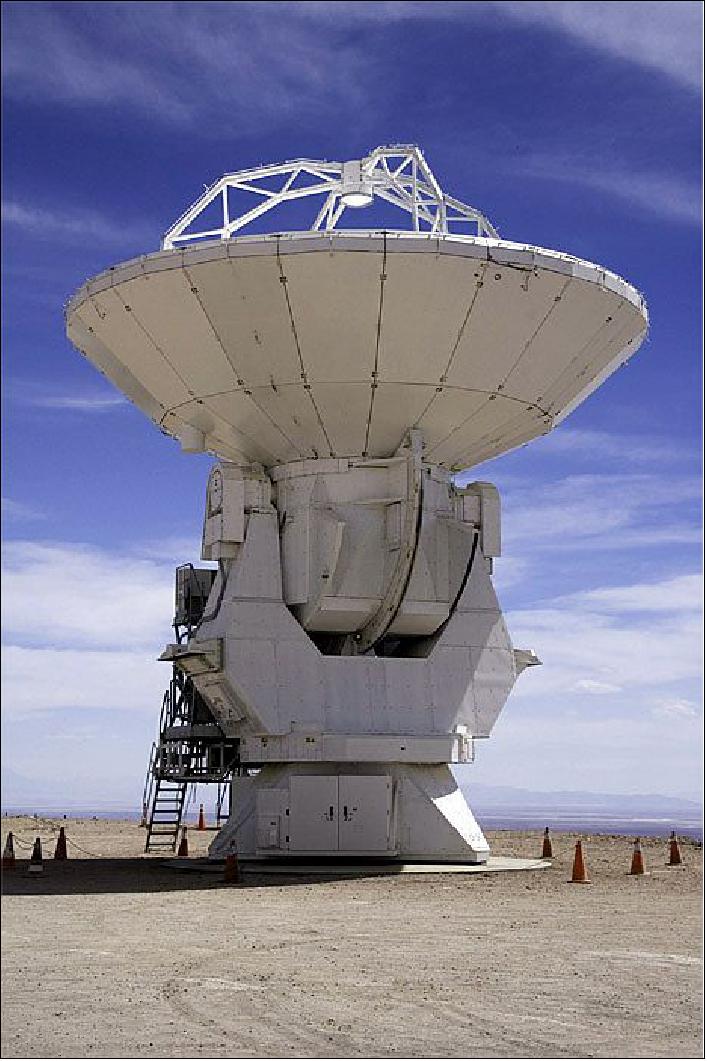
The most visible part of each antenna is the dish, a large reflecting surface. Most of ALMA’s dishes have a diameter of 12 m. Each dish plays the same role as the mirror of an optical telescope: it collects radiation coming from distant astronomical objects, and focuses it into a detector that measures the radiation. The difference between the two types of telescopes is the wavelength of the radiation detected. Visible light, captured by optical telescopes, is just a small part of the spectrum of electromagnetic radiation, with wavelengths between roughly 380 and 750 nm. ALMA, in contrast, will probe the sky for radiation at longer wavelengths from a few hundred µm to about 1 mm (about one thousand times longer than visible light). This is known, perhaps unsurprisingly, as mm and sub-mm radiation, and lies at the very short-wavelength end of radio waves.
This longer wavelength range is the reason, why ALMA’s dishes are not mirrors, but have a surface of metallic panels. The reflecting surfaces of any telescope must be virtually perfect: if they have any defects that are larger than a few percent of the wavelength to be detected, the telescope won’t produce accurate measurements. The longer wavelengths that ALMA’s antennas detect mean that although the surfaces are accurate to within 25 µm — much less than the thickness of a single sheet of paper, the dishes do not need the mirror finish used for visible-light telescopes. So although ALMA’s dishes look like giant metallic satellite dishes, to a submillimeter-wavelength photon (light-particle), they are almost perfectly smooth reflecting surfaces, focusing the photons with great precision.
Not only are the dish surfaces carefully controlled, but the antennas can be steered very precisely and pointed to an angular accuracy of 0.6 arcseconds (one arcsecond is 1/3600 of a degree). This is accurate enough to pick out a golf ball at a distance of 15 km.
ALMA will combine the signals from its array of antennas as an interferometer — acting like a single giant telescope as large as the whole array. Thanks to the two antenna transporter vehicles, astronomers will be able to reposition the antennas according to the kind of observations needed. So, unlike a telescope that is constructed and remains in one place, the antennas are robust enough to be picked up and moved between concrete foundation pads without this affecting their precision engineering.
In addition, the antennas achieve all this without the protection of a telescope dome or enclosure. The dishes are exposed to the harsh environmental conditions of the high altitude Chajnantor plateau, with strong winds, intense sunlight, and temperatures between ±20 ºC. Despite Chajnantor being in one of the driest regions on the planet, there is even sometimes snow here, but ALMA’s antennas are designed to survive all these hardships.
The production of the antennas is being shared between the ALMA partners. ESO has ordered twentyfive 12 m antennas, with an option for an additional seven, from the AEM Consortium (Alcatel Alenia Space France, Alcatel Alenia Space Italy, European Industrial Engineering S.r.L., MT Aerospace). The North American partners have placed an order of the same size with Vertex RSI, while the four 12 m and twelve 7 m antennas comprising ALMA’s ACA (Atacama Compact Array) have been ordered by NAOJ from MELCO (Mitsubishi Electric Corporation).
Apart from the obvious difference in size between the 12-meter and 7-meter antennas, careful observers will spot subtle differences in the antenna design from each partner. However, all the antennas are designed to meet the stringent technical specifications, and work together smoothly as parts of the whole. These state-of-the-art dishes, combined in a single revolutionary telescope, reflect the cooperative nature of the global ALMA project.
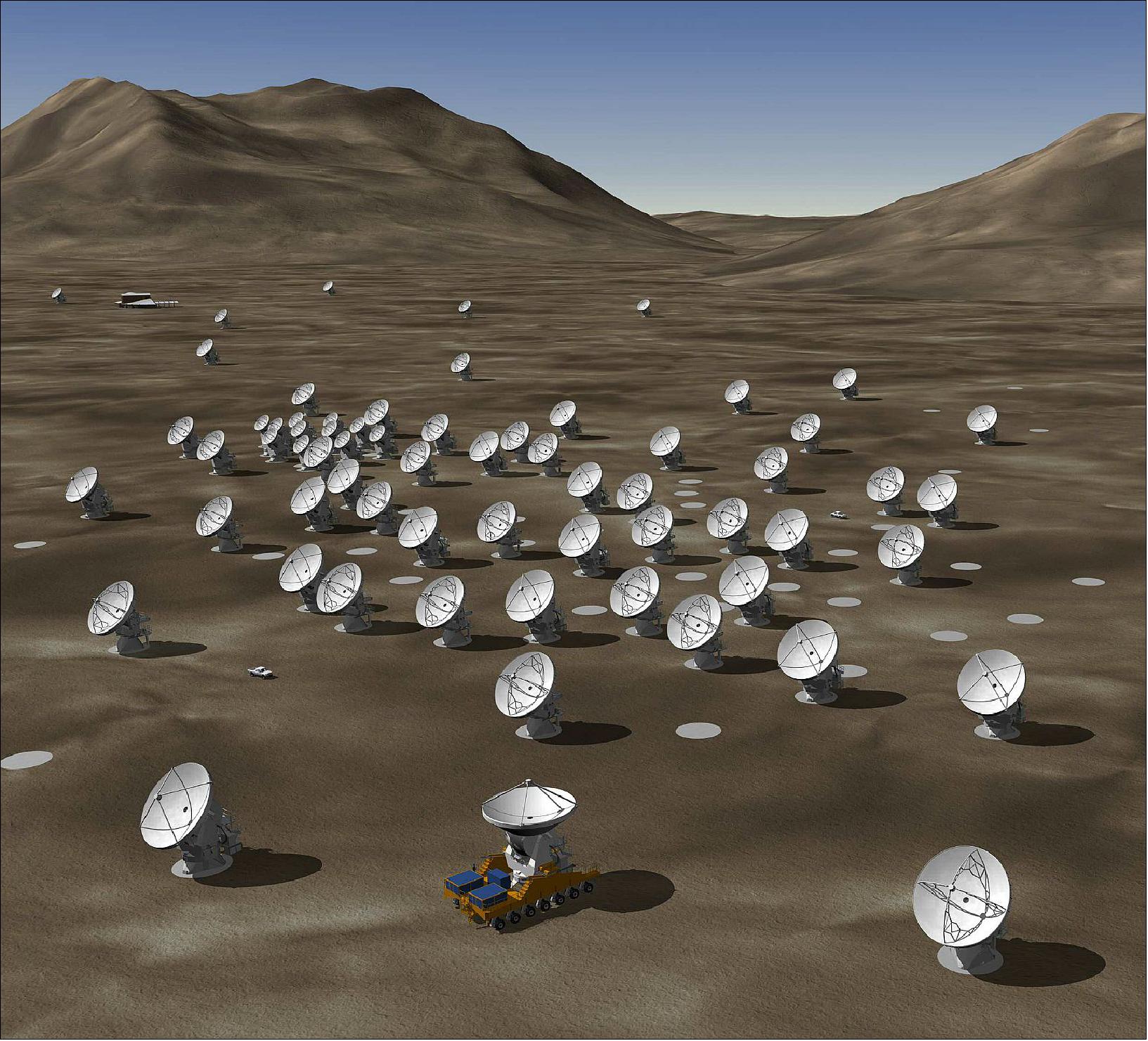
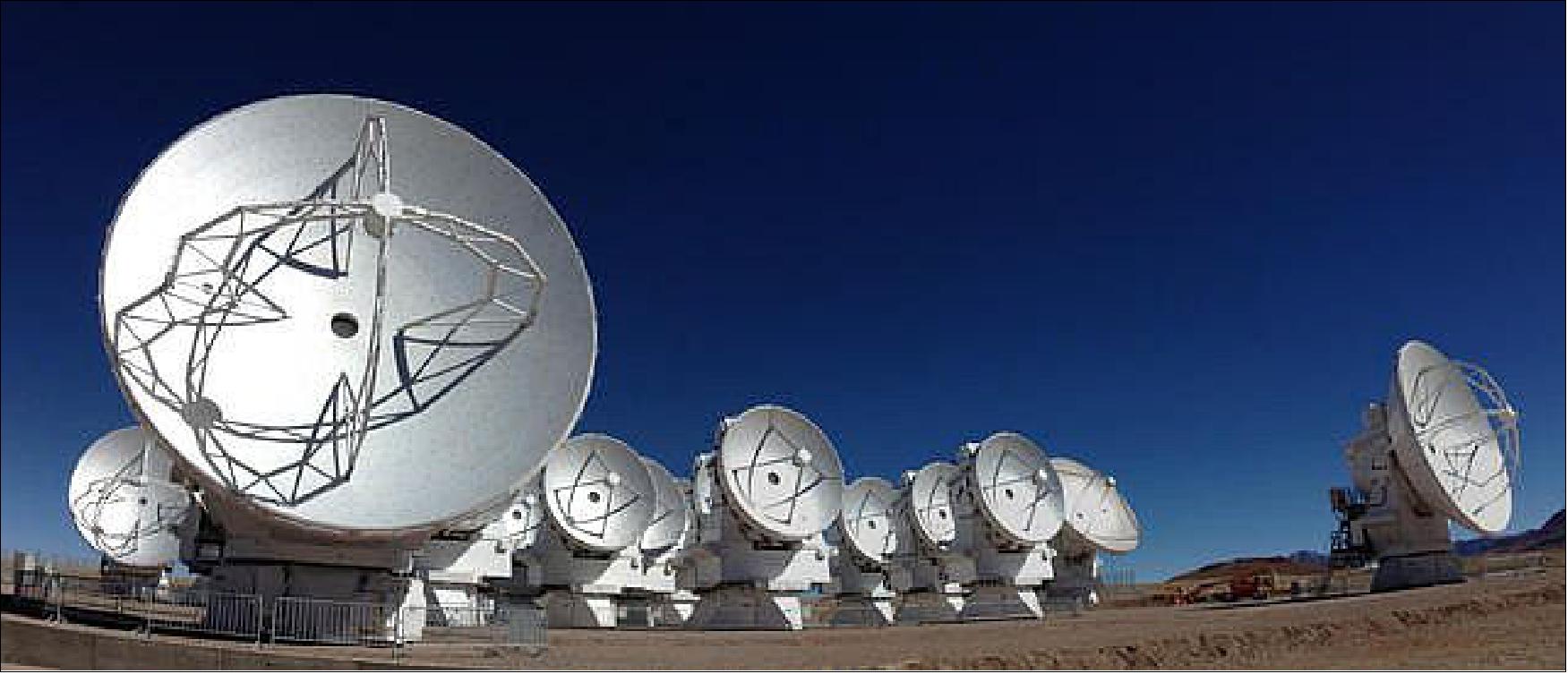
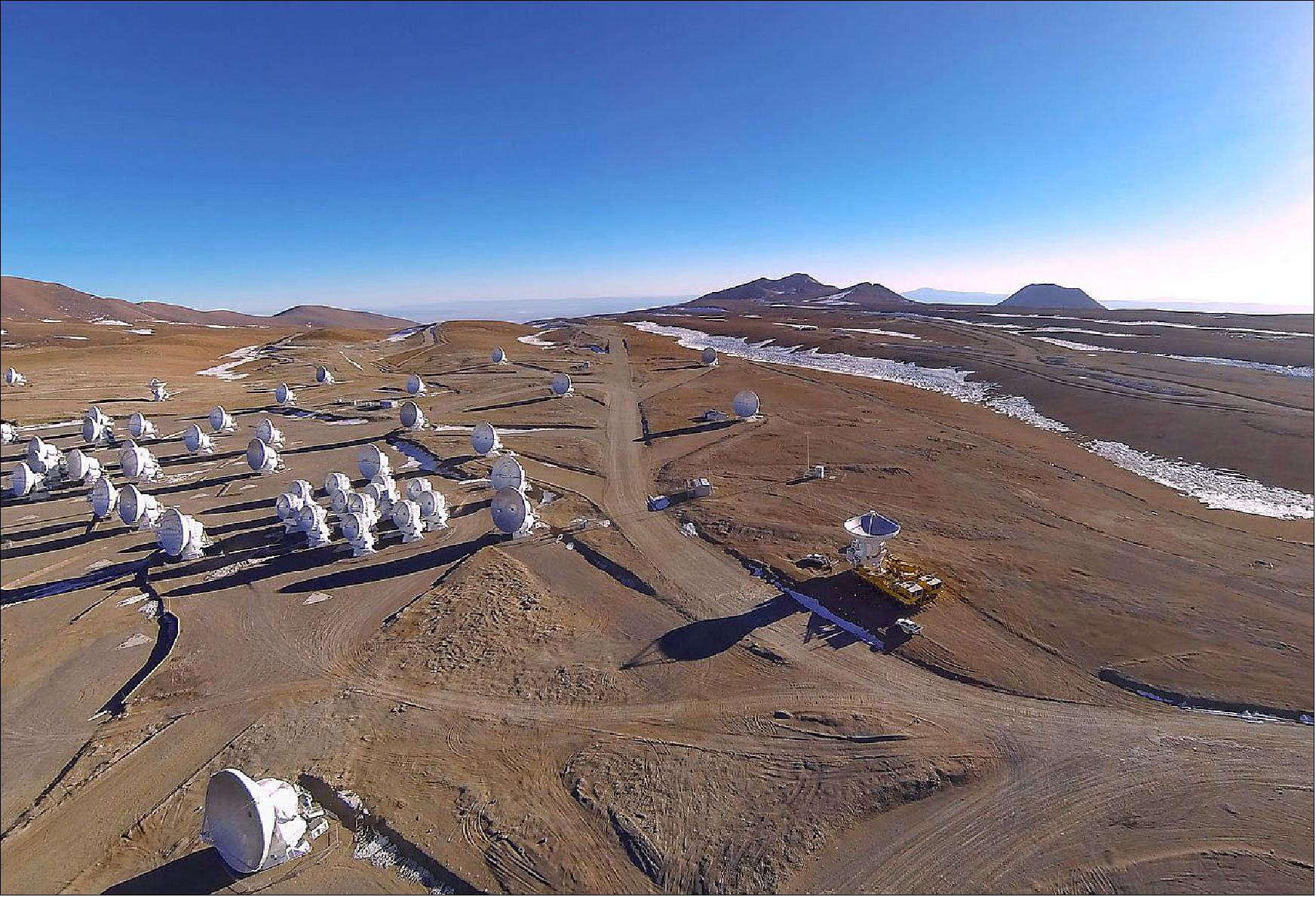
ALMA Front End Integration Centers: A construction project like ALMA, involving several partners in four different continents, requires consensus on several organizational and managerial decisions concerning the actual execution of certain construction activities. Several different scenarios for assembling and integrating the Front End components were extensively studied. This study revealed that the best solution was a “parallel approach”, installing half of the Front End in Europe and the other half in North America with identical and parallel procedures. This scenario was preferred in view of logistics, organization and program risks. Mainly based on considerations of risk mitigation, the parallel FEIC (Front End Integration Centers) was selected. The European FEIC is located at Rutherford Appleton Laboratory (UK) and the North American FEIC at NRAO. A third FEIC is installed in Taiwan to carry out the integration of Front End assemblies required for the antennas supplied by NAOJ.

A world-class observatory site in the desert: 18)
The ALMA Observatory is operated at two distinct sites, far away from comfortable living conditions of modern civilization. The ALMA OSF is the base camp for the every-day, routine operation of the observatory. It is located at an altitude of about 2900 m, quite high compared to standard living conditions, but still quite acceptable for scientific projects in astronomy of similar scope. However, the OSF will not only serve as the location for operating the Joint ALMA Observatory, it is also the AIV (Assembly, Integration and Verification) station for all the high technology equipment before being moved to the AOS (Array Operations Site), located at 5000 m altitude. Antenna assembly is done at the OSF site at three separate areas, one each for the antennas provided by North America (VERTEX), Japan (MELCO), and Europe (AEM Consortium).
The OSF is also the center for activities associated with commissioning and science verification as well as Early Science operation. During the operations phase of the observatory it is the workplace of the astronomers and of the teams responsible for maintaining proper functioning of all the telescopes.
The construction of the OSF and AOS sites and their access required substantial efforts of the ALMA project. Obviously, there was no access to these two remote locations (Figure 9). The OSF site, located at 2900 m altitude, is about 15 km away from the closest public road, the Chilean highway No. 23. The AOS is another 28 km away from the OSF site. Thus, one of the first projects to be accomplished by ALMA was to construct an access road not only to the OSF but also to the AOS road, 43 km in length, not only at high altitudes, but also with sufficient width to regularly transport a large number of large radio telescopes with a diameter of 12 m.
The geographical location of ALMA (at Altiplano de Chajnantor) is latitude: -23.029° ; longitude: -67.755°
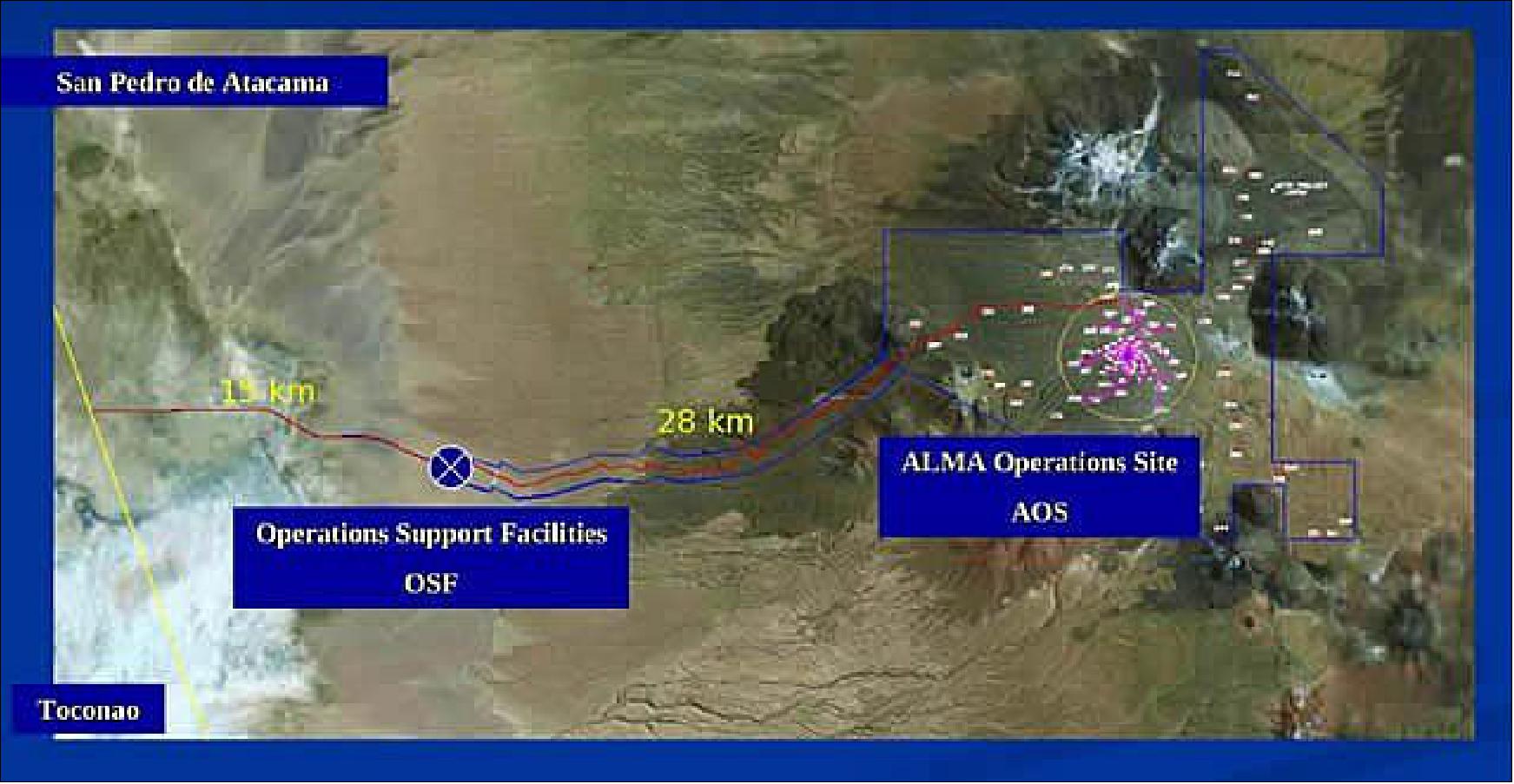
Front End System
The ALMA Front End system is the first element in a complex chain of signal receiving, conversion, processing and recording. The Front End is designed to receive signals of ten different frequency bands. 19)
The ALMA Front End is far superior to any existing systems. Indeed, spin offs of the ALMA prototypes are leading to improved sensitivities in existing millimeter and submillimeter observatories around the world. The Front End units are comprised of numerous elements, produced at different locations in Europe, North America, East Asia and Chile.
ALMA Cryostats: The largest single element of the Front End system is the cryostat (vacuum vessel) with the cryo-cooler attached. The cryostats will house the receivers, which are assembled in cartridges and can relatively easily be installed or replaced. The corresponding warm optics, windows and infrared filters were delivered by the IRAM (Institut de Radio Astronomie Millimétrique) of France. The operating temperature of the cryostats will be as low as 4 K (equivalent to -269ºC).
ALMA Receiver Bands: In the initial phase of operations, the antennas will be equipped with at least four receiver bands: Band 3 (3 mm), Band 6 (1 mm), Band 7 (0.85 mm), Band 9 (0.45 mm). It is planned to equip the antennas with the missing bands at a later stage of ALMA operations. The development programs were successful, as the requirements could be met – and sometimes the performance is even better than defined in the specifications.
ALMA band | Frequency range (GHz) | Receiver noise (K) over 80% of the RF band | Temperature (K) at any RF frequency | To be produced by | Receiver technology |
1 | 31 - 45 | 17 | 26 | TBD (To be decided) | HEMT |
2 | 67 - 90 | 30 | 47 | TBD | HEMT |
3 | 84 - 116 | 37 | 60 | HIA | SIS |
4 | 125 - 163 | 51 | 82 | NAOJ | SIS |
5 | 162 - 211 | 65 | 105 | OSO | SIS |
6 | 211 - 275 | 83 | 136 | NRAO | SIS |
7 | 275 - 373 | 147 | 219 | IRAM | SIS |
8 | 385 -500 | 196 | 292 | NAOJ | SIS |
9 | 602 - 720 | 175 | 261 | NOVA | SIS |
10 | 787 - 900 | 230 | 344 | NAOJ | SIS |
IRAM (Institut de Radio Astronomie Millimétrique), Grenoble, France | |||||
Modular Cryogenic Receiver Concept. The complete front end unit will have a diameter of 1 m, be about 1m high and have a mass of about 750 kg. The cryostat will be cooled down to ~4 K by a 3-stage commercial closed-cycle cryocooler based on the Gifford – McMahon cooling cycle. The individual frequency bands are implemented in the form of modular cartridges that will be inserted in a large common cryostat. This cartridge concept allows for a great flexibility in construction and operation of the array. Figure 10 shows an example of such a receiver cartridge. Another advantage of the cartridge layout with well-defined interfaces is the fact that different cartridges can be developed and built by different groups within the ALMA Project with a large degree of independence but without the risk of incompatibility between them. 20)

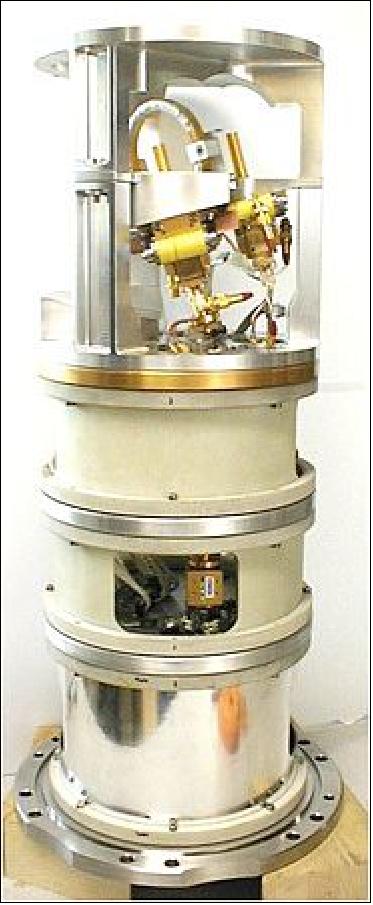
Band 5 — July 17, 2015: After more than five years of development and construction, ALMA successfully opened its eyes on another frequency range after obtaining the first fringes with a Band 5 receiver, specifically designed to detect water in the local Universe. Band 5 will also open up the possibility of studying complex molecules in star-forming regions and protoplanetary discs, and detecting molecules and atoms in galaxies in the early Universe, looking back about 13 billion years (Ref. 11).
“Band 5 will open up new possibilities to explore the Universe and bring new discoveries,” explains ESO’s Gianni Marconi, who is responsible for the integration of Band 5. “The frequency range of this receiver includes an emission line of water that ALMA will be able to study in nearby regions of star formation. The study of water is, of course, of intense interest because of its role in the origin of life.” With Band 5, ALMA will also be able to probe the emission from ionized carbon from objects seen soon after the Big Bang, opening up the possibility of probing the earliest epoch of galaxy formation. “This band will also enable astronomers to study young galaxies in the early Universe about 500 million years after the Big Bang,” added Gianni Marconi.
The Band 5 receivers were originally designed and prototyped by Onsala Space Observatory's Group for Advanced Receiver Development (GARD) at Chalmers University of Technology in Sweden, in collaboration with the Rutherford Appleton Laboratory, UK, and ESO, under the European Commission supported Framework Program FP6 (ALMA Enhancement). After having successfully tested the prototypes, the first production-type receivers were built and delivered to ALMA by a consortium of NOVA and GARD in the first half of 2015. Two receivers were used for the first light. The remainder of the 73 receivers ordered, including spares, will be delivered between now and 2017.
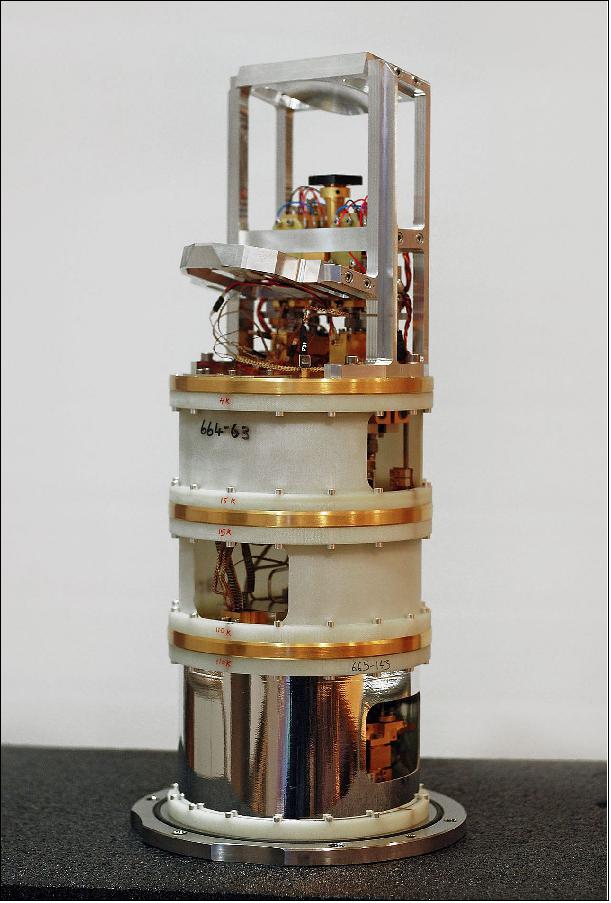
Back End and Correlator
The ALMA Back End systems deliver signals generated by Front End units installed in each antenna to the Correlator installed in the AOS (Array Operations Site) Technical Building, located at an altitude of 5,000 m. Signal processing and data transfer is schematically shown in Figure 13. Analog data, produced by the Front End electronics, is processed and digitized before entering into the data encoder, followed by the optical transmitter units and multiplexers. All these elements are installed in the receiver cabins of each antenna. Optical signals are then transmitted by fibers to the AOS Technical Building. The total distance is, in one antenna configuration, about 15 km. At the Technical Building the incoming optical signals are de-multiplexed and de-formatted before entering the Correlator. 21) 22) 23)
ALMA main array Correlator: The ALMA main array Correlator, to be installed in the AOS Technical Building, is the last component in the receiving end of the data transmission. It is a very large data processing system, composed of four quadrants, each of which can process data coming from up to 504 pairs of antennas. The complete correlator will have 2912 printed circuit boards, 5200 interface cables, and more than 20 million solder points. Integral parts of the Correlator are TFB (Tunable Filter Bank) cards. The layout is such that four TFB cards are needed for the data coming from a single antenna. The TFB cards have been developed and optimized by the University of Bordeaux over the last few years.
ACA (Atacama Compact Array) Correlator: The ACA Correlator is designed to process the signals detected by the Atacama Compact Array (ACA). This correlator consists of 52 modules connected with each other through optical-fiber cables. All the modules are installed in 8 racks in the AOS Technical Building. The power spectra issued from the correlation are transferred to the ACA data processing computers.
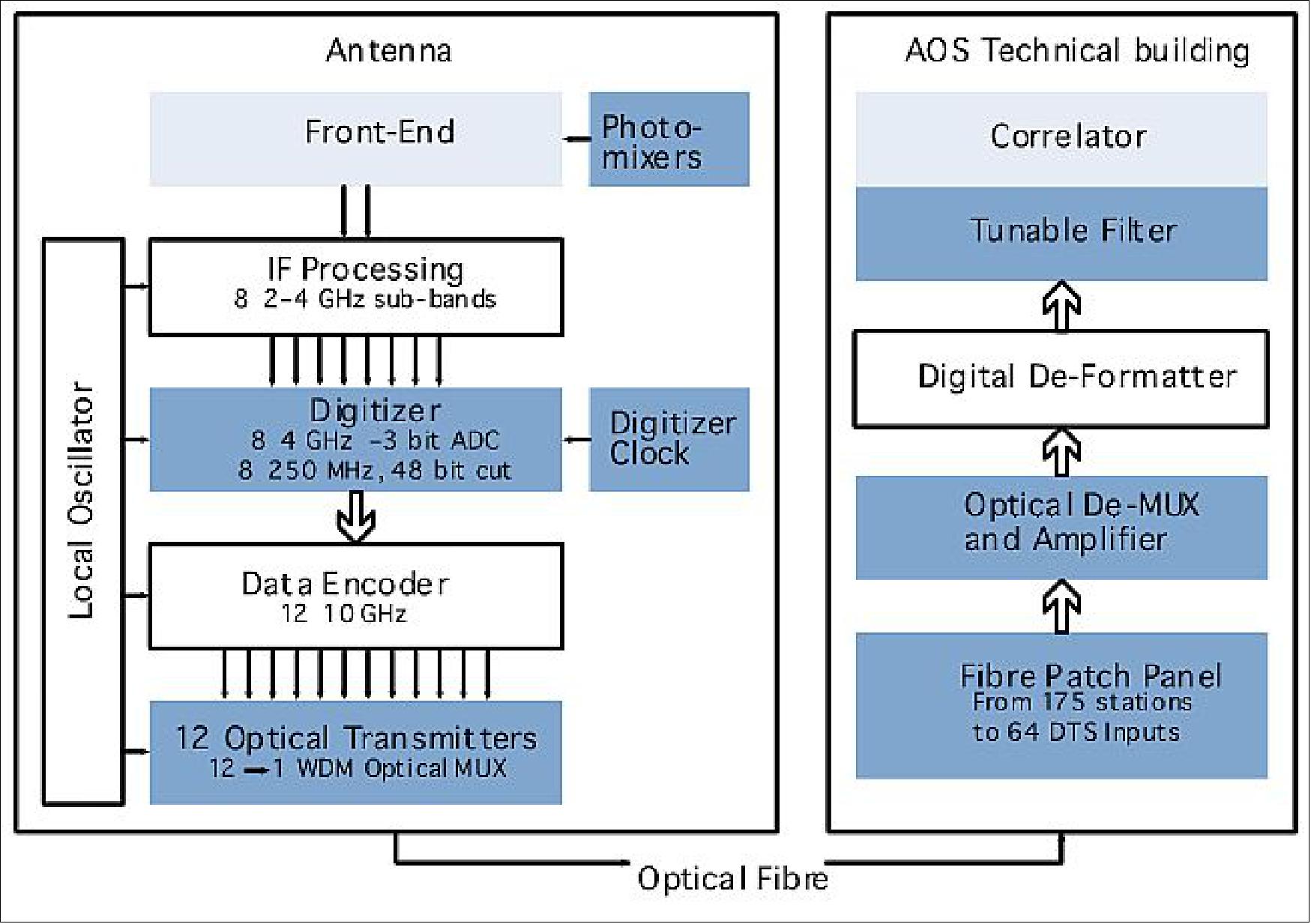
• May 15, 2020: The contract has been signed for the production of the final set of receivers to be installed on the Atacama Large Millimeter/submillimeter Array (ALMA). Of the originally foreseen ten receiver bands, eight have already been installed, and the ninth, Band 1, is currently in production in East-Asia. Now, contracts have been signed to start the production of the final band in the original ALMA definition — Band 2, led by ESO. Exceeding the originally defined frequency range for this Band (69-90 GHz), the proposed receiver will operate at the full 67-116 GHz frequency window. The hugely successful Band 3 receiver has already opened up the 84-116 GHz frequency range years ago, but the new Band 2 will allow for observations across the entire 67-116 GHz atmospheric window using a single receiver. The project will involve multiple international partners as detailed below. 24)
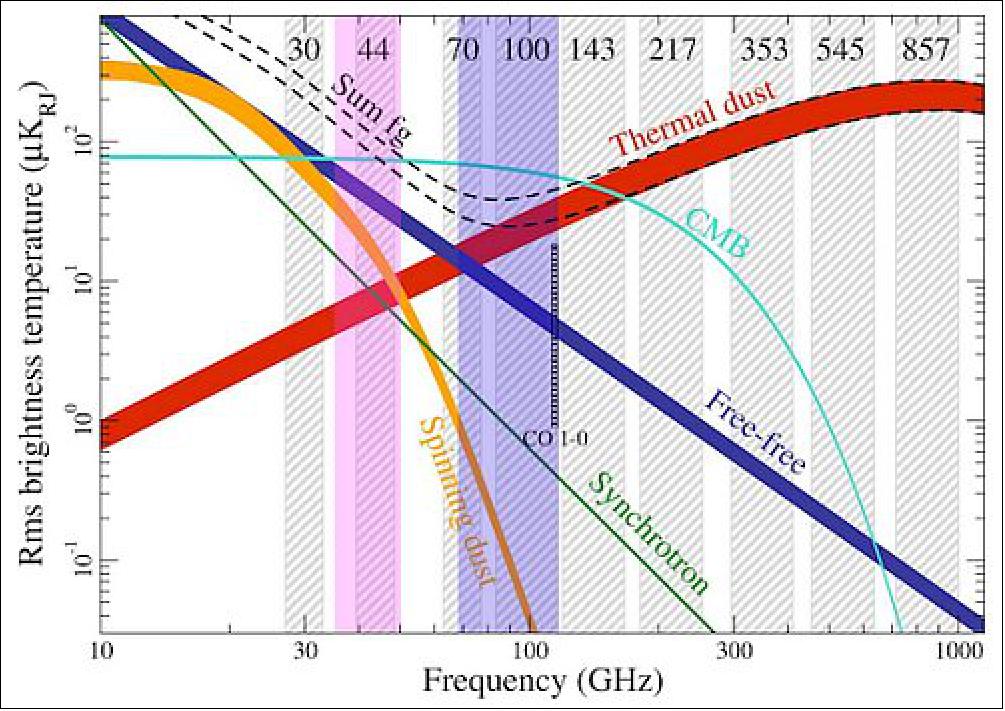
Following successful tests of a prototype Band 2 receiver (Yagoubov et al. 2020, A&A 634, A46), the ALMA board has approved the pre-production of a series of six cartridges, with the goal of eventually moving into the production of the full set, one for each of the ALMA antennas. This will depend on the verification of the performance and series production readiness based on the pre-production receiver cartridges.
The 67-116 GHz atmospheric window is rich in strong molecular lines with less crowding than other atmospheric windows. Due to the relatively low excitation energies, these lines are exceptionally suited for studying the dense molecular gas and early phases of star formation. Furthermore, the window is rich in complex organic molecules (COMs), tying in directly with the new fundamental science drivers defined in the ALMA 2030 Development Roadmap. Band 2 will also fill a gap in ALMA's ability to observe the molecular reservoir in redshifted galaxies. Finally, Band 2 continuum measurements have the lowest intrinsic background, as thermal dust emission, CMB emission, free-free emission and synchrotron emission conspire to form a local emission minimum in frequency space.
The production of the Band 2 receiver cartridges will be undertaken by a consortium comprising the Netherlands Research School for Astronomy (NOVA), Chalmers University, Gothenburg, Sweden, and the Italian National Institute for Astrophysics (INAF). The National Astronomical Observatory of Japan (NAOJ) will contribute to the production and testing of receiver optics as an East Asia contribution to the ALMA Development Program. The National Radio Astronomy Observatory (NRAO) and the University of Chile have been involved in the development and production of some components of the receivers, which will be sent to ESO for testing and integration.
Links to Other Observatories to Create an Earth-size Telescope
November 2015: ALMA continues to expand its power and capabilities by linking with other millimeter-wavelength telescopes in Europe and North American in a series of VLBI (Very Long Baseline Interferometry) observations. In VLBI, data from two or more telescopes are combined to form a single virtual telescope that spans the geographic distance between them. The most recent of these experiments with ALMA formed an Earth-size telescope with extraordinarily fine resolution. 25)

These experiments are an essential step in including ALMA in the EHT (Event Horizon Telescope), a global network of millimeter-wavelength telescopes that will have the power to study the supermassive black hole at the center of the Milky Way in unprecedented detail.
Before ALMA could participate in VLBI observations, it first had to be upgraded adding a new capability known as a phased array. This new version of ALMA allows its 66 antennas to function as a single radio dish 85 m in diameter, which then becomes one element in a much larger VLBI telescope.
• The first test of ALMA’s VLBI capabilities occurred on 13 January 2015, when ALMA successfully linked with the APEX (Atacama Pathfinder Experiment Telescope), which is about two kilometers from the center of the ALMA array.
• On 30 March 2015, ALMA reached out much further by linking with IRAM (Institut de Radioastronomie Millimetrique), the 30 m radio telescope in the Sierra Nevada of southern Spain. Together they simultaneously observed the bright quasar 3C 273. Data from this observation were combined into a single observation with a resolution of 34 µarcsec (1 microarcsecond = 2.8º x 10-10). This is equivalent to distinguish an object of less than 10 cm on the Moon, seen from Earth. - The March observations were made during an observing campaign of the EHT at a wavelength of 1.3 mm.
• The most recent VLBI observing run was performed on 1–3 August 2015 with six of the VLBA (Very Long Baseline Array) antennas of NRAO (National Radio Astronomy Observatory). This combined instrument formed a virtual Earth-size telescope and observed the quasar 3C 454.3, which is one of the brightest radio beacons on the sky, despite lying at a distance of 7.8 billion light-years. These data were first processed at NRAO and MIT-Haystack in the United States and further post-processing analysis is being performed at the MPIfR (Max Planck Institute for Radio Astronomy) in Bonn, Germany.
- The VLBA is an array of 10 antennas spread across the United States from Hawaii to St. Croix. For this observation, six antennas were used: North Liberty, IA; Fort Davis, TX; Los Alamos, NM; Owens Valley, CA; Brewster, WA; and Mauna Kea, HI. The observing wavelength was 3 mm.
• The new observations are a further step towards global interferometric observations with ALMA in the framework of the Global mm-VLBI Array and the EHT (Event Horizon Telescope), with ALMA as the largest and the most sensitive element. The addition of ALMA to millimeter VLBI will boost the imaging sensitivity and capabilities of the existing VLBI arrays by an order of magnitude.
Enhancing ALMA’s Future Observing Capabilities
• June 2021: With each observing cycle at the ALMA (Atacama Large Millimeter/submillimeter Array) new features and observing modes are offered. Here we provide some background about how these new capabilities are tested and then made available to ALMA users. These activities help to drive the cutting-edge science conducted with ALMA and to maintain ALMA’s position as the foremost interferometric array operating at millimeter and submillimeter wavelengths. We focus in particular on opening up high-frequency observing using ALMA’s longest baselines, which offers the highest possible angular resolution. 26)
Extension and Optimization of New Capabilities
- The global effort of adding new capabilities to ALMA is referred to as Extension and Optimization of Capabilities (EOC). EOC was the natural progression after moving away from initial tests when ALMA was commissioned. During the final years of construction and during Cycle 0 operations, almost ten years ago, the development of new modes was called Commissioning and Scientific Verification (CSV). CSV was conducted to ensure that the capabilities offered were fully operational and valid. Following this, with ALMA as a fully operational telescope, testing as part of EOC activities has continued as an ALMA-wide effort encompassing all partners1: the Joint ALMA Observatory (JAO) in Chile and the ALMA Regional Centres (ARCs) in East Asia, North America and Europe. In Europe there are also contributions from the ARC network (see Hatziminaoglou et al., 2015). The entire EOC effort, including all coordination, planning and the intricate steps involved, is led by the JAO (see Takahashi et al., 2021).
- In this article we provide an overview of EOC, and what features might be expected in the coming cycles, with a specific focus on pushing ALMA to achieve the highest angular resolutions possible (a study involving significant input from the European ARC). We also highlight how the ALMA community benefits from each capability potentially offered.
Process for Offering New Capabilities
- Behind the scenes, the process that makes new capabilities possible is the ObsMode process (Takahashi et al., 2021), which is led and coordinated by the JAO. The intention of the ObsMode process is to enable all observing modes that ALMA was designed to support, as well as any additional ones identified since construction began.
- Unfortunately, ALMA cannot simply test a new observing mode on the telescope and thereafter open it directly to the community. This is because all parts of the observing chain involving the so-called subsystems (Control software, Observing Tool [OT], Scheduling, Quality Assurance [QA], Pipeline, and Archive, to name just a few) must be up to the task. Before opening a new capability to the community, ALMA must be able to demonstrate the entire workflow: the correct creation of the observation files; successful, error-free observations; data reduction — first using manual scripts and thereafter with the ALMA Pipeline; and finally data and product ingestion into the ALMA Archive such that it can be delivered to any Principal Investigator (PI) and used in any future Archive mining exercises.
- The ObsMode process therefore follows a yearly structure and is aligned with ALMA observing cycles. For example, the majority of work in 2021 began in October 2020 and will finish in October 2021 (Figure 16). This system includes a two-year lead time, such that any capability planned for release in Cycle 9 (due to start in October 2022) must be fully tested and verified in Cycle 7a. Final tests during the first half of Cycle 8, before the Cycle 9 Call-for-Proposals (CfP) pre-announcement is made, mark the final date to confirm the readiness of a capability for scientific operations. The main considerations throughout the year include:

- Proposed capabilities and priorities: A list is drawn up of capabilities aimed at science operations two years later. Given the ten years of ALMA operations, there is a natural continuation from previous years. ALMA management, together with the science and operations teams, arrange and discuss the priorities with the ALMA Science Advisory Committee (ASAC), which confirms that these align with the community input.
Initial capability plan: Plans are made by the expert teams leading each capability. These must provide a technical summary, identify the on-sky time requirements, and detail each team member’s role. Most importantly, the plans set the criteria for declaring a particular capability as ready.
- Test Observations: EOC observations are scheduled to have a minimal impact on standard science observations, being conducted in small time windows or when science observations cannot take place. Where possible, observations use Scheduling Blocks (SBs) constructed with the OT, however some tests require custom command-line scripts to operate ALMA in a manual mode.
- Data reduction and problem reporting: Custom scripts are employed, using the Common Astronomy Software Applications package (CASA; McMullin, 2007) reduction software with extra analysis and heuristics. Extra system-level stability and data-validity checks are also made. EOC teams aim to provide QA-like reduction workflows to enable an easier transition to science operations.
- Technical readiness: In September and October the EOC teams report their findings and provide a technical report to specific expert reviewers. These reports are used for a readiness assessment to confirm whether the capability meets the initial readiness criteria.
- Subsystem impact: Requirements are created continually throughout the year for the subsystems involved. Although developments are continual, a capability can only be declared operational when all subsystems integrate the required modifications. Examples of subsystem changes are: (1) the addition of new OT features that allow SBs to be generated, and (2) modification of the QA2 process to provide the correct reduction path (see, for example, Petry et al., 2020).
- Documentation: Before the CfP is issued, ALMA provides users with a Proposer’s Guide2 and a Technical Handbook3. These documents must fully detail and explain any newly offered capabilities.
Focusing on High Frequencies and Long Baselines with Band-to-Band (B2B)
- The European ARC (ALMA Regional Centre) is particularly involved with EOC activities to offer high-frequency observations (Bands 8, 9, and 10, > 385 GHz) using the most extended array configurations (C-8, C-9 and C-10, with maximal baselines of ~ 8.5, ~ 13.9 and ~ 16.2 km, respectively). Theoretically, the highest frequencies coupled with the longest-baseline array would achieve an angular resolution of 5 milliarcseconds. This translates to sub-au scales for sources within 200 parsecs and would provide the most detailed sub-mm picture of protoplanetary discs. For extragalactic targets, parsec scales could be resolved for sources within 40 Mpc, offering unprecedented details of galactic structures.
Note: As of 19 March 2020, the previously single large ALMA file has been split into two files, to make the file handling manageable for all parties concerned, in particular for the user community.
• This article covers the ALMA project mission and its imagery in the period 2022 and 2019, in addition to some of the mission milestones.
•ALMA imagery in the period 2018-2011
Status and Selected Observation Imagery (2022-2019)
Only a selected few images can be shown here. The interested reader is referred to the ALMA Press Release site for more details. 27) 28)
• June 18, 2022: An international research team from China, the U.S., and Germany has used high-resolution observational data from ALMA and discovered a massive accretion disk with two spiral arms surrounding a 32 solar mass protostar in the Galactic Center. This disk could be perturbed by a close encounter with a flyby object, thus leading to the formation of the spiral arms. This finding demonstrates that the formation of massive stars may be similar to that of lower-mass stars through accretion disks and flybys. 29) 30)
- Accretion disks around protostars, also known as 'protostellar disks,' are essential components in star formation because they continuously feed gas into protostars from the environment. In this sense, they are stellar cradles where stars are born and raised. Accretion disks surrounding solar-like low-mass protostars have been extensively studied in the last few decades, leading to a wealth of observational and theoretical achievements. For massive protostars, especially early O-type ones of more than 30 solar masses, it is still unclear whether and how accretion disks play a role in their formation. These massive stars are far more luminous than the Sun, with intrinsic luminosities up to several hundreds of thousands of times the solar value, which strongly impact the environment of the entire Galaxy. Therefore, understanding the formation of massive stars is of great importance.
- At a distance of about 26,000 light-years away from us, the Galactic Center is a unique and important star-forming environment. The most well-known object here would undoubtedly be the supermassive black hole Sgr A*. Besides that, there is a massive reservoir of dense molecular gas, mainly in the form of molecular hydrogen (H2), which is the raw material for star formation. The gas will start to form stars once gravitational collapse is initiated. However, direct observations of star-forming regions around the Galactic Center are challenging, given the considerable distance and the contamination from foreground gas between the Galactic Center and us. A very high resolution, combined with high sensitivity, is necessary to resolve details of star formation in this region.
![Figure 17: A schematic view of the history of the accretion disk and the flyby object (a – c). The three plots starting from the bottom left are snapshots from the numerical simulation, capturing the system right at the flyby event, 4,000 years after, and 8,000 years after, respectively. The top right image is from the ALMA observations, showing the disk with spirals and the two objects around it, corresponding to the system at 12,000 years after the flyby event (d) [image credit: Lu et al.]](https://www.eoportal.org/ftp/satellite-missions/a/Alma_300622/Alma_Auto5C.jpeg)
- The research team has used the long-baseline observations of ALMA to achieve a resolution of 40 milliarcseconds. We can easily spot a baseball hidden in Osaka from Tokyo at such a resolution. With these high-resolution, high-sensitivityALMA observations, the team has discovered an accretion disk around the Galactic Center. The disk has a diameter of about 4,000 astronomical units and is surrounding a forming early O-type star of 32 solar mass. “This system is among the most massive protostars with accretion disks and represents the first direct imaging of a protostellar accretion disk in the Galactic Center,” said Qizhou Zhang, a co-author and an astrophysicist at the Center for Astrophysics. This discovery suggests that the formation of massive early O-type stars does go through a phase with accretion disks involved, and such a conclusion is valid for the Galactic Center.
- What is more interesting is that the disk clearly displays two spiral arms. Such spiral arms resemble those found in spiral galaxies but are rarely seen in protostellar disks. Spiral arms could emerge in accretion disks due to fragmentation induced by gravitational instabilities. However, the disk discovered in this study is hot and turbulent, thus able to balance its gravity. The team detected an object of about three solar masses at about 8,000 astronomical units away from the disk. Through a combined analysis of analytic solutions and numerical simulations, they reproduce a scenario where an object flew by the disk more than 10,000 years ago and perturbed the disk, leading to the formation of spiral arms. "The numerical simulation matches perfectly with the ALMA observations. We conclude that the spiral arms in the disk are relics of the flyby of the intruding object," said Xing Lu, the lead author and an associate researcher at the Shanghai Astronomical Observatory of the Chinese Academy of Sciences.
- This finding demonstrates that accretion disks at the early evolutionary stages of star formation are subject to frequent dynamic processes such as flybys, which would substantially influence the formation of stars and planets. It is interesting to note that flybys have also happened in our Solar System. A binary stellar system known as Scholz's Star flew by the solar system about 70,000 years ago, probably penetrating through the Oort cloud and sending comets to the inner solar system. This study suggests that for more massive stars, especially in the high stellar density environment around the Galactic Center, such flybys should also be frequent. "The formation of stars should be a dynamical process, with many mysteries still unresolved," said Xing Lu. "With more upcoming high-resolution ALMA observations, we expect to disentangle these mysteries in star formation."
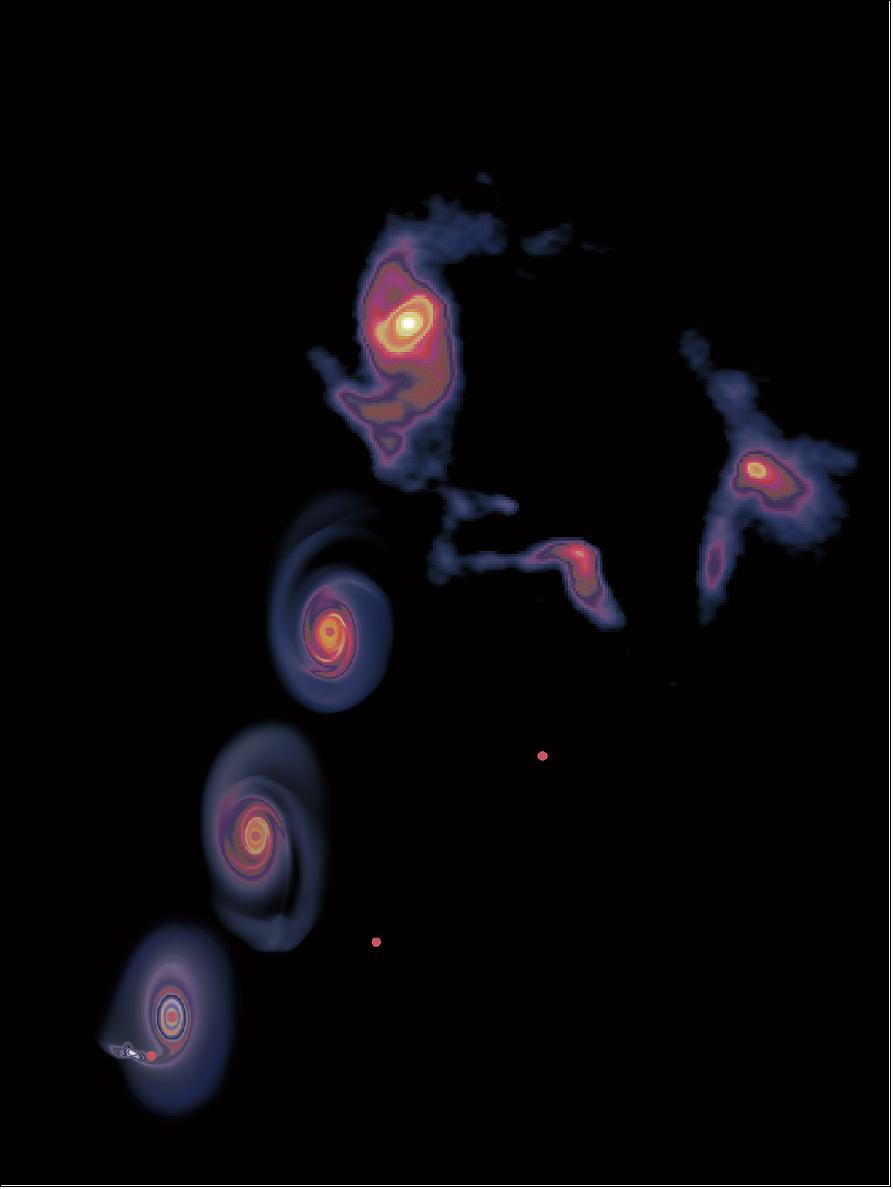
• June 15, 2022: Astronomers have unveiled intricate details of the star-forming region 30 Doradus, also known as the Tarantula Nebula, using new observations from the Atacama Large Millimeter/submillimeter Array (ALMA). In a high-resolution image released today by the European Southern Observatory (ESO) and including ALMA data, we see the nebula in a new light, with wispy gas clouds that provide insight into how massive stars shape this region. 31)
- “These fragments may be the remains of once-larger clouds that have been shredded by the enormous energy being released by young and massive stars, a process dubbed feedback,” says Tony Wong, who led the research on 30 Doradus presented today at the American Astronomical Society (AAS) meeting and published in The Astrophysical Journal. Astronomers originally thought the gas in these areas would be too sparse and too overwhelmed by this turbulent feedback for gravity to pull it together to form new stars. But the new data also reveal much denser filaments where gravity’s role is still significant. “Our results imply that even in the presence of very strong feedback, gravity can exert a strong influence and lead to a continuation of star formation,” adds Wong, who is a professor at the University of Illinois at Urbana-Champaign, USA.
- Located in the Large Magellanic Cloud, a satellite galaxy of our own Milky Way, the Tarantula Nebula is one of the brightest and most active star-forming regions in our galactic neighbourhood, lying about 170,000 light-years away from Earth. At its heart are some of the most massive stars known, a few with more than 150 times the mass of our Sun, making the region perfect for studying how gas clouds collapse under gravity to form new stars.
- "What makes 30 Doradus unique is that it is close enough for us to study in detail how stars are forming, and yet its properties are similar to those found in very distant galaxies, when the Universe was young,” said Guido De Marchi, a scientist at the European Space Agency (ESA) and a co-author of the paper presenting the new research. “Thanks to 30 Doradus, we can study how stars used to form 10 billion years ago when most stars were born."
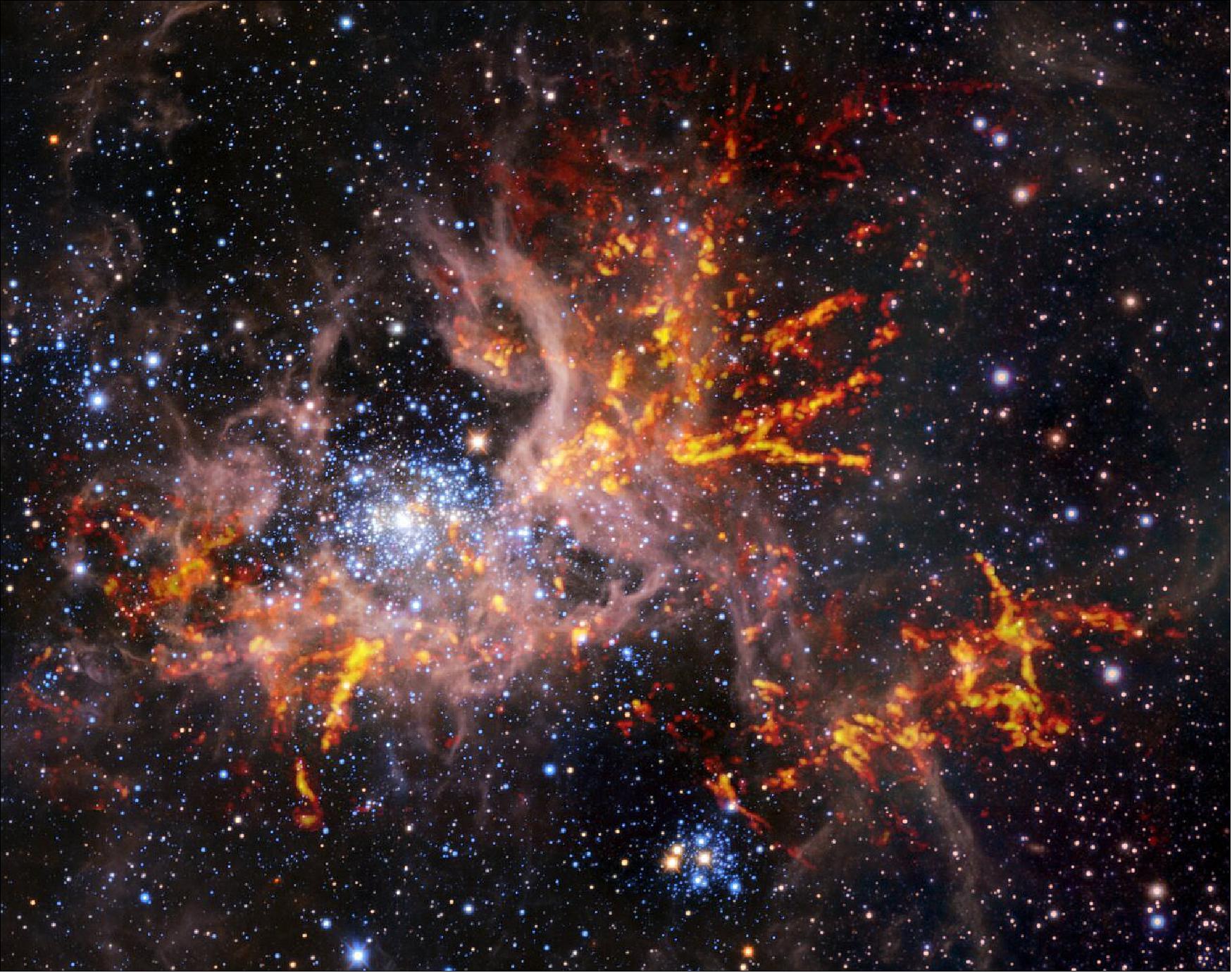
- While most of the previous studies of the Tarantula Nebula have focused on its centre, astronomers have long known that massive star formation is happening elsewhere too. To better understand this process, the team conducted high-resolution observations covering a large region of the nebula. Using ALMA, they measured the emission of light from carbon monoxide gas. This allowed them to map the large, cold gas clouds in the nebula that collapse to give birth to new stars — and how they change as huge amounts of energy are released by those young stars.
- “We were expecting to find that parts of the cloud closest to the young massive stars would show the clearest signs of gravity being overwhelmed by feedback,” says Wong. “We found instead that gravity is still important in these feedback-exposed regions — at least for parts of the cloud that are sufficiently dense.”
- In the image released today by ESO, we see the new ALMA data overlaid on a previous infrared image of the same region that shows bright stars and light pinkish clouds of hot gas, taken with ESO’s Very Large Telescope (VLT) and ESO’s Visible and Infrared Survey Telescope for Astronomy (VISTA). The composition shows the distinct, web-like shape of the Tarantula Nebula’s gas clouds that gave rise to its spidery name. The new ALMA data comprise the bright red-yellow streaks in the image: very cold and dense gas that could one day collapse and form stars.
- The new research contains detailed clues about how gravity behaves in the Tarantula Nebula’s star-forming regions, but the work is far from finished. “There is still much more to do with this fantastic data set, and we are releasing it publicly to encourage other researchers to conduct new investigations,” Wong concludes. 32)
• June 6, 2022: Resembling a curled sleeping snake, this picture shows NGC 1087. This spiral galaxy, located approximately 80 million light-years from Earth in the constellation of Cetus, is captured here by a combination of observations conducted at different wavelengths –– or colours –– of light. 33)
- But no need to worry, NGC 1087 will not poison you! The apparent menacing red glow actually corresponds to clouds of cold molecular gas, the raw material out of which stars form. Astronomers are able to image these clouds thanks to the Chile-based Atacama Large Millimeter/submillimeter Array (ALMA), in which ESO is a partner. The bluish regions in the background reveal the pattern of older, already formed stars, imaged by the Multi-Unit Spectroscopic Explorer (MUSE) on ESO’s Very Large Telescope (VLT) also in Chile.
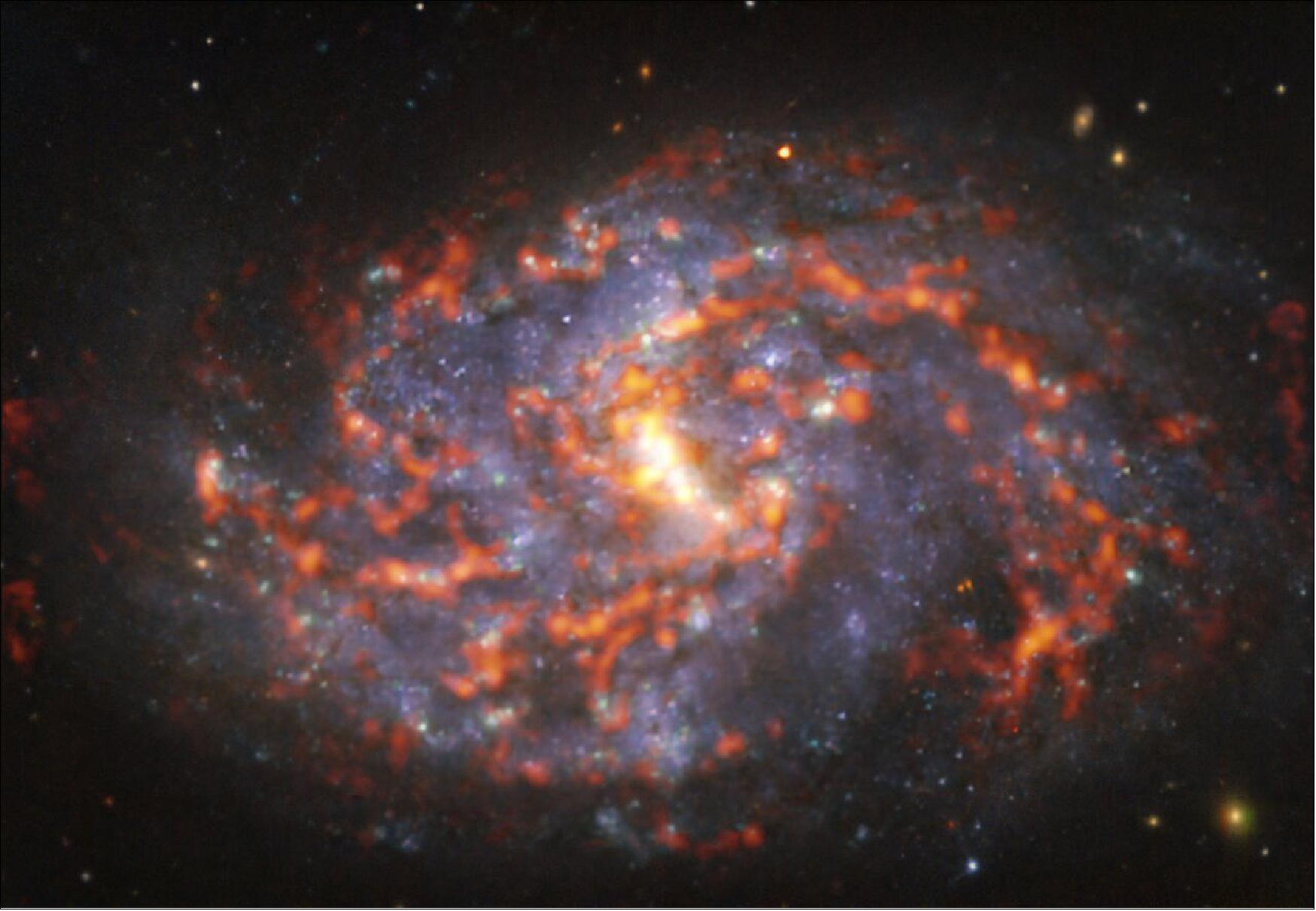
• May 12, 2022: Today, at simultaneous press conferences around the world, including at the European Southern Observatory (ESO) headquarters in Garching, Germany, astronomers have unveiled the first image of the supermassive black hole at the centre of our own Milky Way galaxy. This result provides overwhelming evidence that the object is indeed a black hole and yields valuable clues about the workings of such giants, which are thought to reside at the centre of most galaxies. The image was produced by a global research team called the Event Horizon Telescope (EHT) Collaboration, using observations from a worldwide network of radio telescopes. 34)
- The image is a long-anticipated look at the massive object that sits at the very centre of our galaxy. Scientists had previously seen stars orbiting around something invisible, compact, and very massive at the centre of the Milky Way. This strongly suggested that this object — known as Sagittarius A* (Sgr A*, pronounced "sadge-ay-star") — is a black hole, and today’s image provides the first direct visual evidence of it.
- Although we cannot see the black hole itself, because it is completely dark, glowing gas around it reveals a telltale signature: a dark central region (called a shadow) surrounded by a bright ring-like structure. The new view captures light bent by the powerful gravity of the black hole, which is four million times more massive than our Sun.
- “We were stunned by how well the size of the ring agreed with predictions from Einstein’s Theory of General Relativity," said EHT Project Scientist Geoffrey Bower from the Institute of Astronomy and Astrophysics, Academia Sinica, Taipei. "These unprecedented observations have greatly improved our understanding of what happens at the very centre of our galaxy, and offer new insights on how these giant black holes interact with their surroundings." The EHT team's results are being published today in a special issue of The Astrophysical Journal Letters. 35)
- Because the black hole is about 27,000 light-years away from Earth, it appears to us to have about the same size in the sky as a doughnut on the Moon. To image it, the team created the powerful EHT, which linked together eight existing radio observatories across the planet to form a single “Earth-sized” virtual telescope [1]. The EHT observed Sgr A* on multiple nights in 2017, collecting data for many hours in a row, similar to using a long exposure time on a camera.
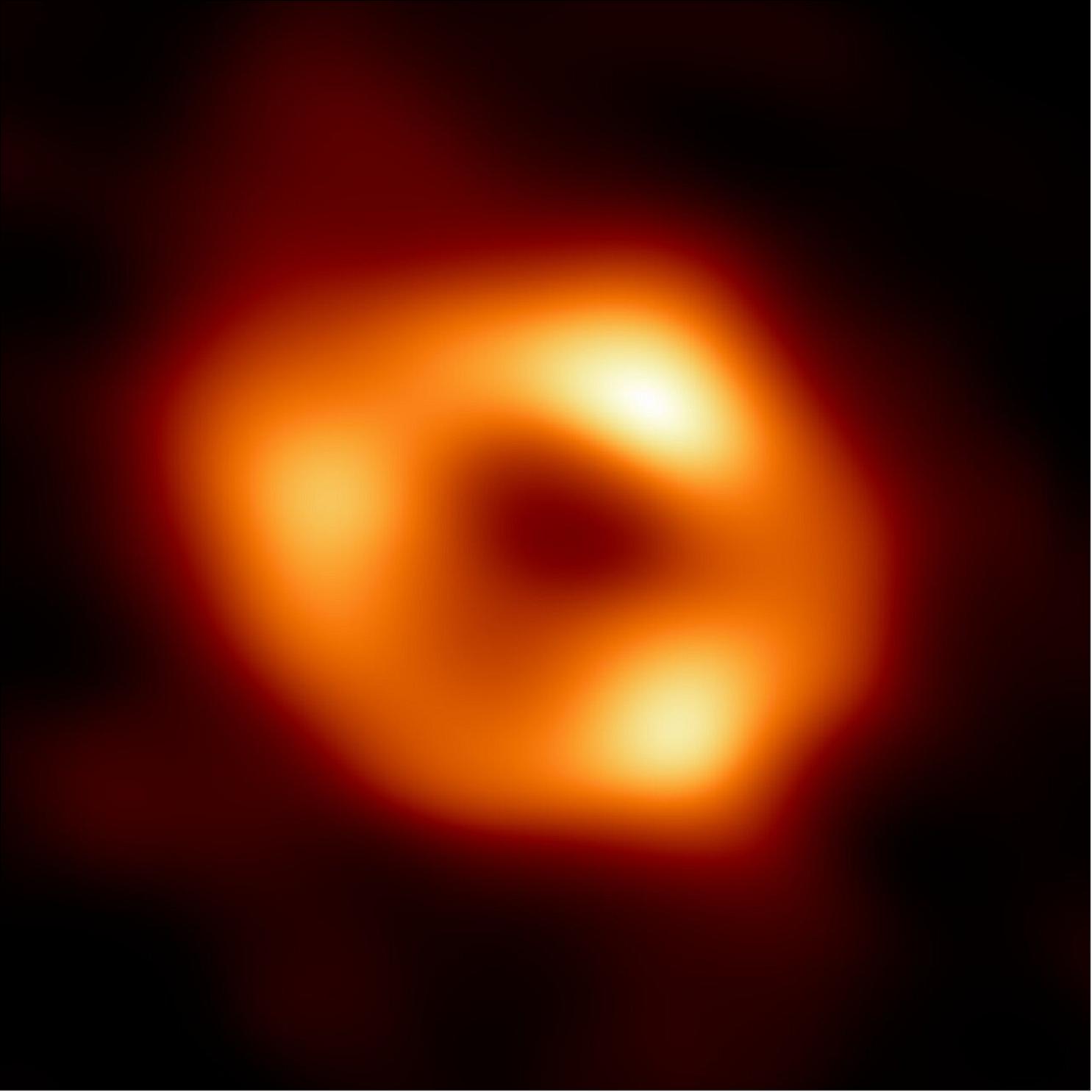
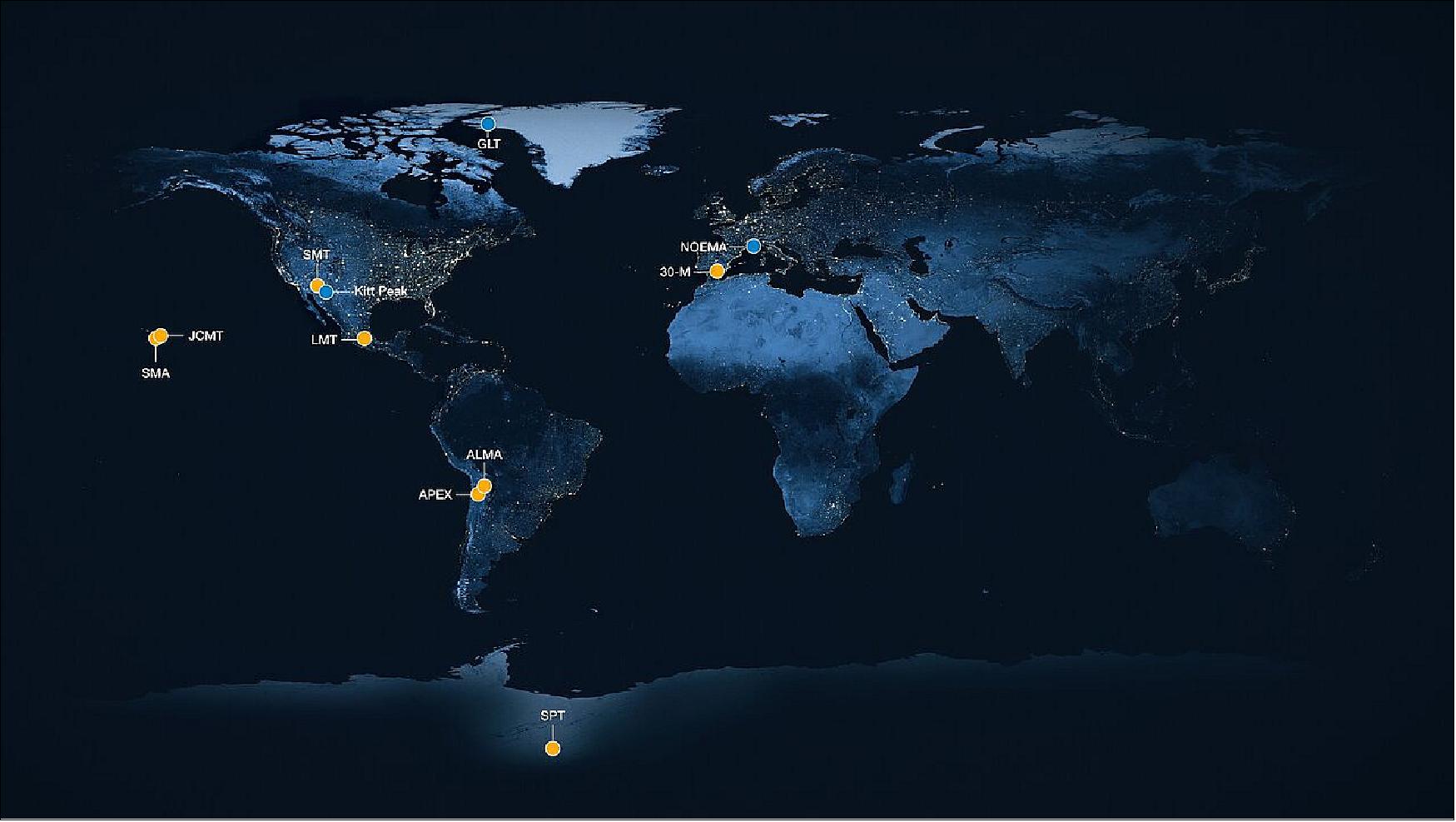
- In addition to other facilities, the EHT network of radio observatories includes the Atacama Large Millimeter/submillimeter Array (ALMA) and the Atacama Pathfinder EXperiment (APEX) in the Atacama Desert in Chile, co-owned and co-operated by ESO on behalf of its member states in Europe. Europe also contributes to the EHT observations with other radio observatories — the IRAM 30-meter telescope in Spain and, since 2018, the NOrthern Extended Millimeter Array (NOEMA) in France — as well as a supercomputer to combine EHT data hosted by the Max Planck Institute for Radio Astronomy in Germany. Moreover, Europe contributed with funding to the EHT consortium project through grants by the European Research Council and by the Max Planck Society in Germany.
- “It is very exciting for ESO to have been playing such an important role in unravelling the mysteries of black holes, and of Sgr A* in particular, over so many years,” commented ESO Director General Xavier Barcons. “ESO not only contributed to the EHT observations through the ALMA and APEX facilities but also enabled, with its other observatories in Chile, some of the previous breakthrough observations of the Galactic centre.” [2]
- The EHT achievement follows the collaboration’s 2019 release of the first image of a black hole, called M87*, at the centre of the more distant Messier 87 galaxy.
- The two black holes look remarkably similar, even though our galaxy’s black hole is more than a thousand times smaller and less massive than M87* [3]. "We have two completely different types of galaxies and two very different black hole masses, but close to the edge of these black holes they look amazingly similar,” says Sera Markoff, Co-Chair of the EHT Science Council and a professor of theoretical astrophysics at the University of Amsterdam, the Netherlands. "This tells us that General Relativity governs these objects up close, and any differences we see further away must be due to differences in the material that surrounds the black holes.”
- This achievement was considerably more difficult than for M87*, even though Sgr A* is much closer to us. EHT scientist Chi-kwan (‘CK’) Chan, from Steward Observatory and Department of Astronomy and the Data Science Institute of the University of Arizona, USA, explains: “The gas in the vicinity of the black holes moves at the same speed — nearly as fast as light — around both Sgr A* and M87*. But where gas takes days to weeks to orbit the larger M87*, in the much smaller Sgr A* it completes an orbit in mere minutes. This means the brightness and pattern of the gas around Sgr A* were changing rapidly as the EHT Collaboration was observing it — a bit like trying to take a clear picture of a puppy quickly chasing its tail.”
- The researchers had to develop sophisticated new tools that accounted for the gas movement around Sgr A*. While M87* was an easier, steadier target, with nearly all images looking the same, that was not the case for Sgr A*. The image of the Sgr A* black hole is an average of the different images the team extracted, finally revealing the giant lurking at the centre of our galaxy for the first time.
- The effort was made possible through the ingenuity of more than 300 researchers from 80 institutes around the world that together make up the EHT Collaboration. In addition to developing complex tools to overcome the challenges of imaging Sgr A*, the team worked rigorously for five years, using supercomputers to combine and analyse their data, all while compiling an unprecedented library of simulated black holes to compare with the observations.
- Scientists are particularly excited to finally have images of two black holes of very different sizes, which offers the opportunity to understand how they compare and contrast. They have also begun to use the new data to test theories and models of how gas behaves around supermassive black holes. This process is not yet fully understood but is thought to play a key role in shaping the formation and evolution of galaxies.
- “Now we can study the differences between these two supermassive black holes to gain valuable new clues about how this important process works,” said EHT scientist Keiichi Asada from the Institute of Astronomy and Astrophysics, Academia Sinica, Taipei. “We have images for two black holes — one at the large end and one at the small end of supermassive black holes in the Universe — so we can go a lot further in testing how gravity behaves in these extreme environments than ever before.”
- Progress on the EHT continues: a major observation campaign in March 2022 included more telescopes than ever before. The ongoing expansion of the EHT network and significant technological upgrades will allow scientists to share even more impressive images as well as movies of black holes in the near future.
![Figure 23: Size comparison of the two black holes imaged by the Event Horizon Telescope (EHT) Collaboration: M87*, at the heart of the galaxy Messier 87, and Sagittarius A* (Sgr A*), at the centre of the Milky Way. The image shows the scale of Sgr A* in comparison with both M87* and other elements of the Solar System such as the orbits of Pluto and Mercury. Also displayed is the Sun’s diameter and the current location of the Voyager 1 space probe, the furthest spacecraft from Earth. M87*, which lies 55 million light-years away, is one of the largest black holes known. While Sgr A*, 27 000 light-years away, has a mass roughly four million times the Sun’s mass, M87* is more than 1000 times more massive. Because of their relative distances from Earth, both black holes appear the same size in the sky. [image credit: EHT collaboration (acknowledgment: Lia Medeiros, xkcd)] 36)](https://www.eoportal.org/ftp/satellite-missions/a/Alma_300622/Alma_Auto56.jpeg)
• May 12, 2022: The black hole at the center of our galaxy is the subject of a groundbreaking new image from the Event Horizon Telescope (EHT) collaboration. — As the Event Horizon Telescope collected data for its remarkable new image of the Milky Way’s supermassive black hole, a legion of other telescopes including three NASA X-ray observatories in space was also watching. 37)
- Astronomers are using these observations to learn more about how the black hole in the center of the Milky Way galaxy – known as Sagittarius A * (Sgr A* for short) – interacts with, and feeds off, its environment some 27,000 light years from Earth.
![Figure 24: This composite image of the supermassive black hole at the center of the Milky Way galaxy includes data from multiple NASA telescopes. The inset image from the Event Horizon Telescope shows the region around the black hole’s event horizon, the boundary beyond which not even light can escape [image credit: X-ray: NASA/CXC/SAO; IR: NASA/HST/STScI. Inset: Radio (EHT Collaboration)]](https://www.eoportal.org/ftp/satellite-missions/a/Alma_300622/Alma_Auto55.jpeg)
- When the Event Horizon Telescope (EHT) observed Sgr A* in April 2017 to make the new image, scientists in the collaboration also peered at the same black hole with facilities that detect different wavelengths of light. In this multiwavelength observing campaign, they assembled X-ray data from NASA’s Chandra X-ray Observatory, Nuclear Spectroscopic Telescope Array (NuSTAR), and the Neil Gehrels Swift Observatory; radio data from the East Asian Very Long-Baseline Interferometer (VLBI) network and the Global 3-millimeter VLBI array; and infrared data from the European Southern Observatory’s Very Large Telescope in Chile.
- “The Event Horizon Telescope has captured yet another remarkable image, this time of the giant black hole at the center of our own home galaxy,” said NASA Administrator Bill Nelson. “Looking more comprehensively at this black hole will help us learn more about its cosmic effects on its environment, and exemplifies the international collaboration that will carry us into the future and reveal discoveries we could never have imagined.”
- One important goal was to catch X-ray flares, which are thought to be driven by magnetic processes similar to those seen on the Sun, but can be tens of millions of times more powerful. These flares occur approximately daily within the area of sky observed by the EHT, a region slightly larger than the event horizon of Sgr A*, the point of no return for matter falling inward. Another goal was to gain a critical glimpse of what is happening on larger scales. While the EHT result shows striking similarities between Sgr A* and the previous black hole it imaged, M87*, the wider picture is much more complex.
- “If the new EHT image shows us the eye of a black hole hurricane, then these multiwavelength observations reveal winds and rain the equivalent of hundreds or even thousands of miles beyond,” said Daryl Haggard of McGill University in Montreal, Canada, who is one of the lead scientists of the multiwavelength campaign. “How does this cosmic storm interact with and even disrupt its galactic environment?”
- One of the biggest ongoing questions surrounding black holes is exactly how they collect, ingest, or even expel material orbiting them at near light speed, in a process known as “accretion.” This process is fundamental to the formation and growth of planets, stars, and black holes of all sizes, throughout the universe.
- Chandra images of hot gas around Sgr A* are crucial for accretion studies because they tell us how much material is captured from nearby stars by the black hole’s gravity, as well as how much manages to make its way close to the event horizon. This critical information is not available with current telescopes for any other black hole in the universe, including M87*.
- “Astronomers can largely agree on the basics – that black holes have material swirling around them and some of it falls across the event horizon forever,” said Sera Markoff of the University of Amsterdam in the Netherlands, another coordinator of the multiwavelength observations. “With all of the data that we’ve gathered for Sgr A* we can go a lot further than this basic picture.”
- Scientists in the large international collaboration compared the data from NASA’s high-energy missions and the other telescopes to state-of-the-art computational models that take into account factors such as Einstein’s general theory of relativity, effects of magnetic fields, and predictions of how much radiation the material around the black hole should generate at different wavelengths.
- The comparison of the models with the measurements gives hints that the magnetic field around the black hole is strong and that the angle between the line of sight to the black hole and its spin-axis is low – less than about 30 degrees. If confirmed this means that from our vantage point we are looking down on Sgr A* and its ring more than we are from side-on, surprisingly similar to EHT’s first target, M87*.
- “None of our models matches the data perfectly, but now we have more specific information to work from,” said Kazuhiro Hada from the National Astronomical Observatory of Japan. “The more data we have the more accurate our models, and ultimately our understanding of black hole accretion, will become.”
- The researchers also managed to catch X-ray flares – or outbursts – from Sgr A* during the EHT observations: a faint one seen with Chandra and Swift, and a moderately bright one seen with Chandra and NuSTAR. X-ray flares with a similar brightness to the latter are regularly observed with Chandra, but this is the first time that the EHT simultaneously observed Sgr A*, offering an extraordinary opportunity to identify the responsible mechanism using actual images.
- The millimeter-wave intensity and variability observed with EHT increases in the few hours immediately after the brighter X-ray flare, a phenomenon not seen in millimeter observations a few days earlier. Analysis and interpretation of the EHT data immediately following the flare will be reported in future publications.
- The EHT team’s results are being published on May 12 in a special issue of The Astrophysical Journal Letters. The multiwavelength results are mainly described in papers II and V.
• May 6, 2022: A group of astronomers, led by Sierk van Terwisga from the Max Planck Institute for Astronomy (MPIA), have analysed the mass distribution of over 870 planet-forming disks in the Orion A cloud. By exploiting the statistical properties of this unprecedented large sample of disks and developing an innovative data processing scheme, they found that far away from harsh environments like hot stars, the decline in disk mass only depends on their age. The results indicate that, at least within 1000 light-years of the Earth, planet-forming disks and planetary systems evolve in similar ways. 38) 39)
Some of the most exciting questions in present-day astronomical research are: What do other planetary systems look like? How comparable is the Solar System to other planetary systems? A team of astronomers have now contributed crucial clues to solving this puzzle. “Up to now, we didn’t know for sure which properties dominate the evolution of planet-forming disks around young stars”, says Sierk van Terwisga, who is a scientist at the Max Planck Institute for Astronomy in Heidelberg, Germany. He is the lead author of the underlying research article published in Astronomy & Astrophysics today. “Our new results now indicate that in environments without any relevant external influence, the observed disk mass available for forming new planets only depends on the age of the star-disk system”, van Terwisga adds.
- The disk mass is the key property when studying the evolution of planet-forming disks. This quantity determines how much material is available to be transformed into planets. Depending on the disk age, it may also provide clues about the planets already present there. External effects like irradiation and winds from nearby massive stars obviously impact the disk survival. However, such environments are rare, and those processes do not reveal much about the disks themselves. Instead, astronomers are more interested in internal disk properties such as age, chemical composition, or the parental cloud dynamics from which the young stars with their disks emerged.
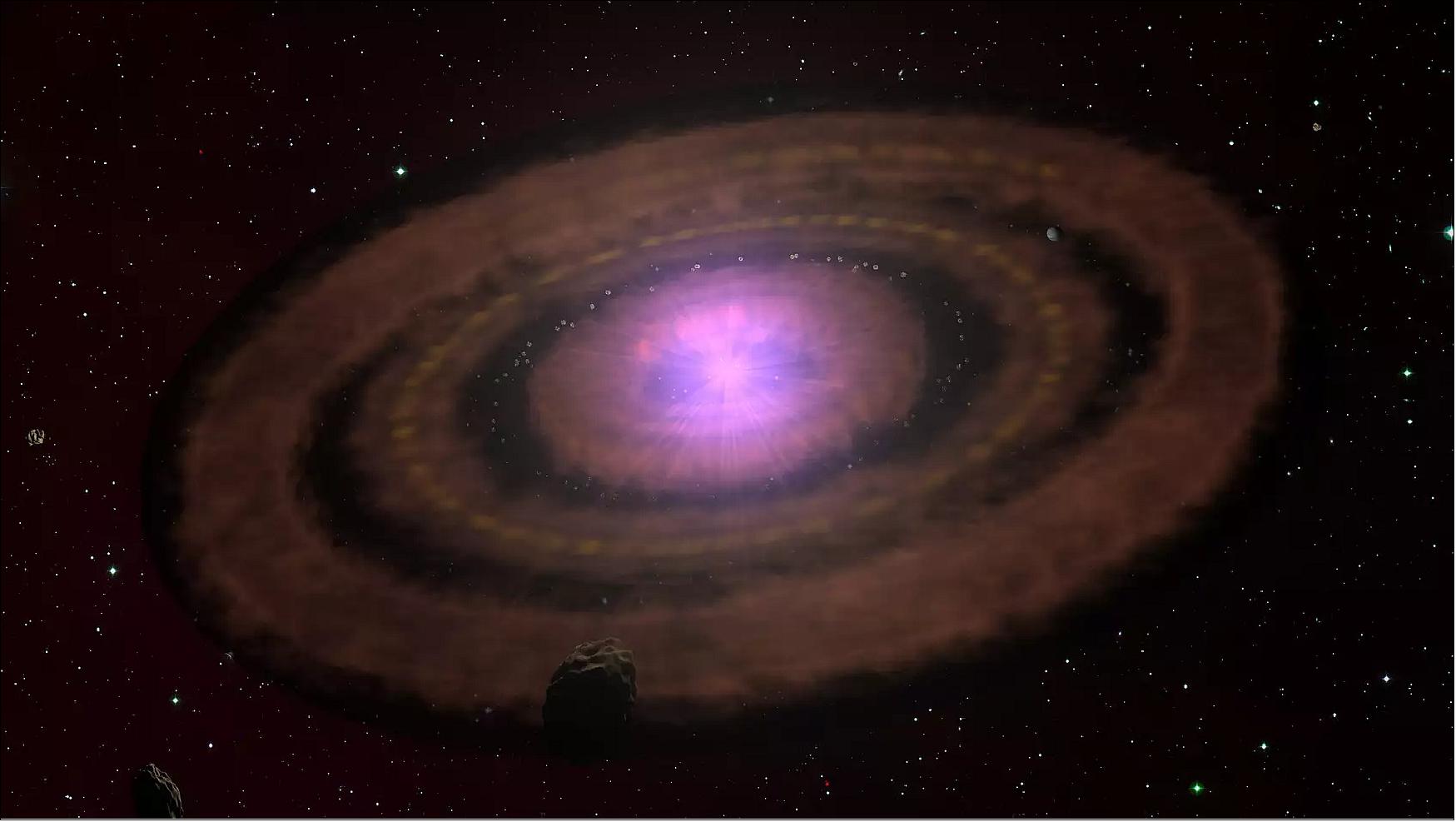
- To disentangle the various contributions, the team of astronomers selected a large and well-known region of young stars with disks, the Orion A cloud. It is approximately 1350 light-years away from Earth. “Orion A provided us with an unprecedented large sample size of more than 870 disks around young stars. It was crucial to be able to look for small variations in the disk mass depending on age and even on the local environments inside the cloud,” Álvaro Hacar, a co-author and scientist at the University of Vienna, Austria, explains. The sample stems from earlier observations with the Herschel Space Telescope, which permitted identifying the disks. Combining several wavelengths provided a criterion to estimate their ages. Since they all belong to the same cloud, the astronomers expected little influence from chemistry and cloud history variations. They also avoided any impact from massive stars in the nearby Orion Nebula Cluster (ONC) by rejecting disks closer than 13 light-years.
- To measure the disk mass, the team employed the Atacama Large Millimeter/Submillimeter Array (ALMA) located on the Chajnantor Plateau in the Chilean Atacama Desert. ALMA consists of 66 parabolic antennas, functioning as a single telescope with a tunable angular resolution. The scientists applied an observing mode that allowed them to target each disk efficiently at a wavelength of about 1.2 mm. The cold disks are bright in this spectral range. On the other hand, the central stars’ contribution is negligible. With this approach, the astronomers determined the disks’ dust masses. However, the observations are insensitive to objects much larger than a few millimetres, e.g. rocks and planets. Therefore, the team effectively measured the mass of the disk material capable of forming planets.

- Before calculating the disk masses, the astronomers combined and calibrated the data from several dozens of ALMA telescopes. This task becomes quite a challenge when dealing with large data sets. Using standard methods, it would have taken months to process the collected data. Instead, the team developed a new method using parallel computers. “Our new approach improved the processing speed by a factor of 900,” co-author Raymond Oonk from the collaborating IT service provider SURF points out. The 3000 CPU hours required to finish the task and prepare the data for subsequent analysis elapsed in less than a day.
- Altogether, Orion A contains planet-forming disks, each with dust amounting to up to a few hundred Earth-masses. However, from the 870 disks, only 20 hold dust equivalent to 100 earths or more. In general, the number of disks declines rapidly with mass, with a majority containing less than 2.2 Earth-masses of dust. “In order to look for variations, we have dissected the Orion A cloud and analysed these regions separately. Thanks to the hundreds of disks, the sub-samples were still sufficiently large to yield statistically meaningful results”, van Terwisga explains.
- Indeed, the scientists found minor variations in the disk mass distributions on scales of tens of light-years within Orion A. However, all of them can be explained as an age effect, meaning within a few million years, disk masses tend to decline towards older populations. Within the error margins, clusters of planet-forming disks of the same age exhibit the same mass distribution. It is not at all surprising to find the dust mass in planet-forming disks to decrease in time. After all, dust is one of the raw materials for planets. Hence, planet formation certainly reduces the amount of free dust. Other well-known processes are dust migration towards the disk centre and dust evaporation by irradiation from the host star. Still, it is surprising to see such a strong correlation between disk mass and age.
- All those disks emerged from the same environment that now constitutes the Orion A cloud. How does this compare to other young star-disk populations? The astronomers addressed this question by comparing their results to several nearby star-forming regions with planet-forming disks. Except for two, all of them nicely fit the mass-age relation found in Orion A. “Altogether, we think our study proves that at least within the next 1000 light-years or so, all populations of planet-forming disks show the same mass distribution at a given age. And they seem to be evolving in more or less the same way”, van Terwisga concludes. The result may even hint at the formation of stunningly similar planetary systems.
- As a next step, the scientists will look at possible impacts from nearby stars on smaller scales of a few light-years. While they avoided the strong radiation field caused by the massive stars in the ONC, there are potentially fainter field stars that may affect the dust in neighbouring disks and alter the disk mass statistics. Such contributions may explain some of the deviations found in the disk mass to age relation. The results can help strengthen the overall picture of a planet-forming disk evolution dominated by age.
• March 28, 2022: Scientists studying V Hydrae (V Hya) have witnessed the star’s mysterious death throes in unprecedented detail. Using the Atacama Large Millimeter/submillimeter Array (ALMA) and data from the Hubble Space Telescope (HST), the team discovered six slowly-expanding rings and two hourglass-shaped structures caused by the high-speed ejection of matter out into space. The results of the study are published in The Astrophysical Journal. 40) 41) 42)
- V Hya is a carbon-rich asymptotic giant branch (AGB) star located approximately 1,300 light-years from Earth in the constellation Hydra. More than 90-percent of stars with a mass equal to or greater than the Sun evolve into AGB stars as the fuel required to power nuclear processes is stripped away. Among these millions of stars, V Hya has been of particular interest to scientists due to its so-far unique behaviors and features, including extreme-scale plasma eruptions that happen roughly every 8.5 years and the presence of a nearly invisible companion star that contributes to V Hya’s explosive behavior.
- “Our study dramatically confirms that the traditional model of how AGB stars die—through the mass ejection of fuel via a slow, relatively steady, spherical wind over 100,000 years or more—is at best, incomplete, or at worst, incorrect,” said Raghvendra Sahai, an astronomer at NASA’s Jet Propulsion Laboratory, and the principal researcher on the study. “It is very likely that a close stellar or substellar companion plays a significant role in their deaths, and understanding the physics of binary interactions is both important across astrophysics and one of its greatest challenges. In the case of V Hya, the combination of a nearby and a hypothetical distant companion star is responsible, at least to some degree, for the presence of its six rings, and the high-speed outflows that are causing the star’s miraculous death.”
- Mark Morris, an astronomer at UCLA and a co-author on the research added, “V Hydra has been caught in the process of shedding its atmosphere—ultimately most of its mass—which is something that most late-stage red giant stars do. Much to our surprise, we have found that the matter, in this case, is being expelled as a series of outflowing rings. This is the first and only time that anybody has seen that the gas being ejected from an AGB star can be flowing out in the form of a series of expanding ‘smoke rings.’”
![Figure 27: The carbon-rich star V Hydrae is in its final act, and so far, its death has proved magnificent and violent. Scientists studying the star have discovered six outflowing rings (shown here in composite), and other structures created by the explosive mass ejection of matter into space [image credit: ALMA (ESO/NAOJ/NRAO)/S. Dagnello (NRAO/AUI/NSF)]](https://www.eoportal.org/ftp/satellite-missions/a/Alma_300622/Alma_Auto52.jpeg)
- The six rings have expanded outward from V Hya over the course of roughly 2,100 years, adding matter to and driving the growth of a high-density flared and warped disk-like structure around the star. The team has dubbed this structure the DUDE, or Disk Undergoing Dynamical Expansion.
- “The end state of stellar evolution—when stars undergo the transition from being red giants to ending up as white dwarf stellar remnants—is a complex process that is not well understood,” said Morris. “The discovery that this process can involve the ejections of rings of gas, simultaneous with the production of high-speed, intermittent jets of material, brings a new and fascinating wrinkle to our exploration of how stars die.”
- Sahai added, “V Hya is in the brief but critical transition phase that does not last very long, and it is difficult to find stars in this phase, or rather ‘catch them in the act. We got lucky and were able to image all of the different mass-loss phenomena in V Hya to better understand how dying stars lose mass at the end of their lives.”
- In addition to a full set of expanding rings and a warped disk, V Hya’s final act features two hourglass-shaped structures—and an additional jet-like structure—that are expanding at high speeds of more than half a million miles per hour (240 km/s). Large hourglass structures have been observed previously in planetary nebulae, including MyCn 18 —also known as the Engraved Hourglass Nebula—a young emission nebula located roughly 8,000 light-years from Earth in the southern constellation of Musca, and the more well-known Southern Crab Nebula, an emission nebula located roughly 7,000 light-years from Earth in the southern constellation Centaurus.
- In addition to a full set of expanding rings and a warped disk, V Hya’s final act features two hourglass-shaped structures—and an additional jet-like structure—that are expanding at high speeds of more than half a million miles per hour (240 km/s). Large hourglass structures have been observed previously in planetary nebulae, including MyCn 18 —also known as the Engraved Hourglass Nebula—a young emission nebula located roughly 8,000 light-years from Earth in the southern constellation of Musca, and the more well-known Southern Crab Nebula, an emission nebula located roughly 7,000 light-years from Earth in the southern constellation Centaurus.
- Sahai said, “We first observed the presence of very fast outflows in 1981. Then, in 2022, we found a jet-like flow consisting of compact plasma blobs ejected at high speeds from V Hya. And now, our discovery of wide-angle outflows in V Hya connects the dots, revealing how all these structures can be created during the evolutionary phase that this extra-luminous red giant star is now in.”
- Due to both the distance and the density of the dust surrounding the star, studying V Hya required a unique instrument with the power to clearly see matter that is both very far away and also difficult or impossible to detect with most optical telescopes. The team enlisted ALMA’s Band 6 (1.23 mm) and Band 7 (.85 mm) receivers, which revealed the star’s multiple rings and outflows in stark clarity.
- “The processes taking place at the end stages of low mass stars, and during the AGB phase in particular, have long fascinated astronomers and have been challenging to understand,” said Joe Pesce, an astronomer and NSF program officer for NRAO/ALMA. “The capabilities and resolution of ALMA are finally allowing us to witness these events with the extraordinary detail necessary to provide some answers and enhance our understanding of an event that happens to most of the stars in the Universe.”
- Sahai added that the incorporation of infrared, optical, and ultraviolet data into the study created a complete multi-wavelength picture of what might be one of the greatest shows in the Milky Way, at least for astronomers. “Each time we observe V Hya with new observational capabilities, it becomes more and more like a circus, characterized by an even bigger variety of impressive feats. V Hydrae has impressed us with its multiple rings and acts, and because our own Sun may one day experience a similar fate, it has us at rapt attention.”
• March 8, 2022: Using the Atacama Large Millimeter/submillimeter Array (ALMA) in Chile, researchers at Leiden Observatory in the Netherlands have for the first time detected dimethyl ether in a planet-forming disc. With nine atoms, this is the largest molecule identified in such a disc to date. It is also a precursor of larger organic molecules that can lead to the emergence of life. 43)
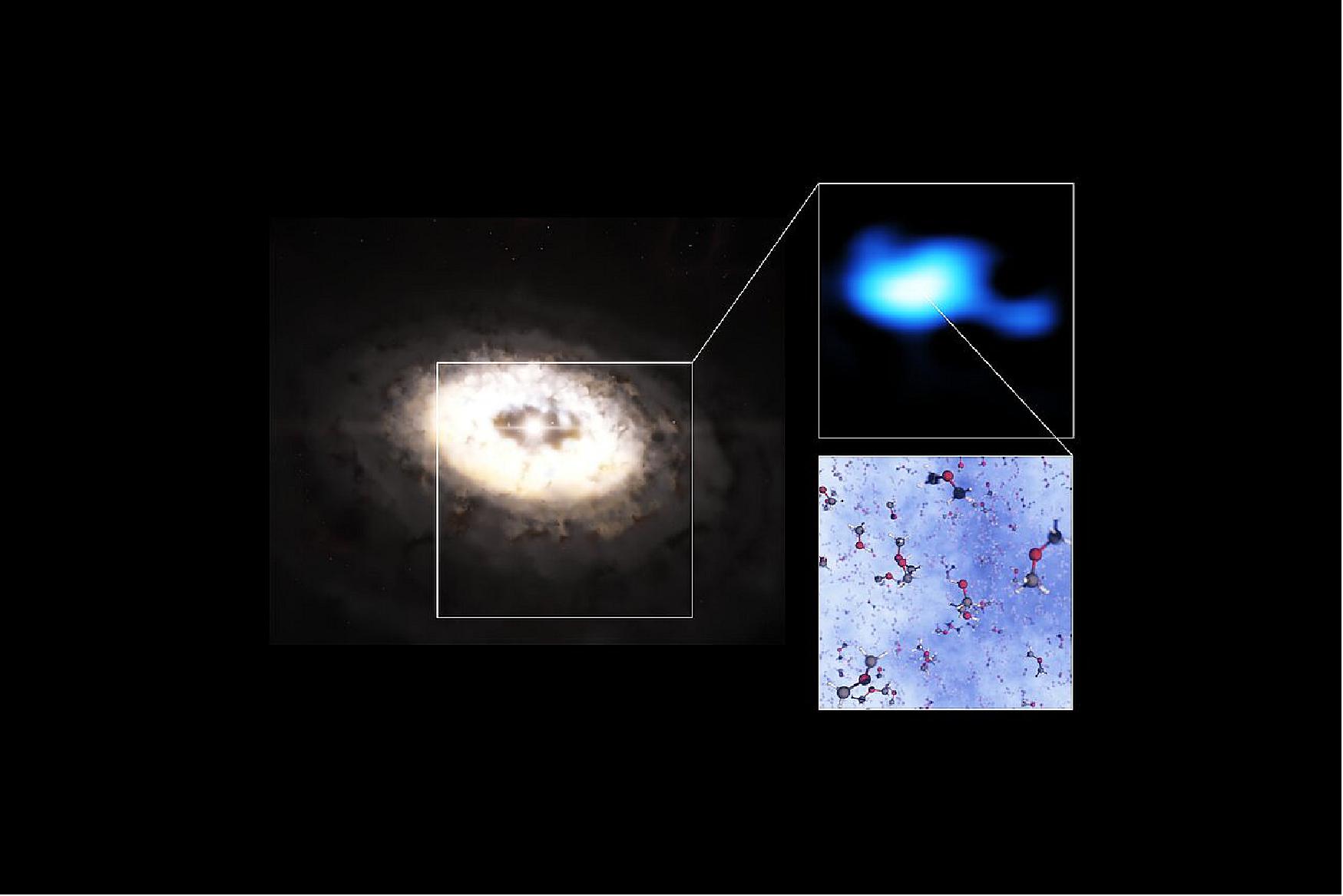
- "From these results, we can learn more about the origin of life on our planet and therefore get a better idea of the potential for life in other planetary systems. It is very exciting to see how these findings fit into the bigger picture," says Nashanty Brunken, a Master's student at Leiden Observatory, part of Leiden University, and lead author of the study published today in Astronomy & Astrophysics.
- Dimethyl ether is an organic molecule commonly seen in star-forming clouds, but had never before been found in a planet-forming disc. The researchers also made a tentative detection of methyl formate, a complex molecule similar to dimethyl ether that is also a building block for even larger organic molecules.
- "It is really exciting to finally detect these larger molecules in discs. For a while we thought it might not be possible to observe them,” says co-author Alice Booth, also a researcher at Leiden Observatory.
- The molecules were found in the planet-forming disc around the young star IRS 48 (also known as Oph-IRS 48) with the help of ALMA, an observatory co-owned by the European Southern Observatory (ESO). IRS 48, located 444 light-years away in the constellation Ophiuchus, has been the subject of numerous studies because its disc contains an asymmetric, cashew-nut-shaped “dust trap”. This region, which likely formed as a result of a newly born planet or small companion star located between the star and the dust trap, retains large numbers of millimetre-sized dust grains that can come together and grow into kilometre-sized objects like comets, asteroids and potentially even planets.
- Many complex organic molecules, such as dimethyl ether, are thought to arise in star-forming clouds, even before the stars themselves are born. In these cold environments, atoms and simple molecules like carbon monoxide stick to dust grains, forming an ice layer and undergoing chemical reactions, which result in more complex molecules. Researchers recently discovered that the dust trap in the IRS 48 disc is also an ice reservoir, harbouring dust grains covered with this ice rich in complex molecules. It was in this region of the disc that ALMA has now spotted signs of the dimethyl ether molecule: as heating from IRS 48 sublimates the ice into gas, the trapped molecules inherited from the cold clouds are freed and become detectable.
- “What makes this even more exciting is that we now know these larger complex molecules are available to feed forming planets in the disc,” explains Booth. “This was not known before as in most systems these molecules are hidden in the ice.”
- The discovery of dimethyl ether suggests that many other complex molecules that are commonly detected in star-forming regions may also be lurking on icy structures in planet-forming discs. These molecules are the precursors of prebiotic molecules such as amino acids and sugars, which are some of the basic building blocks of life.
- By studying their formation and evolution, researchers can therefore gain a better understanding of how prebiotic molecules end up on planets, including our own. “We are incredibly pleased that we can now start to follow the entire journey of these complex molecules from the clouds that form stars, to planet-forming discs, and to comets. Hopefully with more observations we can get a step closer to understanding the origin of prebiotic molecules in our own Solar System,” says Nienke van der Marel, a Leiden Observatory researcher who also participated in the study. 44)
- Future studies of IRS 48 with ESO’s Extremely Large Telescope (ELT), currently under construction in Chile and set to start operations later this decade, will allow the team to study the chemistry of the very inner regions of the disc, where planets like Earth may be forming.
• January 13, 2022: Scientists using the Atacama Large Millimeter/submillimeter Array (ALMA) and the Karl G. Jansky Very Large Array (VLA) made a rare detection of a likely stellar flyby event in the Z Canis Majoris (Z CMa) star system. An intruder—not bound to the system—object came in close proximity to and interacted with the environment surrounding the binary protostar, causing the formation of chaotic, stretched-out streams of dust and gas in the disk surrounding it. 45)
- While such intruder-based flyby events have previously been witnessed with some regularity in computer simulations of star formation, few convincing direct observations have ever been made, and until now, the events have remained largely theoretical.
- “Observational evidence of flyby events is difficult to obtain because these events happen fast and it is difficult to capture them in action. What we have done with our ALMA Band 6 and VLA observations is equivalent to capturing lightning striking a tree,” said Ruobing Dong, an astronomer at the University of Victoria in Canada and the principal investigator on the new study. “This discovery shows that close encounters between young stars harboring disks do happen in real life, and they are not just theoretical situations seen in computer simulations. Prior observational studies had seen flybys, but hadn’t been able to collect the comprehensive evidence we were able to obtain of the event at Z CMa.”
- Perturbations, or disturbances, like those at Z CMa aren’t typically caused by intruders, but rather by sibling stars growing up together in space. Hauyu Baobab Liu, an astronomer at the Institute of Astronomy and Astrophysics at Academia Sinica in Taiwan and a co-author on the paper, said, “Most often, stars do not form in isolation. The twins, or even triplets or quadruplets, born together may be gravitationally attracted and, as a result, closely approach each other. During these moments, some material on the stars’ protoplanetary disks may be stripped off to form extended gas streams that provide clues to astronomers about the history of past stellar encounters.”
- Nicolás Cuello, an astrophysicist and Marie Curie Fellow at Université Grenoble Alpes in France and a co-author on the paper added that in the case of Z CMa, it was the morphology, or structure, of these streams that helped scientists to identify and pinpoint the intruder. “When a stellar encounter occurs, it causes changes in disk morphology—spirals, warps, shadows, etc.—that could be considered as flyby fingerprints. In this case, by looking very carefully at Z CMa’s disk, we revealed the presence of several flyby fingerprints.”
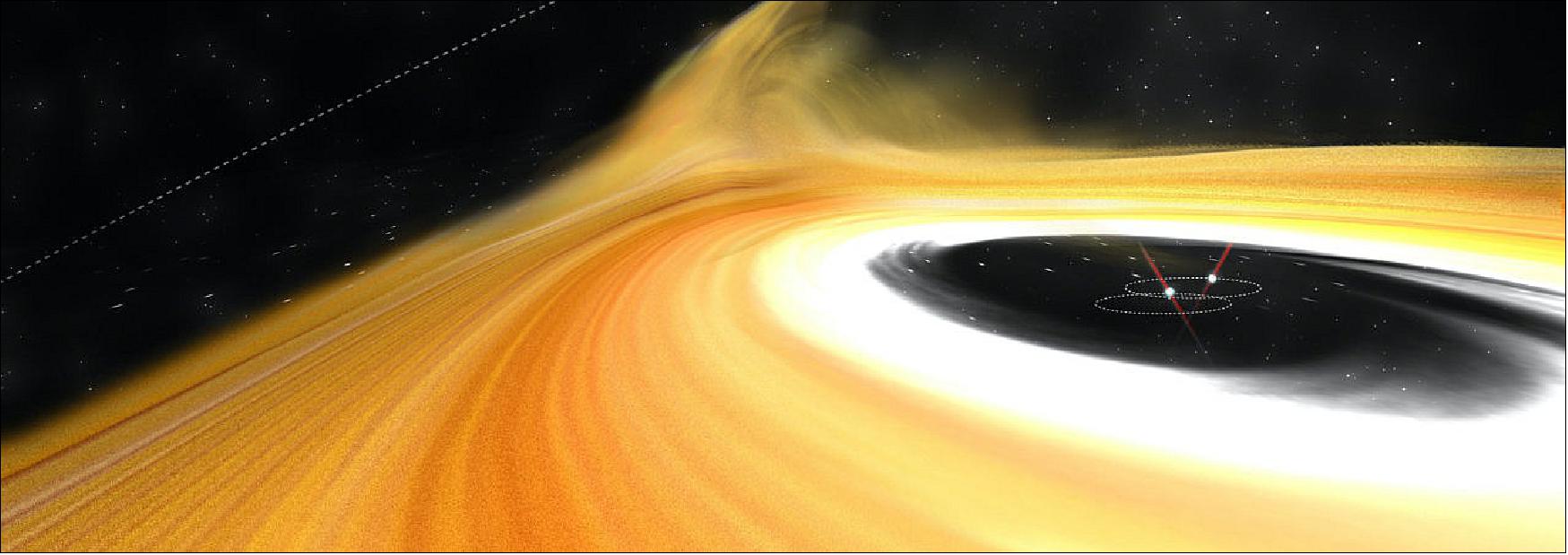
- These fingerprints not only helped scientists to identify the intruder, but also led them to consider what these interactions might mean for the future of Z CMa and the baby planets being born in the system, a process that so far has remained a mystery to scientists. “What we now know with this new research is that flyby events do occur in nature and that they have major impacts on the gaseous circumstellar disks, which are the birth cradles of planets, surrounding baby stars,” said Cuello. “Flyby events can dramatically perturb the circumstellar disks around participant stars, as we’ve seen with the production of long streamers around Z CMa.”
- Liu added, “These perturbers not only cause gaseous streams but may also impact the thermal history of the involved host stars, like Z CMa. This can lead to such violent events as accretion outbursts, and also impact the development of the overall star system in ways that we haven’t yet observed or defined.”
- Dong said that studying the evolution and growth of young star systems throughout the galaxy helps scientists to better understand our own Solar System’s origin. “Studying these types of events gives a window into the past, including what might have happened in the early development of our own Solar System, critical evidence of which is long since gone. Watching these events take place in a newly forming star system provides us with the information needed to say, ‘Ah ha! This is what may have happened to our own Solar System long ago.’ Right now, VLA and ALMA have given us the first evidence to solve this mystery, and the next generations of these technologies will open windows on the Universe that we have yet only dreamed of.” 46)
- Recently, the National Radio Astronomy Observatory (NRAO) received approval for its Central Development Laboratory (CDL) to develop a multi-million dollar upgrade to ALMA’s Band 6 receiver, and the Observatory’s next generation VLA (ngVLA) received strong support from the astronomical community in the Astro2020 Decadal Survey. Technological advancements for both telescopes will lead to better observations, and a potentially significant increase in the discovery of difficult-to-see objects, like Z CMa’s stellar intruder. Both projects are funded in part by the National Science Foundation (NSF). “These observations highlight the synergy that can come from a newer instrument working in concert with a more seasoned one, and how good a workhorse the ALMA Band 6 receiver is,” said Dr. Joe Pesce, astrophysicist and ALMA Program Director at the NSF. “I look forward to the even-better results the upgraded ALMA Band 6 receiver will enable.”
• November 4, 2021: A new discovery is shedding light on how fluorine — an element found in our bones and teeth as fluoride — is forged in the Universe. Using the Atacama Large Millimeter/submillimeter Array (ALMA), in which the European Southern Observatory (ESO) is a partner, a team of astronomers have detected this element in a galaxy that is so far away its light has taken over 12 billion years to reach us. This is the first time fluorine has been spotted in such a distant star-forming galaxy. 47)
- “We all know about fluorine because the toothpaste we use every day contains it in the form of fluoride,” says Maximilien Franco from the University of Hertfordshire in the UK, who led the new study, published today in Nature Astronomy. Like most elements around us, fluorine is created inside stars but, until now, we did not know exactly how this element was produced. “We did not even know which type of stars produced the majority of fluorine in the Universe!”
- Franco and his collaborators spotted fluorine (in the form of hydrogen fluoride) in the large clouds of gas of the distant galaxy NGP–190387, which we see as it was when the Universe was only 1.4 billion years old, about 10% of its current age. Since stars expel the elements they form in their cores as they reach the end of their lives, this detection implies that the stars that created fluorine must have lived and died quickly.
- The team believes that Wolf–Rayet stars, very massive stars that live only a few million years, a blink of the eye in the Universe’s history, are the most likely production sites of fluorine. They are needed to explain the amounts of hydrogen fluoride the team spotted, they say. Wolf–Rayet stars had been suggested as possible sources of cosmic fluorine before, but astronomers did not know until now how important they were in producing this element in the early Universe.
- “We have shown that Wolf–Rayet stars, which are among the most massive stars known and can explode violently as they reach the end of their lives, help us, in a way, to maintain good dental health!” jokes Franco.
- Besides these stars, other scenarios for how fluorine is produced and expelled have been put forward in the past. An example includes pulsations of giant, evolved stars with masses up to few times that of our Sun, called asymptotic giant branch stars. But the team believes these scenarios, some of which take billions of years to occur, might not fully explain the amount of fluorine in NGP–190387.
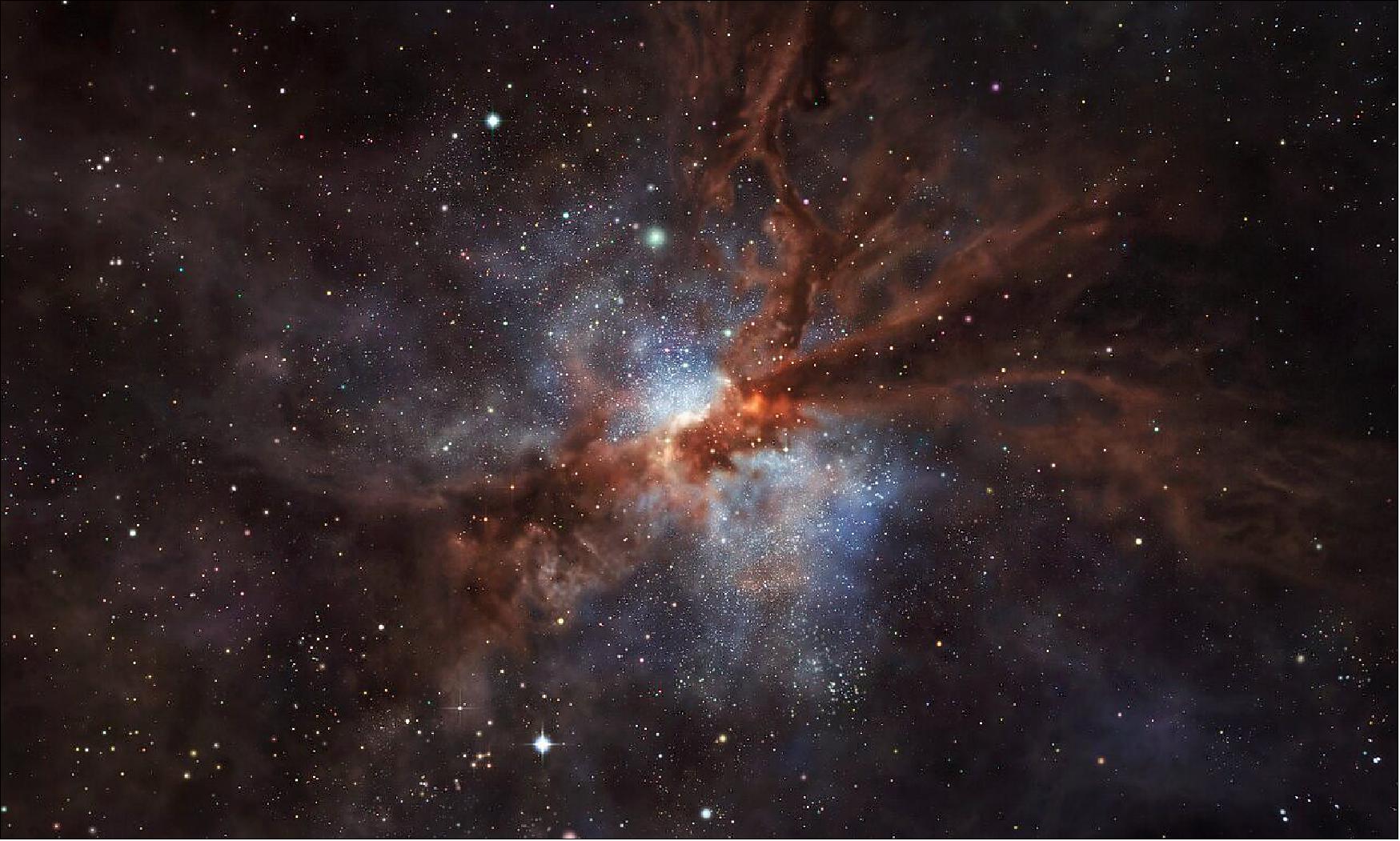
- “For this galaxy, it took just tens or hundreds of millions of years to have fluorine levels comparable to those found in stars in the Milky Way, which is 13.5 billion years old. This was a totally unexpected result,” says Chiaki Kobayashi, a professor at the University of Hertfordshire. “Our measurement adds a completely new constraint on the origin of fluorine, which has been studied for two decades.”
- The discovery in NGP–190387 marks one of the first detections of fluorine beyond the Milky Way and its neighbouring galaxies. Astronomers have previously spotted this element in distant quasars, bright objects powered by supermassive black holes at the center of some galaxies. But never before had this element been observed in a star-forming galaxy so early in the history of the Universe.
- The team’s detection of fluorine was a chance discovery made possible thanks to the use of space and ground-based observatories. NGP–190387, originally discovered with the European Space Agency’s Herschel Space Observatory and later observed with the Chile-based ALMA, is extraordinarily bright for its distance. The ALMA data confirmed that the exceptional luminosity of NGP–190387 was partly caused by another known massive galaxy, located between NGP–190387 and the Earth, very close to the line of sight. This massive galaxy amplified the light observed by Franco and his collaborators, enabling them to spot the faint radiation emitted billions of years ago by the fluorine in NGP–190387.
- Future studies of NGP–190387 with the Extremely Large Telescope (ELT) — ESO’s new flagship project, under construction in Chile and set to start operations later this decade — could reveal further secrets about this galaxy. “ALMA is sensitive to radiation emitted by cold interstellar gas and dust,” says Chentao Yang, an ESO Fellow in Chile. “With the ELT, we will be able to observe NGP–190387 through the direct light of stars, gaining crucial information on the stellar content of this galaxy.”
- This research was presented in the paper "The ramp-up of interstellar medium enrichment at z > 4" to appear in Nature Astronomy. 48)
• September 8 2021: New receivers that will allow ALMA to study the early Universe in longest wavelengths yet successfully tested. 49)
- First light has been achieved for a new set of receivers installed on ALMA, in which ESO is a partner. The band 1 receivers pick up radio waves between 6 and 8.5 mm in length, setting a new record for the longest wavelengths that ALMA can observe. They will allow astronomers to view the early, distant Universe and to explore how planets form as never before.
- To capture radiation from cosmic sources over a broad range of wavelengths, ALMA’s 66 antennas, located on the Chajnantor plateau in Chile, are equipped with precisely tuned receivers. Each receiver type is sensitive to a particular "band" or range of wavelengths of the electromagnetic spectrum. Until recently, eight out of a planned ten receivers had been mounted on the antennas, covering altogether the window between 0.3 and 3.6 mm (bands 10 to 3).
- Now, thanks to band 1 receivers, ALMA will be equipped to observe at even longer wavelengths of light, opening a new window to explore the Universe. Scientists hope to be able to study gas in the reionization epoch of the Universe, the time when the first stars and galaxies formed. In addition, as it is able to detect larger dust grains than the other ALMA bands, band 1 is ideal to look at the growth of such grains in discs around stars, allowing astronomers to gain more insight into how planets form.
- The development of the ALMA band 1 receivers has been led by Taiwan’s Academia Sinica Institute of Astronomy and Astrophysics (ASIAA), accompanied by an international team comprising the National Astronomical Observatory of Japan (NAOJ), the University of Chile, the National Radio Astronomy Observatory (NRAO), the Herzberg Institute of Astrophysics in Canada and the National Chung-Shan Institute of Science and Technology in Taiwan. The University of Chile has been involved in the project since the beginning, helping to develop and produce optical elements such as the lenses and horn antennas for the band 1 receivers.
- Recently, the ALMA board signed a contract for the development of the final, band 2, set of ALMA receivers, which will be led by a consortium of European institutions.
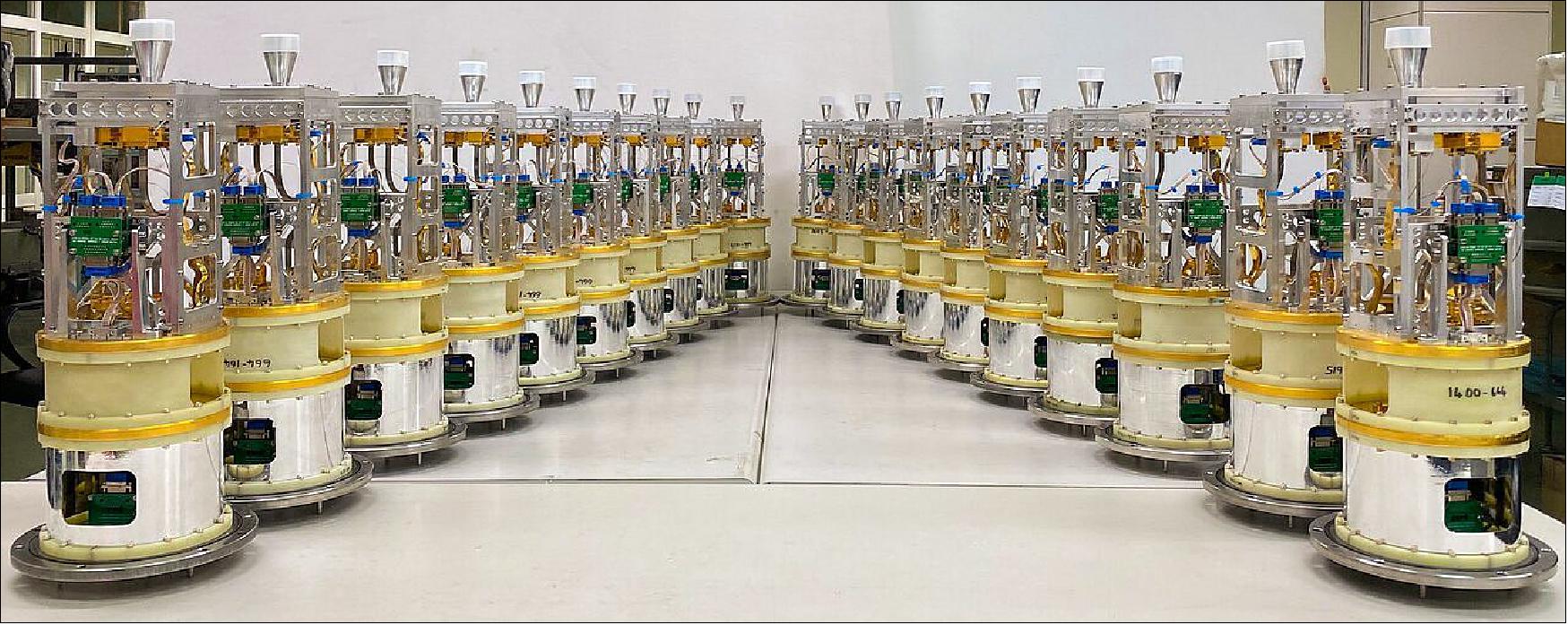
![Figure 32: Assembly of ALMA band 1 cartridges. Electronics Technician Nelson Tabilo assembles one of the cold and warm cartridges which form part of the band 1 receivers installed on ALMA. The band 1 receivers pick up radio waves between 6 and 8.5 mm in length, the longest wavelength that ALMA is able to measure [image credit: G. Siringo, ALMA (ESO/NAOJ/NRAO)]](https://www.eoportal.org/ftp/satellite-missions/a/Alma_300622/Alma_Auto4D.jpeg)
• July 29, 2021: A new study from scientists using the Atacama Large Millimeter/submillimeter Array (ALMA) suggests that previously displaced gases can re-accrete onto galaxies, potentially slowing down the process of galaxy death caused by ram pressure stripping, and creating unique structures more resistant to its effects. 50)
- “Much of the previous work on ram pressure stripped galaxies is focused on the material that gets stripped out of galaxies. In this new work we see some gas that rather than being thrown out of the galaxy never to return is instead moving like a boomerang, being ejected out but then circling around and falling back to its source,” said William Cramer, an astronomer at Arizona State University and the lead author on the new study. “By combining Hubble and ALMA data at very high resolution, we are able to prove that this process is happening.”
- Ram pressure stripping refers to the process that displaces gas from galaxies, leaving them without the material needed to form new stars. As galaxies move through their galaxy clusters, hot gas known as the intra-cluster medium—or, the space between—acts like a forceful wind, pushing gases out of the traveling galaxies. Over time, this leads to the starvation and “death” of once-active star-forming galaxies. Because ram pressure stripping can speed up the normal life cycle of galaxies and alter the amount of molecular gas within them, it is of particular interest to scientists studying the life, maturation, and death of galaxies.
- “We’ve seen in simulations that not all of the gas being pushed by ram pressure stripping escapes the galaxy because it has to reach escape velocity in order to actually escape and not fall back. The re-accretion that we’re seeing, we believe is from clouds of gas that were pushed out of the galaxy by ram pressure stripping, and didn’t achieve escape velocity, so they’re falling back,” said Jeff Kenney, an astronomer at Yale University, and the co-author on the study. “If you’re trying to predict how fast a galaxy is going to stop forming stars over time and transform into a red, or dead galaxy, then you want to understand how effective ram pressure is at stripping the gas out. If you don’t know that gas can fall back onto the galaxy and continue to recycle and form new stars, you’re going to overpredict the quenching of the stars. Having proof of this process means more accurate timelines for the lifecycle of galaxies.”
![Figure 33: Shown here in composite view, ALMA data (red/orange) reveals filament structures left behind by ram pressure stripping in a Hubble Space Telescope optical view of NGC4921. Scientists believe that these filaments are formed as magnetic fields in the galaxy prevent some matter from being stripped away [image credit: ALMA (ESO/NAOJ/NRAO)/S. Dagnello (NRAO), NASA/ESA/Hubble/K. Cook (LLNL), L. Shatz]](https://www.eoportal.org/ftp/satellite-missions/a/Alma_300622/Alma_Auto4C.jpeg)
![Figure 34: This side-by-side composite shows ALMA (red/orange) data laid over Hubble Space Telescope (optical) images of NGC4921. A new study of the spiral bar galaxy revealed filament structures similar to the Pillars of Creation but significantly larger. These structures are caused by a process known as ram pressure stripping, which pushes gas out of galaxies, leaving them without the material needed to form new stars [image credit: ALMA (ESO/NAOJ/NRAO)/S. Dagnello (NRAO), NASA/ESA/Hubble/K. Cook (LLNL), L. Shatz]](https://www.eoportal.org/ftp/satellite-missions/a/Alma_300622/Alma_Auto4B.jpeg)
- The new study focuses on NGC 4921—a barred spiral galaxy and the largest spiral galaxy in the Coma Cluster—located roughly 320 million light-years from Earth in the constellation Coma Berenices. NGC 4921 is of particular interest to scientists studying the effects of ram pressure stripping because evidence of both the process and its aftermath is abundant.
- “Ram pressure triggers star formation on the side where it is having the greatest impact on the galaxy,” said Cramer. “It’s easy to identify in NGC 4921 because there are many young blue stars on the side of the galaxy where it’s occurring.”
- Kenney added that ram pressure stripping in NGC 4921 has created a strong, visible line between where dust still exists in the galaxy and where it doesn’t. “There is a strong dust line present, and beyond that there’s almost no gas in the galaxy. We think that that part of the galaxy has been almost completely cleaned out by ram pressure.”
- Using ALMA’s Band 6 receiver, scientists were able to resolve carbon monoxide, the key to “seeing” both those areas of the galaxy devoid of gas, as well as those areas where it is re-accreting. “We know that the majority of molecular gas in galaxies is in the form of hydrogen, but molecular hydrogen is very difficult to observe directly,” said Cramer. “Carbon monoxide is commonly used as a proxy for studying molecular gas in galaxies because it is much easier to observe.”
- The ability to see more of the galaxy, even at its faintest, unveiled interesting structures likely created in the process of gas displacement, and further immune to its effects. “Ram pressure appears to form unique structures, or filaments in galaxies that are clues as to how a galaxy evolves under a ram pressure wind. In the case of NGC 4921, they bear a striking resemblance to the famous nebula, the Pillars of Creation, although on a much more massive scale,” said Cramer. “We think that they are supported by magnetic fields which are preventing them from being stripped away with the rest of the gas.”
- Observations revealed that the structures are more than just wisps of gas and dust; the filaments have mass and a lot of it. “These filaments are heavier and stickier—they hold on to their material more tightly than the rest of the galaxy’s interstellar medium can do—and they seem to be connected to that big dust ridge both in space and in velocity,” said Kenney. “They’re more like molasses than smoke. If you just blow on something that is smoke, the smoke is light, and it disperses and goes in all directions. But this is much heavier than that.”
- Although a significant breakthrough, the results of the study are only a starting point for Cramer and Kenney, who examined one small part of just one galaxy. “If we want to predict the death rate of galaxies, and the birthrate of new stars, we need to understand if and how much of the material that forms stars, originally lost to ram pressure, is actually recycled back,” said Cramer. “These observations are of just one quadrant of NGC 4921. There is likely even more gas falling back into other quadrants. While we have confirmed that some stripped gas can ‘rain’ back down, we need more observations to quantify how much gas falls back and how many new stars form as a result.”
- “A fascinating study, demonstrating the power of ALMA and the benefit of combining its observations with those of a telescope at other wavelengths,” added Joseph Pesce, NRAO/ALMA program officer at the NSF. “Ram pressure stripping is an important phenomenon for galaxies in clusters, and understanding the process better allows us to understand galaxy evolution—and nature—better.”
- The results of the study was presented in the paper “Molecular gas filaments and fallback in the ram pressure stripped Coma spiral NGC 4921” that will be published in an upcoming edition of The Astrophysical Journal. 51)
• July 22, 2021: Using the Atacama Large Millimeter/submillimeter Array (ALMA), in which the European Southern Observatory (ESO) is a partner, astronomers have unambiguously detected the presence of a disc around a planet outside our Solar System for the first time. The observations will shed new light on how moons and planets form in young stellar systems. 52)
- “Our work presents a clear detection of a disc in which satellites could be forming,” says Myriam Benisty, a researcher at the University of Grenoble, France, and at the University of Chile, who led the new research published today in The Astrophysical Journal Letters. “Our ALMA observations were obtained at such exquisite resolution that we could clearly identify that the disc is associated with the planet and we are able to constrain its size for the first time,” she adds.
- The disc in question, called a circumplanetary disc, surrounds the exoplanet PDS 70c, one of two giant, Jupiter-like planets orbiting a star nearly 400 light-years away. Astronomers had found hints of a “moon-forming” disc around this exoplanet before but, since they could not clearly tell the disc apart from its surrounding environment, they could not confirm its detection — until now.
- In addition, with the help of ALMA, Benisty and her team found that the disc has about the same diameter as the distance from our Sun to the Earth and enough mass to form up to three satellites the size of the Moon.
- But the results are not only key to finding out how moons arise. “These new observations are also extremely important to prove theories of planet formation that could not be tested until now,” says Jaehan Bae, a researcher from the Earth and Planets Laboratory of the Carnegie Institution for Science, USA, and author on the study.
- Planets form in dusty discs around young stars, carving out cavities as they gobble up material from this circumstellar disc to grow. In this process, a planet can acquire its own circumplanetary disc, which contributes to the growth of the planet by regulating the amount of material falling onto it. At the same time, the gas and dust in the circumplanetary disc can come together into progressively larger bodies through multiple collisions, ultimately leading to the birth of moons.
- But astronomers do not yet fully understand the details of these processes. “In short, it is still unclear when, where, and how planets and moons form,” explains ESO Research Fellow Stefano Facchini, also involved in the research.
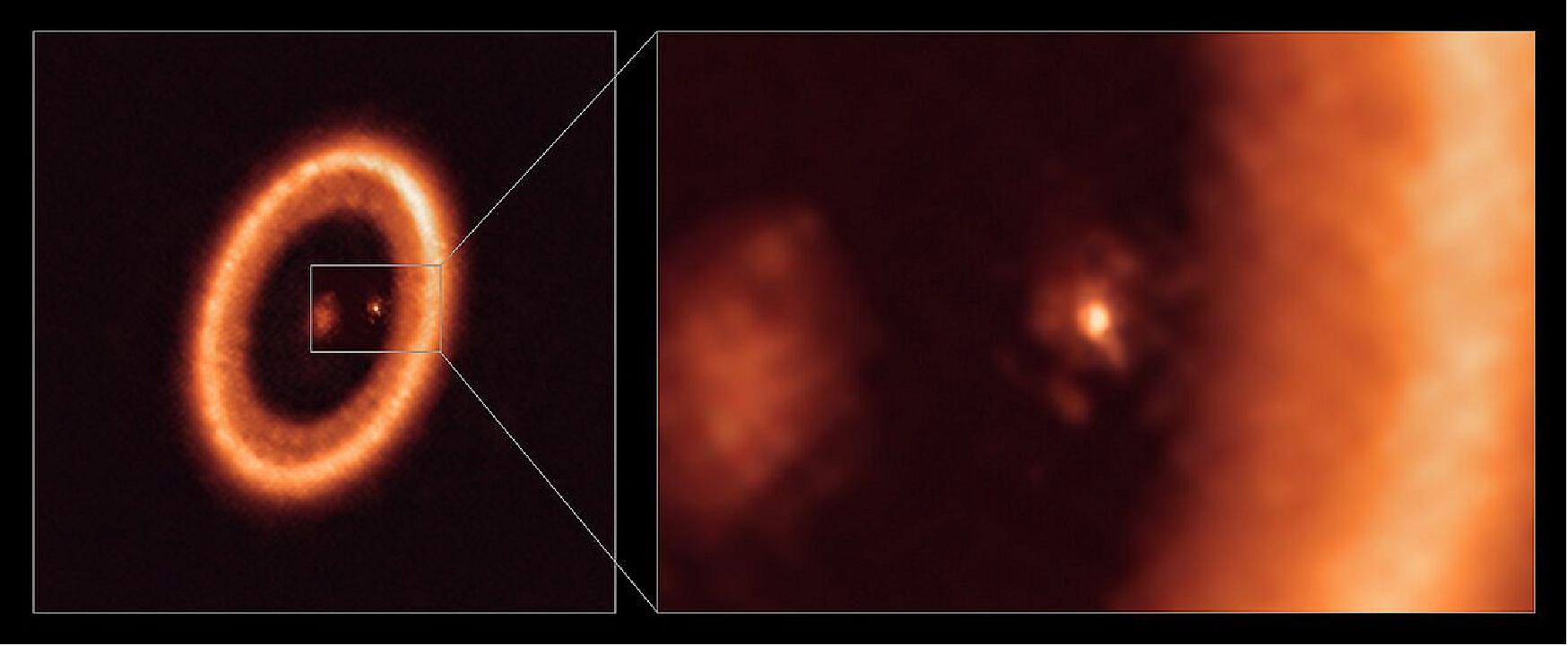
- “More than 4000 exoplanets have been found until now, but all of them were detected in mature systems. PDS 70b and PDS 70c, which form a system reminiscent of the Jupiter-Saturn pair, are the only two exoplanets detected so far that are still in the process of being formed,” explains Miriam Keppler, researcher at the Max Planck Institute for Astronomy in Germany and one of the co-authors of the study [1].
- “This system therefore offers us a unique opportunity to observe and study the processes of planet and satellite formation,” Facchini adds.
- PDS 70b and PDS 70c, the two planets making up the system, were first discovered using ESO’s Very Large Telescope (VLT) in 2018 and 2019 respectively, and their unique nature means they have been observed with other telescopes and instruments many times since [2].
- The latest high resolution ALMA observations have now allowed astronomers to gain further insights into the system. In addition to confirming the detection of the circumplanetary disc around PDS 70c and studying its size and mass, they found that PDS 70b does not show clear evidence of such a disc, indicating that it was starved of dust material from its birth environment by PDS 70c.
- An even deeper understanding of the planetary system will be achieved with ESO’s Extremely Large Telescope (ELT), currently under construction on Cerro Armazones in the Chilean Atacama desert. “The ELT will be key for this research since, with its much higher resolution, we will be able to map the system in great detail,” says co-author Richard Teague, a researcher at the Center for Astrophysics | Harvard & Smithsonian, USA. In particular, by using the ELT’s Mid-infrared ELT Imager and Spectrograph (METIS), the team will be able to look at the gas motions surrounding PDS 70c to get a full 3D picture of the system.
This research was presented in the paper: 53)
Notes
[1] Despite the similarity with the Jupiter-Saturn pair, note that the disc around PDS 70c is about 500 times larger than Saturn's rings.
[2] PDS 70b was discovered using the Spectro-Polarimetric High-contrast Exoplanet REsearch (SPHERE) instrument, while PDS 70c was found using the VLT’s Multi Unit Spectroscopic Explorer (MUSE). The two-planet system has been investigated using the X-shooter instrument too, also installed on ESO’s VLT.
• June 23, 2021: Using data for more than 500 young stars observed with the Atacama Large Millimeter/submillimeter Array (ALMA), scientists have uncovered a direct link between protoplanetary disk structures—the planet-forming disks that surround stars—and planet demographics. The survey proves that higher mass stars are more likely to be surrounded by disks with “gaps” in them and that these gaps directly correlate to the high occurrence of observed giant exoplanets around such stars. These results provide scientists with a window back through time, allowing them to predict what exoplanetary systems looked like through each stage of their formation. 54)
- The original press release was published by the National Radio Astronomy Observatory (NRAO), an ALMA partner on behalf of North America. 55)
- “We found a strong correlation between gaps in protoplanetary disks and stellar mass, which can be linked to the presence of large, gaseous exoplanets,” said Nienke van der Marel, a Banting fellow in the Department of Physics and Astronomy at the University of Victoria in British Columbia, and the primary author on the research. “Higher mass stars have relatively more disks with gaps than lower mass stars, consistent with the already known correlations in exoplanets, where higher mass stars more often host gas-giant exoplanets. These correlations directly tell us that gaps in planet-forming disks are most likely caused by giant planets of Neptune mass and above.”
- Gaps in protoplanetary disks have long been considered as overall evidence of planet formation. However, there has been some skepticism due to the observed orbital distance between exoplanets and their stars. “One of the primary reasons that scientists have been skeptical about the link between gaps and planets before is that exoplanets at wide orbits of tens of astronomical units are rare. However, exoplanets at smaller orbits, between one and ten astronomical units, are much more common,” said Gijs Mulders, assistant professor of astronomy at Universidad Adolfo Ibáñez in Santiago, Chile, and co-author on the research. “We believe that planets that clear the gaps will migrate inwards later on.”
- The new study is the first to show that the number of gapped disks in these regions matches the number of giant exoplanets in a star system. “Previous studies indicated that there were many more gapped disks than detected giant exoplanets,” said Mulders. “Our study shows that there are enough exoplanets to explain the observed frequency of the gapped disks at different stellar masses.” 56)
![Figure 36: Protoplanetary disks are classified into three main categories: transition, ring, or extended. These false-color images from ALMA show these classifications in stark contrast. On left: the ring disk of RU Lup is characterized by narrow gaps thought to be carved by giant planets with masses ranging between a Neptune mass and a Jupiter mass. Middle: the transition disk of J1604.3-2130 is characterized by a large inner cavity thought to be carved by planets more massive than Jupiter, also known as Super-Jovian planets. On right: the compact disk of Sz104 is believed not to contain giant planets, as it lacks the telltale gaps and cavities associated with the presence of giant planets [image credit: ALMA (ESO/NAOJ/NRAO), S. Dagnello (NRAO)]](https://www.eoportal.org/ftp/satellite-missions/a/Alma_300622/Alma_Auto49.jpeg)
- The correlation also applies to star systems with low-mass stars, where scientists are more likely to find massive rocky exoplanets, also known as Super-Earths. Van der Marel, who will become an assistant professor at Leiden University in the Netherlands beginning September 2021 said, “Lower mass stars have more rocky Super-Earths—between an Earth mass and a Neptune mass. Disks without gaps, which are more compact, lead to the formation of Super-Earths.”
- This link between stellar mass and planetary demographics could help scientists identify which stars to target in the search for rocky planets throughout the Milky Way. “This new understanding of stellar mass dependencies will help to guide the search for small, rocky planets like Earth in the solar neighborhood,” said Mulders, who is also a part of the NASA-funded Alien Earths team. “We can use the stellar mass to connect the planet-forming disks around young stars to exoplanets around mature stars. When an exoplanet is detected, the planet-forming material is usually gone. So the stellar mass is a ‘tag’ that tells us what the planet-forming environment might have looked like for these exoplanets.”
- And what it all comes down to is dust. “An important element of planet formation is the influence of dust evolution,” said van der Marel. “Without giant planets, dust will always drift inwards, creating the optimal conditions for the formation of smaller, rocky planets close to the star.”
- The current research was conducted using data for more than 500 objects observed in prior studies using ALMA’s high-resolution Band 6 and Band 7 antennas. At present, ALMA is the only telescope that can image the distribution of millimeter-dust at high enough angular resolution to resolve the dust disks and reveal its substructure, or lack thereof. “Over the past five years, ALMA has produced many snapshot surveys of nearby star-forming regions resulting in hundreds of measurements of disk dust mass, size, and morphology,” said van der Marel. “The large number of observed disk properties has allowed us to make a statistical comparison of protoplanetary disks to the thousands of discovered exoplanets. This is the first time that a stellar mass dependency of gapped disks and compact disks has been successfully demonstrated using the ALMA telescope.”
- “Our new findings link the beautiful gap structures in disks observed with ALMA directly to the properties of the thousands of exoplanets detected by the NASA Kepler mission and other exoplanet surveys,” said Mulders. “Exoplanets and their formation help us place the origins of the Earth and the Solar System in the context of what we see happening around other stars.”
• June 8, 2021: A team of astronomers using the Atacama Large Millimeter/submillimeter Array (ALMA) has completed the first census of molecular clouds in the nearby Universe, revealing that contrary to previous scientific opinion, these stellar nurseries do not all look and act the same. In fact, they’re as diverse as the people, homes, neighborhoods, and regions that make up our own world. 57)
- Stars are formed out of clouds of dust and gas called molecular clouds, or stellar nurseries. Each stellar nursery in the Universe can form thousands or even tens of thousands of new stars during its lifetime. Between 2013 and 2019, astronomers on the PHANGS— Physics at High Angular Resolution in Nearby GalaxieS— project conducted the first systematic survey of 100,000 stellar nurseries across 90 galaxies in the nearby Universe to get a better understanding of how they connect back to their parent galaxies.
- “We used to think that all stellar nurseries across every galaxy must look more or less the same, but this survey has revealed that this is not the case, and stellar nurseries change from place to place,” said Adam Leroy, Associate Professor of Astronomy at Ohio State University (OSU), and lead author of the paper presenting the PHANGS ALMA survey. “This is the first time that we have ever taken millimeter-wave images of many nearby galaxies that have the same sharpness and quality as optical pictures. And while optical pictures show us light from stars, these ground-breaking new images show us the molecular clouds that form those stars.”
- The scientists compared these changes to the way that people, houses, neighborhoods, and cities exhibit like-characteristics but change from region to region and country to country.
- “To understand how stars form, we need to link the birth of a single star back to its place in the Universe. It’s like linking a person to their home, neighborhood, city, and region. If a galaxy represents a city, then the neighborhood is the spiral arm, the house the star-forming unit, and nearby galaxies are neighboring cities in the region,” said Eva Schinnerer, an astronomer at the Max Planck Institute for Astronomy (MPIA) and principal investigator for the PHANGS collaboration “These observations have taught us that the “neighborhood” has small but pronounced effects on where and how many stars are born.”
![Figure 37: Using ALMA, scientists completed a census of nearly 100 galaxies in the nearby Universe, showcasing their behaviors and appearances. The scientists compared ALMA data to that of the Hubble Space Telescope, shown in composite here. The survey concluded that contrary to popular scientific opinion, stellar nurseries do not all look and act the same. In fact, as shown here, they are as different as the neighborhoods, cities, regions, and countries that make up our own world [image credit: ALMA (ESO/NAOJ/NRAO)/PHANGS, S. Dagnello (NRAO)]](https://www.eoportal.org/ftp/satellite-missions/a/Alma_300622/Alma_Auto48.jpeg)
- To better understand star formation in different types of galaxies, the team observed similarities and differences in the molecular gas properties and star formation processes of galaxy disks, stellar bars, spiral arms, and galaxy centers. They confirmed that the location, or neighborhood, plays a critical role in star formation.
- “By mapping different types of galaxies and the diverse range of environments that exist within galaxies, we are tracing the whole range of conditions under which star-forming clouds of gas live in the present-day Universe. This allows us to measure the impact that many different variables have on the way star formation happens,” said Guillermo Blanc, an astronomer at the Carnegie Institution for Science, and a co-author on the paper.
- “How stars form, and how their galaxy affects that process, are fundamental aspects of astrophysics,” said Joseph Pesce, National Science Foundation’s program officer for NRAO/ALMA. “The PHANGS project utilizes the exquisite observational power of the ALMA observatory and has provided remarkable insight into the story of star formation in a new and different way.”
- Annie Hughes, an astronomer at L’Institut de Recherche en Astrophysique et Planétologie (IRAP), added that this is the first time scientists have a snapshot of what star-forming clouds are really like across such a broad range of different galaxies. “We found that the properties of star-forming clouds depend on where they are located: clouds in the dense central regions of galaxies tend to be more massive, denser, and more turbulent than clouds that reside in the quiet outskirts of a galaxy. The lifecycle of clouds also depends on their environment. How fast a cloud forms stars and the process that ultimately destroys the cloud both seem to depend on where the cloud lives.”
- This is not the first time that stellar nurseries have been observed in other galaxies using ALMA, but nearly all previous studies focused on individual galaxies or part of one. Over a five-year period, PHANGS assembled a full view of the nearby population of galaxies. “The PHANGS project is a new form of cosmic cartography that allows us to see the diversity of galaxies in a new light, literally. We are finally seeing the diversity of star-forming gas across many galaxies and are able to understand how they are changing over time. It was impossible to make these detailed maps before ALMA,” said Erik Rosolowsky, Associate Professor of Physics at the University of Alberta, and a co-author on the research. “This new atlas contains 90 of the best maps ever made that reveal where the next generation of stars is going to form.”
- For the team, the new atlas doesn’t mean the end of the road. While the survey has answered questions about what and where, it has raised others. “This is the first time we have gotten a clear view of the population of stellar nurseries across the whole nearby Universe. In that sense, it’s a big step towards understanding where we come from,” said Leroy. “While we now know that stellar nurseries vary from place to place, we still do not know why or how these variations affect the stars and planets formed. These are questions that we hope to answer in the near future.”
- Ten papers detailing the outcomes of the PHANGS (Physics at High Angular Resolution in Nearby GalaxieS) survey are presented this week at the 238th meeting of the American Astronomical Society. 58)
• April 22, 2021: Using the ALMA Observatory, astronomers found a rotating baby galaxy 1/100th the size of the Milky Way at a time when the Universe was only seven percent of its present age. Assisted by the gravitational lens effect, the team was able to explore for the first time the nature of small and dark “normal galaxies” in the early Universe, representative of the main population of the first galaxies, which greatly advances our understanding of the initial phase of galaxy evolution. 59) 60)
- “Many of the galaxies that existed in the early Universe were so small that their brightness is well below the limit of the current largest telescopes on Earth and in Space, making difficult to study their properties and internal structure,” says Nicolas Laporte, a Kavli Senior Fellow at the University of Cambridge. “However, the light coming from the galaxy named RXCJ0600-z6, was highly magnified by gravitational lensing, making it an ideal target for studying the properties and structure of a typical baby galaxies.”
- Gravitational lensing is a natural phenomenon in which light emitted from a distant object is bent by the gravity of a massive body such as a galaxy or a galaxy cluster located in the foreground. The name “gravitational lensing” is derived from the fact that the gravity of the massive object acts like a lens. When we look through a gravitational lens, the light of distant objects is magnified and their shapes are stretched. In other words, it is a “natural telescope” floating in space.
- The ALMA Lensing Cluster Survey (ALCS) team used ALMA to search for a large number of galaxies in the early Universe that are enlarged by gravitational lensing. Combining the power of ALMA, with the help of the natural telescopes, the researchers are able to uncover and study fainter galaxies.
- Why is it crucial to explore the faintest galaxies in the early Universe? Theory and simulations predict that the majority of galaxies formed few hundred millions years after the Big-Bang are small, and thus faint. Although several galaxies in the early Universe have been previously observed, those studied were limited to the most massive objects, and therefore the less representative galaxies, in the early Universe, because of telescopes capabilities. The only way to understand the standard formation of the first galaxies, and obtain a complete picture of galaxy formation, is to focus on the fainter and more numerous galaxies.
- The ALCS team performed a large-scale observation program that took 95 hours, which is a very long time for ALMA observations, to observe the central regions of 33 galaxy clusters that could cause gravitational lensing. One of these clusters, called RXCJ0600-2007, is located in the direction of the constellation of Lepus, and has a mass 1000 trillion times that of the Sun. The team discovered a single distant galaxy that is being affected by the gravitational lens created by this natural telescope. ALMA detected the light from carbon ions and stardust in the galaxy and, together with data taken with the Gemini telescope, determined that the galaxy is seen as it was about 900 million years after the Big Bang (12.9 billion years ago). Further analysis of these data suggested that a part of this source is seen 160 times brighter than it is intrinsically.
- By precisely measuring the mass distribution of the cluster of galaxies, it is possible to “undo” the gravitational lensing effect and restore the original appearance of the magnified object. By combining data from Hubble Space Telescope and the European Southern Observatory’s Very Large Telescope with a theoretical model, the team succeeded in reconstructing the actual shape of the distant galaxy RXCJ0600-z6. The total mass of this galaxy is about 2 to 3 billion times that of the Sun, which is about 1/100th of the size of our own Milky Way Galaxy.
- What astonished the team is that RXCJ0600-z6 is rotating. Traditionally, gas in the young galaxies was thought to have random, chaotic motion. Only recently has ALMA discovered several rotating young galaxies that have challenged the traditional theoretical framework [2], but these were several orders of magnitude brighter (larger) than RXCJ0600-z6.
- “Our study demonstrates, for the first time, that we can directly measure the internal motion of such faint (less massive) galaxies in the early Universe and compare it with the theoretical predictions”, says Kotaro Kohno, a professor at the University of Tokyo and the leader of the ALCS team.
- “The fact that RXCJ0600-z6 has a very high magnification factor also raises expectations for future research,” explains Seiji Fujimoto, a DAWN fellow at the Niels Bohr Institute. “This galaxy has been selected, among hundreds, to be observed by the James Webb Space Telescope (JWST), the next generation space telescope to be launched this autumn. Through joint observations using ALMA and JWST, we will unveil the properties of gas and stars in a baby galaxy and its internal motions. When the Thirty Meter Telescope and the Extremely Large Telescope are completed, they may be able to detect clusters of stars in the galaxy, and possibly even resolve individual stars. There is an example of gravitational lensing that has been used to observe a single star 9.5 billion light-years away, and this research has the potential to extend this to less than a billion years after the birth of the Universe.”
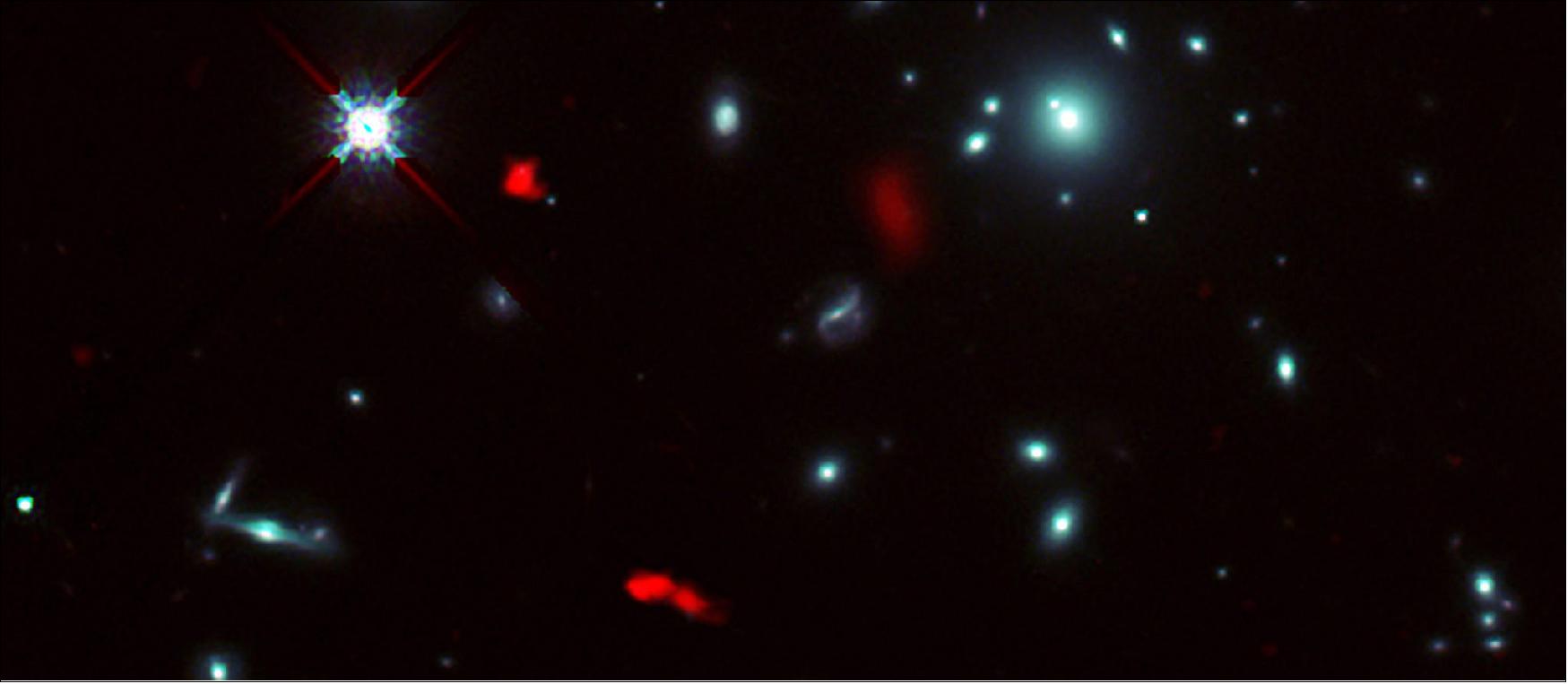
Notes
[1] The light emitted from carbon ions was originally infrared light with a wavelength of 156 micrometers, but as the Universe expanded, the wavelength extended and became radio waves with a wavelength of 1.1 millimeters, which were detected with ALMA. The redshift of this object is z=6.07. Using the cosmological parameters measured with Planck (H0=67.3km/s/Mpc, Ωm=0.315, Λ=0.685: Planck 2013 Results), we can calculate the distance to the object to be 12.9 billion light-years. (Please refer to “Expressing the distance to remote objects” for the details.)
[2] Using gravitational lensing, ALMA discovered a rotating galaxy similar in size to the Milky Way at about 12.4 billion years ago. (Please refer to the news article “ALMA sees most distant Milky Way look-alike” issued on August 13, 2020). Also, ALMA discovered a rotating galaxy from 12.4 billion years ago without using gravitational lensing. (Please refer to the news article “ALMA Discovers Massive Rotating Disk in Early Universe.”)
• March 24, 2021: The Event Horizon Telescope (EHT) collaboration, who produced the first ever image of a black hole, has today revealed a new view of the massive object at the center of the Messier 87 (M87) galaxy: how it looks in polarized light. This is the first time astronomers have been able to measure polarization, a signature of magnetic fields, this close to the edge of a black hole. The observations are key to explaining how the M87 galaxy, located 55 million light-years away, is able to launch energetic jets from its core. 61)
- “We are now seeing the next crucial piece of evidence to understand how magnetic fields behave around black holes, and how activity in this very compact region of space can drive powerful jets that extend far beyond the galaxy,” says Monika Mościbrodzka, Coordinator of the EHT Polarimetry Working Group and Assistant Professor at Radboud University in the Netherlands.
- On 10 April 2019, scientists released the first ever image of a black hole, revealing a bright ring-like structure with a dark central region — the black hole’s shadow. Since then, the EHT collaboration has delved deeper into the data on the supermassive object at the heart of the M87 galaxy collected in 2017. They have discovered that a significant fraction of the light around the M87 black hole is polarized.
- “This work is a major milestone: the polarization of light carries information that allows us to better understand the physics behind the image we saw in April 2019, which was not possible before,” explains Iván Martí-Vidal, also Coordinator of the EHT Polarimetry Working Group and GenT Distinguished Researcher at the University of Valencia, Spain. He adds that “unveiling this new polarized-light image required years of work due to the complex techniques involved in obtaining and analyzing the data.”
- Light becomes polarized when it goes through certain filters, like the lenses of polarized sunglasses, or when it is emitted in hot regions of space where magnetic fields are present. In the same way that polarized sunglasses help us see better by reducing reflections and glare from bright surfaces, astronomers can sharpen their view of the region around the black hole by looking at how the light originating from it is polarized. Specifically, polarization allows astronomers to map the magnetic field lines present at the inner edge of the black hole.
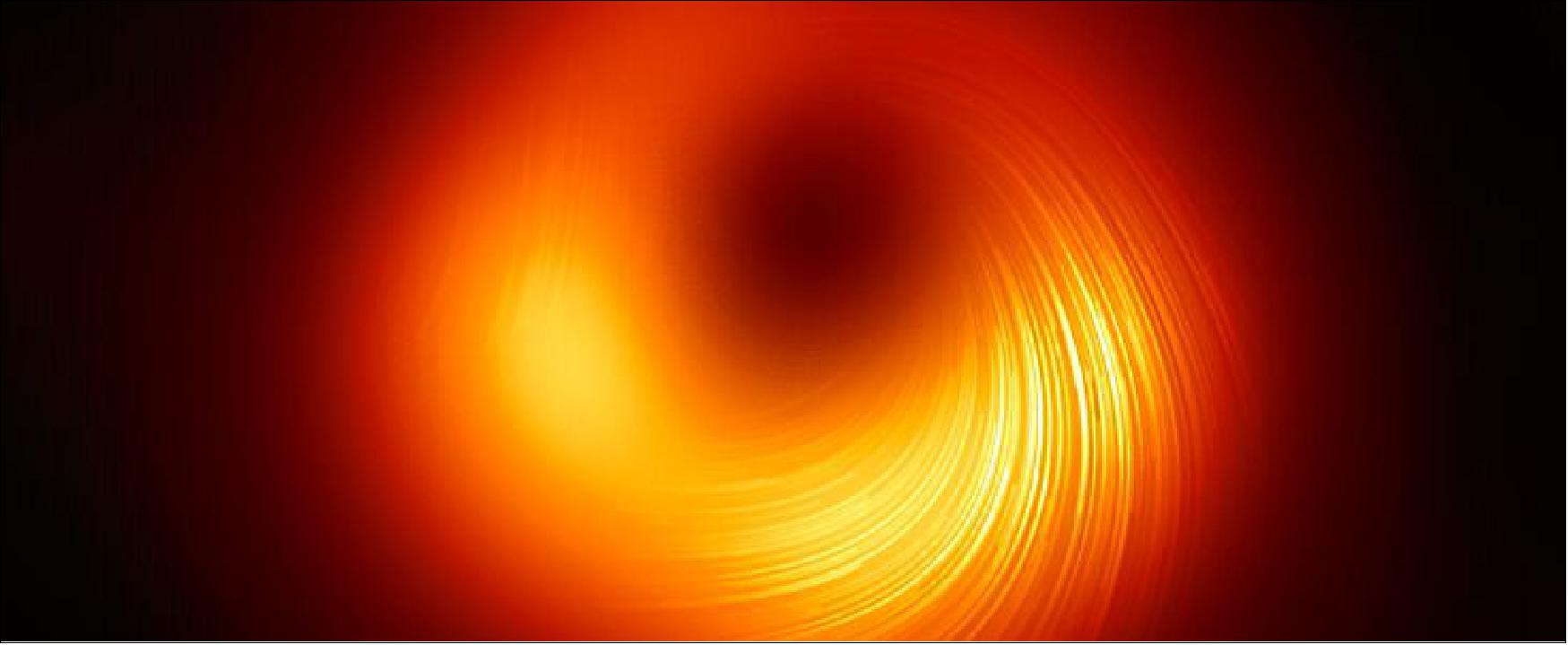
- “The newly published polarized images are key to understanding how the magnetic field allows the black hole to 'eat' matter and launch powerful jets,” says EHT collaboration member Andrew Chael, a NASA Hubble Fellow at the Princeton Center for Theoretical Science and the Princeton Gravity Initiative in the US.
- The bright jets of energy and matter that emerge from M87’s core and extend at least 5000 light-years from its centre are one of the galaxy’s most mysterious and energetic features. Most matter lying close to the edge of a black hole falls in. However, some of the surrounding particles escape moments before capture and are blown far out into space in the form of jets.
- Astronomers have relied on different models of how matter behaves near the black hole to better understand this process. But they still don’t know exactly how jets larger than the galaxy are launched from its central region, which is comparable in size to the Solar System, nor how exactly matter falls into the black hole. With the new EHT image of the black hole and its shadow in polarized light, astronomers managed for the first time to look into the region just outside the black hole where this interplay between matter flowing in and being ejected out is happening.
- The observations provide new information about the structure of the magnetic fields just outside the black hole. The team found that only theoretical models featuring strongly magnetized gas can explain what they are seeing at the event horizon.
- “The observations suggest that the magnetic fields at the black hole’s edge are strong enough to push back on the hot gas and help it resist gravity’s pull. Only the gas that slips through the field can spiral inwards to the event horizon,” explains Jason Dexter, Assistant Professor at the University of Colorado Boulder, US, and Coordinator of the EHT Theory Working Group.
- To observe the heart of the M87 galaxy, the collaboration linked eight telescopes around the world — including the northern Chile-based Atacama Large Millimeter/submillimeter Array (ALMA) and the Atacama Pathfinder EXperiment (APEX), in which the European Southern Observatory (ESO) is a partner — to create a virtual Earth-sized telescope, the EHT. The impressive resolution obtained with the EHT is equivalent to that needed to measure the length of a credit card on the surface of the Moon.
- “With ALMA and APEX, which through their southern location enhance the image quality by adding geographical spread to the EHT network, European scientists were able to play a central role in the research,” says Ciska Kemper, European ALMA Program Scientist at ESO. “With its 66 antennas, ALMA dominates the overall signal collection in polarized light, while APEX has been essential for the calibration of the image.”
- "ALMA data were also crucial to calibrate, image and interpret the EHT observations, providing tight constraints on the theoretical models that explain how matter behaves near the black hole event horizon," adds Ciriaco Goddi, a scientist at Radboud University and Leiden Observatory, the Netherlands, who led an accompanying study that relied only on ALMA observations. 62)
- The EHT setup allowed the team to directly observe the black hole shadow and the ring of light around it, with the new polarized-light image clearly showing that the ring is magnetized. The results are published today in two separate papers in The Astrophysical Journal Letters by the EHT collaboration. The research involved over 300 researchers from multiple organizations and universities worldwide.
- "The EHT is making rapid advancements, with technological upgrades being done to the network and new observatories being added. We expect future EHT observations to reveal more accurately the magnetic field structure around the black hole and to tell us more about the physics of the hot gas in this region," concludes EHT collaboration member Jongho Park, an East Asian Core Observatories Association Fellow at the Academia Sinica Institute of Astronomy and Astrophysics in Taipei.
• March 18, 2021: Using the Atacama Large Millimeter/submillimeter Array (ALMA), in which the European Southern Observatory (ESO) is a partner, a team of astronomers have directly measured winds in Jupiter’s middle atmosphere for the first time. By analyzing the aftermath of a comet collision from the 1990s, the researchers have revealed incredibly powerful winds, with speeds of up to 1450 km/hr, near Jupiter’s poles. They could represent what the team have described as a “unique meteorological beast in our Solar System”. 63)
- Jupiter is famous for its distinctive red and white bands: swirling clouds of moving gas that astronomers traditionally use to track winds in Jupiter’s lower atmosphere. Astronomers have also seen, near Jupiter's poles, the vivid glows known as aurorae, which appear to be associated with strong winds in the planet’s upper atmosphere. But until now, researchers had never been able to directly measure wind patterns in between these two atmospheric layers, in the stratosphere.
- Measuring wind speeds in Jupiter’s stratosphere using cloud-tracking techniques is impossible because of the absence of clouds in this part of the atmosphere. However, astronomers were provided with an alternative measuring aid in the form of comet Shoemaker–Levy 9, which collided with the gas giant in spectacular fashion in 1994. This impact produced new molecules in Jupiter’s stratosphere, where they have been moving with the winds ever since.
- A team of astronomers, led by Thibault Cavalié of the Laboratoire d'Astrophysique de Bordeaux in France, have now tracked one of these molecules — hydrogen cyanide — to directly measure stratospheric "jets" on Jupiter. Scientists use the word "jets" to refer to narrow bands of wind in the atmosphere, like Earth’s jet streams.
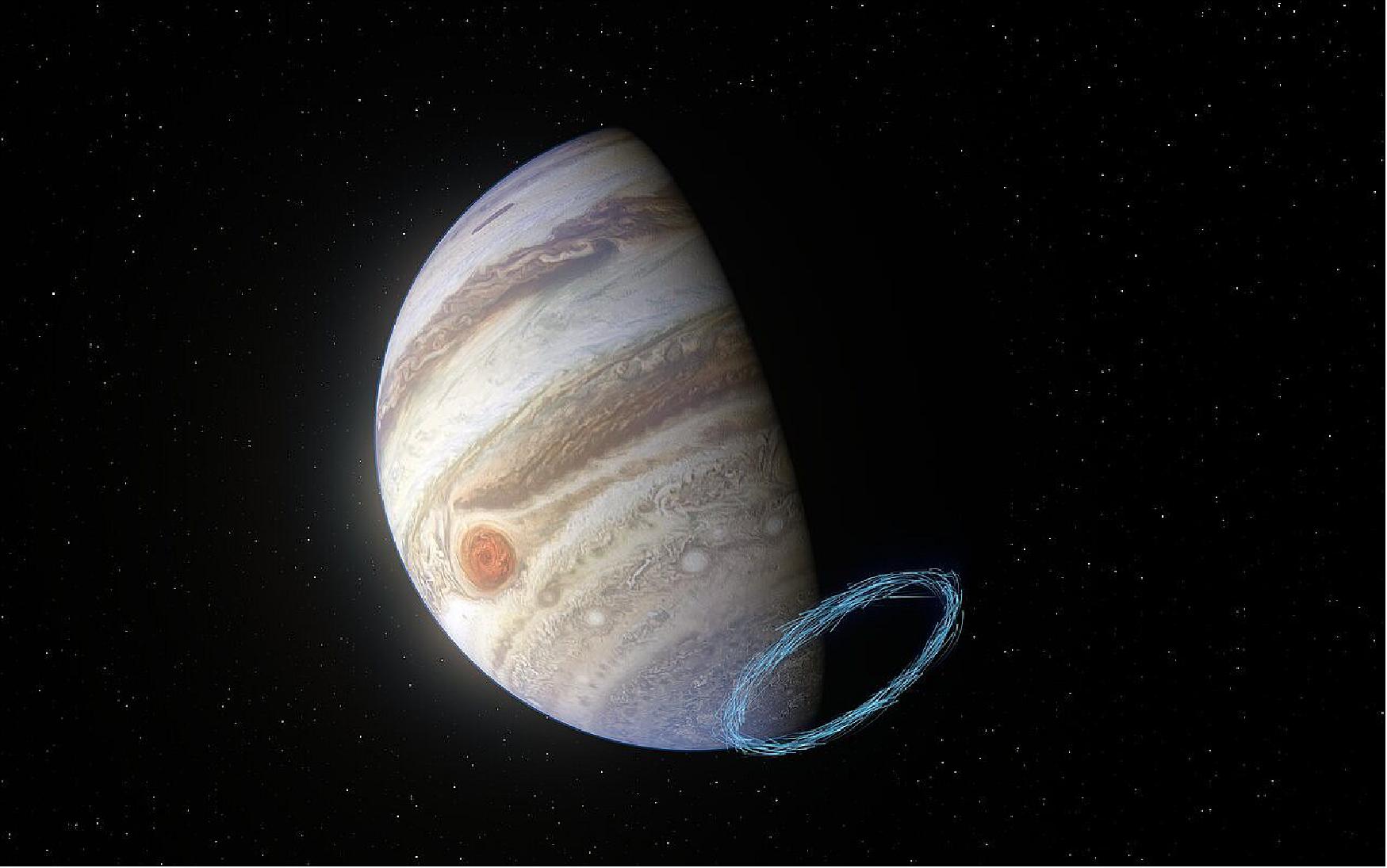
- "The most spectacular result is the presence of strong jets, with speeds of up to 400 m/s, which are located under the aurorae near the poles," says Cavalié. These wind speeds, equivalent to about 1450 km/hr, are more than twice the maximum storm speeds reached in Jupiter’s Great Red Spot and over three times the wind speed measured on Earth’s strongest tornadoes.
- "Our detection indicates that these jets could behave like a giant vortex with a diameter of up to four times that of Earth, and some 900 km in height," explains co-author Bilal Benmahi, also of the Laboratoire d’Astrophysique de Bordeaux. "A vortex of this size would be a unique meteorological beast in our Solar System," Cavalié adds.
- Astronomers were aware of strong winds near Jupiter’s poles, but much higher up in the atmosphere, hundreds of kilometers above the focus area of the new study, which is published today in Astronomy & Astrophysics. Previous studies predicted that these upper-atmosphere winds would decrease in velocity and disappear well before reaching as deep as the stratosphere. "The new ALMA data tell us the contrary," says Cavalié, adding that finding these strong stratospheric winds near Jupiter’s poles was a "real surprise". 64)
- The team used 42 of ALMA’s 66 high-precision antennas, located in the Atacama Desert in northern Chile, to analyze the hydrogen cyanide molecules that have been moving around in Jupiter’s stratosphere since the impact of Shoemaker–Levy 9. The ALMA data allowed them to measure the Doppler shift — tiny changes in the frequency of the radiation emitted by the molecules — caused by the winds in this region of the planet. "By measuring this shift, we were able to deduce the speed of the winds much like one could deduce the speed of a passing train by the change in the frequency of the train whistle," explains study co-author Vincent Hue, a planetary scientist at the Southwest Research Institute in the US.
- In addition to the surprising polar winds, the team also used ALMA to confirm the existence of strong stratospheric winds around the planet’s equator, by directly measuring their speed, also for the first time. The jets spotted in this part of the planet have average speeds of about 600 km/hr.
- The ALMA observations required to track stratospheric winds in both the poles and equator of Jupiter took less than 30 minutes of telescope time. "The high levels of detail we achieved in this short time really demonstrate the power of the ALMA observations," says Thomas Greathouse, a scientist at the Southwest Research Institute in the US and co-author of the study. "It is astounding to me to see the first direct measurement of these winds."
- These ALMA results open a new window for the study of Jupiter’s auroral regions, which was really unexpected just a few months back," says Cavalié. "They also set the stage for similar yet more extensive measurements to be made by the JUICE mission and its Submillimeter Wave Instrument," Great house adds, referring to the European Space Agency’s JUICY (JUpiter ICy moons Explorer), which is expected to launch into space next year.
- ESO’s ground-based Extremely Large Telescope (ELT), set to see first light later this decade, will also explore Jupiter. The telescope will be capable of making highly detailed observations of the planet’s aurorae, giving us further insight into Jupiter’s atmosphere.
• January 12, 2021: An international team of astronomers has discovered the most distant quasar yet found — a cosmic monster more than 13 billion light-years from Earth powered by a supermassive black hole more than 1.6 billion times more massive than the Sun and more than 1,000 times brighter than our entire Milky Way Galaxy. 65)
- The quasar, called J0313–1806, is seen as it was when the Universe was only 670 million years old and is providing astronomers with valuable insight on how massive galaxies — and the supermassive black holes at their cores — formed in the early Universe. The scientists presented their findings to the American Astronomical Society’s meeting, now underway virtually, and in a paper accepted to the Astrophysical Journal Letters. 66)
- Quasars occur when the powerful gravity of a supermassive black hole at a galaxy’s core draws in surrounding material that forms an orbiting disk of superheated material around the black hole. The process releases tremendous amounts of energy, making the quasar extremely bright, often outshining the rest of the galaxy.
- The black hole at the core of J0313–1806 is twice as massive as that of the previous record holder and that fact provides astronomers with a valuable clue about such black holes and their affect on their host galaxies.
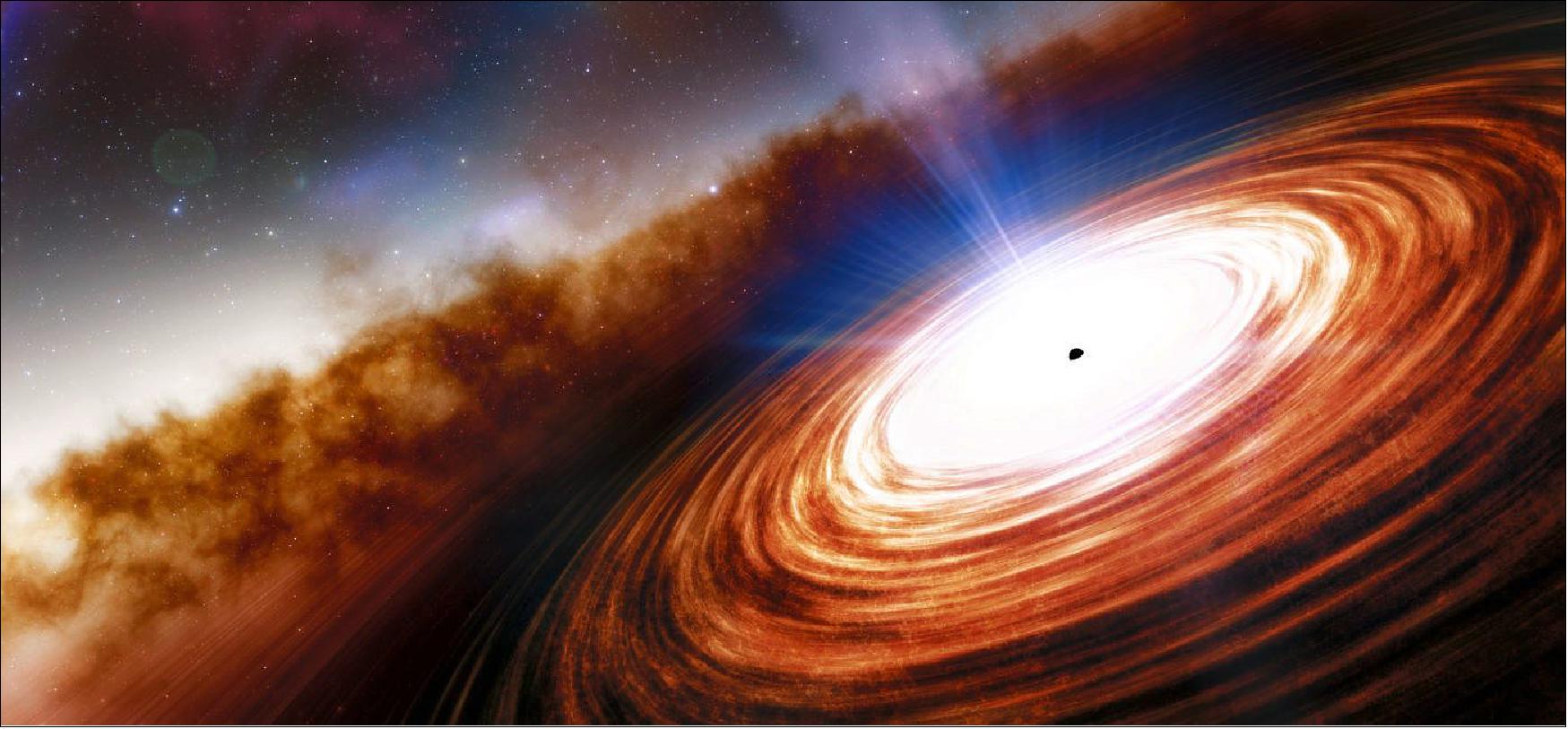
- “This is the earliest evidence of how a supermassive black hole is affecting the galaxy around it,” said Feige Wang, a Hubble Fellow at the University of Arizona’s Steward Observatory and leader of the research team. “From observations of less distant galaxies, we know that this has to happen, but we have never seen it happening so early in the Universe.”
- The huge mass of J0313–1806’s black hole at such an early time in the Universe’s history rules out two theoretical models for how such objects formed, the astronomers said. In the first of these models, individual massive stars explode as supernovae and collapse into black holes that then coalesce into larger black holes. In the second, dense clusters of stars collapse into a massive black hole. In both cases, however, the process takes too long to produce a black hole as massive as the one in J0313-1806 by the age at which we see it.
- “This tells you that no matter what you do, the seed of this black hole must have formed by a different mechanism,” said Xiaohui Fan, also of the University of Arizona. “In this case, it’s a mechanism that involves vast quantities of primordial, cold hydrogen gas directly collapsing into a seed black hole.”
- The ALMA observations of J0313–1806 provided tantalizing details about the quasar host galaxy, which is forming new stars at a rate 200 times that of our Milky Way. “This is a relatively high star formation rate in galaxies of similar age, and it indicates that the quasar host galaxy is growing very fast,” said Jinyi Yang, the second author of the report, who is a Peter A. Strittmatter Fellow at the University of Arizona.
- The quasar’s brightness indicates that the black hole is swallowing the equivalent of 25 Suns every year. The energy released by that rapid feeding, the astronomers said, probably is powering a powerful outflow of ionized gas seen moving at about 20 percent of the speed of light.
- Such outflows are thought to be what ultimately stops star formation in the galaxy.
- “We think those supermassive black holes were the reason why many of the big galaxies stopped forming stars at some point,” Fan said. “We observe this ‘quenching’ at later times, but until now, we didn’t know how early this process began in the history of the Universe. This quasar is the earliest evidence that quenching may have been happening at very early times.”
- This process also will leave the black hole with nothing left to eat and halt its growth, Fan pointed out.
- In addition to ALMA, the astronomers used the 6.5-meter Magellan Baade telescope, the Gemini North telescope and W.M. Keck Observatory in Hawaii, and the Gemini South telescope in Chile.
- The astronomers plan to continue studying J0313-1806 and other quasars with ground-based and space-based telescopes.
• January 11, 2021: “This is the first time we have observed a typical massive star-forming galaxy in the distant Universe about to ‘die’ because of a massive cold gas ejection,” says Annagrazia Puglisi, lead researcher on the new study, from the Durham University, UK, and the Saclay Nuclear Research Centre (CEA-Saclay), France. The galaxy, ID2299, is distant enough that its light takes some 9 billion years to reach us; we see it when the Universe was just 4.5 billion years old. 67)
- The gas ejection is happening at a rate equivalent to 10,000 Suns per year, and is removing an astonishing 46% of the total cold gas from ID2299. Because the galaxy is also forming stars very rapidly, hundreds of times faster than our Milky Way, the remaining gas will be quickly consumed, shutting down ID2299 in just a few tens of million years.
- The event responsible for the spectacular gas loss, the team believes, is a collision between two galaxies, which eventually merged to form ID2299. The elusive clue that pointed the scientists towards this scenario was the association of the ejected gas with a “tidal tail”. Tidal tails are elongated streams of stars and gas extending into interstellar space that result when two galaxies merge, and they are usually too faint to see in distant galaxies. However, the team managed to observe the relatively bright feature just as it was launching into space, and were able to identify it as a tidal tail.
- Most astronomers believe that winds caused by star formation and the activity of black holes at the centers of massive galaxies are responsible for launching star-forming material into space, thus ending galaxies’ ability to make new stars. However, the new study published today in Nature Astronomy suggests that galactic mergers can also be responsible for ejecting star-forming fuel into space.
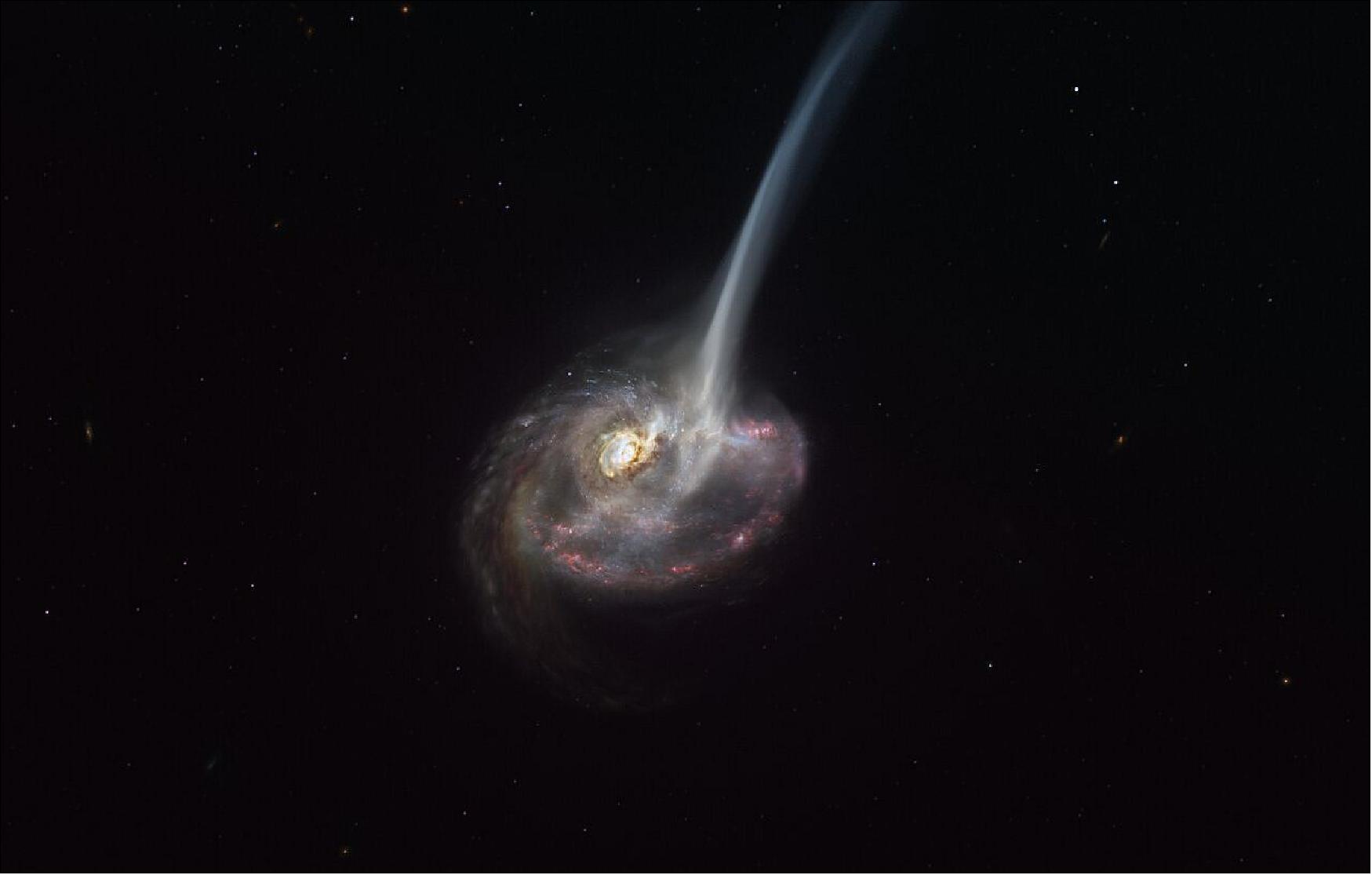
- “Our study suggests that gas ejections can be produced by mergers and that winds and tidal tails can appear very similar,” says study co-author Emanuele Daddi of CEA-Saclay. Because of this, some of the teams that previously identified winds from distant galaxies could in fact have been observing tidal tails ejecting gas from them. “This might lead us to revise our understanding of how galaxies ‘die’,” Daddi adds. 68)
- Puglisi agrees about the significance of the team’s finding, saying: "I was thrilled to discover such an exceptional galaxy! I was eager to learn more about this weird object because I was convinced that there was some important lesson to be learned about how distant galaxies evolve."
- This surprising discovery was made by chance, while the team were inspecting a survey of galaxies made with ALMA, designed to study the properties of cold gas in more than 100 far-away galaxies. ID2299 had been observed by ALMA for only a few minutes, but the powerful observatory, located in northern Chile, allowed the team to collect enough data to detect the galaxy and its ejection tail.
- "ALMA has shed new light on the mechanisms that can halt the formation of stars in distant galaxies. Witnessing such a massive disruption event adds an important piece to the complex puzzle of galaxy evolution," says Chiara Circosta, a researcher at the University College London, UK, who also contributed to the research.
- In the future, the team could use ALMA to make higher-resolution and deeper observations of this galaxy, enabling them to better understand the dynamics of the ejected gas. Observations with the future ESO’s Extremely Large Telescope could allow the team to explore the connections between the stars and gas in ID2299, shedding new light on how galaxies evolve.
• December 16, 2020: On Friday 11 December, ESO Director General Xavier Barcons received the Order of Bernardo O’Higgins Grand Cross, at a ceremony chaired by Carolina Valdivia, the Chilean Undersecretary of Foreign Affairs. 69)

- The Order Bernardo O’Higgins is a recognition by the Chilean State for foreign citizens’ outstanding work in the fields of art, science, education, industry, commerce or humanitarian or social cooperation.
- During the ceremony, held at the Ministry of Foreign Affairs, Barcons received the award for paving new ways towards a deeper understanding between Chile and ESO.
- “On behalf of the Ministry of Foreign Affairs, I would like to extend our sincere thanks for your collaboration and for helping us boost the establishment of a new astronomical paradigm in our country that is based on a regional, fair, inclusive and citizen-oriented approach. This includes cutting edge cooperation agreements, through which Chile –with its National Research and Development Agency– and ESO can equally contribute to highlight the scientific and technological work of our fellow nationals worldwide”, said Valdivia during the ceremony.
- ESO’s Director General received the award on behalf of the entire organization. “Shortly after I took office as ESO Director General, we embarked on this joint journey towards new and more ambitious horizons, promoting true cooperation to help build towards a future that capitalizes on the knowledge society and the fourth industrial revolution”, said Barcons.
• December 8, 2020: Linda Tacconi, a senior astronomer at the Max Planck Institute for Extraterrestrial Physics (MPE) in Garching, Germany, has been elected as the next president of ESO’s main governing body, the Council. 70)

- “I am honored to have been chosen as president of the ESO Council,” Tacconi says. “The coming years represent a very exciting time for the organization, as the first light of ESO’s Extremely Large Telescope approaches and current facilities, such as ESO’s Very Large Telescope, continue at the forefront of astronomical research. The various ESO observatories will work in synergy, furthering our knowledge of the Universe and strengthening ESO’s position as a world-leader in ground-based astronomy. I look forward to sharing in this experience and working with Council to support ESO in maintaining this leadership role.”
- Tacconi completed her PhD at the University of Massachusetts, USA, in 1988 and later worked at the Netherlands Foundation for Research in Astronomy, in Dwingeloo, before starting her career at the MPE in 1991. In 2012, she received the Lancelot M. Berkeley New York Community Trust Prize in recognition of her contributions to the field of astronomy, in particular for her work on cold gas in massive star-forming galaxies in the young universe.
- Tacconi has been strongly involved with ESO for a number of years, including in Council where she has served as the German Scientific Delegate since 2016. In addition to her role in Council, she was the chair of ESO’s Scientific Technical Committee in 2006–2008. She has also served on several other international committees, including as chair of the Programme Committee and of the Science Advisory Committee of IRAM, an international research institute for millimeter astronomy. She currently serves on the ALMA Board and chairs the Senior Committee for the European Space Agency’s (ESA’s) Voyage 2050, a programme to define ESA’s space science roadmap for 2035–2050.
- Tacconi succeeds Willy Benz from the University of Bern, Switzerland, in leading the ESO Council. ESO’s Director General, Xavier Barcons, expresses his thanks to the former president: “I would like to thank Willy on behalf of all ESO staff for his tireless work as Council President, particularly during these unprecedented times. I look forward to continuing working with Linda in her new role as Council President.”
• November 30, 2020: Astronomers have detected fast-moving carbon monoxide gas flowing away from a young, low-mass star: a unique stage of planetary system evolution which may provide insight into how our own solar system evolved and suggests that the way systems develop may be more complicated than previously thought. 71)
- Although it remains unclear how the gas is being ejected so fast, the team of researchers, led by the University of Cambridge, believe it may be produced from icy comets being vaporised in the star’s asteroid belt. The results have been accepted for publication in the Monthly Notices of the Royal Astronomical Society and will be presented at the Five Years After HL Tau virtual conference.
- The detection was made with the Atacama Large Millimeter/submillimeter Array (ALMA) in Chile, as part of a survey of young ‘class III’ stars, reported in an earlier paper. Some of these class III stars are surrounded by debris discs, which are believed to be formed by the ongoing collisions of comets, asteroids and other solid objects, known as planetesimals, in the outer reaches of recently formed planetary systems. The leftover dust and debris from these collisions absorbs light from their central stars and re-radiate that energy as a faint glow that can be studied with ALMA.
- In the inner regions of planetary systems, the processes of planet formation are expected to result in the loss of all the hottest dust, and class IIII stars are those that are left with - at most - dim, cold dust. These faint belts of cold dust are similar to the known debris discs seen around other stars, similar to the Kuiper belt in our own solar system, which is known to host much larger asteroids and comets.
- In the survey, the star in question, ‘NO Lup’, which is about 70% the mass of our sun, was found to have a faint, low-mass dusty disc, but it was the only class III star where carbon monoxide gas was detected, a first for this type of young star with ALMA. While it is known that many young stars still host the gas-rich planet-forming discs they are born with, NO Lup is more evolved, and might have been expected to have lost this primordial gas after its planets had formed.
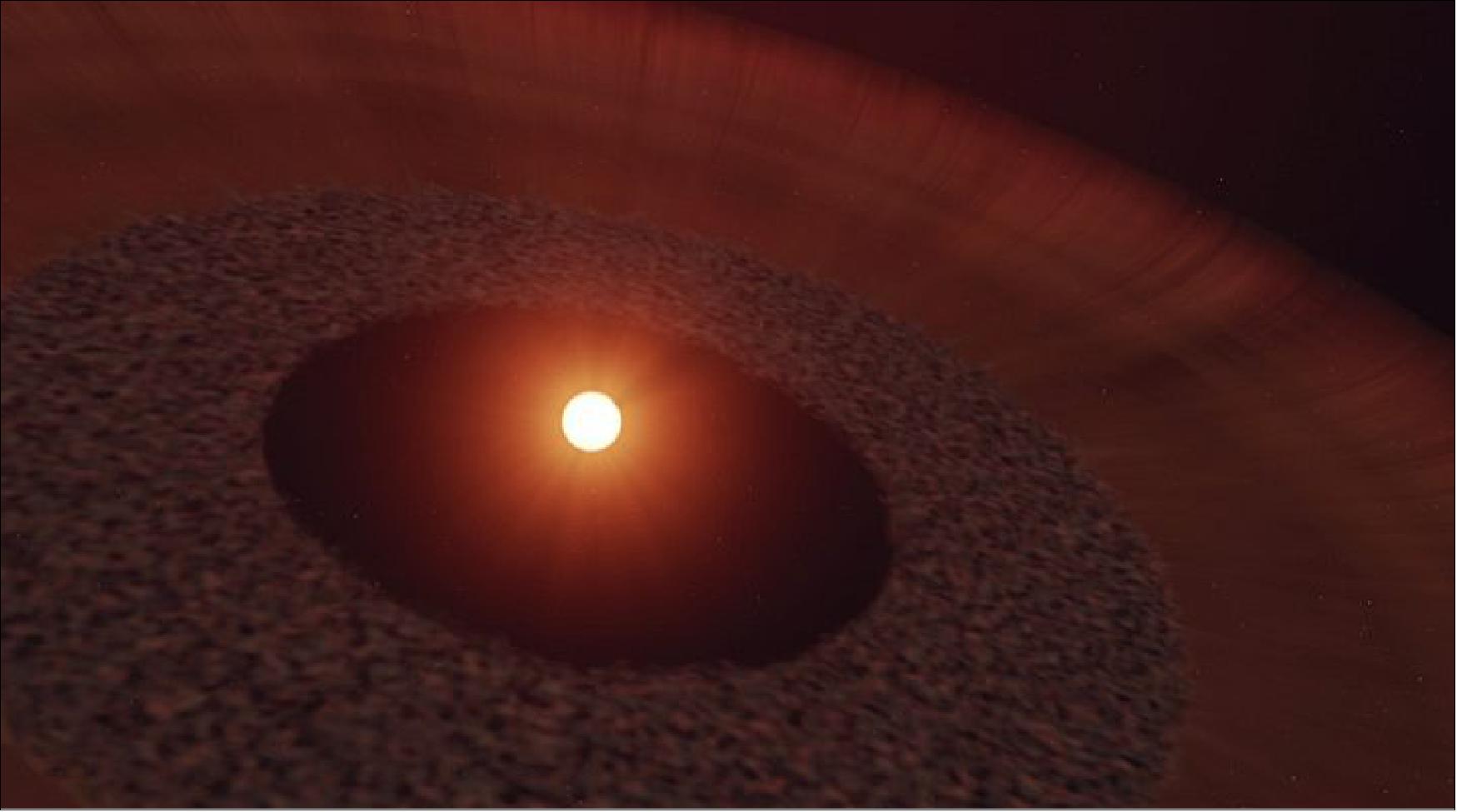
- While the detection of carbon monoxide gas is rare, what made the observation unique was the scale and speed of the gas, which prompted a follow-up study to explore its motion and origins.
- “Just detecting carbon monoxide gas was exciting, since no other young stars of this type had been previously imaged by ALMA,” said first author Joshua Lovell, a PhD student from the Cambridge’s Institute of Astronomy. “But when we looked closer, we found something even more unusual: given how far away the gas was from the star, it was moving much faster than expected. This had us puzzled for quite some time.” 72)
- Grant Kennedy, Royal Society University Research Fellow at the University of Warwick, who led the modelling work on the study, came up with a solution to the puzzle. “We found a simple way to explain it: by modelling a gas ring, but giving the gas an extra kick outward,” he said. “Other models have been used to explain young discs with similar mechanisms, but this disc is more like a debris disc where we haven’t witnessed winds before. Our model showed the gas is entirely consistent with a scenario in which it’s being launched out of the system at around 22 km/s, which is much higher than any stable orbital speed.”
- Further analysis also showed that the gas may be produced during collisions between asteroids, or during periods of sublimation – the transition from a solid to a gaseous phase – on the surface of the star’s comets, expected to be rich in carbon monoxide ice.
- There has been recent evidence of this same process in our own solar system from NASA’s New Horizons mission, when it observed the Kuiper Belt object Ultima Thule in 2019 and found sublimation evolution on the surface of the comet, which happened around 4.5 billion years ago. The same event that vaporised comets in our own solar system billions of years ago may have therefore been captured for the first time over 400 light years away, in a process that may be common around planet-forming stars, and have implications for how all comets, asteroids, and planets evolve.
- “This fascinating star is shedding light on what kind of physical processes are shaping planetary systems shortly after they are born, just after they have emerged from being enshrouded by their protoplanetary disk,” said co-author Professor Mark Wyatt, also from the Institute of Astronomy. “While we have seen gas produced by planetesimals in older systems, the shear rate at which gas is being produced in this system and its outflowing nature are quite remarkable, and point to a phase of planetary system evolution that we are witnessing here for the first time.”
- While the puzzle isn’t fully solved, and further detailed modelling will be required to understand how the gas is being ejected so quickly, what is sure is that this system is set to be the target of more intense follow-up measurements.
- “We’re hoping that ALMA will be back online next year, and we’ll be making the case to observe this system again in greater detail,” said Lovell. “Given how much we have learned about this early stage of planetary system evolution with only a short 30-minute observation, there is still so much more that this system can tell us.”
• November 23, 2020: Stellar systems like our own form inside interstellar clouds of gas and dust that collapse producing young stars surrounded by protoplanetary disks. Planets form within these protoplanetary disks, leaving clear gaps, which have been recently observed in evolved systems, at the time when the mother cloud has been cleared out. ALMA has now revealed an evolved protoplanetary disk with a large gap still being fed by the surrounding cloud via large accretion filaments. This shows that accretion of material onto the protoplanetary disk is continuing for times longer than previously thought, affecting the evolution of the future planetary system. 73)
- A team of astronomers led by Dr. Felipe Alves from the Center for Astrochemical Studies (CAS) at the Max Planck Institute for Extraterrestrial Physics (MPE) used the Atacama Large Millimeter/submillimeter Array (ALMA) to study the accretion process in the stellar object [BHB2007] 1, a system located at the tip of the Pipe Molecular Cloud. The ALMA data reveal a disk of dust and gas around the protostar, and large filaments of gas around this disk. The scientists interpret these filaments as accretion streamers feeding the disk with material extracted from the ambient cloud. The disk reprocesses the accreted material, delivering it to the protostar. The structure observed is very unusual for stellar objects at this stage of evolution — with an estimated age of 1,000,000 years — when circumstellar disks are already formed and matured for planet formation. “We were quite surprised to observe such prominent accretion filaments falling into the disk”, said Alves. “The accretion filament activity demonstrates that the disk is still growing while simultaneously nurturing the protostar.” 74)
![Figure 46: This false-color image shows the filaments of accretion around the protostar [BHB2007] 1. The large structures are inflows of molecular gas (CO) nurturing the disk surrounding the protostar. The inset shows the dust emission from the disk, which is seen edge-on. The "holes" in the dust map represent an enormous ringed cavity seen (sideways) in the disk structure (image credit: MPE)](https://www.eoportal.org/ftp/satellite-missions/a/Alma_300622/Alma_Auto3F.jpeg)
- The team also reports the presence of an enormous cavity within the disk. The cavity has a width of 70 astronomical units, and it encompasses a compact zone of hot molecular gas. In addition, supplementary data at radio frequencies by the Very Large Array (VLA) point to the existence of non-thermal emission in the same spot where the hot gas was detected. These two lines of evidence indicate that a substellar object — a young giant planet or brown dwarf — is present within the cavity. As this companion accretes material from the disk, it heats up the gas and possibly powers strong ionized winds and/or jets. The team estimates that an object with a mass between 4 and 70 Jupiter masses is needed to produce the observed gap in the disk.
- “We present a new case of star and planet formation happening in tandem,” states Paola Caselli, director at MPE and head of the CAS group. “Our observations strongly indicate that protoplanetary disks keep accreting material also after planet formation has started. This is important because the fresh material falling onto the disk will affect both the chemical composition of the future planetary system and the dynamical evolution of the whole disk.” These observations also put new time constraints for planet formation and disk evolution, shedding light on how stellar systems like our own are sculpted from the original cloud.
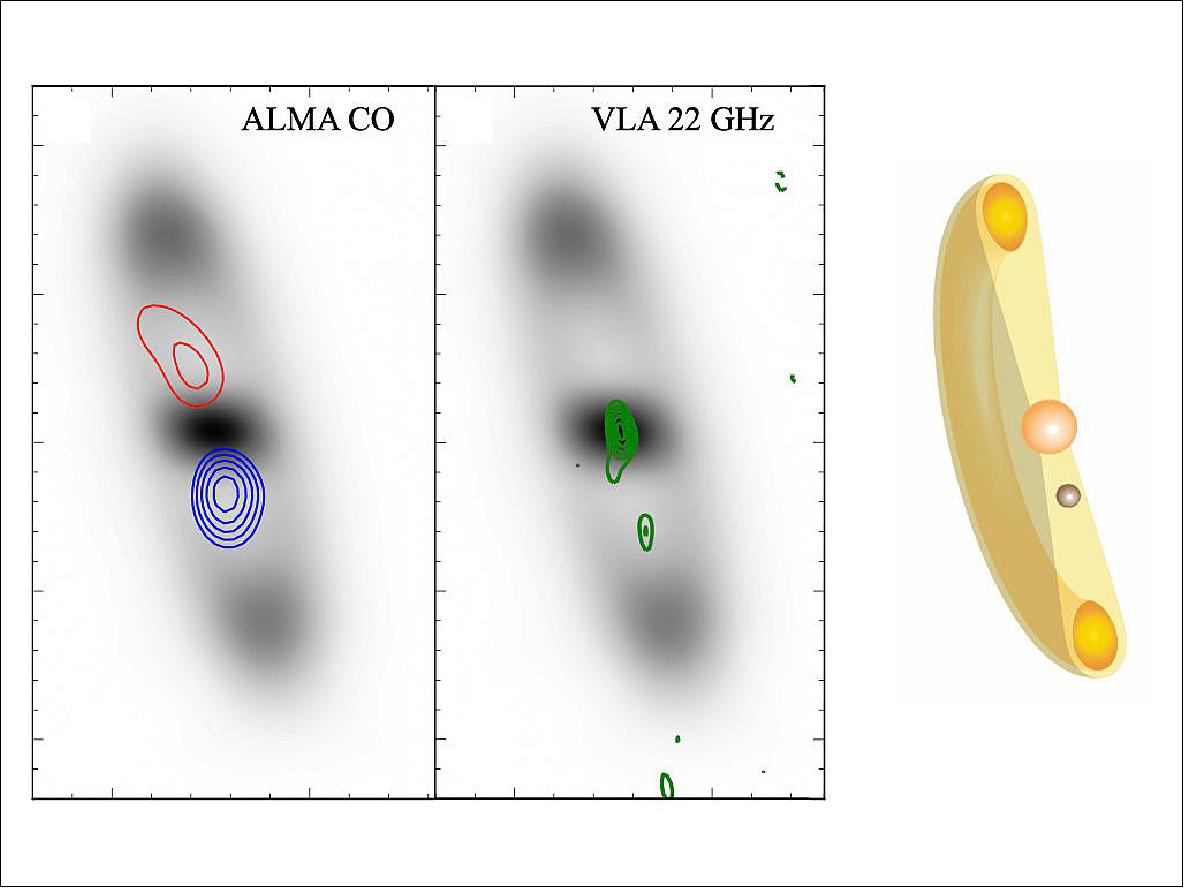
• October 21, 2020: New radio images from the Atacama Large Millimeter/submillimeter Array (ALMA) show for the first time the direct effect of volcanic activity on the atmosphere of Jupiter’s moon Io. 75)
- Io is the most volcanically active moon in our solar system. It hosts more than 400 active volcanoes, spewing out sulfur gases that give Io its yellow-white-orange-red colors when they freeze out on its surface.
- Although it is extremely thin – about a billion times thinner than Earth’s atmosphere – Io has an atmosphere that can teach us about Io’s volcanic activity and provide us a window into the exotic moon’s interior and what is happening below its colorful crust.
- Previous research has shown that Io’s atmosphere is dominated by sulfur dioxide gas, ultimately sourced from volcanic activity. “However, it is not known which process drives the dynamics in Io’s atmosphere,” said Imke de Pater of the University of California, Berkeley. “Is it volcanic activity, or gas that has sublimated (transitioned from solid to gaseous state) from the icy surface when Io is in sunlight?“
- To distinguish between the different processes that give rise to Io’s atmosphere, a team of astronomers used ALMA to make snapshots of the moon when it passed in and out of Jupiter’s shadow (they call this an “eclipse”).
- “When Io passes into Jupiter’s shadow, and is out of direct sunlight, it is too cold for sulfur dioxide gas, and it condenses onto Io’s surface. During that time we can only see volcanically-sourced sulfur dioxide. We can therefore see exactly how much of the atmosphere is impacted by volcanic activity,” explained Statia Luszcz-Cook from Columbia University, New York.
- Thanks to ALMA’s exquisite resolution and sensitivity, the astronomers could, for the first time, clearly see the plumes of sulfur dioxide (SO2) and sulfur monoxide (SO) rise up from the volcanoes. Based on the snapshots, they calculated that active volcanoes directly produce 30-50 percent of Io’s atmosphere.
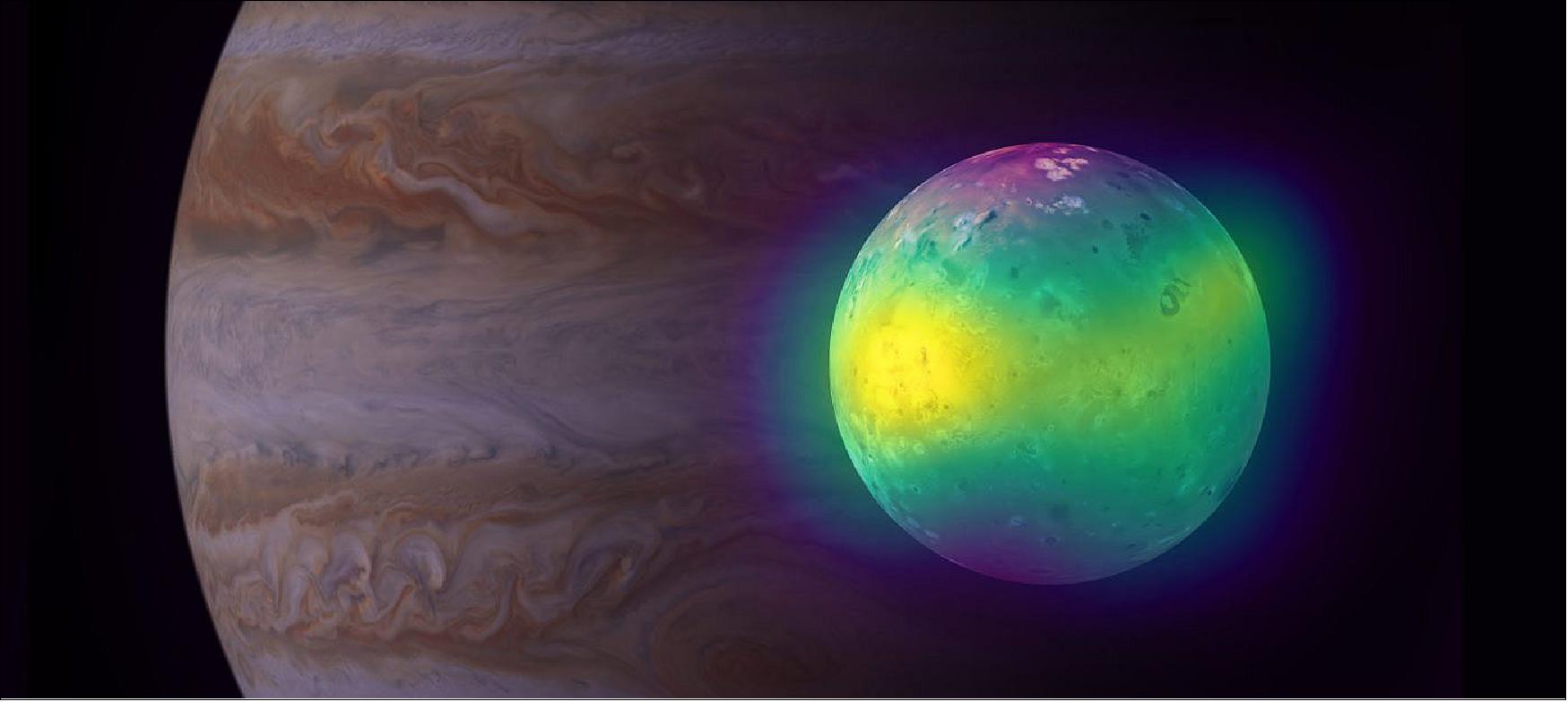
- The ALMA images also showed a third gas coming out of volcanoes: potassium chloride (KCl). “We see KCl in volcanic regions where we do not see SO2 or SO,” said Luszcz-Cook. “This is strong evidence that the magma reservoirs are different under different volcanoes.”
- Io is volcanically active due to a process called tidal heating. Io orbits Jupiter in an orbit that is not quite circular and, like our Moon always faces the same side of Earth, so does the same side of Io always face Jupiter. The gravitational pull of Jupiter’s other moons Europa and Ganymede causes tremendous amounts of internal friction and heat, giving rise to volcanoes such as Loki Patera, which spans more than 200 kilometers (124 miles) across. “By studying Io’s atmosphere and volcanic activity we learn more about not only the volcanoes themselves, but also the tidal heating process and Io’s interior,” added Luszcz-Cook.
- A big unknown remains the temperature in Io’s lower atmosphere. In future research, the astronomers hope to measure this with ALMA. “To measure the temperature of Io’s atmosphere, we need to obtain a higher resolution in our observations, which requires that we observe the moon for a longer period of time. We can only do this when Io is in sunlight since it does not spend much time in eclipse,” said de Pater. “During such an observation, Io will rotate by tens of degrees. We will need to apply software that helps us make un-smeared images. We have done this previously with radio images of Jupiter made with ALMA and the Very Large Array (VLA).”
- Imke de Pater and Statia Luszcz-Cook worked with Patricio Rojo of the Universidad de Chile, Erin Redwing of the University of California, Berkeley, Katherine de Kleer of the California Institute of Technology (Caltech), and Arielle Moullet of SOFIA/USRA in California.
- This research titled “ALMA Observations of Io Going into and Coming out of Eclipse” has been accepted for publication in The Planetary Science Journal. Preprint: https://arxiv.org/abs/2009.07729
• October 7, 2020: Astronomers have found compelling evidence that planets start to form while infant stars are still growing. The high-resolution image obtained with the Atacama Large Millimeter/submillimeter Array (ALMA) shows a young proto-stellar disk with multiple gaps and rings of dust. This new result, just published in Nature, shows the youngest and most detailed example of dust rings acting as cosmic cradles, where the seeds of planets form and take hold. 76) 77)
- An international team of scientists led by Dominique Segura-Cox at the Max Planck Institute for Extraterrestrial Physics (MPE) in Germany targeted the proto-star IRS 63 with the ALMA radio observatory. This system is 470 light years from Earth and located deep within the dense L1709 interstellar cloud in the Ophiuchus constellation. Proto-stars as young as IRS 63 are still swaddled in a large and massive blanket of gas and dust called an envelope, and the proto-star and disk feed from this reservoir of material.
![Figure 49: The dense L1709 region of the Ophiuchus Molecular Cloud, mapped by the Herschel Space Telescope, which surrounds and ... [more], image credit: MPE, D. Segura-Cox, Herschel data from ESA/Herschel/SPIRE/PACS/D. Arzoumanian)](https://www.eoportal.org/ftp/satellite-missions/a/Alma_300622/Alma_Auto3C.jpeg)
- In systems older than 1,000,000 years, after the proto-stars have finished gathering most of their mass, rings of dust have been previously detected in great numbers. IRS 63 is different: at under 500,000 years old, it is less than half the age of other young stars with dust rings and the proto-star will still grow significantly in mass. “The rings in the disk around IRS 63 are so young,” emphasizes Segura-Cox. “We used to think that stars entered adulthood first and then were the mothers of planets that came later. But now we see that proto-stars and planets grow and evolve together from early times, like siblings.”
- Planets face some serious obstacles during their earliest stages of formation. They have to grow from tiny dust particles, smaller than household dust here on Earth. “The rings in the disk of IRS 63 are vast pile-ups of dust, ready to combine into planets,” notes co-author Anika Schmiedeke at MPE. However, even after the dust clumps together to form a planet embryo, the still-forming planet could disappear by spiraling inwards and being consumed by the central proto-star. If planets do start to form very early and at large distances from the proto-star, they may better survive this process.
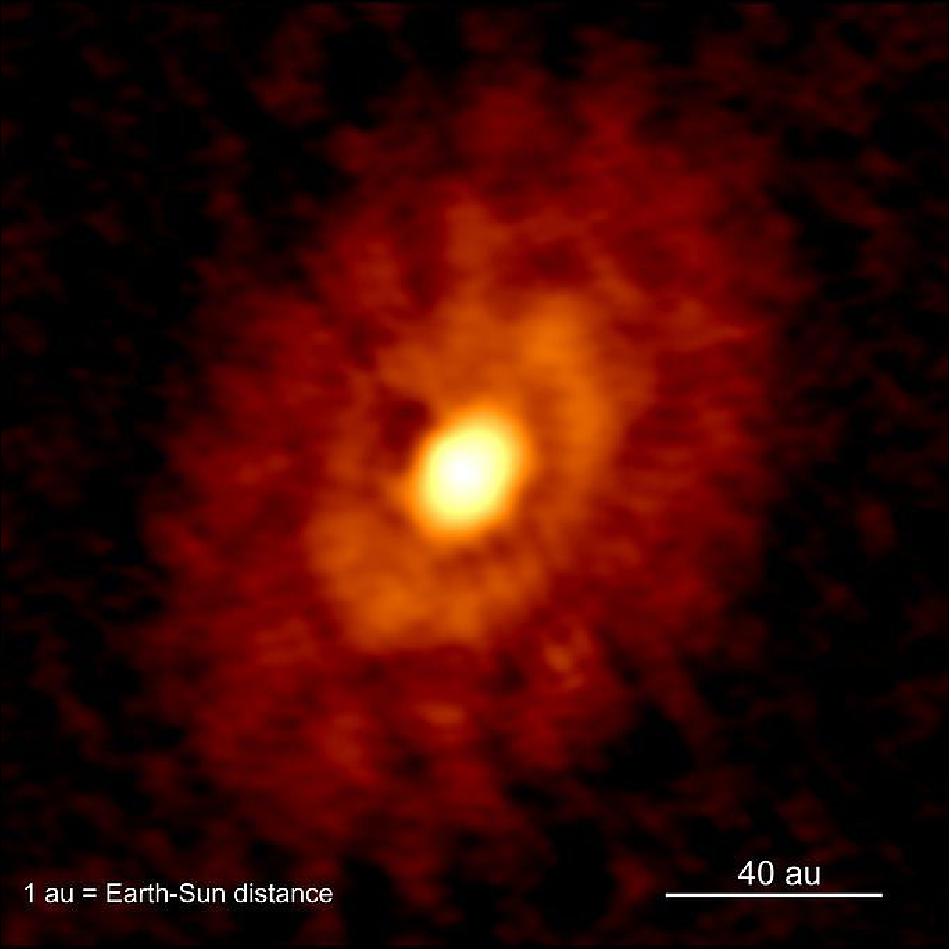
- The team of researchers found that there is about 0.5 Jupiter masses of dust in the young disk of IRS 63 further than 20 au from its center (at a distance similar to the Uranus orbit in our solar system). That is not counting the amount of gas, which could add up to 100 times more material. It takes at least 0.03 Jupiter masses of solid material to form a planet core that will efficiently accrete gas and grow to form a giant gas planet. Team member Jaime Pineda at MPE adds, “These results show that we must focus on the youngest systems to truly understand planet formation.” For example, there is growing evidence that Jupiter may have actually formed much farther out in the Solar System, beyond the Neptune orbit, and then migrated inwards to its present location. Similarly, the dust surrounding IRS 63 shows that there is enough material far from the proto-star and at a stage young enough that there is a chance for this Solar System analogue to form planets in the way that Jupiter is suspected to have formed.
- “The size of the disk is very similar to our own Solar System,” Segura-Cox explains. “Even the mass of the proto-star is just a little less than our Sun's. Studying such young planet-forming disks around proto-stars can give us important insights into our own origins.”
![Figure 51: The rings and gaps in the IRS 63 dust disk compared to a sketch of orbits in our own Solar System at the same scale ... [more], image credit: MPE, D. Segura-Cox)](https://www.eoportal.org/ftp/satellite-missions/a/Alma_300622/Alma_Auto3A.jpeg)
• September 18, 2020: Astronomers used the Atacama Large Millimeter/submillimeter Array (ALMA) to observe a set of stellar winds around aging stars and present an explanation for the mesmerizing shapes of planetary nebulae. Contrary to common consensus, the team found that stellar winds are not spherical but have a form similar to that of planetary nebulae. The team concludes that interaction with an accompanying star or exoplanet shapes both the stellar winds and planetary nebulae. The findings were published in Science. 78) 79) 80)
- Dying stars swell and cool to eventually become red giants. They produce stellar winds, flows of particles that the star expels, which causes them to lose mass. Because detailed observations were lacking, astronomers have always assumed that these winds were spherical, like the stars they surround. As the star evolves further, it heats up again, and the stellar radiation causes the expanding ejected layers of stellar material to glow, forming a planetary nebula.
- For centuries, astronomers were in the dark about the extraordinary variety of colorful shapes observed in planetary nebulas. The nebulae all seem to have a certain symmetry but are rarely round. “The Sun – which will ultimately become a red giant – is as round as a billiard ball, so we wondered: how can such a star produce all these different shapes?” says corresponding author Leen Decin (KU Leuven).
- Her team observed stellar winds around cool red giant stars with the ALMA observatory in Chile, the world’s largest radio telescope. For the first time, they gathered an extensive, detailed collection of observations. Each of them made using the same method, crucial to compare the data, and exclude biases directly.
- What the astronomers saw surprised them. “We noticed these winds are anything but symmetrical or round,” Professor Decin says. “Some of them are quite similar in shape to planetary nebulae.”
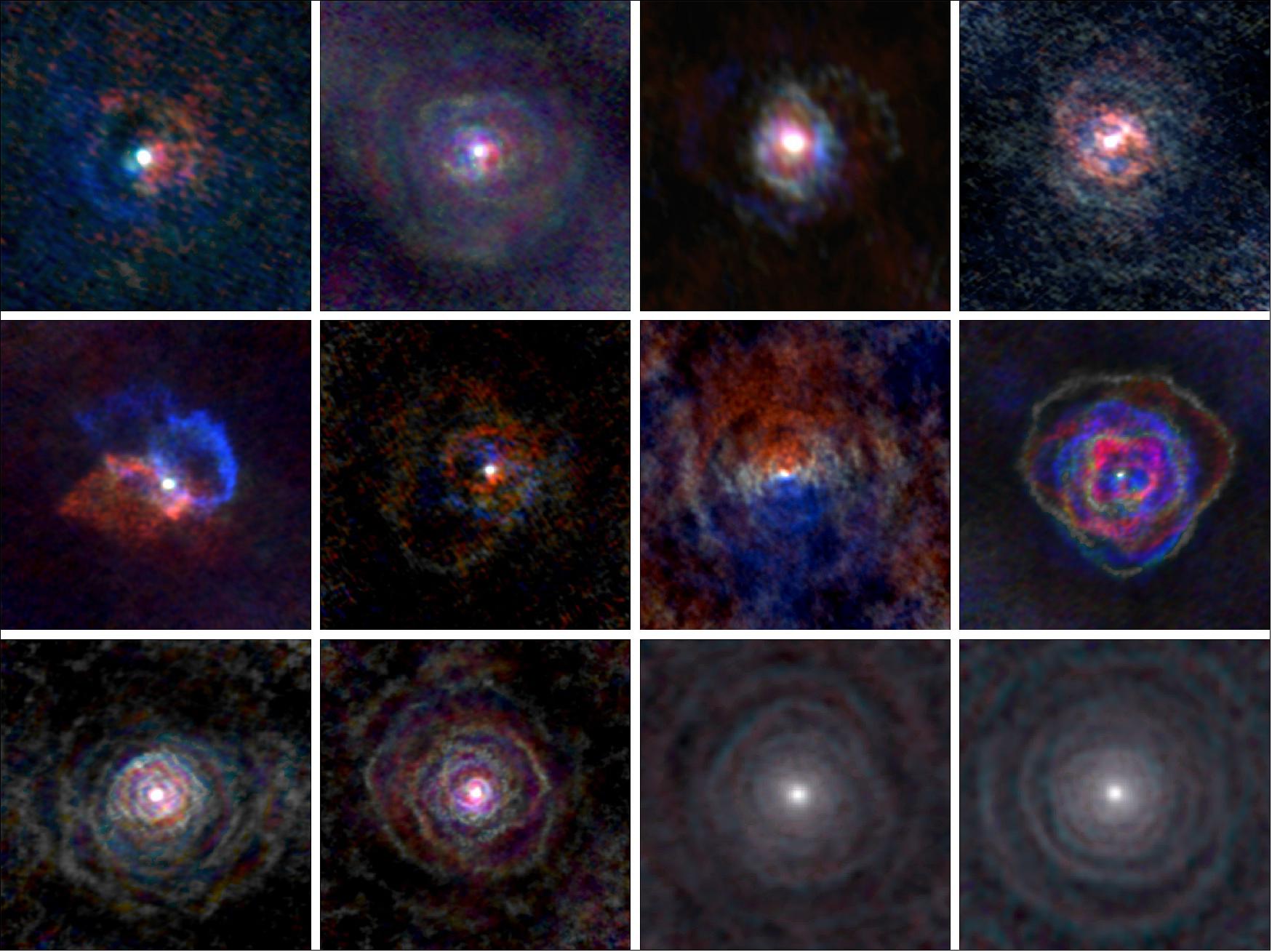
- The researchers could even identify different categories of shapes. “Some stellar winds were disk-shaped, others contained spirals, and we identified cones in a third group.” This is a clear indication that the shapes weren’t created randomly. The team realized that other low-mass stars or even heavy planets in the dying star’s vicinity were causing the different patterns. These companions are too small and dim to detect directly. “Just like how a spoon that you stir in a cup of coffee with some milk can create a spiral pattern, the companion sucks material towards it as it revolves around the star and shapes the stellar wind,” Decin explains.
- The team put this theory into models, and indeed: the shape of the stellar winds can be explained by the companions surrounding them. The rate at which the cool evolved star is losing its mass due to the stellar wind is an important parameter.
- Up until now, calculations about the evolution of stars were based on the assumption that aging Sun-like stars have spherical stellar winds. “Our findings change a lot. Since the complexity of stellar winds was not accounted for in the past, any previous mass-loss rate estimate of old stars could be wrong by up to a factor of 10.” The team is now doing further research to see how this might impact calculations of other crucial characteristics of stellar and galactic evolution.
- The study also helps envision what the Sun might look like when it dies in 7000 million years. “Jupiter or even Saturn – because they have such a big mass – are going to influence whether the Sun spends its last millennia at the heart of a spiral, a butterfly, or any of the other entrancing shapes we see in planetary nebulae today,” Decin notes. “Our calculations now indicate that a weak spiral will form in the stellar wind of the old dying Sun.”
- “We were very excited when we explored the first images,” says co-author Miguel Montargès (KU Leuven). “Each star, which was only a number before, became an individual by itself. Now, to us, they have their own identity. This is the magic of having high-precision observations: stars are no longer just points anymore.”
- The study is part of the ATOMIUM project, which aims to learn more about the physics and chemistry of old stars. “Cool aging stars are considered boring, old and simple, but we now prove that they are not: they tell the story of what comes after. It took us some time to realize that stellar winds can have the shape of rose petals (see, for example, the stellar wind of R Aquilae). But, as Antoine de Saint-Exupéry said in his book Le Petit Prince: ‘C’est le temps que tu as perdu pour ta rose, qui fait ta rose si importante’ – ‘It’s the time you spent on your rose that makes your rose so important,'” Decin concludes.
• August 12, 2020: Astronomers using the ALMA (Atacama Large Millimeter/submillimeter Array), in which the European Southern Observatory (ESO) is a partner, have revealed an extremely distant and therefore very young galaxy that looks surprisingly like our Milky Way. The galaxy is so far away its light has taken more than 12 billion years to reach us: we see it as it was when the Universe was just 1.4 billion years old. It is also surprisingly unchaotic, contradicting theories that all galaxies in the early Universe were turbulent and unstable. This unexpected discovery challenges our understanding of how galaxies form, giving new insights into the past of our Universe. 81)
- “This result represents a breakthrough in the field of galaxy formation, showing that the structures that we observe in nearby spiral galaxies and in our Milky Way were already in place 12 billion years ago,” says Francesca Rizzo, PhD student from the Max Planck Institute for Astrophysics in Germany, who led the research published today in Nature. While the galaxy the astronomers studied, called SPT0418-47, doesn’t appear to have spiral arms, it has at least two features typical of our Milky Way: a rotating disc and a bulge, the large group of stars packed tightly around the galactic center. This is the first time a bulge has been seen this early in the history of the Universe, making SPT0418-47 the most distant Milky Way look-alike.
- “The big surprise was to find that this galaxy is actually quite similar to nearby galaxies, contrary to all expectations from the models and previous, less detailed, observations,” says co-author Filippo Fraternali, from the Kapteyn Astronomical Institute, University of Groningen in the Netherlands. In the early Universe, young galaxies were still in the process of forming, so researchers expected them to be chaotic and lacking the distinct structures typical of more mature galaxies like the Milky Way.
- Studying distant galaxies like SPT0418-47 is fundamental to our understanding of how galaxies formed and evolved. This galaxy is so far away we see it when the Universe was just 10% of its current age because its light took 12 billion years to reach Earth. By studying it, we are going back to a time when these baby galaxies were just beginning to develop.
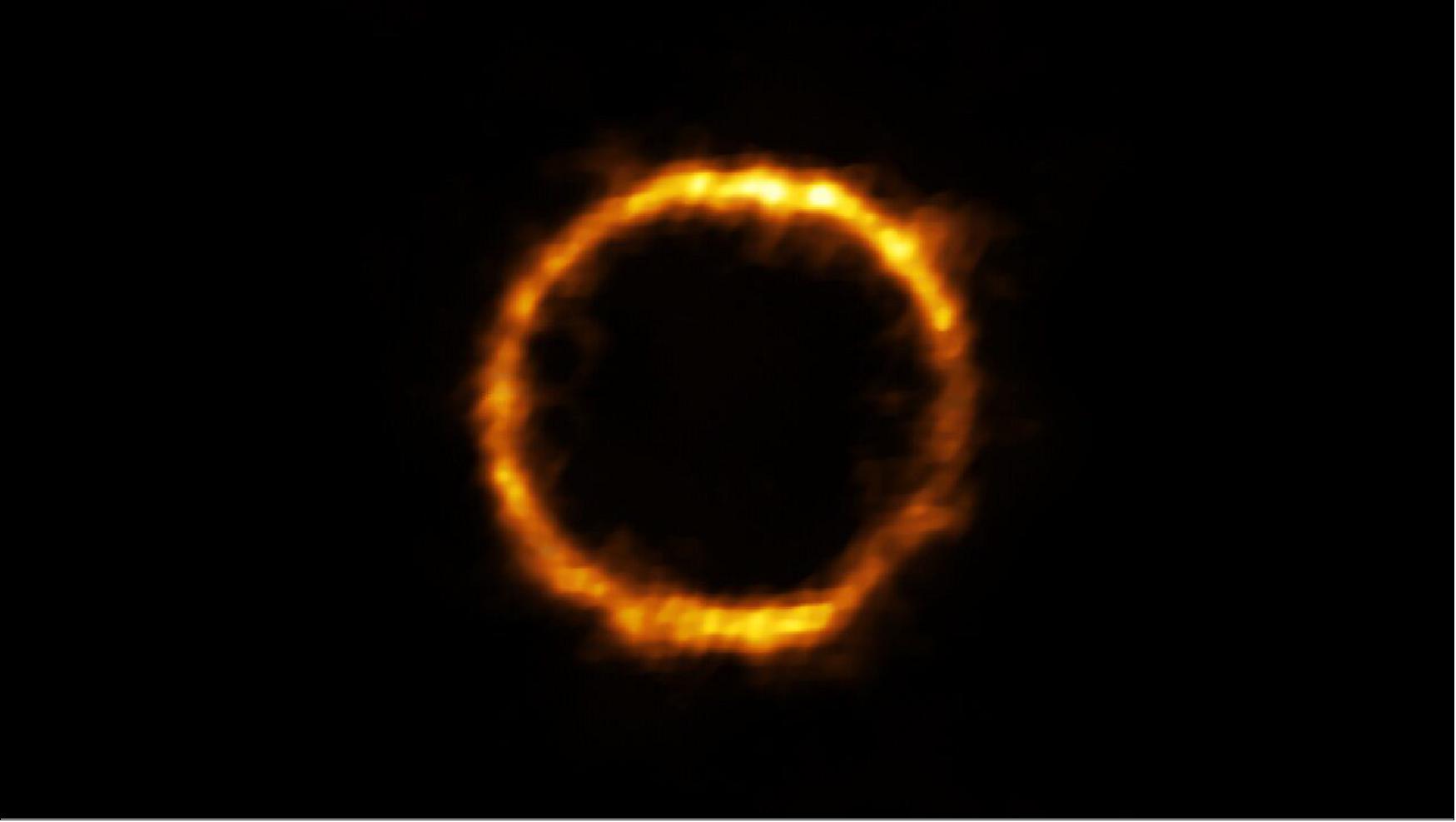
- Because these galaxies are so far away, detailed observations with even the most powerful telescopes are almost impossible as the galaxies appear small and faint. The team overcame this obstacle by using a nearby galaxy as a powerful magnifying glass — an effect known as gravitational lensing — allowing ALMA to see into the distant past in unprecedented detail. In this effect, the gravitational pull from the nearby galaxy distorts and bends the light from the distant galaxy, causing it to appear misshapen and magnified.
- The gravitationally lensed, distant galaxy appears as a near-perfect ring of light around the nearby galaxy, thanks to their almost exact alignment. The research team reconstructed the distant galaxy’s true shape and the motion of its gas from the ALMA data using a new computer modelling technique. “When I first saw the reconstructed image of SPT0418-47 I could not believe it: a treasure chest was opening,” says Rizzo.
- “What we found was quite puzzling; despite forming stars at a high rate, and therefore being the site of highly energetic processes, SPT0418-47 is the most well-ordered galaxy disc ever observed in the early Universe,” stated co-author Simona Vegetti, also from the Max Planck Institute for Astrophysics. “This result is quite unexpected and has important implications for how we think galaxies evolve." The astronomers note, however, that even though SPT0418-47 has a disc and other features similar to those of spiral galaxies we see today, they expect it to evolve into a galaxy very different from the Milky Way, and join the class of elliptical galaxies, another type of galaxies that, alongside the spirals, inhabit the Universe today.
- This unexpected discovery suggests the early Universe may not be as chaotic as once believed and raises many questions on how a well-ordered galaxy could have formed so soon after the Big Bang. This ALMA finding follows the earlier discovery announced in May of a massive rotating disc seen at a similar distance. SPT0418-47 is seen in finer detail, thanks to the lensing effect, and has a bulge in addition to a disc, making it even more similar to our present-day Milky Way than the one studied previously.
- Future studies, including with ESO’s Extremely Large Telescope, will seek to uncover how typical these ‘baby’ disc galaxies really are and whether they are commonly less chaotic than predicted, opening up new avenues for astronomers to discover how galaxies evolved. 82)
• July 9, 2020: At this time, the COVID-19 pandemic continues to affect the lives of ALMA staff and users around the world. Although in some of the ALMA regions the situation is slowly improving, in other regions, including Chile, the evolution of the outbreak remains highly uncertain. 83)
- Because of the on-going situation in Chile, ALMA operations unfortunately remain suspended. ALMA staff continue to monitor the situation very carefully and work on the development of detailed plans for the return to operations, which will be initiated when the situation allows. We will keep updating the user community on the developments.
- Northern Chile was recently hit by a magnitude 6.8 earthquake. Fortunately this caused no injuries to ALMA staff and no serious damage at the ALMA site. This was followed by extremely high winds, that led to some minor damage at the ALMA OSF (Operations Support Facility).
- As always, the ALMA Regional Centers provide support to their respective communities, and can assist in the analysis of your data and help with archive research projects. If you have any questions on this, or comments or concerns related to the situation at ALMA, please contact the ALMA helpdesk.
• July 2, 2020: Astronomers created a stunning new image showing celestial fireworks in star cluster G286.21+0.17. 84)
- Most stars in the universe, including our Sun, were born in massive star clusters. These clusters are the building blocks of galaxies, but their formation from dense molecular clouds is still largely a mystery.
- The image of cluster G286.21+0.17 (Figure 54) is a multiwavelength mosaic. The cluster is located in the Carina region of our galaxy, about 8000 light-years away.
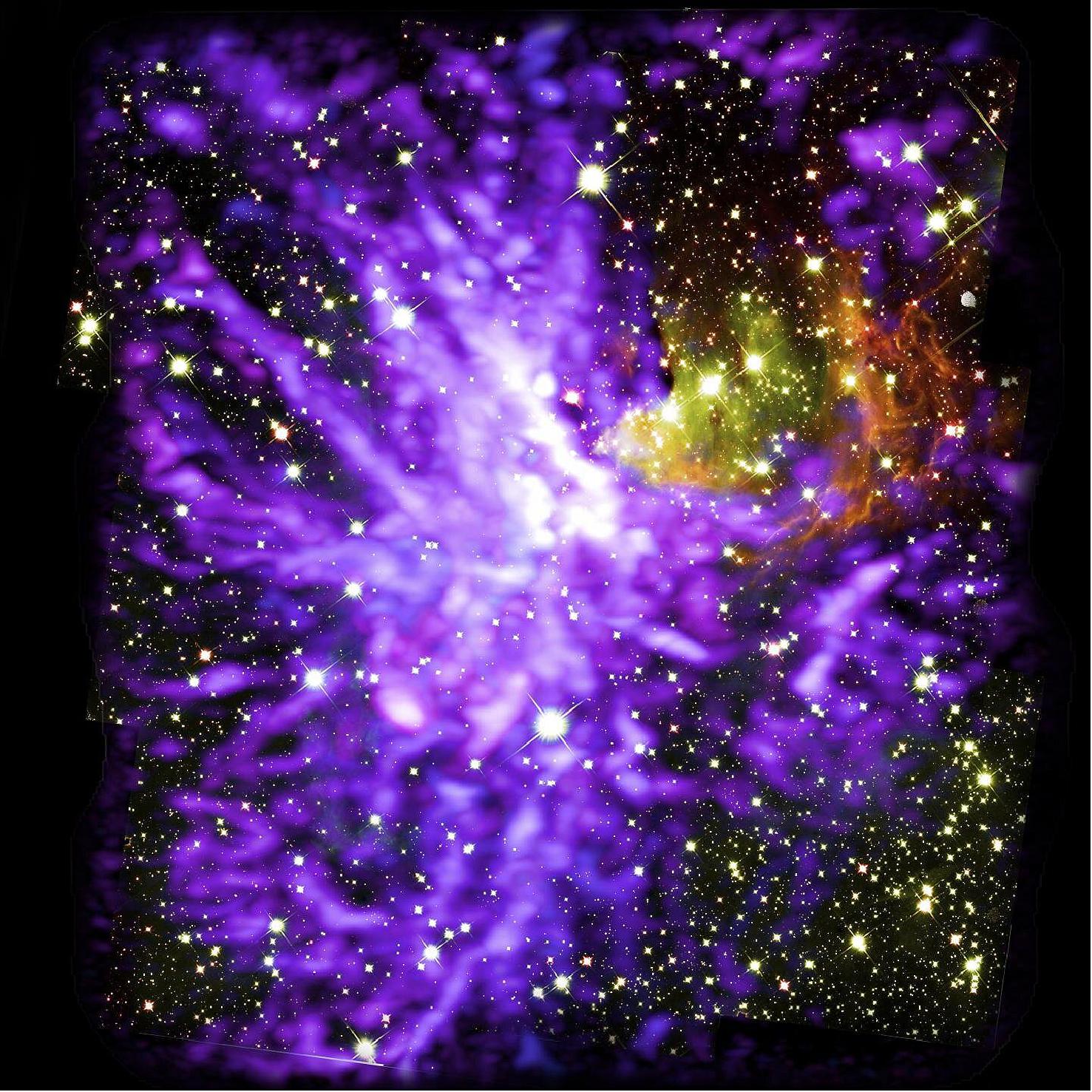
- Dense clouds made of molecular gas (purple ‘fireworks streamers’) are revealed by ALMA. The telescope observed the motions of turbulent gas falling into the cluster, forming dense cores that ultimately create individual stars.
- The stars in the image are revealed by their infrared light, as seen by Hubble, including a large group of stars bursting out from one side of the cloud. The powerful winds and radiation from the most massive of these stars are blasting away the molecular clouds, leaving faint wisps of glowing, hot dust (shown in yellow and red).
- “This image shows stars in various stages of formation within this single cluster,” said Yu Cheng of the University of Virginia in Charlottesville, Virginia, and lead author of two papers published in The Astrophysical Journal. 85) 86)
- Hubble revealed about a thousand newly-formed stars with a wide range of masses. Additionally, ALMA showed that there is a lot more mass present in dense gas that still has to undergo collapse. “Overall the process may take at least a million years to complete,” Cheng added.
- “This illustrates how dynamic and chaotic the process of star birth is,” said co-author Jonathan Tan of Chalmers University in Sweden and the University of Virginia and principal investigator of the project. “We see competing forces in action: gravity and turbulence from the cloud on one side, and stellar winds and radiation pressure from the young stars on the other. This process sculpts the region. It is amazing to think that our own Sun and planets were once part of such a cosmic dance.”
- “The phenomenal resolution and sensitivity of ALMA are evident in this stunning image of star formation,” said Joe Pesce, NSF Program Officer for NRAO/ALMA. “Combined with the Hubble Space Telescope data we can clearly see the power of multiwavelength observations to help us understand these fundamental universal processes.”
• July 6, 2020: The molecular gas in galaxies is organized into a hierarchy of structures. The molecular material in giant molecular gas clouds travels along intricate networks of filamentary gas lanes towards the congested centers of gas and dust where it is compressed into stars and planets, much like the millions of people commuting to cities for work around the world. To better understand this process, a team of astronomers led by Jonathan Henshaw at Max Planck Institute for Astronomy (MPIA) have measured the motion of gas flowing from galaxy scales down to the scales of the gas clumps within which individual stars form. Their results show that the gas flowing through each scale is dynamically interconnected: while star and planet formation occurs on the smallest scales, this process is controlled by a cascade of matter flows that begin on galactic scales. These results are published today in the scientific journal Nature Astronomy. 87) 88)
- The scientists use data from the following observatories: Atacama Large Millimeter/submillimeter Array (ALMA), Morita Atacama Compact Array, Five College Radio Astronomy Observatory (FCRAO), Institut de Radioastronomie Millimétrique (IRAM) Plateau de Bure Interferometer, Mopra Radio Telescope, and HSO (Herschel Space Observatory).
- The molecular gas in galaxies is set into motion by physical mechanisms such as galactic rotation, supernova explosions, magnetic fields, turbulence, and gravity, shaping the structure of the gas. Understanding how these motions directly impact star and planet formation is difficult, because it requires quantifying gas motion over a huge range in spatial scale, and then linking this motion to the physical structures we observe. Modern astrophysical facilities now routinely map huge areas of the sky, with some maps containing millions of pixels, each with hundreds to thousands of independent velocity measurements. As a result, measuring these motions is both scientifically and technologically challenging.
- In order to address these challenges, an international team of researchers led by Jonathan Henshaw at the MPIA in Heidelberg set out to measure gas motions throughout a variety of different environments using observations of the gas in the Milky Way and a nearby galaxy. They detect these motions by measuring the apparent change in the frequency of light emitted by molecules caused by the relative motion between the source of the light and the observer; a phenomenon known as the Doppler effect. By applying novel software designed by Henshaw and Ph.D. student Manuel Riener (a co-author on the paper; also at MPIA), the team were able to analyze millions of measurements. “This method allowed us to visualize the interstellar medium in a new way,” says Henshaw.
- The researchers found that cold molecular gas motions appear to fluctuate in velocity, reminiscent in appearance of waves on the surface of the ocean. These fluctuations represent gas motion. “The fluctuations themselves weren’t particularly surprising, we know that the gas is moving,” says Henshaw. Steve Longmore, co-author of the paper, based at Liverpool John Moores University, adds, “What surprised us was how similar the velocity structure of these different regions appeared. It didn’t matter if we were looking at an entire galaxy or an individual cloud within our own galaxy, the structure is more or less the same.”
- To better understand the nature of the gas flows, the team selected several regions for close examination, using advanced statistical techniques to look for differences between the fluctuations. By combining a variety of different measurements, the researchers were able to determine how the velocity fluctuations depend on the spatial scale.
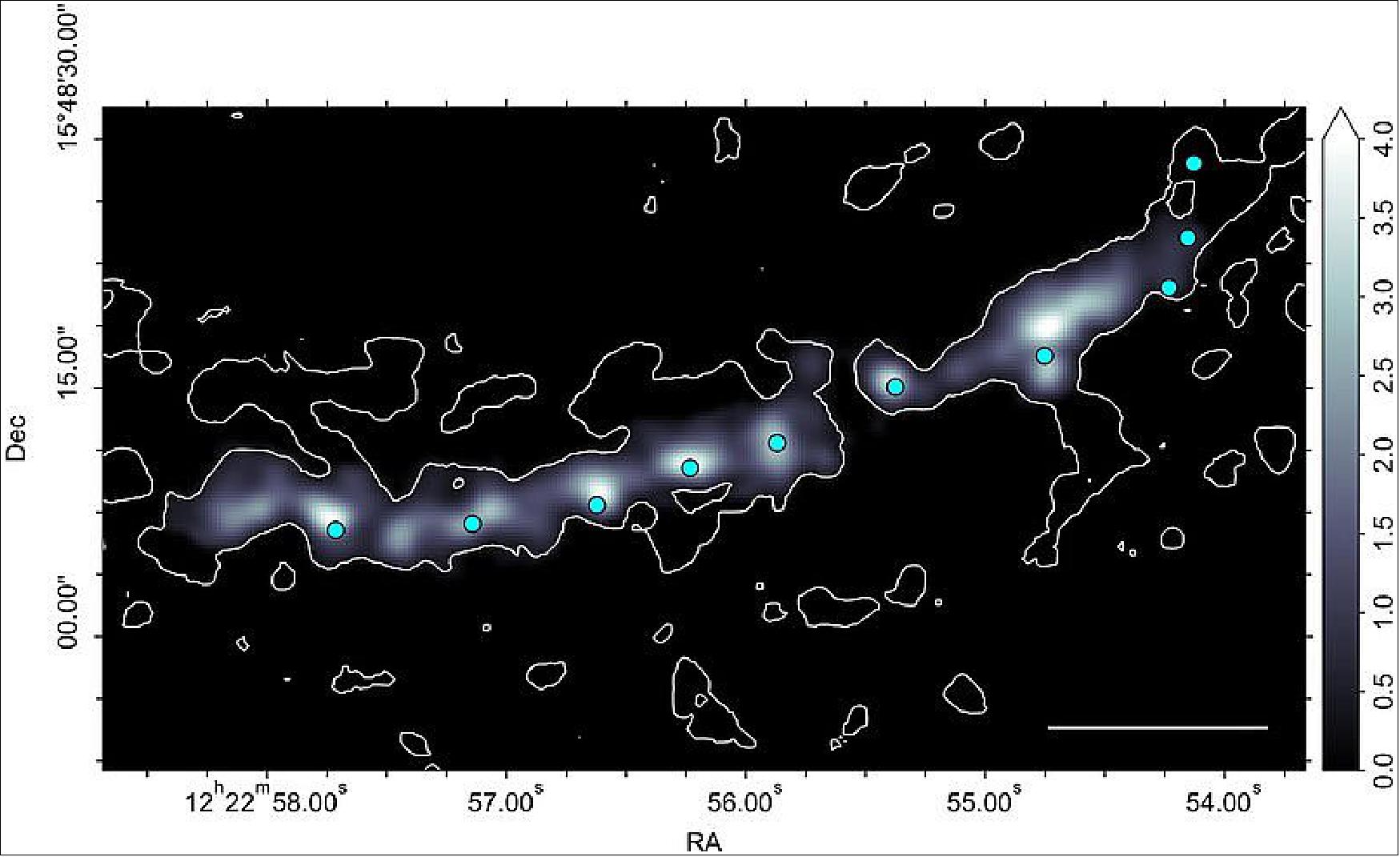
- “A neat feature of our analysis techniques is that they are sensitive to periodicity,” explains Henshaw. “If there are repeating patterns in your data, such as equally spaced giant molecular clouds along a spiral arm, we can directly identify the scale on which the pattern repeats.” The team identified three filamentary gas lanes, which, despite tracing vastly different scales, all seemed to show structure that was roughly equidistantly spaced along their crests, like beads on a string, whether it was giant molecular clouds along a spiral arm or tiny “cores” forming stars along a filament.
- The team discovered that the velocity fluctuations associated with equidistantly spaced structure all showed a distinctive pattern. “The fluctuations look like waves oscillating along the crests of the filaments, they have a well-defined amplitude and wavelength,” says Henshaw adding, “The periodic spacing of the giant molecular clouds on large-scales or individual star-forming cores on small-scales is probably the result of their parent filaments becoming gravitationally unstable. We believe that these oscillatory flows are the signature of gas streaming along spiral arms or converging towards the density peaks, supplying new fuel for star formation.”
- In contrast, the team found that the velocity fluctuations measured throughout giant molecular clouds, on scales intermediate between entire clouds and the tiny cores within them, show no obvious characteristic scale. Diederik Kruijssen, co-author of the paper based at Heidelberg University explains: “The density and velocity structures that we see in giant molecular clouds are ‘scale-free’, because the turbulent gas flows generating these structures form a chaotic cascade, revealing ever smaller fluctuations as you zoom in – much like a Romanesco broccoli, or a snowflake. This scale-free behavior takes place between two well-defined extremes: the large scale of the entire cloud, and the small scale of the cores forming individual stars. We now find that these extremes have well-defined characteristic sizes, but in between them chaos rules.”
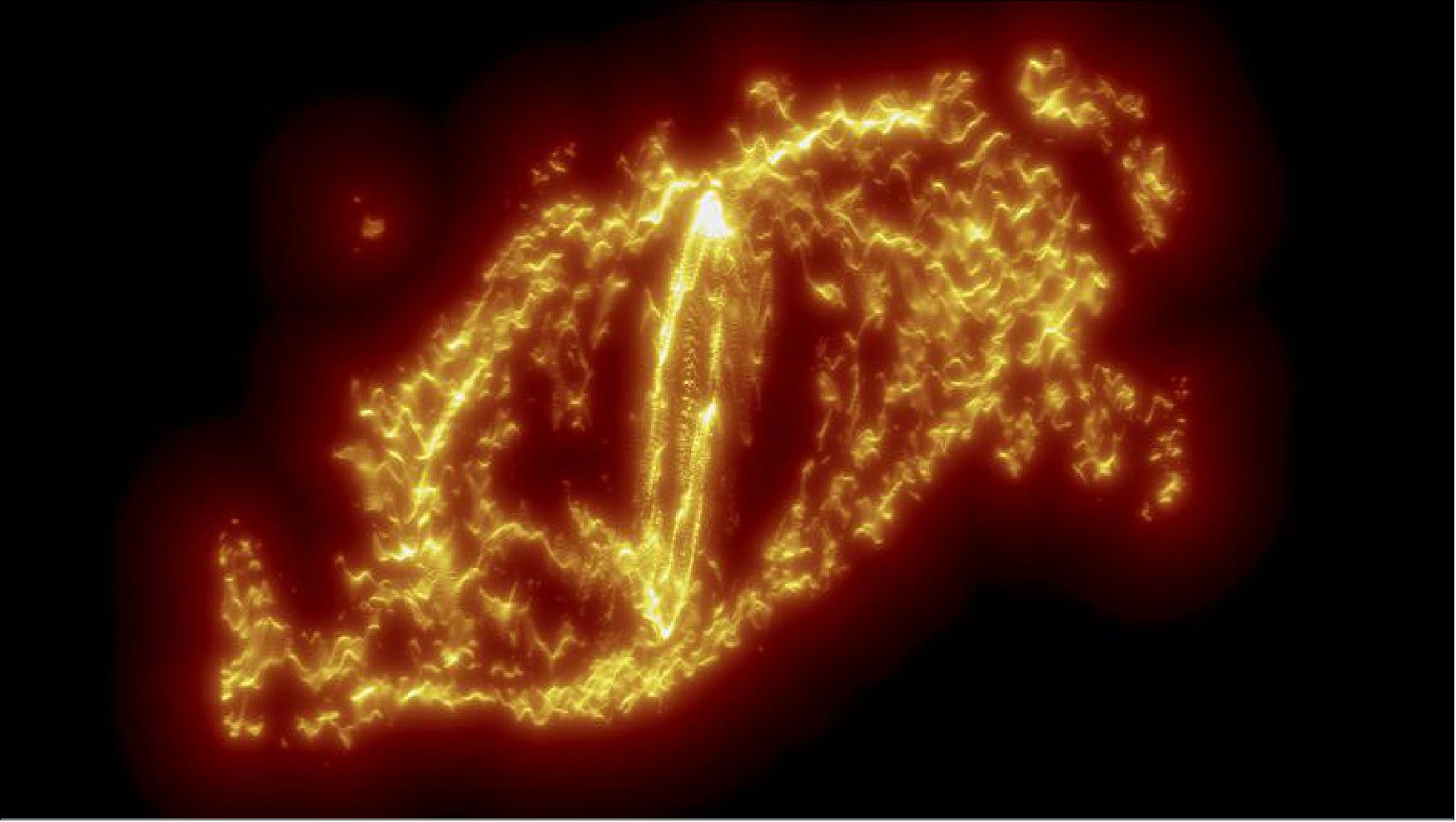
• June 16, 2020: An international team of astronomers has created the most detailed map yet of the atmosphere of the red supergiant star Antares. The unprecedented sensitivity and resolution of both the Atacama Large Millimeter/submillimeter Array (ALMA) and the National Science Foundation’s Karl G. Jansky Very Large Array (VLA) revealed the size and temperature of Antares’ atmosphere from just above the star’s surface, throughout its chromosphere, and all the way out to the wind region. 89) 90)
- Red supergiant stars, like Antares and its more well-known cousin Betelgeuse, are huge, relatively cold stars at the end of their lifetime. They are on their way to run out of fuel, collapse, and become supernovae. Through their vast stellar winds, they launch heavy elements into space, thereby playing an important role in providing the essential building blocks for life in the universe. But it is a mystery how these enormous winds are launched. A detailed study of the atmosphere of Antares, the closest supergiant star to Earth, provides a crucial step towards an answer.
- The ALMA and VLA map of Antares is the most detailed radio map yet of any star, other than the Sun. ALMA observed Antares close to its surface (its optical photosphere) in shorter wavelengths, and the longer wavelengths observed by the VLA revealed the star’s atmosphere further out. As seen in visible light, Antares’ diameter is approximately 700 times larger than the Sun. But when ALMA and the VLA revealed its atmosphere in radio light, the supergiant turned out to be even more gigantic.
- “The size of a star can vary dramatically depending on what wavelength of light it is observed with,” explained Eamon O’Gorman of the Dublin Institute for Advanced Studies in Ireland and lead author of the study published in the June 16 edition of the journal Astronomy & Astrophysics. “The longer wavelengths of the VLA revealed the supergiant’s atmosphere out to nearly 12 times the star’s radius.”
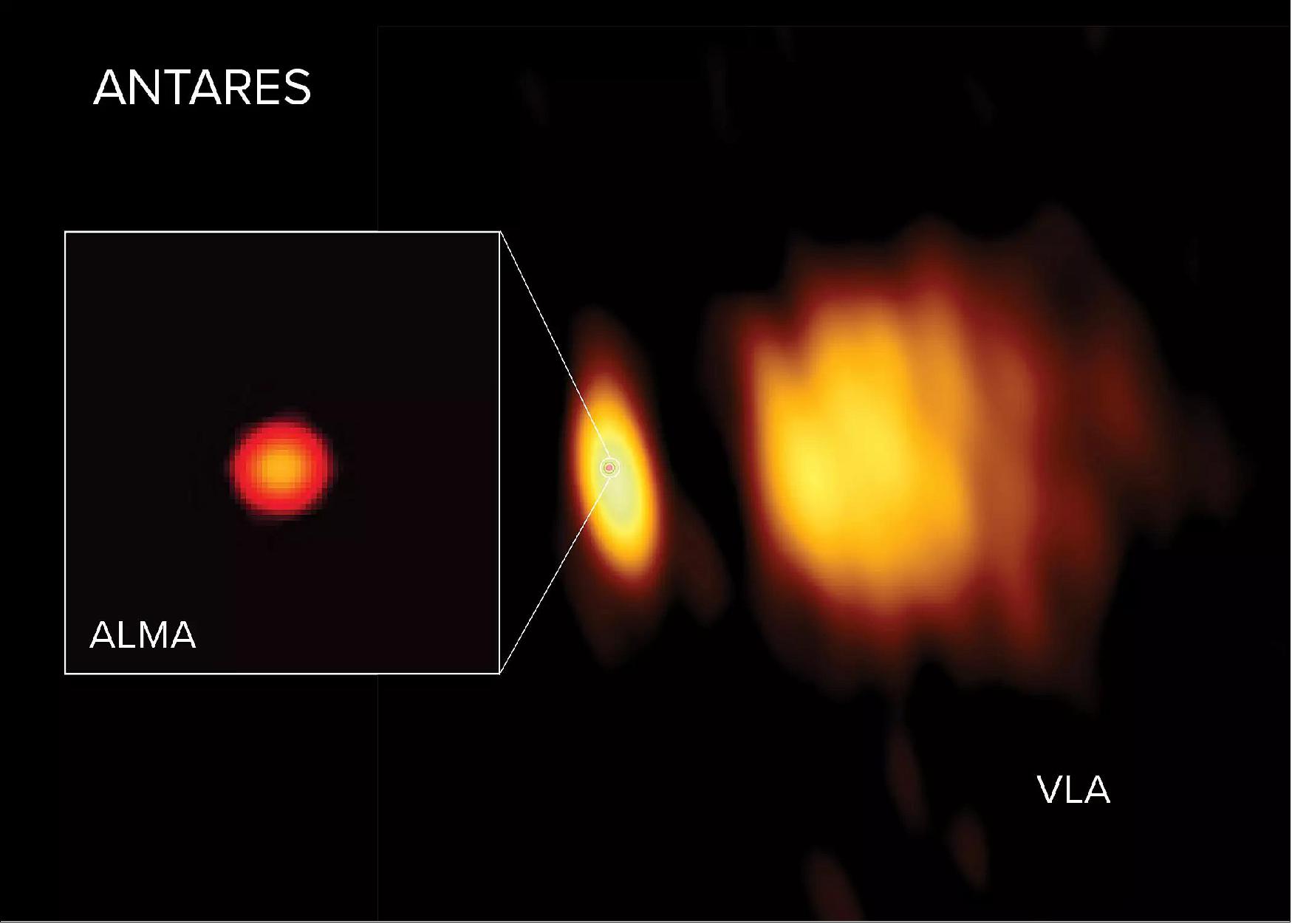
- The radio telescopes measured the temperature of most of the gas and plasma in Antares’ atmosphere. Most noticeable was the temperature in the chromosphere. This is the region above the star’s surface that is heated up by magnetic fields and shock waves created by the vigorous roiling convection at the stellar surface – much like the bubbling motion in a pot of boiling water. Not much is known about chromospheres, and this is the first time that this region has been detected in radio waves.
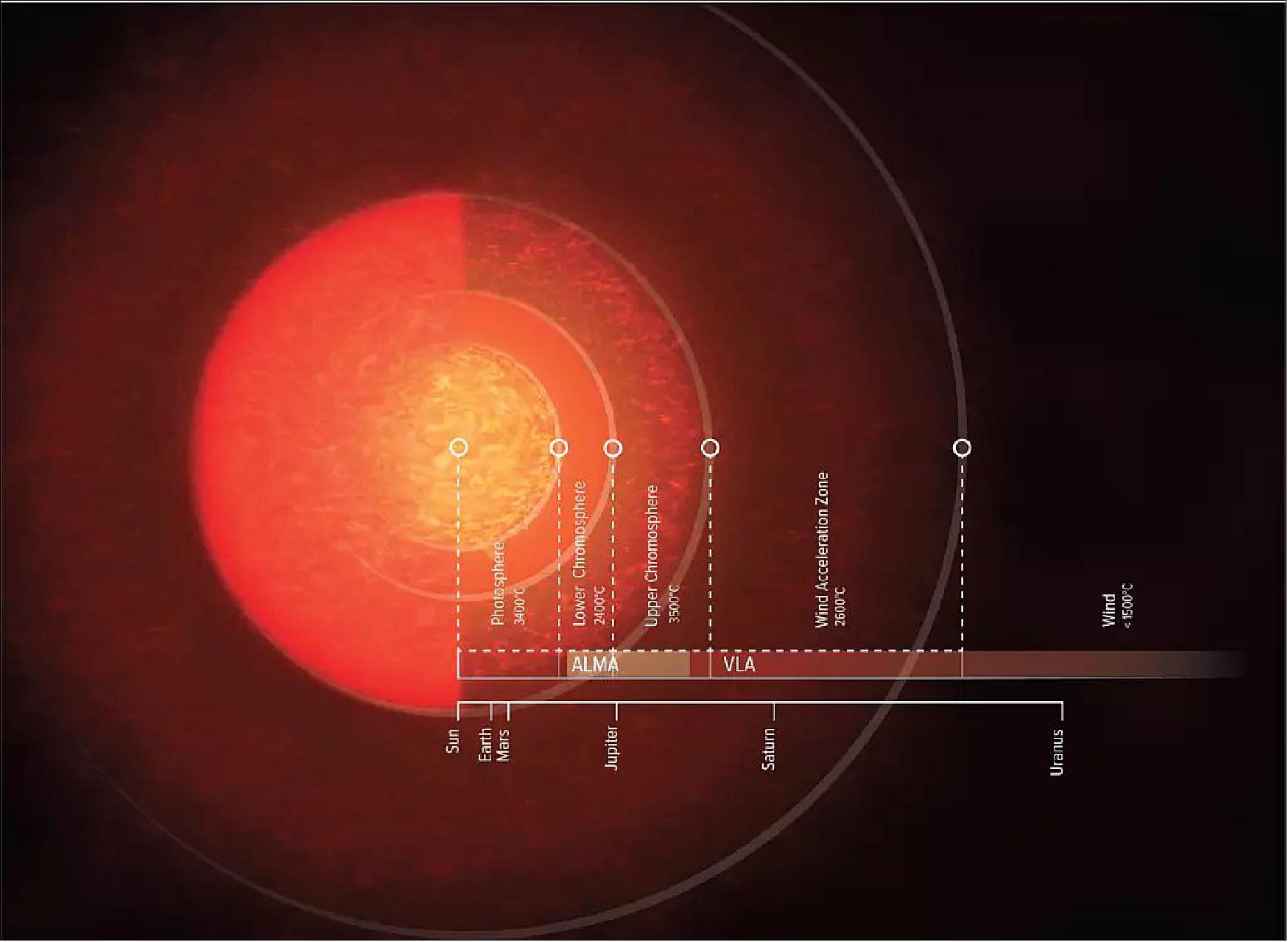
- Thanks to ALMA and the VLA, the scientists discovered that the star’s chromosphere extends out to 2.5 times the star’s radius (our Sun’s chromosphere is only 1/200th of its radius). They also found that the temperature of the chromosphere is lower than previous optical and ultraviolet observations have suggested. The temperature peaks at 3,500 degrees Celsius (6,400 degrees Fahrenheit), after which it gradually decreases. As a comparison, the Sun’s chromosphere reaches temperatures of almost 20,000 degrees Celsius.
- “We found that the chromosphere is ‘lukewarm’ rather than hot, in stellar temperatures,” said O’Gorman. “The difference can be explained because our radio measurements are a sensitive thermometer for most of the gas and plasma in the star’s atmosphere, whereas past optical and ultraviolet observations were only sensitive to very hot gas and plasma.”
- “We think that red supergiant stars, such as Antares and Betelgeuse, have an inhomogeneous atmosphere,” said co-author Keiichi Ohnaka of the Universidad Católica del Norte in Chile who previously observed Antares’ atmosphere in infrared light. “Imagine that their atmospheres are a painting made out of many dots of different colors, representing different temperatures. Most of the painting contains dots of the lukewarm gas that radio telescopes can see, but there are also cold dots that only infrared telescopes can see, and hot dots that UV telescopes see. At the moment we can’t observe these dots individually, but we want to try that in future studies.”
- In the ALMA and VLA data, astronomers for the first time saw a clear distinction between the chromosphere and the region where winds start to form. In the VLA image, a huge wind is visible, ejected from Antares and lit up by its smaller but hotter companion star Antares B.
- “When I was a student, I dreamt of having data like this,” said co-author Graham Harper of the University of Colorado, Boulder. “Knowing the actual sizes and temperatures of the atmospheric zones gives us a clue of how these huge winds start to form and how much mass is being ejected.”
- “Our innate understanding of the night sky is that stars are just points of light. The fact we can map the atmospheres of these supergiant stars in detail, is a true testament to technological advances in interferometry. These tour de force observations bring the universe close, right into our own backyard,” said Chris Carilli of the National Radio Astronomy Observatory, who was involved in the first observations of Betelgeuse at multiple radio wavelengths with the VLA in 1998.
• June 9, 2020: High-resolution observations of a young star forming system clearly unveil a pair of protostars at their earliest stages of evolution deeply embedded within the source IRAS 16293-2422 in the Ophiuchus molecular cloud. The team led by the MPE (Max Planck Institute for Extraterrestrial Physics) in Garching, Germany, used the ALMA interferometer not only to pin down the source configuration, but also to measure the gas and stellar kinematics, determining the mass of the young binary. The two close protostars are somewhat heavier than previously thought and they revolve around each other once in about 400 years. 91)
- The system called IRAS 16293-2422 is one of the brightest star-forming regions in our neighborhood. It is located in the Ophiuchus molecular cloud at a distance of about 460 light-years and has been widely studied, also because it shows strong emission of numerous complex organic molecules, building blocks of pre-biotic species. However, until now the detailed configuration of the region was unclear, with observations at different wavelengths showing multiple compact sources at slightly different locations. This confusion was due to the large amount of material in front of the nascent protostars, expected at these earliest stages of formation.
- An international team of astronomers led by the Max Planck Institute for Extraterrestrial Physics (MPE) has now obtained high-resolution radio observations with the ALMA interferometer, which clearly reveals two compact sources A1 and A2 in addition to the well-known protostar B (see Figure 59). “Our observations confirm the location of the two close protostars and reveal that each is surrounded by a very small dust disk. Both, in turn, are in turn embedded in a large amount of material showing complex patterns” remarks María José Maureira from MPE, the lead author of the study. 92)
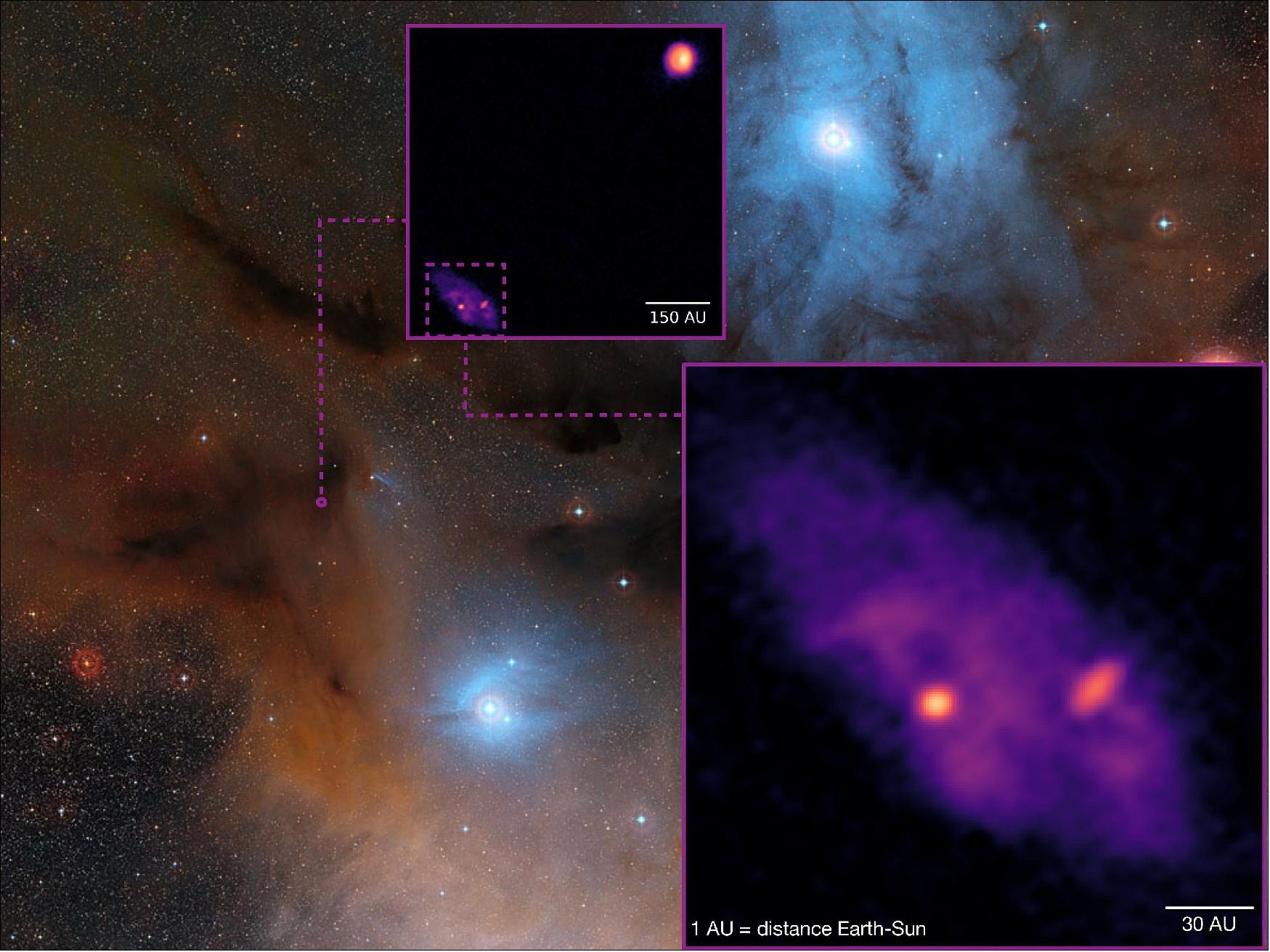
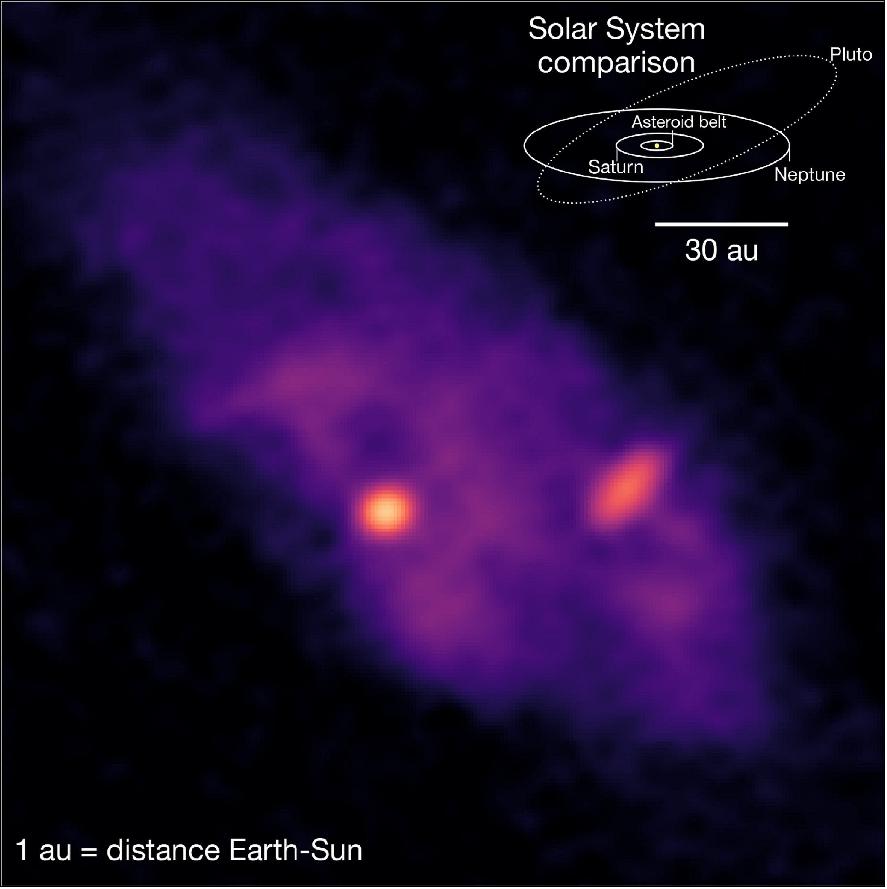
- The source A1 has a mass of a bit less than 1 solar mass and is embedded in a small dust disk about the size of the asteroid belt; the source A2 has a mass of about 1.4 solar masses and is embedded in a somewhat larger disk (see Figure 60). Interestingly, this disk around A2 also appears at an angle compared to the overall orientation of the larger cloud structure, while the disk around the source B – at a much larger distance – is seen face-on, indicating a rather chaotic formation history.
- In addition to direct imaging of the dust emission, the team also obtained information on the motion of the gas around the stars through observations of spectral lines of organic molecules, which well trace the high-density region surrounding the discovered binary system. This allowed them to get an independent mass measurement and to confirm that A1 and A2 form a bound pair.
- Combining their latest observations with data collected over the past 30 years, the team found that the two stars orbit each other once every 360 years at a distance similar to the extent of Pluto’s orbit, where the orbit is tilted by about 60° (see Figure 61). “This is the first time that we were able to derive the full orbital parameters of a binary system at this early stage of star formation,” points out Jaime Pineda from MPE, who contributed to the modelling.
- “With these results we are finally able to dive into one of the most embedded and youngest proto-stellar systems, unveiling its dynamical structure and complex morphology, where we clearly see filamentary material connecting the circumstellar disks to the surrounding region and likely to the cirbumbinary disk. The small disks are probably still being fed and growing!” emphasizes Paola Caselli, director at MPE and head of the Center for Astrochemical Studies. “This was only possible thanks to the great sensitivity of ALMA and the observations of molecules which uniquely trace these dense regions. Molecules send us signals at very specific frequencies, and, following changes of such frequencies across the region (due to internal motions) one can reconstruct the complex kinematics of the system. This is the power of astrochemistry.”
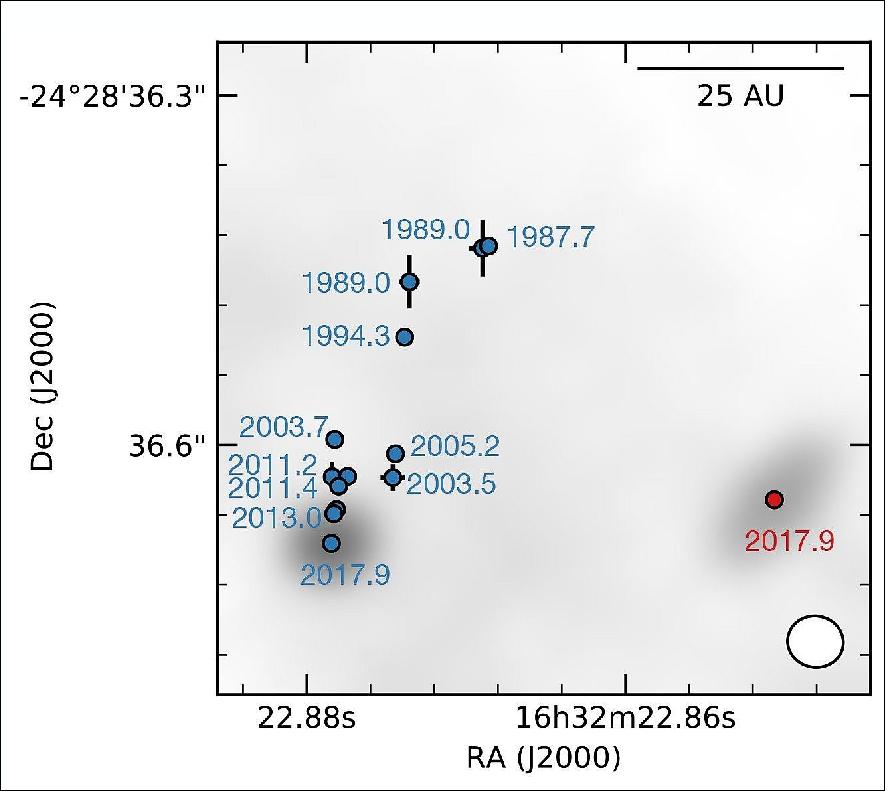
• May 22, 2020: Astronomers of NAOJ (National Astronomy Observatory, Japan) and Keio University using the Atacama Large Millimeter/submillimeter Array (ALMA) found quasi-periodic flickers in millimeter-waves from the center of the Milky Way, Sagittarius (Sgr) A*. The team interpreted these blinks to be due to the rotation of radio spots circling the supermassive black hole with an orbit radius smaller than that of Mercury. This is an interesting clue to investigate space-time with extreme gravity. 93)
- “It has been known that Sgr A* sometimes flares up in millimeter wavelength,” tells Yuhei Iwata, the lead author of the paper published in the Astrophysical Journal Letters and a graduate student at Keio University, Japan. “This time, using ALMA, we obtained high-quality data of radio-wave intensity variation of Sgr A* for 10 days, 70 minutes per day. Then we found two trends: quasi-periodic variations with a typical time scale of 30 minutes and hour-long slow variations.”
- Astronomers presume that a supermassive black hole with a mass of 4 million suns is located at the center of Sgr A*. Flares of Sgr A* have been observed not only in millimeter wavelength, but also in infrared light and X-ray. However, the variations detected with ALMA are much smaller than the ones previously detected, and it is possible that these levels of small variations always occur in Sgr A*.
- The black hole itself does not produce any kind of emission. The source of the emission is the scorching gaseous disk around the black hole. The gas around the black hole does not go straight to the gravitational well, but it rotates around the black hole to form an accretion disk.
- The team focused on short timescale variations and found that the variation period of 30 minutes is comparable to the orbital period of the innermost edge of the accretion disk with the radius of 0.2 astronomical units (1 astronomical unit corresponds to the distance between the Earth and the Sun: 150 million kilometers). For comparison, Mercury, the solar system’s innermost planet, circles around the Sun at a distance of 0.4 astronomical units. Considering the colossal mass at the center of the black hole, its gravity effect is also extreme in the accretion disk.
- “This emission could be related with some exotic phenomena occurring at the very vicinity of the supermassive black hole,” says Tomoharu Oka, a professor at Keio University.
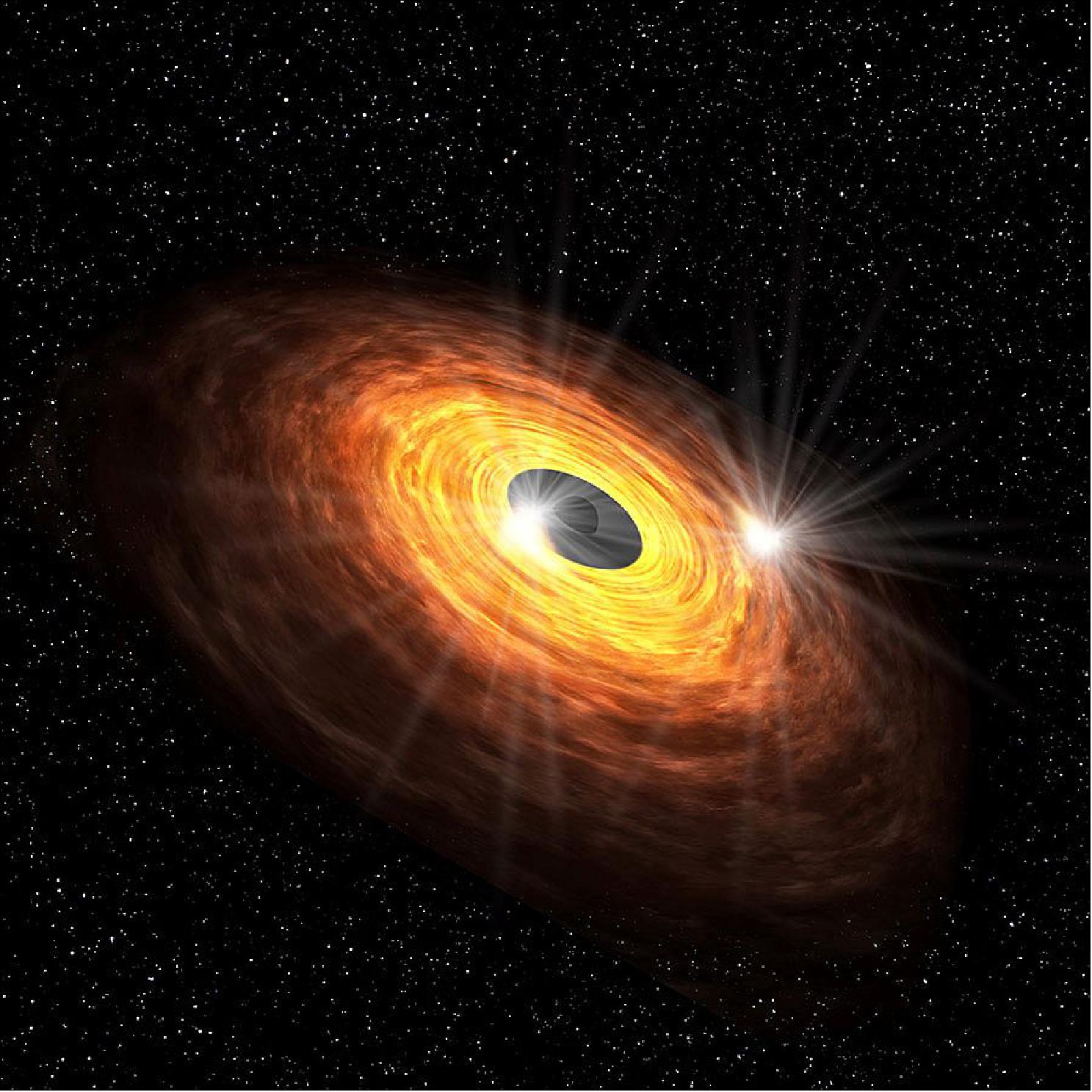
- Their scenario is as follows. Hot spots are sporadically formed in the disk and circle around the black hole, emitting strong millimeter waves. According to Einstein’s special relativity theory, the emission is largely amplified when the source is moving toward the observer with a speed comparable to that of light. The rotation speed of the inner edge of the accretion disk is quite large, so this extraordinary effect arises. The astronomers believe that this is the origin of the short-term variation of the millimeter emission from Sgr A*.
- The team supposes that the variation might affect the effort to make an image of the supermassive black hole with the Event Horizon Telescope. “In general, the faster the movement is, the more difficult it is to take a photo of the object,” says Oka. “Instead, the variation of the emission itself provides compelling insight for the gas motion. We may witness the very moment of gas absorption by the black hole with a long-term monitoring campaign with ALMA.” The researchers aim to draw out independent information to understand the mystifying environment around the supermassive black hole. 94)
• May 20, 2020: In our 13.8 billion-year-old universe, most galaxies like our Milky Way form gradually, reaching their large mass relatively late. But a new discovery made with the Atacama Large Millimeter/submillimeter Array (ALMA) of a massive rotating disk galaxy, seen when the universe was only ten percent of its current age, challenges the traditional models of galaxy formation. This research appears on 20 May 2020 in the journal Nature. 95) 96)
- Galaxy DLA0817g, nicknamed the Wolfe Disk after the late astronomer Arthur M. Wolfe, is the most distant rotating disk galaxy ever observed. The unparalleled power of ALMA made it possible to see this galaxy spinning at 170 miles (272 kilometers) per second, similar to our Milky Way.
- “While previous studies hinted at the existence of these early rotating gas-rich disk galaxies, thanks to ALMA we now have unambiguous evidence that they occur as early as 1.5 billion years after the Big Bang,” said lead author Marcel Neeleman of the Max Planck Institute for Astronomy in Heidelberg, Germany.
How Did the Wolfe Disk Form?
- The discovery of the Wolfe Disk provides a challenge for many galaxy formation simulations, which predict that massive galaxies at this point in the evolution of the cosmos grew through many mergers of smaller galaxies and hot clumps of gas.
- “Most galaxies that we find early in the universe look like train wrecks because they underwent consistent and often ‘violent’ merging,” explained Neeleman. “These hot mergers make it difficult to form well-ordered, cold rotating disks like we observe in our present universe.”
- In most galaxy formation scenarios, galaxies only start to show a well-formed disk around 6 billion years after the Big Bang. The fact that the astronomers found such a disk galaxy when the universe was only ten percent of its current age, indicates that other growth processes must have dominated.
- “We think the Wolfe Disk has grown primarily through the steady accretion of cold gas,” said J. Xavier Prochaska, of the University of California, Santa Cruz and coauthor of the paper. “Still, one of the questions that remains is how to assemble such a large gas mass while maintaining a relatively stable, rotating disk.”
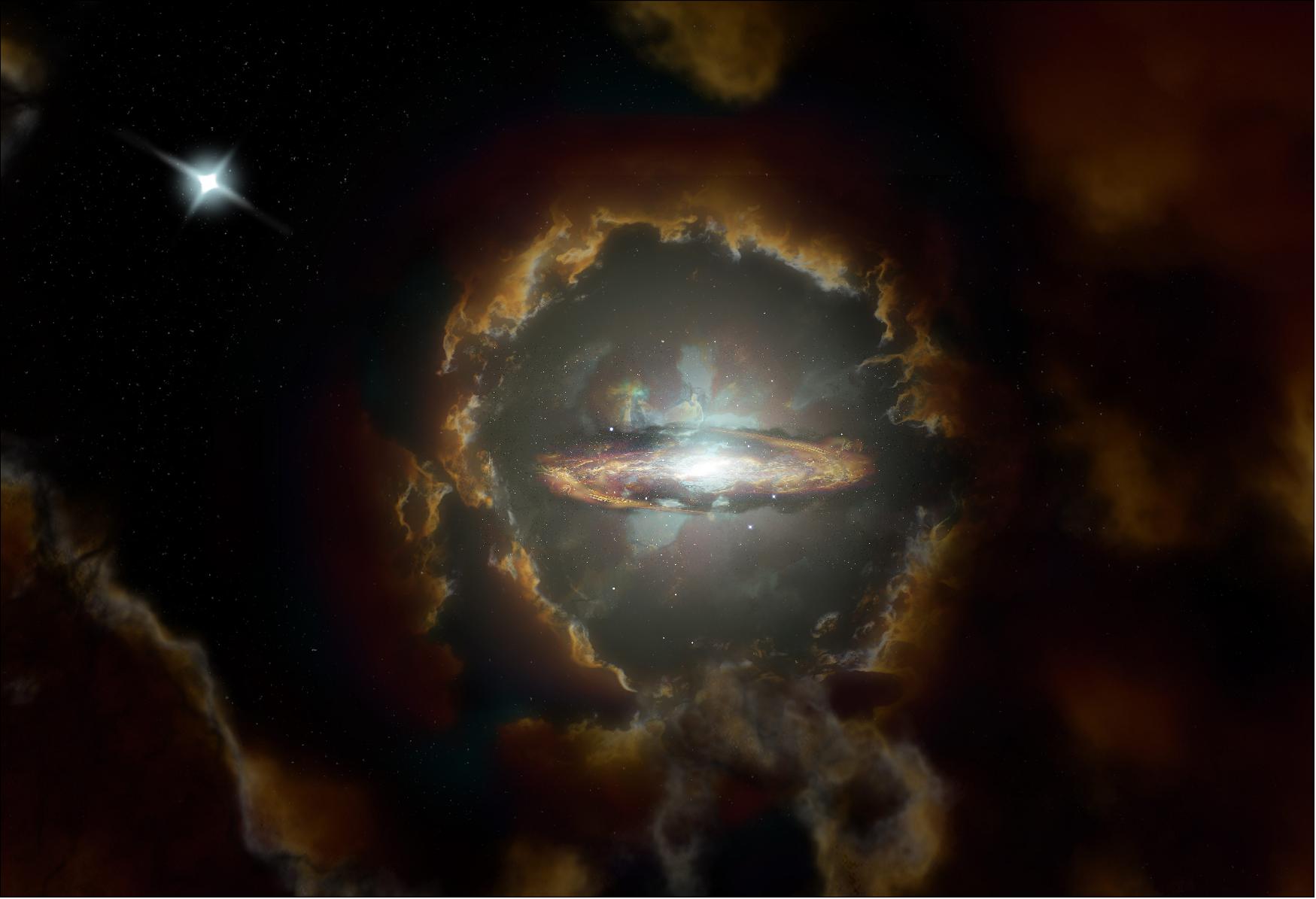
Star Formation
- The team also used the National Science Foundation’s Karl G. Jansky Very Large Array (VLA) and the NASA/ESA Hubble Space Telescope to learn more about star formation in the Wolfe Disk. In radio wavelengths, ALMA looked at the galaxy’s movements and mass of atomic gas and dust while the VLA measured the amount of molecular mass – the fuel for star formation. In UV-light, Hubble observed massive stars. “The star formation rate in the Wolfe Disk is at least ten times higher than in our own galaxy,” explained Prochaska. “It must be one of the most productive disk galaxies in the early universe.”
A ‘Normal’ Galaxy
- The Wolfe Disk was first discovered by ALMA in 2017. Neeleman and his team found the galaxy when they examined the light from a more distant quasar. The light from the quasar was absorbed as it passed through a massive reservoir of hydrogen gas surrounding the galaxy – which is how it revealed itself. Rather than looking for direct light from extremely bright, but more rare galaxies, astronomers used this ‘absorption’ method to find fainter, and more ‘normal’ galaxies in the early universe.
- “The fact that we found the Wolfe Disk using this method, tells us that it belongs to the normal population of galaxies present at early times,” said Neeleman. “When our newest observations with ALMA surprisingly showed that it is rotating, we realized that early rotating disk galaxies are not as rare as we thought and that there should be a lot more of them out there.”
- “This observation epitomizes how our understanding of the universe is enhanced with the advanced sensitivity that ALMA brings to radio astronomy,” said Joe Pesce, astronomy program director at the National Science Foundation, which funds the telescope. “ALMA allows us to make new, unexpected findings with almost every observation.”
- The National Radio Astronomy Observatory is a facility of the National Science Foundation, operated under cooperative agreement by Associated Universities, Inc.
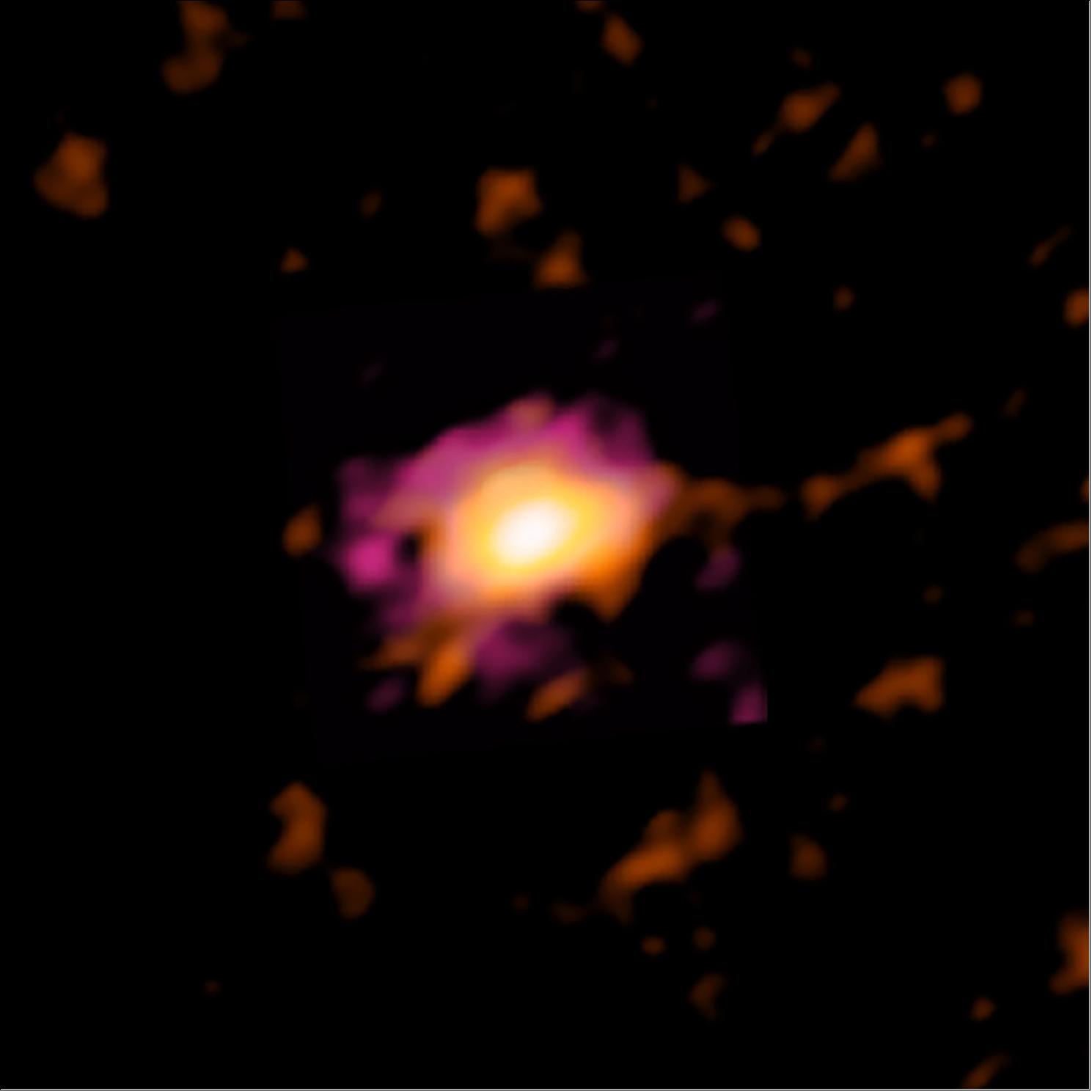
• March 19, 2020: Astronomers using ALMA have found striking orbital geometries in protoplanetary disks around binary stars. While disks orbiting the most compact binary star systems share very nearly the same plane, disks encircling wide binaries have orbital planes that are severely tilted. These systems can teach us about planet formation in complex environments. 97)
- In the last two decades, thousands of planets have been found orbiting stars other than our Sun. Some of these planets orbit two stars, just like Luke Skywalker’s home Tatooine. Planets are born in protoplanetary disks – we now have wonderful observations of these thanks to ALMA – but most of the disks studied so far orbit single stars. ‘Tatooine’ exoplanets form in disks around binary stars, so-called circumbinary disks.
- Studying the birthplaces of ‘Tatooine’ planets provides a unique opportunity to learn about how planets form in different environments. Astronomers already know that the orbits of binary stars can warp and tilt the disk around them, resulting in a circumbinary disk misaligned relative to the orbital plane of its host stars. For example, in a 2019 study led by Grant Kennedy of the University of Warwick, UK, ALMA found a striking circumbinary disk in a polar configuration.
- “With our study, we wanted to learn more about the typical geometries of circumbinary disks,” said astronomer Ian Czekala of the University of California at Berkeley. Czekala and his team used ALMA data to determine the degree of alignment of nineteen protoplanetary disks around binary stars. “The high resolution ALMA data was critical for studying some of the smallest and faintest circumbinary disks yet,” said Czekala.
- “We see a clear overlap between the small disks, orbiting compact binaries, and the circumbinary planets found with the Kepler mission,” Czekala said. Because the primary Kepler mission lasted 4 years, astronomers were only able to discover planets around binary stars that orbit each other in fewer than 40 days. And all of these planets were aligned with their host star orbits. A lingering mystery was whether there might be many misaligned planets that Kepler would have a hard time finding. “With our study, we now know that there likely isn’t a large population of misaligned planets that Kepler missed, since circumbinary disks around tight binary stars are also typically aligned with their stellar hosts,” added Czekala.
- Still, based on this finding, the astronomers conclude that misaligned planets around wide binary stars should be out there and that it would be an exciting population to search for with other exoplanet-finding methods like direct imaging and microlensing. (NASA’s Kepler mission used the transit method, which is one of the ways to find a planet.)
![Figure 65: The astronomers compared the ALMA data of the circumbinary disks with the dozen ‘Tatooine’ planets that have been found with the Kepler space telescope. To their surprise, the team found that the degree to which binary stars and their circumbinary disks are misaligned is strongly dependent on the orbital period of the host stars. The shorter the orbital period of the binary star, the more likely it is to host a disk in line with its orbit. However, binaries with periods longer than a month typically host misaligned disks [image credit: ALMA (ESO/NAOJ/NRAO), I. Czekala and G. Kennedy; NRAO/AUI/NSF, S. Dagnello]](https://www.eoportal.org/ftp/satellite-missions/a/Alma_300622/Alma_Auto2C.jpeg)
- Czekala now wants to find out why there is such a strong correlation between disk (mis)alignment and the binary star orbital period. “We want to use existing and coming facilities like ALMA and the next generation Very Large Array to study disk structures at exquisite levels of precision,” he said, “and try to understand how warped or tilted disks affect the planet formation environment and how this might influence the population of planets that form within these disks.”
- “This research is a great example of how new discoveries build on previous observations,” said Joe Pesce, National Science Foundation Program Officer for NRAO and ALMA. “Discerning trends in the circumbinary disk population was only made possible by building on the foundation of archival observational programs undertaken by the ALMA community in previous cycles.”
- The astronomers published their results in The Astrophysical Journal. 98)
![Figure 66: Two examples of aligned and misaligned protoplanetary disks around binary stars (circumbinary disks), observed with ALMA. Binary star orbits are added for clarity. Left: in star system HD 98800 B, the disk is misaligned with inner binary stars. The stars are orbiting each other (in this view, towards and away from us) in 315 days. Right: in star system AK Sco, the disk is in line with the orbit of its binary stars. The stars are orbiting each other in 13.6 days [image credit: ALMA (ESO/NAOJ/NRAO), I. Czekala and G. Kennedy; NRAO/AUI/NSF, S. Dagnello]](https://www.eoportal.org/ftp/satellite-missions/a/Alma_300622/Alma_Auto2B.jpeg)
• March 5, 2020: An international team of astronomers using the Atacama Large Millimeter/submillimeter Array (ALMA) captured the very moment when an old star first starts to alter its environment. The star has ejected high-speed bipolar gas jets which are now colliding with the surrounding material; the age of the observed jet is estimated to be less than 60 years. These are key features to understand how the complex shapes of planetary nebulae are formed. 99)
- Sun-like stars evolve to puffed-up Red Giants in the final stage of their lives. Then, the star expels gas to form a remnant called a planetary nebula. There is a wide variety in the shapes of planetary nebulae; some are spherical, but others are bipolar or show complicated structures. Astronomers are interested in the origins of this variety, but the thick dust and gas expelled by an old star obscure the system and make it difficult to investigate the inner-workings of the process.
- To tackle this problem, a team of astronomers led by Daniel Tafoya in Chalmers University of Technology, Sweden, pointed ALMA at W43A, an old star system in the constellation Aquila, the Eagle.
- Thanks to ALMA’s high resolution, the team obtained a very detailed view of the space around W43A. “The most notable structures are its small bipolar jets,” says Tafoya, the lead author of the research paper published by the Astrophysical Journal Letters. The team found that the velocity of the jets is as high as 175 km per second, which is much higher than previous estimations. Based on this speed and the size of the jets, the team calculated the age of the jets to be less than a human life-span. 100)
- “Considering the youth of the jets compared to the overall lifetime of a star, it is safe to say we are witnessing the ‘exact moment’ that the jets have just started to shove through the surrounding gas,” explains Tafoya. “When the jets carve through the surrounding material in some 60 years, a single person can watch the progress in their life.”
- In fact, the ALMA image clearly maps the distribution of dusty clouds entrained by the jets, which is telltale evidence that it is impacting on the surroundings.
- The team assumes that this entrainment is the key to form a bipolar-shaped planetary nebula. In their scenario, the aged star originally ejects gas spherically and the core of the star loses its envelope. If the star has a companion, gas from the companion pours onto the core of the dying star, and a portion of this new gas forms the jets. Therefore, whether or not the old star has a companion is an important factor to determine the structure of the resulting planetary nebula.
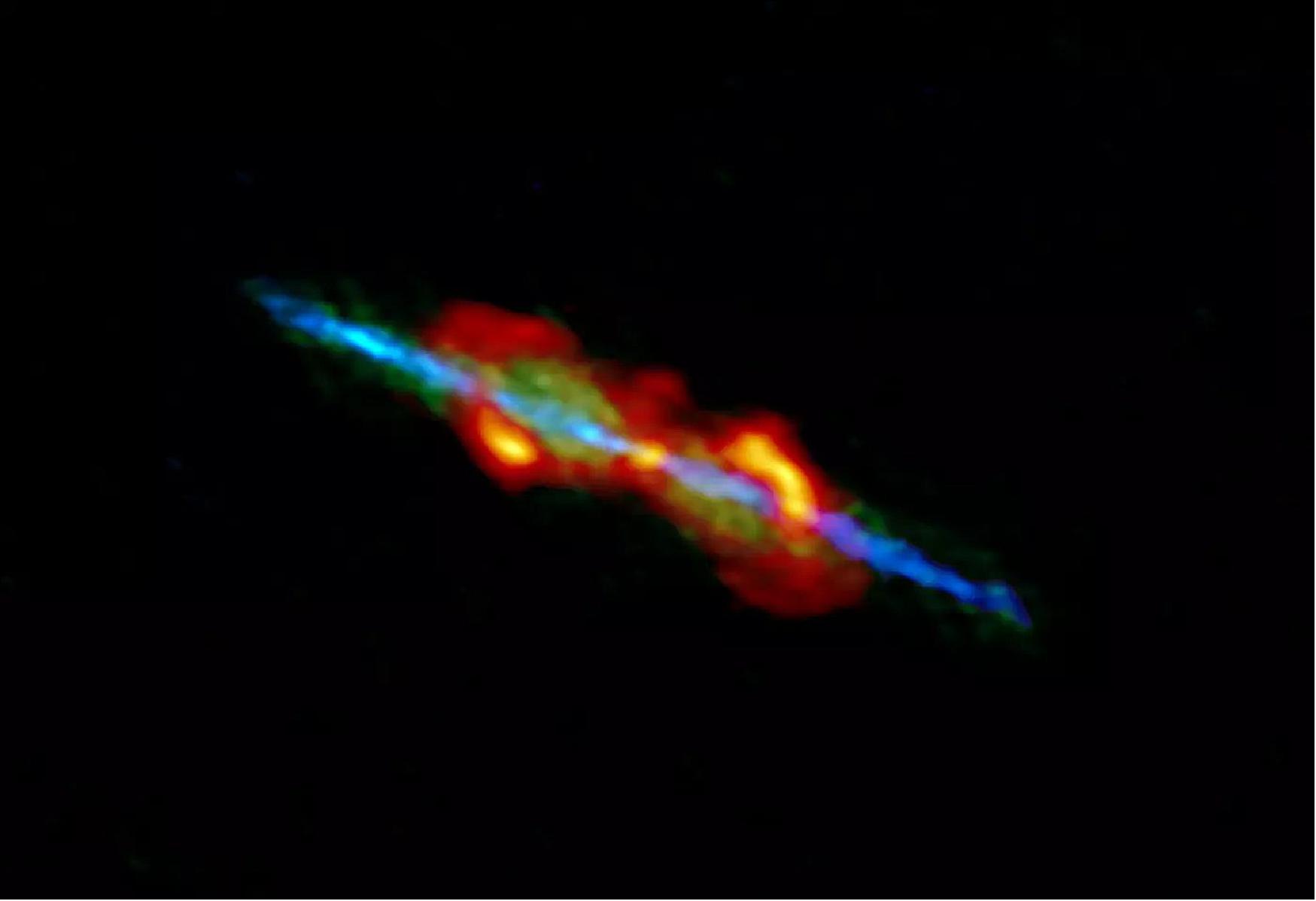
- “W43A is one of the peculiar so called ‘water fountain’ objects,” says Hiroshi Imai at Kagoshima University, Japan, a member of the team. “Some old stars show characteristic radio emissions from water molecules. We suppose that spots of these water emissions indicate the interface region between the jets and the surrounding material. We named them ‘water fountains,’ and it could be a sign that the central source is a binarity system launching a new jet.”
- “There are only 15 ‘water fountain’ objects identified to date, despite the fact that more than 100 billion stars are included in our Milky Way Galaxy,” explains José Francisco Gómez at Instituto de Astrofísica de Andalucía, Spain. “This is probably because the lifetime of the jets is quite short, so we are very lucky to see such rare objects.”
• February 20, 2020: An international team of astronomers used two of the most powerful radio telescopes in the world to create more than three hundred images of planet-forming disks around very young stars in the Orion Clouds. These images reveal new details about the birthplaces of planets and the earliest stages of star formation. 101)
- Most of the stars in the Universe are accompanied by planets. These planets are born in rings of dust and gas, called protoplanetary disks. Even very young stars are surrounded by these disks. Astronomers want to know exactly when these disks start to form, and what they look like. But young stars are very faint, and there are dense clouds of dust and gas surrounding them in stellar nurseries. Only highly sensitive radio telescope arrays can spot the tiny disks around these infant stars amidst the densely packed material in these clouds.
- For this new research, astronomers pointed both the Atacama Large Millimeter/submillimeter Array (ALMA) and the National Science Foundation’s Karl G. Jansky Very Large Array (VLA) to a region in space where many stars are born: the Orion Molecular Clouds. This survey, called VLA/ALMA Nascent Disk and Multiplicity (VANDAM), is the largest survey of young stars and their disks to date.
- Very young stars, also called protostars, form in clouds of gas and dust in space. The first step in the formation of a star is when these dense clouds collapse due to gravity. As the cloud collapses, it begins to spin – forming a flattened disk around the protostar. Material from the disk continues to feed the star and make it grow. Eventually, the left-over material in the disk is expected to form planets.
- Many aspects about these first stages of star formation, and how the disk forms, are still unclear. But this new survey provides some missing clues as the VLA and ALMA peered through the dense clouds and observed hundreds of protostars and their disks in various stages of their formation.
Young Planet-forming Disks
- “This survey revealed the average mass and size of these very young protoplanetary disks,” said John Tobin of the National Radio Astronomy Observatory (NRAO) in Charlottesville, Virginia, and leader of the survey team. “We can now compare them to older disks that have been studied intensively with ALMA as well.”
- What Tobin and his team found, is that very young disks can be similar in size, but are on average much more massive than older disks. “When a star grows, it eats away more and more material from the disk. This means that younger disks have a lot more raw material from which planets could form. Possibly bigger planets already start to form around very young stars.”
Four Special Protostars
- Among hundreds of survey images, four protostars looked different than the rest and caught the scientists’ attention. “These newborn stars looked very irregular and blobby,” said team member Nicole Karnath of the University of Toledo, Ohio (now at SOFIA Science Center). “We think that they are in one of the earliest stages of star formation and some may not even have formed into protostars yet.”
- It is special that the scientists found four of these objects. “We rarely find more than one such irregular object in one observation,” added Karnath, who used these four infant stars to propose a schematic pathway for the earliest stages of star formation. “We are not entirely sure how old they are, but they are probably younger than ten thousand years.”
- To be defined as a typical (class 0) protostar, stars should not only have a flattened rotating disk surrounding them, but also an outflow – spewing away material in opposite directions – that clears the dense cloud surrounding the stars and makes them optically visible. This outflow is important, because it prevents stars from spinning out of control while they grow. But when exactly these outflows start to happen, is an open question in astronomy.
- One of the infant stars in this study, called HOPS 404, has an outflow of only two kilometers (1.2 miles) per second (a typical protostar-outflow of 10-100 km/s or 6-62 miles/s). “It is a big puffy sun that is still gathering a lot of mass, but just started its outflow to lose angular momentum to be able to keep growing,” explained Karnath. “This is one of the smallest outflows that we have seen and it supports our theory of what the first step in forming a protostar looks like.”
Combining ALMA and VLA
- The exquisite resolution and sensitivity provided by both ALMA and the VLA were crucial to understand both the outer and inner regions of protostars and their disks in this survey. While ALMA can examine the dense dusty material around protostars in great detail, the images from the VLA made at longer wavelengths were essential to understand the inner structures of the youngest protostars at scales smaller than our solar system.
- “The combined use of ALMA and the VLA has given us the best of both worlds,” said Tobin. “Thanks to these telescopes, we start to understand how planet formation begins.”
- The National Radio Astronomy Observatory is a facility of the National Science Foundation, operated under cooperative agreement by Associated Universities, Inc.
More Information
- This research was presented in two papers:
a) ”The VLA/ALMA Nascent Disk and Multiplicity (VANDAM) Survey of Orion Protostars. A Statistical Characterization of Class 0 and I Protostellar Disks,” by J. Tobin et al., The Astrophysical Journal, Volume 890, No 2, Published: 20 February 2020, URL: https://doi.org/10.3847/1538-4357/ab6f64
b) “Detection of Irregular, Sub-mm Opaque Structures in the Orion Molecular Clouds: Protostars within 10000 years of formation?,” by N. Karnath et al., The Astrophysical Journal, Volume 890, No 2, Published: 20 February 2020, https://doi.org/10.3847/1538-4357/ab659e
- The original press release was published by the National Radio Astronomy Observatory (NRAO), an ALMA partner on behalf of North America.
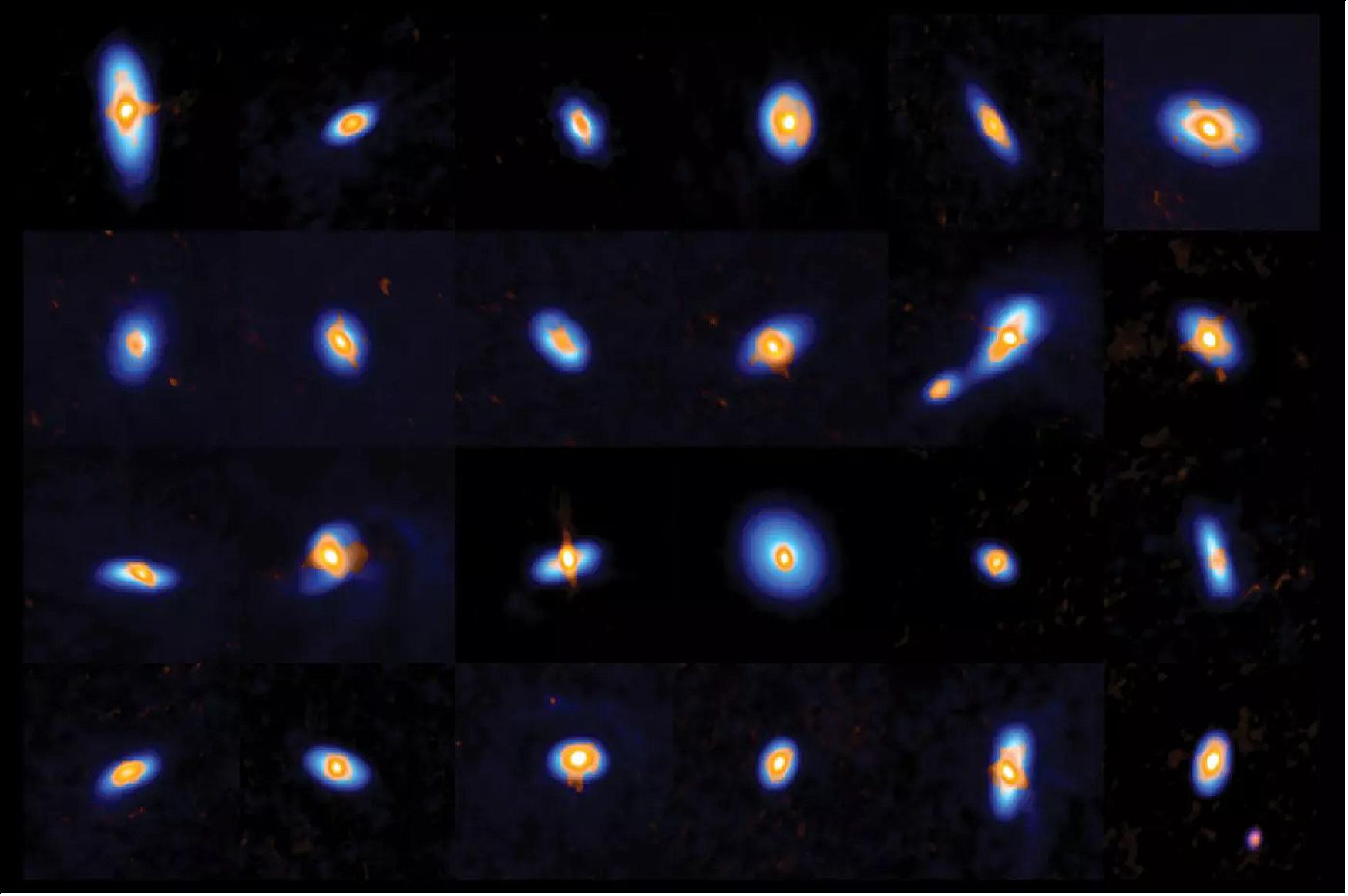
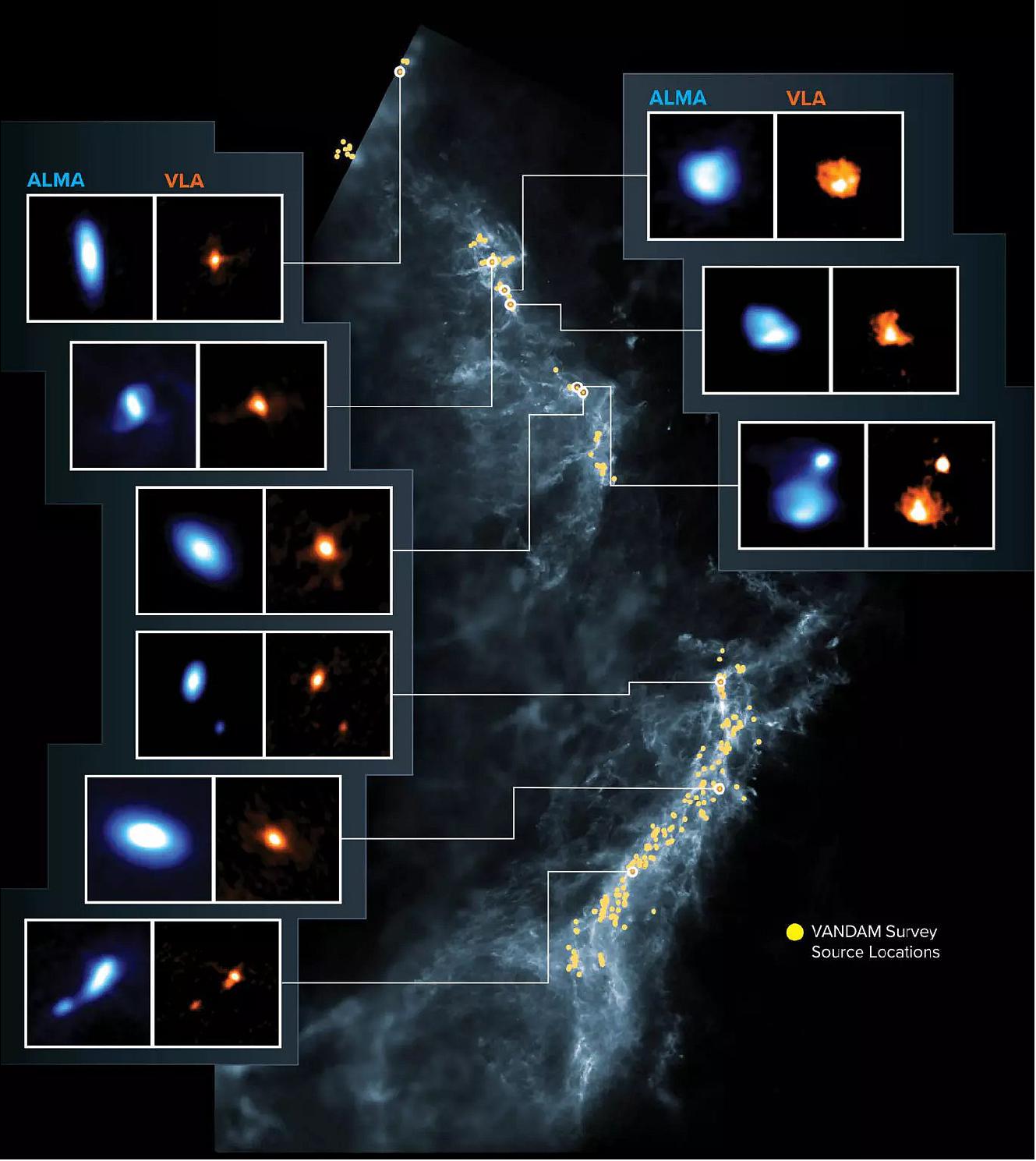
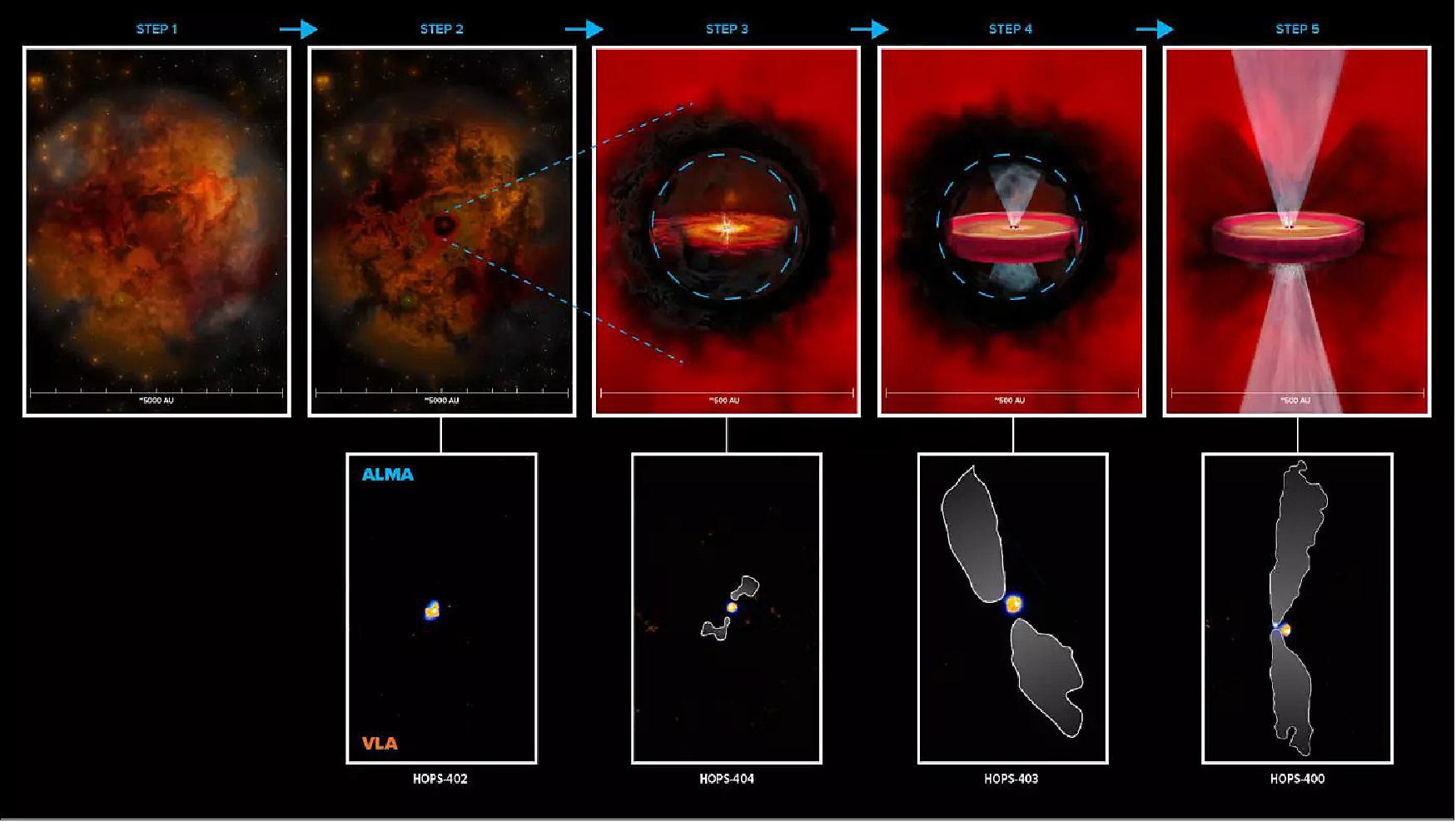
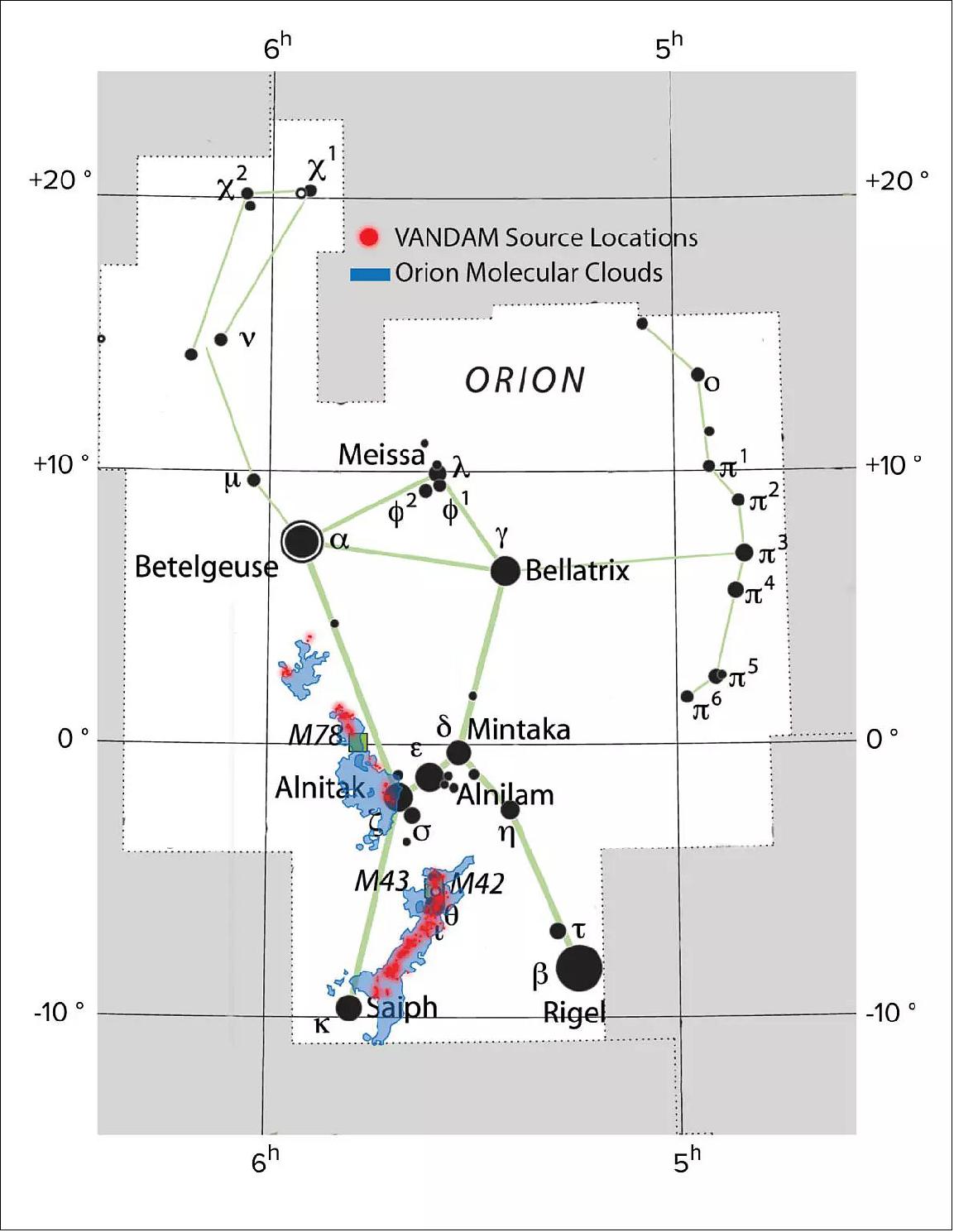
• February 5, 2020: Like humans, stars change with age and ultimately die. For the Sun and stars like it, this change will take it through a phase where, having burned all the hydrogen in its core, it swells up into a large and bright red-giant star. Eventually, the dying Sun will lose its outer layers, leaving behind its core: a hot and dense star called a white dwarf. 102)
- “The star system HD101584 is special in the sense that this ‘death process’ was terminated prematurely and dramatically as a nearby low-mass companion star was engulfed by the giant,” said Hans Olofsson of the Chalmers University of Technology, Sweden, who led a recent study, published in Astronomy & Astrophysics, of this intriguing object. 103)
- Thanks to new observations with ALMA, complemented by data from the ESO-operated Atacama Pathfinder EXperiment (APEX), Olofsson and his team now know that what happened in the double-star system HD101584 was akin to a stellar fight. As the main star puffed up into a red giant, it grew large enough to swallow its lower-mass partner. In response, the smaller star spiralled in towards the giant’s core but didn’t collide with it. Rather, this maneuver triggered the larger star into an outburst, leaving its gas layers dramatically scattered and its core exposed.
- The team says the complex structure of the gas in the HD101584 nebula is due to the smaller star’s spiralling towards the red giant, as well as to the jets of gas that formed in this process. As a deadly blow to the already defeated gas layers, these jets blasted through the previously ejected material, forming the rings of gas and the bright bluish and reddish blobs seen in the nebula.
- A silver lining of a stellar fight is that it helps astronomers to better understand the final evolution of stars like the Sun. “Currently, we can describe the death processes common to many Sun-like stars, but we cannot explain why or exactly how they happen. HD101584 gives us important clues to solve this puzzle since it is currently in a short transitional phase between better studied evolutionary stages. With detailed images of the environment of HD101584 we can make the connection between the giant star it was before, and the stellar remnant it will soon become,” says co-author Sofia Ramstedt from Uppsala University, Sweden.
- Co-author Elizabeth Humphreys from ESO in Chile highlighted that ALMA and APEX, located in the country’s Atacama region, were crucial to enabling the team to probe “both the physics and chemistry in action” in the gas cloud. She added: “This stunning image of the circumstellar environment of HD101584 would not have been possible without the exquisite sensitivity and angular resolution provided by ALMA.”
- While current telescopes allow astronomers to study the gas around the binary, the two stars at the center of the complex nebula are too close together and too far away to be resolved. ESO’s Extremely Large Telescope, under construction in Chile’s Atacama Desert, “will provide information on the ‘heart’ of the object,” says Olofsson, allowing astronomers a closer look at the fighting pair.
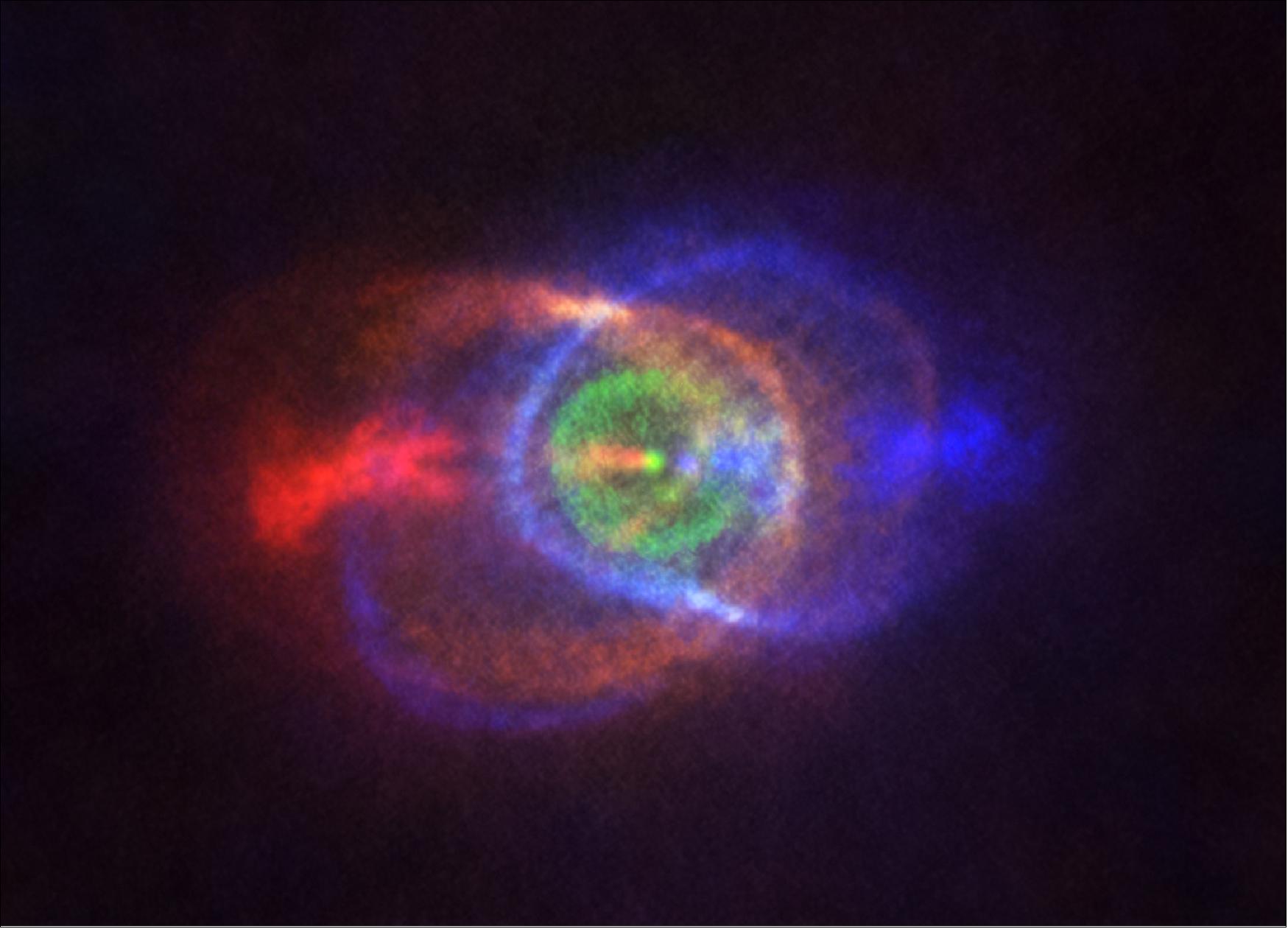
• January 21, 2020: Phosphorus, present in our DNA and cell membranes, is an essential element for life as we know it. But how it arrived on the early Earth is something of a mystery. Astronomers have now traced the journey of phosphorus from star-forming regions to comets using the combined powers of ALMA and the European Space Agency’s probe Rosetta. Their research shows, for the first time, where molecules containing phosphorus form, how this element is carried in comets, and how a particular molecule may have played a crucial role in starting life on our planet. 104)
- “Life appeared on Earth about 4 billion years ago, but we still do not know the processes that made it possible,” says Víctor Rivilla, the lead author of a new study published today in the journal Monthly Notices of the Royal Astronomical Society. The new results from the Atacama Large Millimeter/Submillimeter Array(ALMA), in which the European Southern Observatory (ESO) is a partner, and from the ROSINA instrument on board Rosetta, show that phosphorus monoxide is a key piece in the origin-of-life puzzle. 105)
- With the power of ALMA, which allowed a detailed look into the star-forming region AFGL 5142, astronomers could pinpoint where phosphorus-bearing molecules, like phosphorus monoxide, form. New stars and planetary systems arise in cloud-like regions of gas and dust in between stars, making these interstellar clouds the ideal places to start the search for life’s building blocks.
- The ALMA observations showed that phosphorus-bearing molecules are created as massive stars are formed. Flows of gas from young massive stars open up cavities in interstellar clouds. Molecules containing phosphorus form on the cavity walls, through the combined action of shocks and radiation from the infant star. The astronomers have also shown that phosphorus monoxide is the most abundant phosphorus-bearing molecule in the cavity walls.
- After searching for this molecule in star-forming regions with ALMA, the European team moved on to a Solar System object: the now-famous comet 67P/Churyumov–Gerasimenko. The idea was to follow the trail of these phosphorus-bearing compounds. If the cavity walls collapse to form a star, particularly a less-massive one like the Sun, phosphorus monoxide can freeze out and get trapped in the icy dust grains that remain around the new star. Even before the star is fully formed, those dust grains come together to form pebbles, rocks and ultimately comets, which become transporters of phosphorus monoxide.
- ROSINA, which stands for Rosetta Orbiter Spectrometer for Ion and Neutral Analysis, collected data from 67P for two years as Rosetta orbited the comet. Astronomers had found hints of phosphorus in the ROSINA data before, but they did not know what molecule had carried it there. Kathrin Altwegg, the Principal Investigator for Rosina and an author in the new study, got a clue about what this molecule could be after being approached at a conference by an astronomer studying star-forming regions with ALMA: “She said that phosphorus monoxide would be a very likely candidate, so I went back to our data and there it was!”
- This first sighting of phosphorus monoxide on a comet helps astronomers draw a connection between star-forming regions, where the molecule is created, all the way to Earth.
- “The combination of the ALMA and ROSINA data has revealed a sort of chemical thread during the whole process of star formation, in which phosphorus monoxide plays the dominant role,” says Rivilla, who is a researcher at the Arcetri Astrophysical Observatory of INAF, Italy’s National Institute for Astrophysics.
- “Phosphorus is essential for life as we know it,” adds Altwegg. “As comets most probably delivered large amounts of organic compounds to the Earth, the phosphorus monoxide found in comet 67P may strengthen the link between comets and life on Earth.”
- This intriguing journey could be documented because of the collaborative efforts between astronomers. “The detection of phosphorus monoxide was clearly thanks to an interdisciplinary exchange between telescopes on Earth and instruments in space,” says Altwegg.
- Leonardo Testi, ESO astronomer and ALMA European Operations Manager, concludes: “Understanding our cosmic origins, including how common the chemical conditions favorable for the emergence of life are, is a major topic of modern astrophysics. While ESO and ALMA focus on the observations of molecules in distant young planetary systems, the direct exploration of the chemical inventory within our Solar System is made possible by ESA missions, like Rosetta. The synergy between world leading ground-based and space facilities, through the collaboration between ESO and ESA, is a powerful asset for European researchers and enables transformational discoveries like the one reported in this paper.”
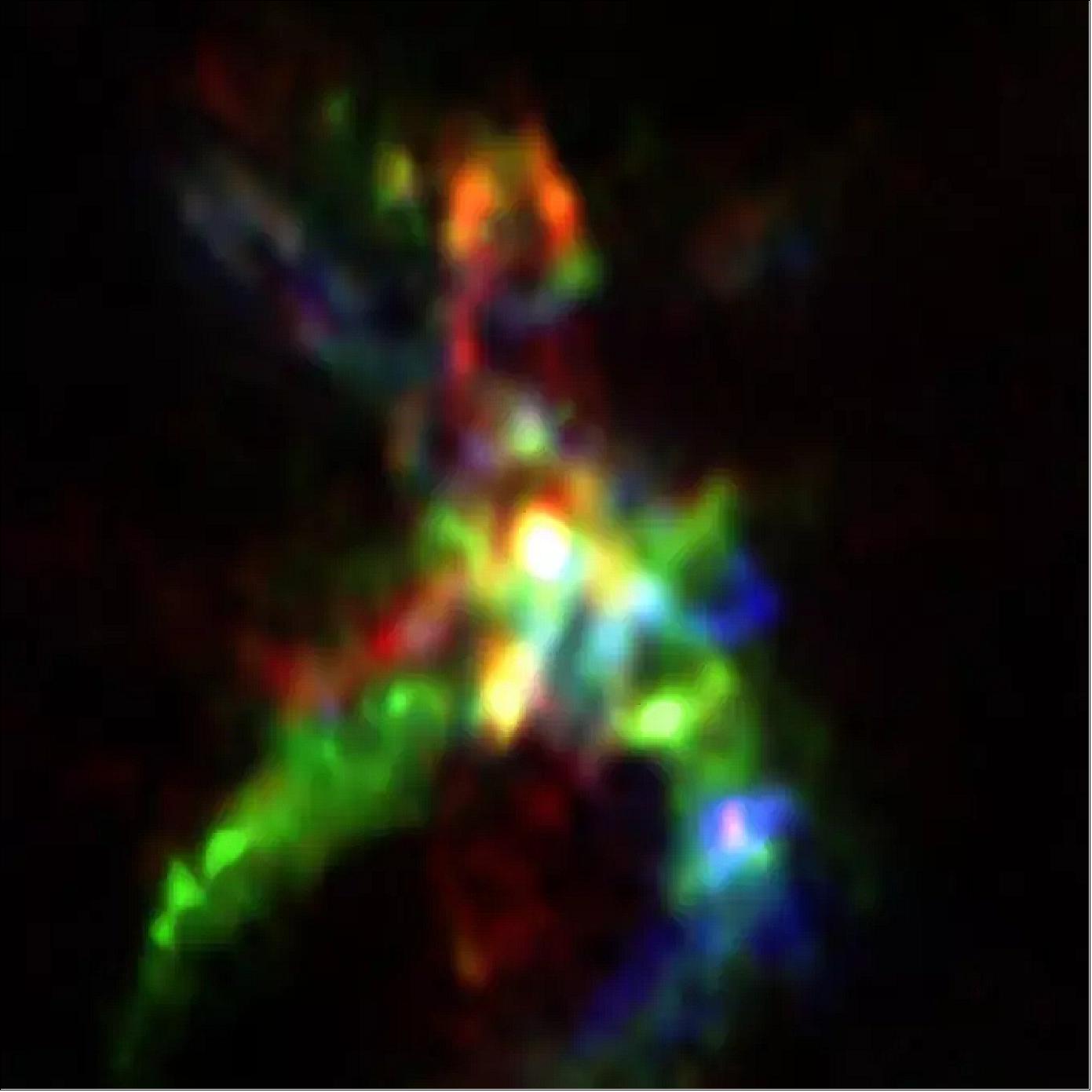
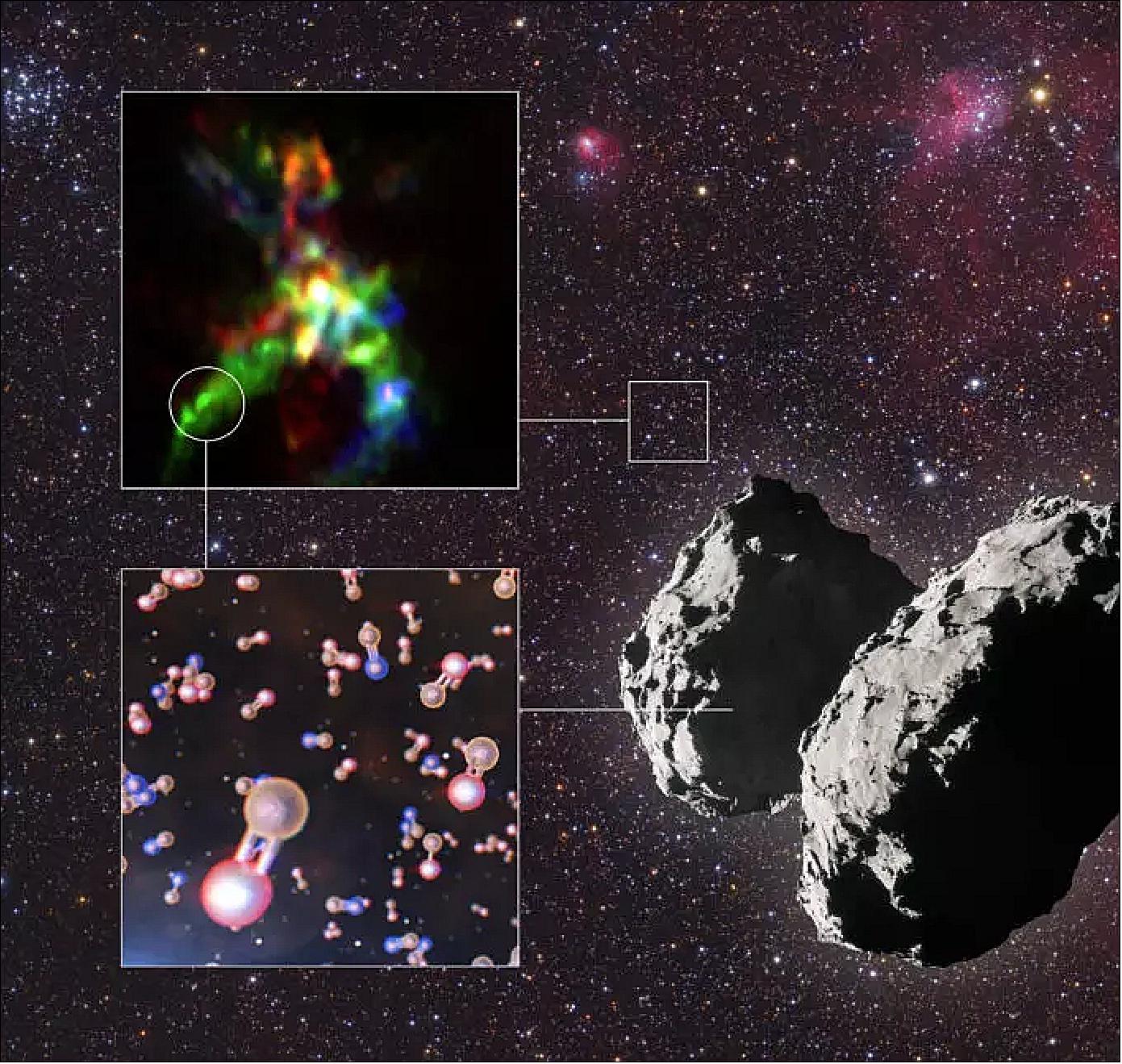
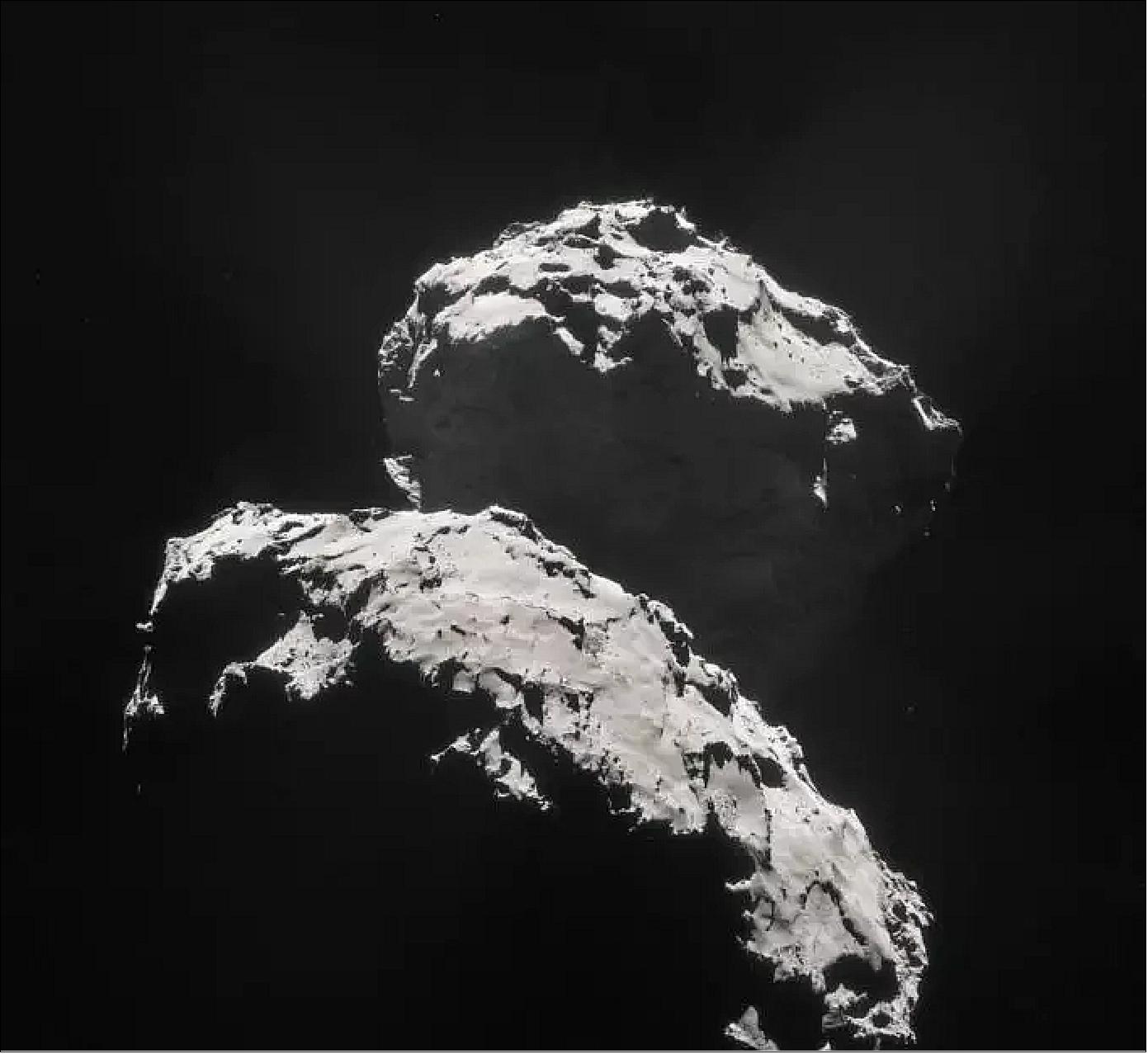
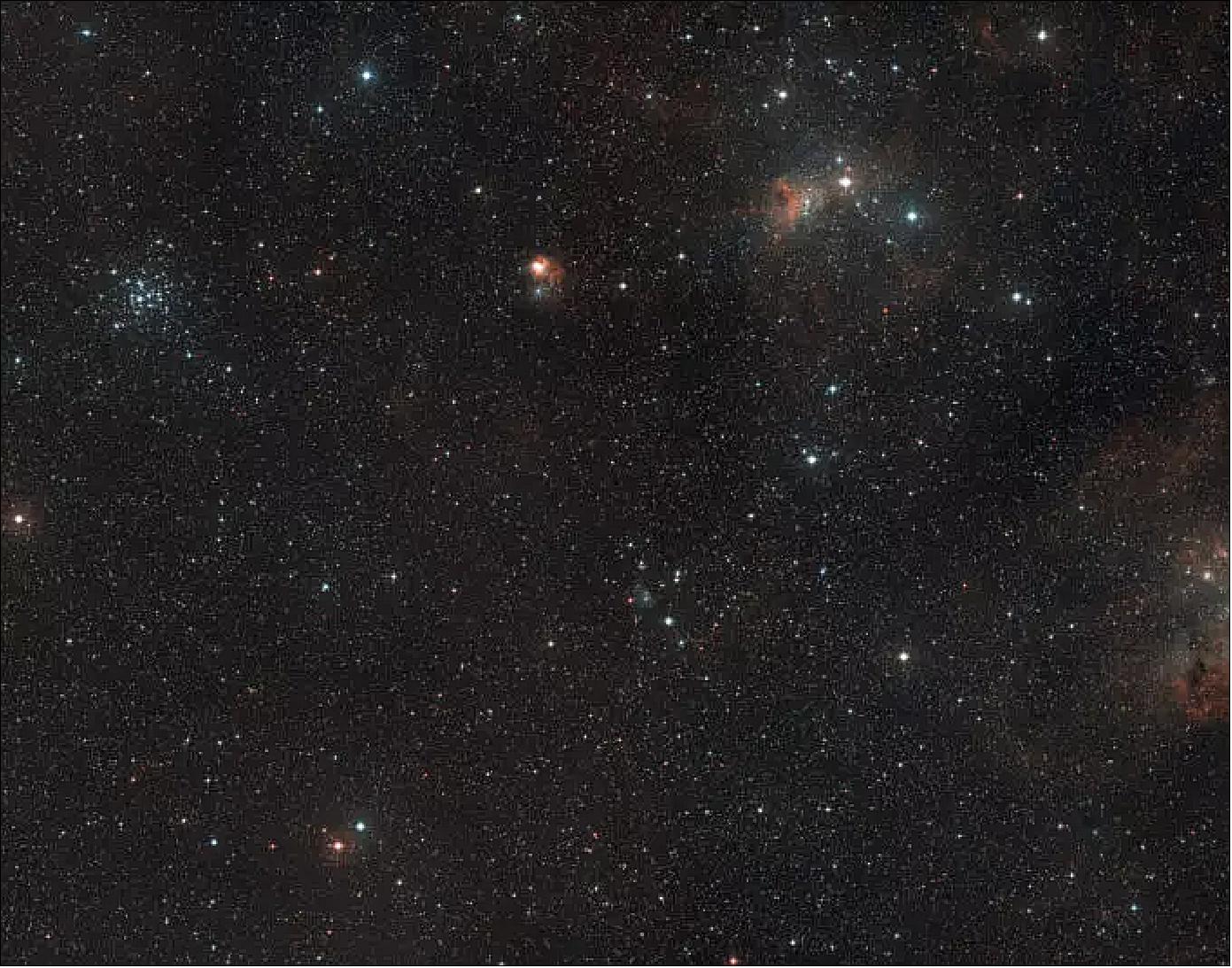
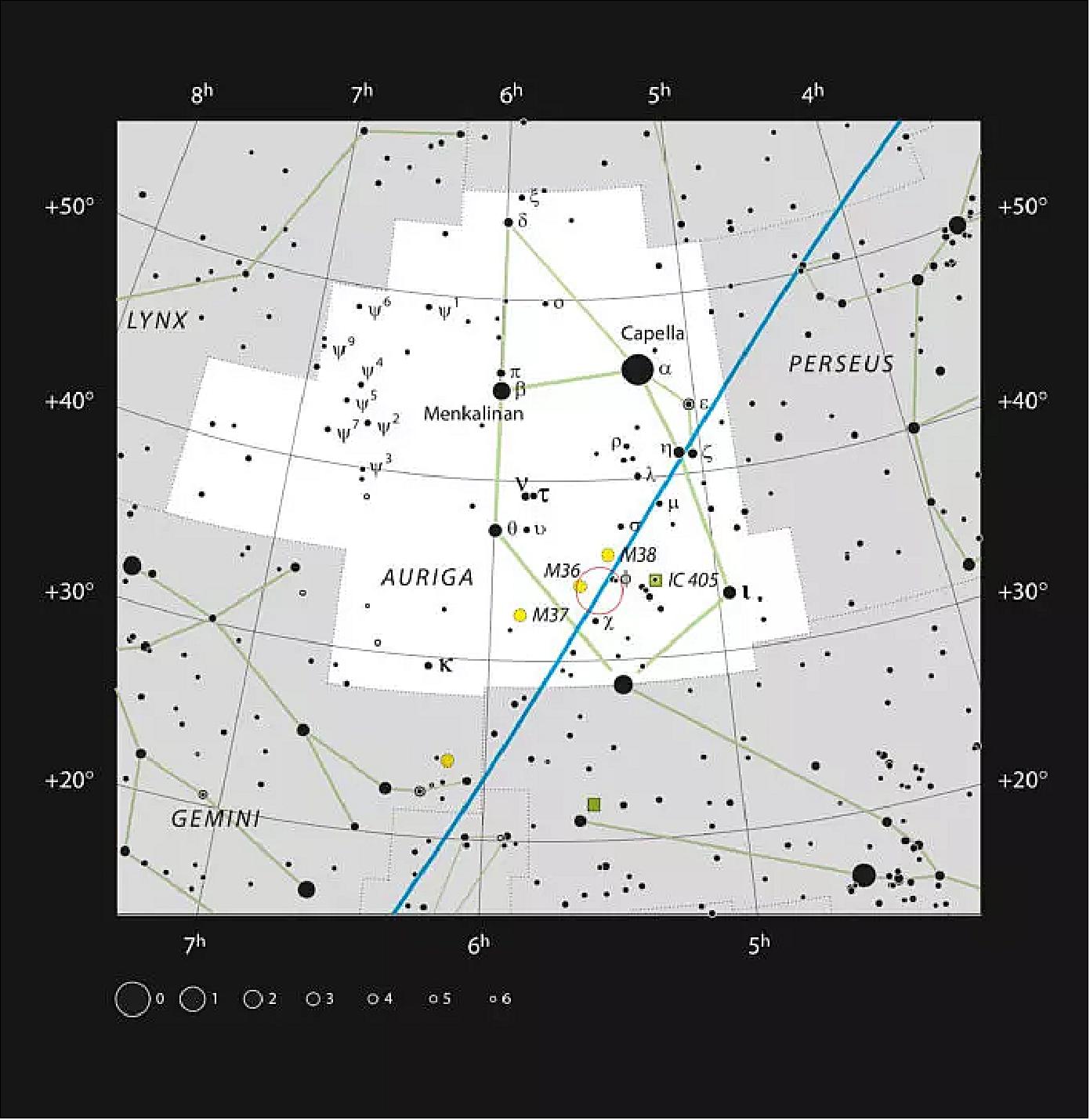
• December 11, 2019: Astronomers using ALMA (Atacama Large Millimeter/submillimeter Array), have spotted the light of a massive galaxy seen only 970 million years after the Big Bang. This galaxy, called MAMBO-9, is the most distant dusty star-forming galaxy that has ever been observed without the help of a gravitational lens. 106)
- Dusty star-forming galaxies are the most intense stellar nurseries in the universe. They form stars at a rate up to a few thousand times the mass of the Sun per year (the star-forming rate of our Milky Way is just three solar masses per year) and they contain massive amounts of gas and dust. Such monster galaxies are not expected to have formed early in the history of the universe, but astronomers have already discovered several of them as seen when the cosmos was less than a billion years old. One of them is galaxy SPT0311-58, which ALMA observed in 2018.
- Because of their extreme behavior, astronomers think that these dusty galaxies play an important role in the evolution of the universe. But finding them is easier said than done. “These galaxies tend to hide in plain sight,” said Caitlin Casey of the University of Texas at Austin and lead author of a study published in The Astrophysical Journal. “We know they are out there, but they are not easy to find because their starlight is hidden in clouds of dust.” 107)
- MAMBO-9’s light was already detected ten years ago by co-author Manuel Aravena, using the Max-Planck Millimeter BOlometer (MAMBO) instrument on the IRAM 30-meter telescope in Spain and the Plateau de Bure Interferometer in France. But these observations were not sensitive enough to reveal the distance of the galaxy. “We were in doubt if it was real, because we couldn’t find it with other telescopes. But if it was real, it had to be very far away,” says Aravena, who was at that time a PhD student in Germany and is currently working for the Universidad Diego Portales in Chile.
- Thanks to ALMA’s sensitivity, Casey and her team have now been able to determine the distance of MAMBO-9. “We found the galaxy in a new ALMA survey specifically designed to identify dusty star-forming galaxies in the early universe,” said Casey. “And what is special about this observation, is that this is the most distant dusty galaxy we have ever seen in an unobstructed way.”
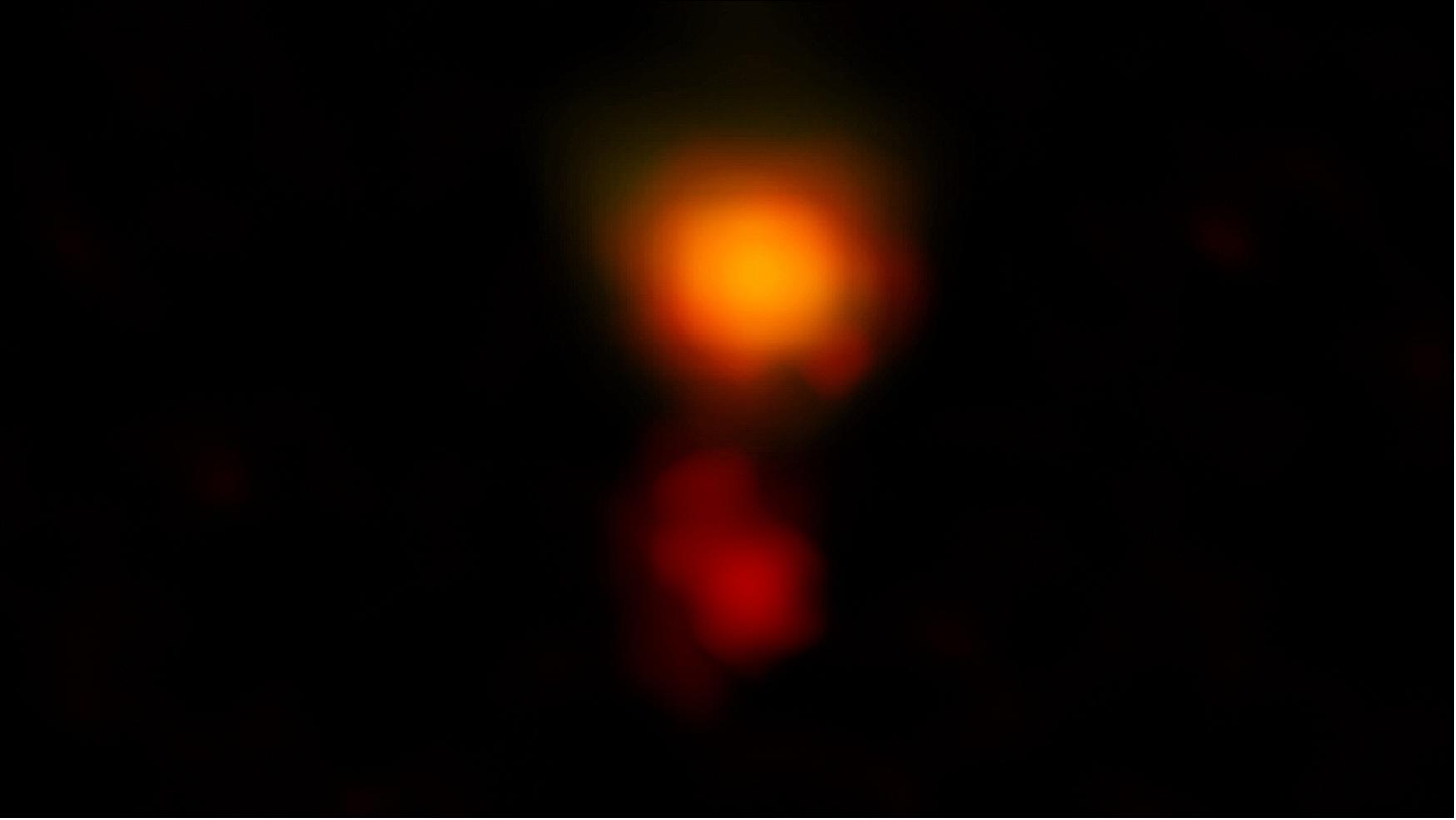
- The light of distant galaxies is often obstructed by other galaxies closer to us. These galaxies in front work as a gravitational lens: they bend the light from the more distant galaxy. This lensing effect makes it easier for telescopes to spot distant objects (this is how ALMA could see galaxy SPT0311-58). But it also distorts the image of the object, making it harder to make out the details.
- In this study, the astronomers saw MAMBO-9 directly, without a lens, and this allowed them to measure its mass. “The total mass of gas and dust in the galaxy is enormous: ten times more than all the stars in the Milky Way. This means that it has yet to build most of its stars,” Casey explained. The galaxy consists of two parts, and it is in the process of merging.
- Casey hopes to find more distant dusty galaxies in the ALMA survey, which will give insight into how common they are, how these massive galaxies formed so early in the universe, and why they are so dusty. “Dust is normally a by-product of dying stars,” she said. “We expect one hundred times more stars than dust. But MAMBO-9 has not produced that many stars yet and we want to find out how dust can form so fast after the Big Bang.”
- “Observations with new and more capable technology can produce unexpected findings like MAMBO-9,” said Joe Pesce, National Science Foundation Program Officer for NRAO and ALMA. “While it is challenging to explain such a massive galaxy so early in the history of the universe, discoveries like this allow astronomers to develop an improved understanding of, and ask ever more questions about, the universe.”
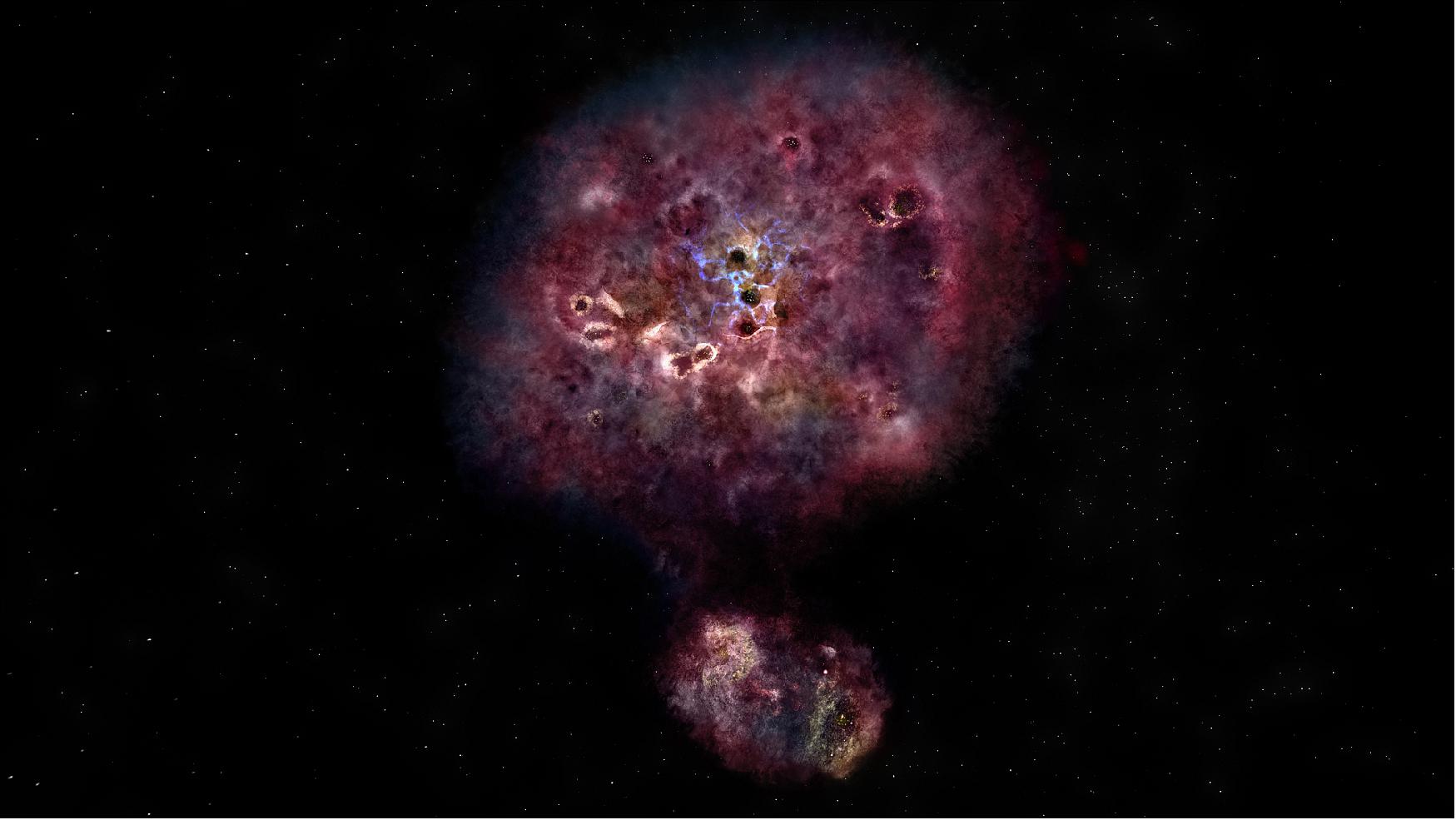
- The light from MAMBO-9 travelled about 13 billion years to reach ALMA’s antennas (the universe is approximately 13.8 billion years old today). That means that we can see what the galaxy looked like in the past (Watch this video to learn how ALMA works as a time-machine). Today, the galaxy would probably be even bigger, containing one hundred times more stars than the Milky Way, residing in a massive galaxy cluster.
- The National Radio Astronomy Observatory is a facility of the National Science Foundation (NSF), operated under cooperative agreement by Associated Universities, Inc.
• November 14, 2019: Two peacock-shaped gas clouds were revealed in the Large Magellanic Cloud (LMC) by observations with ALMA. A team of astronomers found several massive baby stars in the complex filamentary clouds, which agrees well with computer simulations of giant collisions of gas clouds. The researchers interpret this to mean that the filaments and young stars are telltale evidence of violent interactions between the LMC and the SMC (Small Magellanic Cloud) 200 million years ago. 108) 109)
- Astronomers know that stars are formed in collapsing clouds in space. However, the formation processes of giant stars, 10 times or more massive than the Sun, are not well understood because it is difficult to pack such a large amount of material into a small region. Some researchers suggest that interactions between galaxies provide a perfect environment for massive star formation. Due to the colossal gravity, clouds in the galaxies are stirred, stretched, and often collide with each other. A huge amount of gas is compressed in an unusually small area, which could form the seeds of massive stars.
- A research team used ALMA to study the structure of dense gas in N159, a bustling star formation region in the LMC. Thanks to ALMA’s high resolution, the team obtained a very detailed map of the clouds in two sub-regions, N159E-Papillon Nebula and N159W South.
- Interestingly, the cloud structures in the two regions look very similar: fan-shaped filaments of gas extending to the north with the pivots in the southernmost points. The ALMA observations also found several massive baby stars in the filaments in the two regions.
- “It is unnatural that in two regions separated by 150 light-years, clouds with such similar shapes were formed and that the ages of the baby stars are similar in two regions separated 150 light years,” says Kazuki Tokuda, a researcher at Osaka Prefecture University and the National Astronomical Observatory of Japan. “There must be a common cause of these features. Interaction between the LMC and SMC is a good candidate.”
- In 2017, Yasuo Fukui, a professor at Nagoya University and his team revealed the motion of hydrogen gas in the LMC and found that a gaseous component right next to N159 has a different velocity than the rest of the clouds. They suggested a hypothesis that the starburst is caused by a massive flow of gas from the SMC to the LMC, and that this flow originated from a close encounter between the two galaxies 200 million years ago.
- The pair of the peacock-shaped clouds in the two regions revealed by ALMA fits nicely with this hypothesis. Computer simulations show that many filamentary structures are formed in a short time scale after a collision of two clouds, which also backs this idea.
- “For the first time, we uncovered the link between massive star formation and galaxy interactions in very sharp detail,” says Fukui, the lead author of one of the research papers. “This is an important step in understanding the formation process of massive star clusters in which galaxy interactions have a big impact.”
![Figure 80: ALMA images of two molecular clouds N159E-Papillon Nebula (left) and N159W South (right). Red and green show the distribution of molecular gas in different velocities seen in the emission from 13CO. The blue region in N159E-Papillon Nebula shows the ionized hydrogen gas observed with the Hubble Space Telescope. The blue part in N159W South shows the emission from dust particles obtained with ALMA [image credit: ALMA (ESO/NAOJ/NRAO)/Fukui et al./Tokuda et al./NASA-ESA Hubble Space Telescope]](https://www.eoportal.org/ftp/satellite-missions/a/Alma_300622/Alma_Auto1D.jpeg)
• October 15, 2019: At the center of a galaxy called NGC 1068, a supermassive black hole hides within a thick doughnut-shaped cloud of dust and gas. When astronomers used ALMA ( Atacama Large Millimeter/submillimeter Array) to study this cloud in more detail, they made an unexpected discovery that could explain why supermassive black holes grew so rapidly in the early Universe. 110)
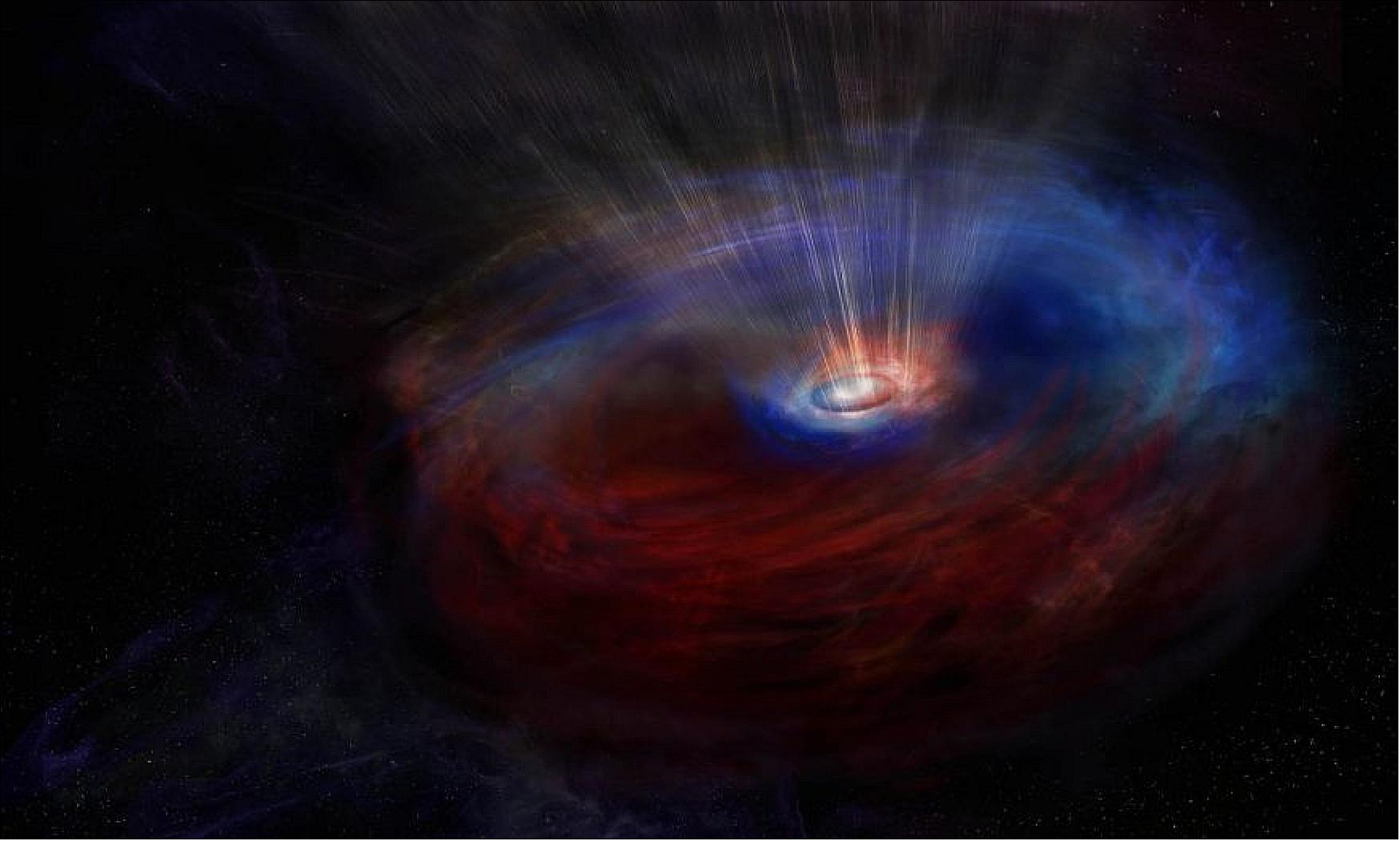
- “Thanks to the spectacular resolution of ALMA, we measured the movement of gas in the inner orbits around the black hole,” explains Violette Impellizzeri of the National Radio Astronomy Observatory (NRAO), working at ALMA in Chile and lead author on a paper published in the Astrophysical Journal. “Surprisingly, we found two disks of gas rotating in opposite directions.” 111)
- Supermassive black holes already existed when the Universe was young, just a billion years after the Big Bang. But how these extreme objects, whose masses are up to billions of times the mass of the Sun, had time to grow so fast, is an outstanding question among astronomers. This new ALMA discovery could provide a clue. “Counter-rotating gas streams are unstable, which means that clouds fall into the black hole faster than they do in a disk with a single rotation direction,” said Impellizzeri. “This could be a way in which a black hole can grow rapidly.”
- NGC 1068 (also known as Messier 77) is a spiral galaxy approximately 47 million light-years from Earth in the direction of the constellation Cetus. At its center is an active galactic nucleus, a supermassive black hole that is actively feeding itself from a thin, rotating disk of gas and dust, also known as an accretion disk.
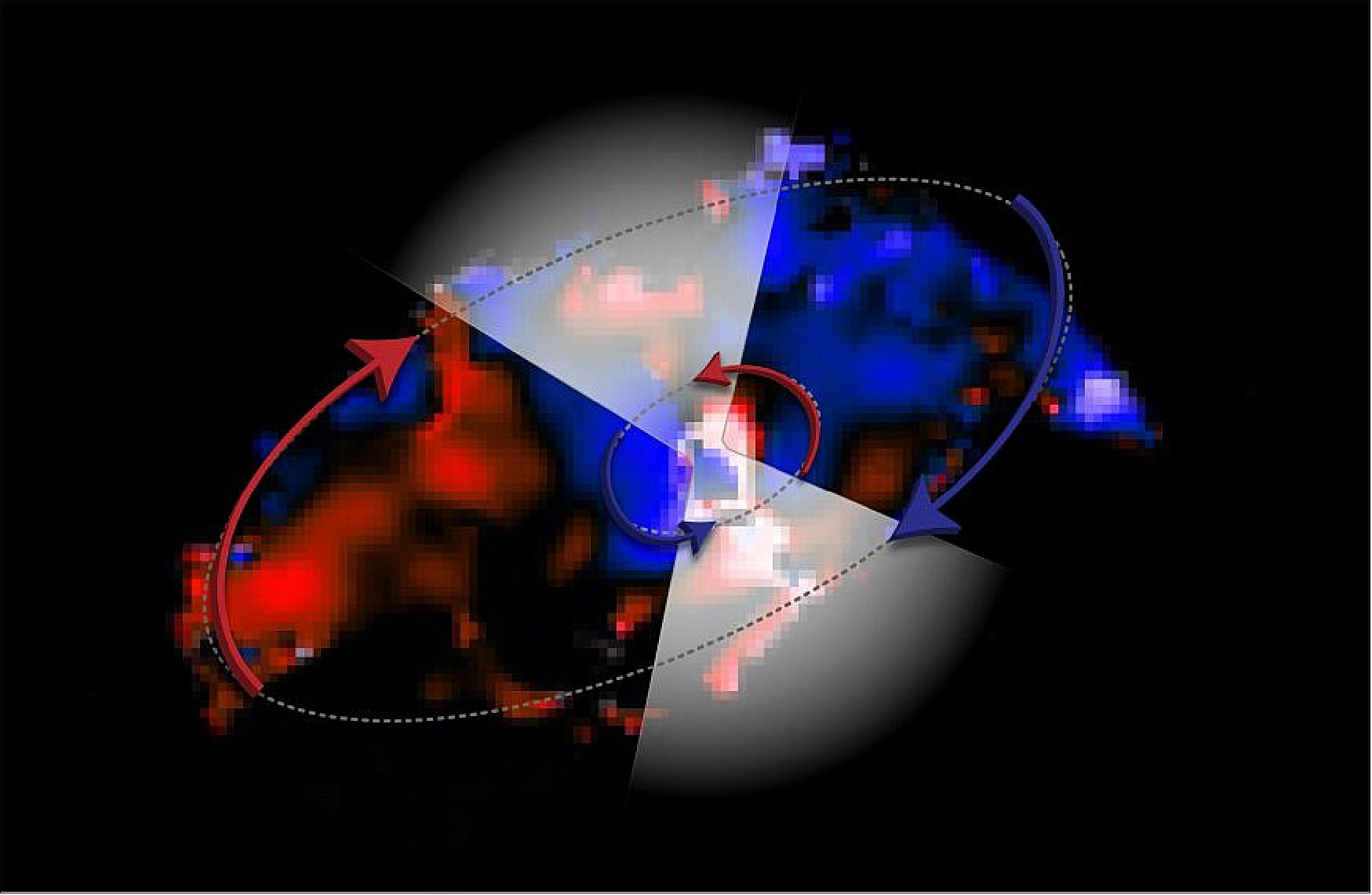
- Previous ALMA observations revealed that the black hole is gulping down material and spewing out gas at incredibly high speeds. This gas that gets expelled from the accretion disk likely contributes to hiding the region around the black hole from optical telescopes.
- Impellizzeri and her team used ALMA’s superior zoom lens ability to observe the molecular gas around the black hole. Unexpectedly, they found two counter-rotating disks of gas. The inner disk spans 2-4 light-years and follows the rotation of the galaxy, whereas the outer disk (also known as the torus) spans 4-22 light-years and is rotating the opposite way.
- “We did not expect to see this, because gas falling into a black hole would normally spin around it in only one direction,” said Impellizzeri. “Something must have disturbed the flow because it is impossible for a part of the disk to start rotating backward all on its own.”
- Counter-rotation is not an unusual phenomenon in space. “We see it in galaxies, usually thousands of light-years away from their galactic centers,” explained co-author Jack Gallimore from Bucknell University in Lewisburg, Pennsylvania. “The counter-rotation always results from the collision or interaction between two galaxies. What makes this result remarkable is that we see it on a much smaller scale, tens of light-years instead of thousands from the central black hole.”
- The astronomers think that the backward flow in NGC 1068 might be caused by gas clouds that fell out of the host galaxy, or by a small passing galaxy on a counter-rotating orbit captured in the disk.
- At the moment, the outer disk appears to be in a stable orbit around the inner disk. “That will change when the outer disk begins to fall onto the inner disk, which may happen after a few orbits or a few hundred thousand years. The rotating streams of gas will collide and become unstable, and the disks will likely collapse in a luminous event as the molecular gas falls into the black hole. Unfortunately, we will not be there to witness the fireworks,” said Gallimore.
• October 4, 2019: The two baby stars were found in the [BHB2007] 11 system – the youngest member of a small stellar cluster in the Barnard 59 dark nebula, which is part of the clouds of interstellar dust called the Pipe nebula. Previous observations of this binary system showed the outer structure. Now, thanks to the high resolution of the ALMA (Atacama Large Millimeter/submillimeter Array) and an international team of astronomers led by scientists from the Max Planck Institute for Extraterrestrial Physics (MPE) in Garching, Germany, we can see the inner structure of this object. 112)
- “We see two compact sources that we interpret as circumstellar disks around the two young stars,” explains Felipe Alves from MPE who led the study. A circumstellar disk is the ring of dust and gas that surrounds a young star. The star accrete matter from the ring to grow bigger. “The size of each of these disks is similar to the asteroid belt in our Solar System and the separation between them is 28 times the distance between the Sun and the Earth,” notes Alves.
- The two circumstellar disks are surrounded by a bigger disk with a total mass of about 80 Jupiter masses, which displays a complex network of dust structures distributed in spiral shapes – the pretzel loops. “This is a really important result,” stresses Paola Caselli, managing director at MPE, head of the Centre of Astrochemical Studies and co-author of the study. “We have finally imaged the complex structure of young binary stars with their feeding filaments connecting them to the disk in which they were born. This provides important constraints for current models of star formation.”
- The baby stars accrete mass from the bigger disk in two stages. The first stage is when mass is transferred to the individual circumstellar disks in beautiful twirling loops, which is what the new ALMA image showed. The data analysis also revealed that the less-massive but brighter circumstellar disk — the one in the lower part of the image — accretes more material. In the second stage, the stars accrete mass from their circumstellar disks. “We expect this two-level accretion process to drive the dynamics of the binary system during its mass accretion phase,” adds Alves. “While the good agreement of these observations with theory is already very promising, we will need to study more young binary systems in detail to better understand how multiple stars form.”
- This research was presented in a paper published on 3 October 2019 in the journal Science. 113)
- The team is composed of F. O. Alves (Center for Astrochemical Studies, Max Planck Institute for Extraterrestrial Physics, Garching, Germany), P. Caselli (Center for Astrochemical Studies, Max Planck Institute for Extraterrestrial Physics, Germany), J. M. Girart (Institut de Ciències de l’Espai, Consejo Superior de Investigaciones Científicas, Spain and Institut d’Estudis Espacials de Catalunya, Spain), D. Segura-Cox (Center for Astrochemical Studies, Max Planck Institute for Extraterrestrial Physics, Garching, Germany), G. A. P. Franco (Departamento de Física, Instituto de Ciências Exatas, Universidade Federal de Minas Gerais, Brazil), A. Schmiedeke (Center for Astrochemical Studies, Max Planck Institute for Extraterrestrial Physics, Garching, Germany) and B. Zhao (Center for Astrochemical Studies, Max Planck Institute for Extraterrestrial Physics, Garching, Germany).
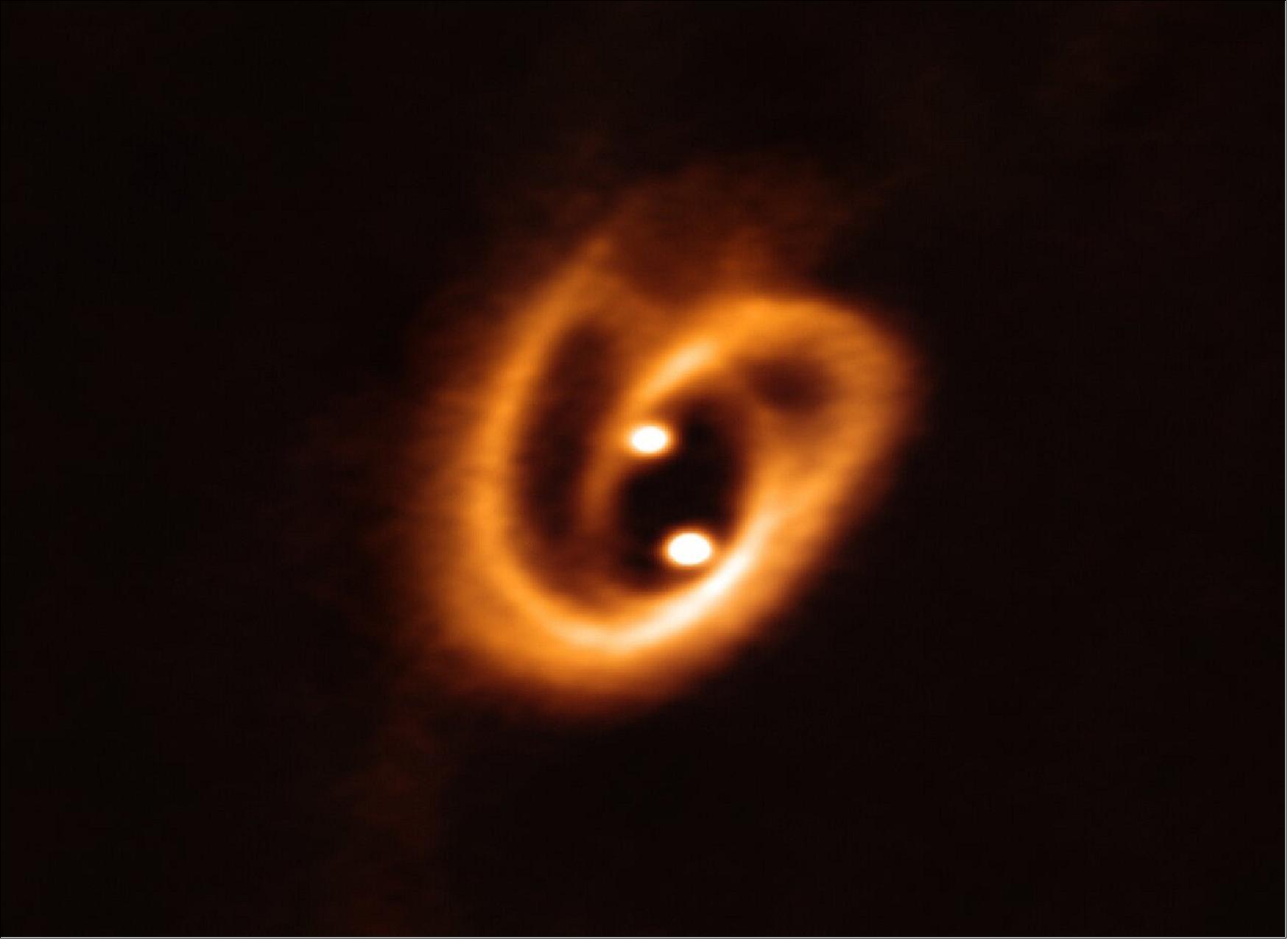
• September 30, 2019: Using the detailed eyes of the ALMA (Atacama Large Millimeter/submillimeter Array) and ESO’s VLT (Very Large Telescope), astronomers have mapped the intense tails of a cosmic jellyfish: a number of knotty streams of gas spewing outwards from a spiral galaxy named ESO 137-001. 114)
![Figure 84: This celestial cnidarian is shown here in beautiful detail. The various elements making up this image were captured by different telescopes. The galaxy and its surroundings were imaged by the NASA/ESA Hubble Space Telescope; its tails, which trace streams of hydrogen and show up in hues of bright purple, by the MUSE instrument mounted on the VLT; and bright hotspots of carbon dioxide emission from within the system, which show up as flares of orange-red, were spotted by ALMA [image credit: ALMA (ESO/NAOJ/NRAO), P. Jachym (Czech Academy of Sciences) et al.]](https://www.eoportal.org/ftp/satellite-missions/a/Alma_300622/Alma_Auto19.jpeg)
- These tails are caused by a dramatic phenomenon known as ram-pressure stripping. The space between galaxies in a cluster is not empty, but full of material that acts like a viscous fluid. As a galaxy travels through this resistant environment, gas is stripped out of the galaxy to form a wake that creates beautiful, intricate systems such as that seen here around ESO 137-001 (which resides in the Norma galaxy cluster). The direction and position of the tail shed light on the way in which the galaxy is moving — with galaxies usually falling towards the center of the cluster itself.
- This image offers the first high-resolution map of the cold molecular gas lurking within a ram-pressure stripped system. ESO 137-001 is one of the nearest jellyfish galaxies to Earth, and is particularly interesting because its long, extended tails of gas contain features known as ‘fireballs’: bursts of star formation. The precise mechanisms governing how stars form within jellyfish tails are mysterious, and this map thus provides a new window onto the conditions needed for new stars to form in such intense, changeable environments.
- The ALMA array comprises 66 antennas, and is located on the Chajinator plateau in the Chilean Atacama Desert at an altitude of 5000 meters. ALMA observes the night sky from this remote location to unlock the secrets of how the Universe — and its weird and wonderful residents, ESO 137-001 included — formed and evolved, revealing more about our cosmic origins.
• September 16, 2019: Star clusters are formed by the condensation of molecular clouds, masses of cold, dense gas that are found in every galaxy. The physical properties of these clouds in our own galaxy and nearby galaxies have been known for a long time. But are they identical in distant galaxies that are more than 8 billion light-years away? For the first time, an international team led by the University of Geneva (UNIGE) has been able to detect molecular clouds in a Milky Way progenitor, thanks to the unprecedented spatial resolution achieved in such a distant galaxy. 115)
- These observations, published in Nature Astronomy, show that the distant clouds have a higher mass, density and internal turbulence than the clouds hosted in nearby galaxies and that they produce far more stars. The astronomers attribute these differences to the ambient interstellar conditions in distant galaxies, which are too extreme for the molecular clouds typical of nearby galaxies to survive. 116)
- Molecular clouds consist of dense, cold molecular hydrogen gas that swirls around at supersonic velocities, generating density fluctuations that condense and form stars. In nearby galaxies, such as the Milky Way, a molecular cloud produces between 10+3 and 10+6 stars. In far-off galaxies, however, located more than 8 billion light-years away, astronomers have observed gigantic star clusters containing up to 100 times more stars. Why is there such a difference?
Exceptional Observation Made Possible Using a Cosmic Magnifying Glass
- To answer this question, the astronomers were able to make use of a natural telescope - the gravitational lens phenomenon - in combination with ALMA (Atacama Large Millimeter / Submillimeter Array), an interferometer made up of 50 millimetric radio antennas that reconstruct the entire image of a galaxy instantly.
- "Gravitational lenses are a natural telescope that produces a magnifying-glass effect when a massive object is aligned between the observer and the distant object," explains Miroslava Dessauges, a researcher in the Department of Astronomy in UNIGE's Faculty of Science and first author of the study.
- "With this effect, some parts of distant galaxies are stretched on the sky and can be studied at an unrivalled resolution of 90 light-years!" ALMA, meanwhile, can be employed to measure the level of carbon monoxide, which acts as a tracer of molecular hydrogen gas that constitutes the cold clouds.
- This resolution made it possible to characterize the molecular clouds individually in a distant galaxy, nicknamed the "Cosmic Snake", 8 billion light-years away. "It's the first time we've been able to pinpoint molecular clouds one from each other," says Daniel Schaerer, professor in UNIGE's Department of Astronomy.
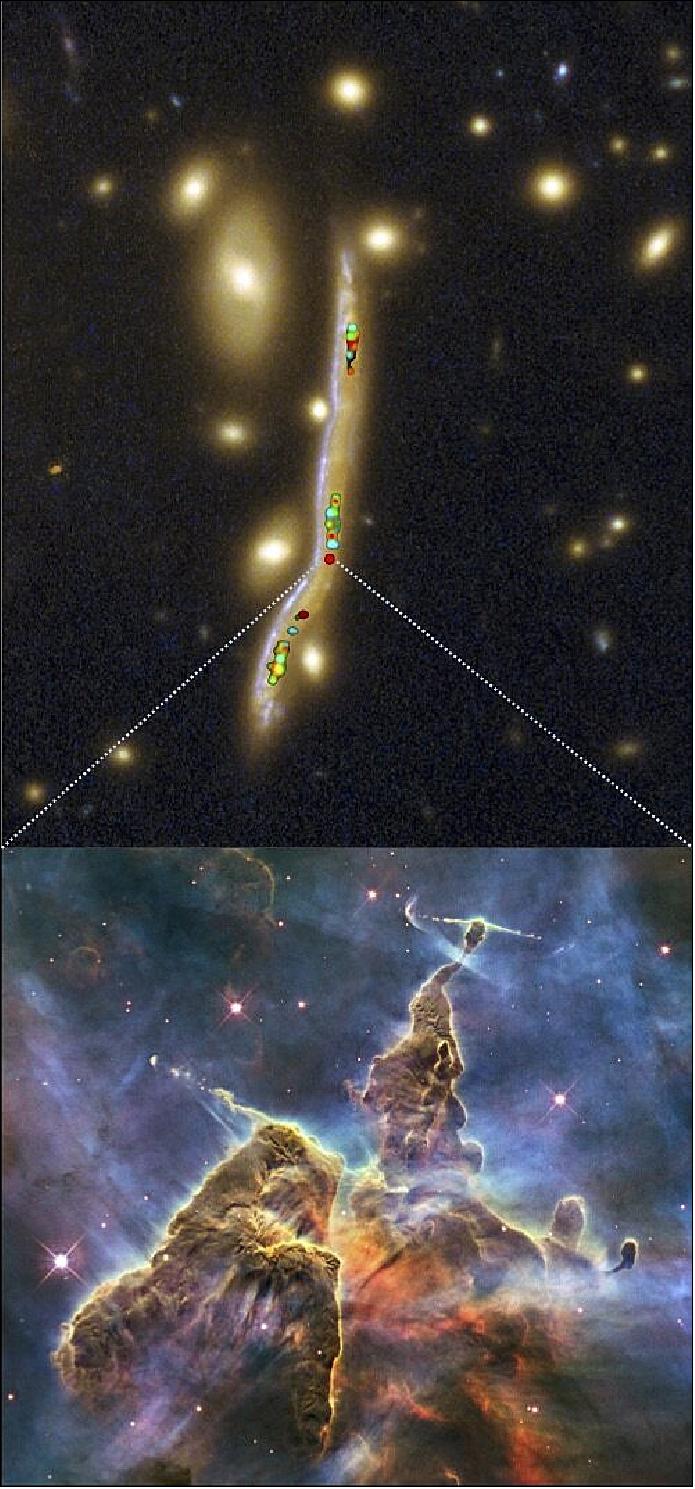
- The astronomers were therefore able to compare the mass, size, density and internal turbulence of molecular clouds in nearby and distant galaxies. "It was thought that the clouds had the same properties in all galaxies at all times, continues the Geneva-based researcher, but our observations have demonstrated the opposite!"
Molecular Clouds Resistant to Extreme Environments
- These new observations revealed that the molecular clouds in distant galaxies had a mass, density and turbulence 10 to 100 times higher than those in nearby galaxies. "Such values had only been measured in clouds hosted in nearby interacting galaxies, which have interstellar medium conditions resembling those of distant galaxies," adds Miroslava Dessauges.
- The researchers could link the differences in the physical properties of the clouds with the galactic environments, which are more extreme and hostile in far-off galaxies than in closer galaxies.
- "A molecular cloud typically found in a nearby galaxy would instantly collapse and be destroyed in the interstellar medium of distant galaxies, hence its enhanced density and turbulence guarantee its survival and equilibrium," explains Miroslava Dessauges.
- "The characteristic mass of the molecular clouds in the Cosmic Snake appears to be in perfect agreement with the predictions of our scenario of fragmentation of turbulent galactic disks. As a result, this scenario can be put forward as the mechanism of formation of massive molecular clouds in distant galaxies," adds Lucio Mayer, a professor at the Centre for Physical and Cosmological Theory at the University of Zurich.
- The international team also discovered that the efficiency of star formation in the Cosmic Snake galaxy is particularly high, likely triggered by the highly supersonic internal turbulence of the clouds. "In nearby galaxies, a molecular cloud forms about 5% of its mass in stars. In distant galaxies, this number climbs to 30%," observes Daniel Schaerer.
- The astronomers will now study other distant galaxies in order to confirm their observational results obtained for the Cosmic Snake. Miroslava Dessauges says in conclusion: "We'll also push the resolution even further by taking advantage of the unique performance of the ALMA interferometer. In parallel, we need to understand in more detail the ability of molecular clouds in distant galaxies to form stars so efficiently."
• September 13, 2019: Astronomers using one of the most advanced radio telescopes (ALMA) have discovered a rare molecule in the dust and gas disc around a young star — and it may provide an answer to one of the conundrums facing astronomers. 117)
- The star, named HD 163296, is located 330 light years from Earth and formed over the last six million years.
- It is surrounded by a disc of dust and gas — a so-called protoplanetary disc. It is within these discs that young planets are born. Using a radio telescope in the Atacama Desert in Chile, researchers were able to detect an extremely faint signal showing the existence of a rare form of carbon monoxide — known as an isotopologue (13C17O).
- The detection has allowed an international collaboration of scientists, led by the University of Leeds, to measure the mass of the gas in the disc more accurately than ever before. The results show that disc is much heavier — or more 'massive' — than previously thought.
- Alice Booth, a PhD researcher at Leeds who led the study, said: "Our new observations showed there was between two and six times more mass hiding in the disc than previous observations could measure.
- "This is an important finding in terms of the birth of planetary systems in discs — if they contain more gas, then they have more building material to form more massive planets."
- The study — The first detection of 13C17O in a protoplanetary disk: a robust tracer of disk gas mass — was published (12/09/2019) in the Astrophysical Journal Letters. 118)
- The scientists' conclusions are well timed. Recent observations of protoplanetary discs have perplexed astronomers because they did not seem to contain enough gas and dust to create the planets observed.
- Dr John Ilee, a researcher at Leeds who was also involved in the study, added: "The disc-exoplanet mass discrepancy raises serious questions about how and when planets are formed. However, if other discs are hiding similar amounts of mass as HD 163296, then we may just have underestimated their masses until now."
- "We can measure disc masses by looking at how much light is given off by molecules like carbon monoxide. If the discs are sufficiently dense, then they can block the light given off by more common forms of carbon monoxide -- and that could result in scientists underestimating the mass of the gas present. - This study has used a technique to observe the much rarer 13C17O molecule — and that's allowed us to peer deep inside the disc and find a previously hidden reservoir of gas."
- The researchers made use of one of the most sophisticated radio telescopes in the world — the ALMA (Atacama Large Millimeter/submillimeter Array) — high in the Atacama Desert.
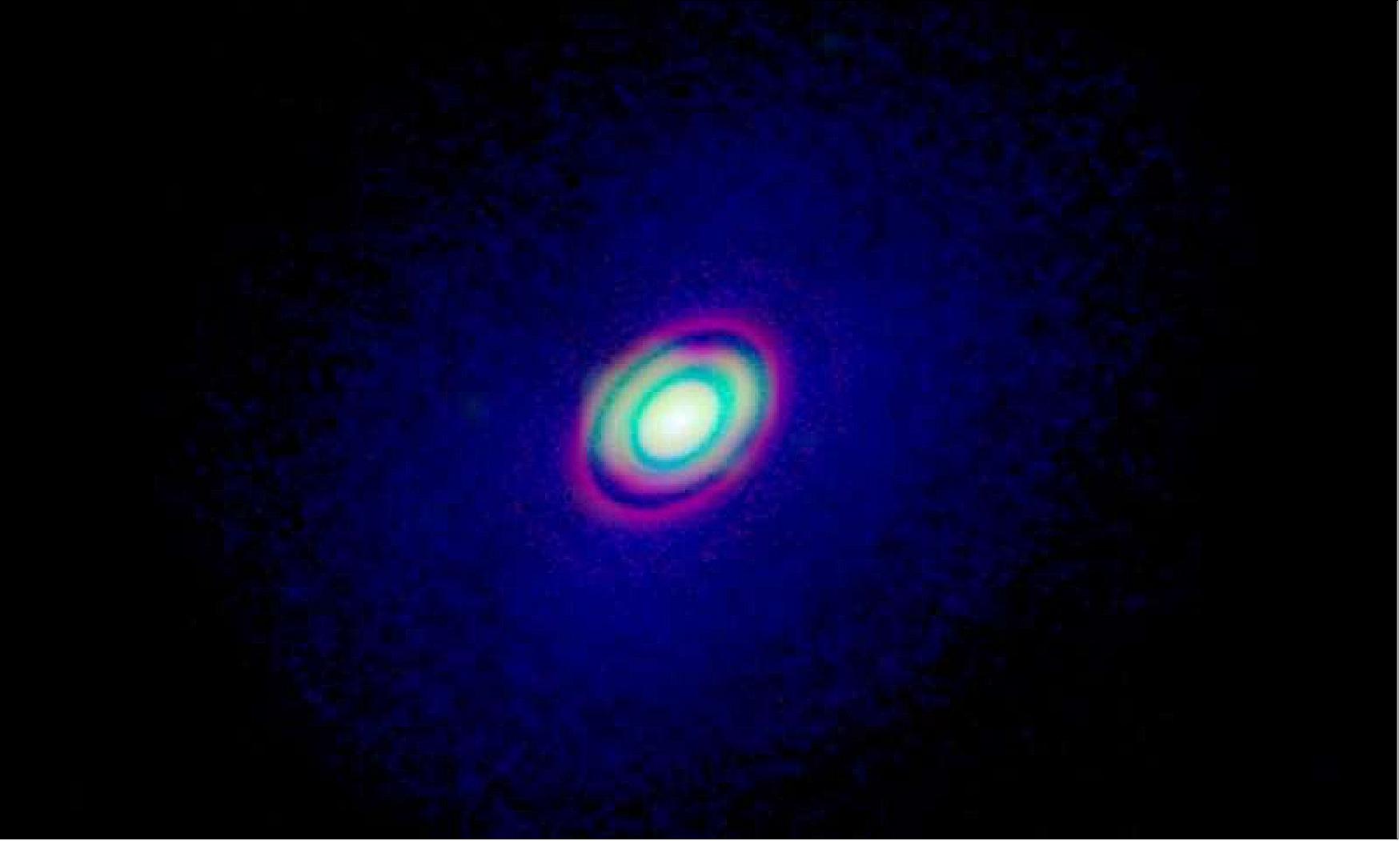
- ALMA is able to observe light that is invisible to the naked eye, allowing astronomers to view what is known as the 'cold universe' — those parts of space not visible using optical telescopes.
- Booth said: "Our work shows the amazing contribution that ALMA is making to our understanding of the Universe. It is helping build a more accurate picture of the physics leading to the formation of new planets. This of course then helps us understand how the Solar System and Earth came to be."
- The researchers are already planning the next steps in their work.
- Booth added: "We suspect that ALMA will allow us to observe this rare form of CO in many other discs. By doing that, we can more accurately measure their mass, and determine whether scientists have systematically been underestimating how much matter they contain."
• August 22, 2019: Swirling clouds, big colorful belts, giant storms. The beautiful and incredibly turbulent atmosphere of Jupiter has been showcased many times. But what is going on below the clouds? What is causing the many storms and eruptions that we see on the ‘surface’ of the planet? However, to study this, visible light is not enough. We need to study Jupiter using radio waves. 119) 120)
- New radio wave images made with the ALMA (Atacama Large Millimeter/submillimeter Array) observatory provide a unique view of Jupiter’s atmosphere down to fifty kilometers below the planet’s visible (ammonia) cloud deck.
- “ALMA enabled us to make a three-dimensional map of the distribution of ammonia gas below the clouds. And for the first time, we were able to study the atmosphere below the ammonia cloud layers after an energetic eruption on Jupiter,” said Imke de Pater of the University of California, Berkeley (EE. UU.).
- The atmosphere of giant Jupiter is made out of mostly hydrogen and helium, together with trace gases of methane, ammonia, hydrosulfide, and water. The top-most cloud layer is made up of ammonia ice. Below that is a layer of solid ammonia hydrosulfide particles, and deeper still, around 80 kilometers below the upper cloud deck, there likely is a layer of liquid water. The upper clouds form the distinctive brown belts and white zones seen from Earth.
- Many of the storms on Jupiter take place inside those belts. They can be compared to thunderstorms on Earth and are often associated with lightning events. Storms reveal themselves in visible light as small bright clouds, referred to as plumes. These plume eruptions can cause a major disruption of the belt, which can be visible for months or years.
- The ALMA images were taken a few days after amateur astronomers observed an eruption in Jupiter’s South Equatorial Belt in January 2017. A small bright white plume was visible first, and then a large-scale disruption in the belt was observed that lasted for weeks after the eruption.
- De Pater and her colleagues used ALMA to study the atmosphere below the plume and the disrupted belt at radio wavelengths and compared these to UV-visible light and infrared images made with other telescopes at approximately the same time.
- “Our ALMA observations are the first to show that high concentrations of ammonia gas are brought up during an energetic eruption,” said de Pater. “The combination of observations simultaneously at many different wavelengths enabled us to examine the eruption in detail. Which led us to confirm the current theory that energetic plumes are triggered by moist convection at the base of water clouds, which are located deep in the atmosphere. The plumes bring up ammonia gas from deep in the atmosphere to high altitudes, well above the main ammonia cloud deck,” she added.
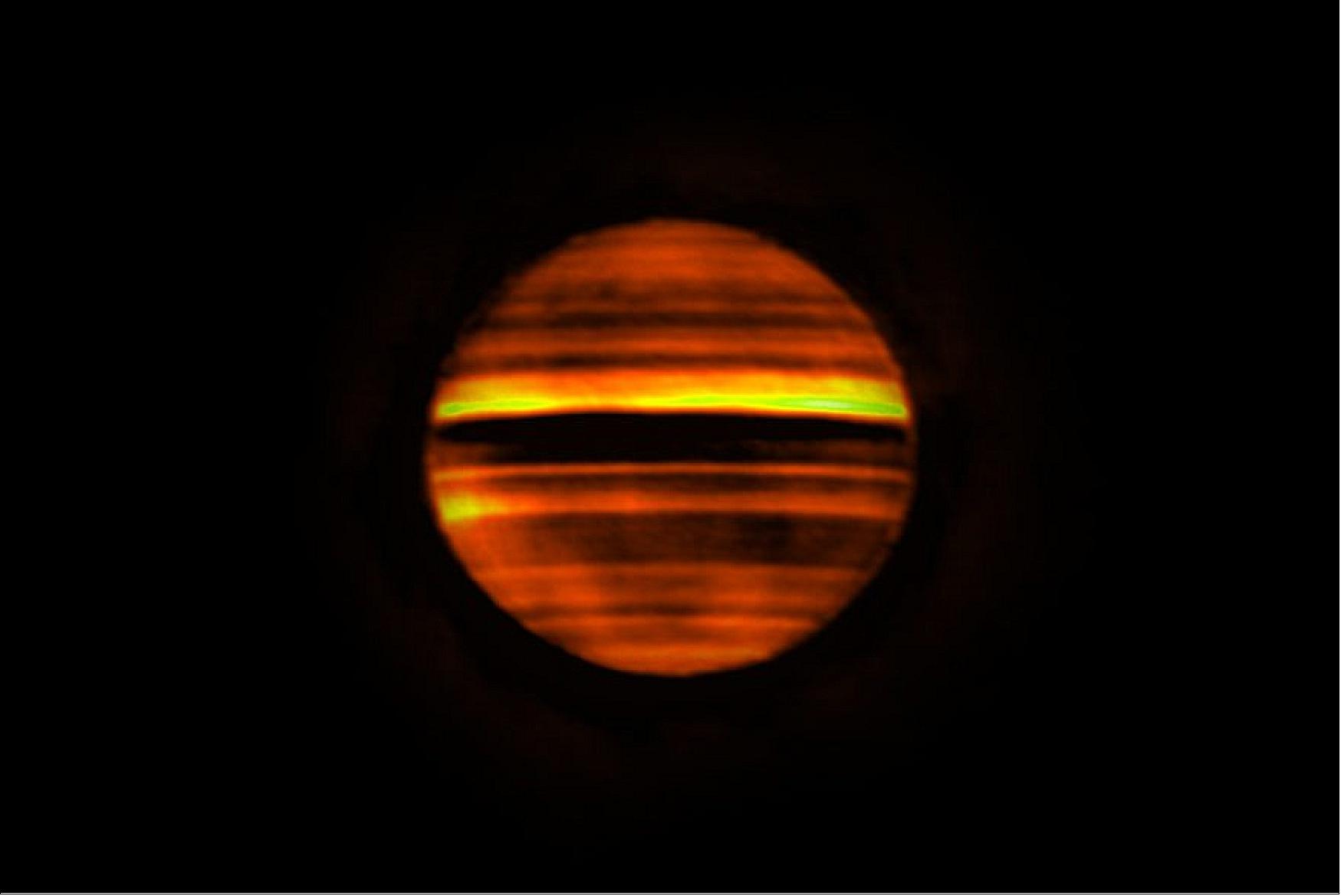
- “These ALMA maps at millimeter wavelengths complement the maps made with the National Science Foundation’s Very Large Array in centimeter wavelengths,” said Bryan Butler of the NRAO (National Radio Astronomy Observatory). “Both maps probe below the cloud layers seen at optical wavelengths and show ammonia-rich gases rising into and forming the upper cloud layers (zones), and ammonia-poor air sinking down (belts).”
- “The present results show superbly what can be achieved in planetary science when an object is studied with various observatories and at various wavelengths”. Explains Eric Villard, an ALMA astronomer part of the research team. “ALMA, with its unprecedented sensitivity and spectral resolution at radio wavelengths, worked together successfully with other major observatories around the world, to provide the data to allow a better understanding of the atmosphere of Jupiter.”
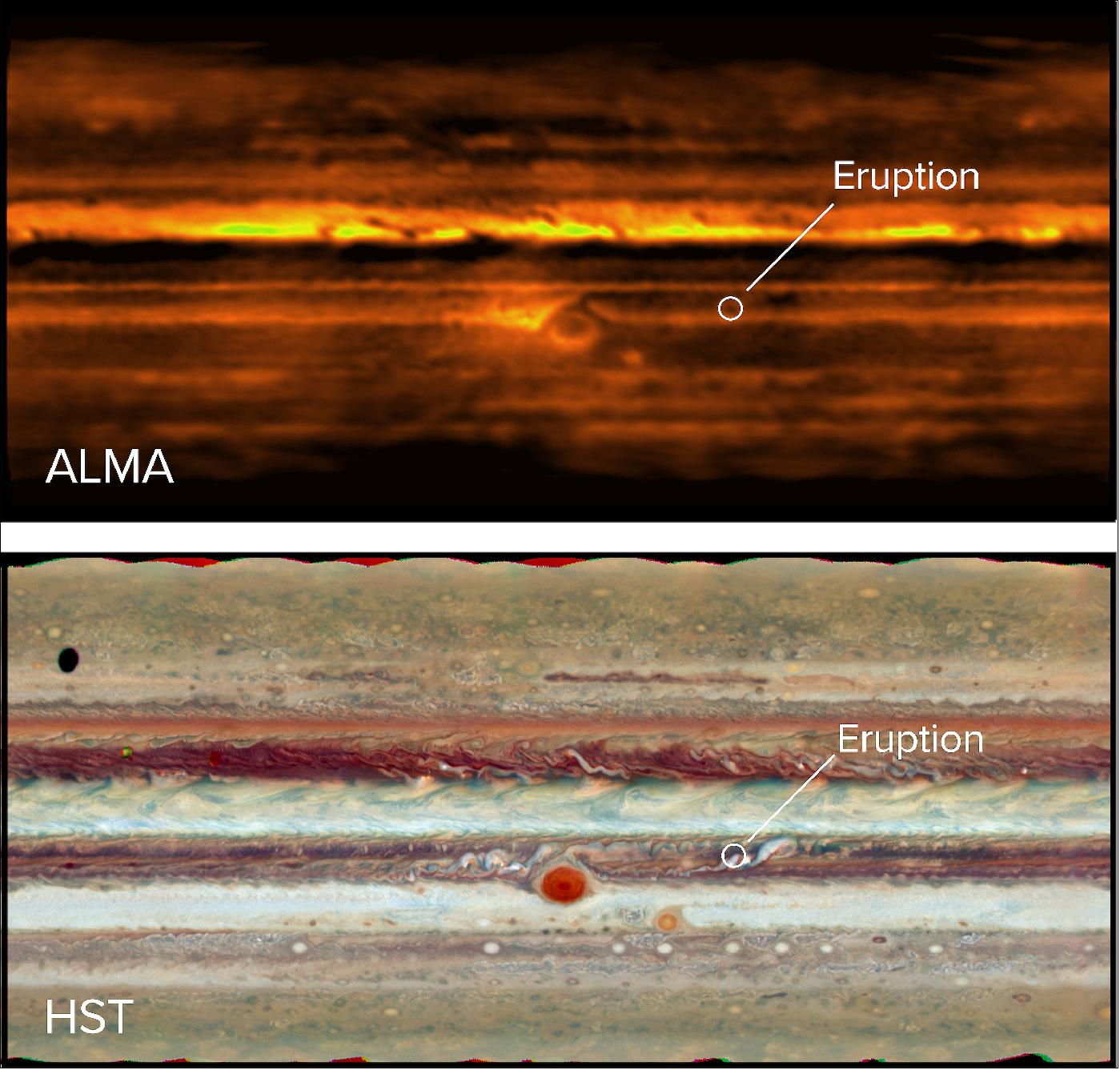
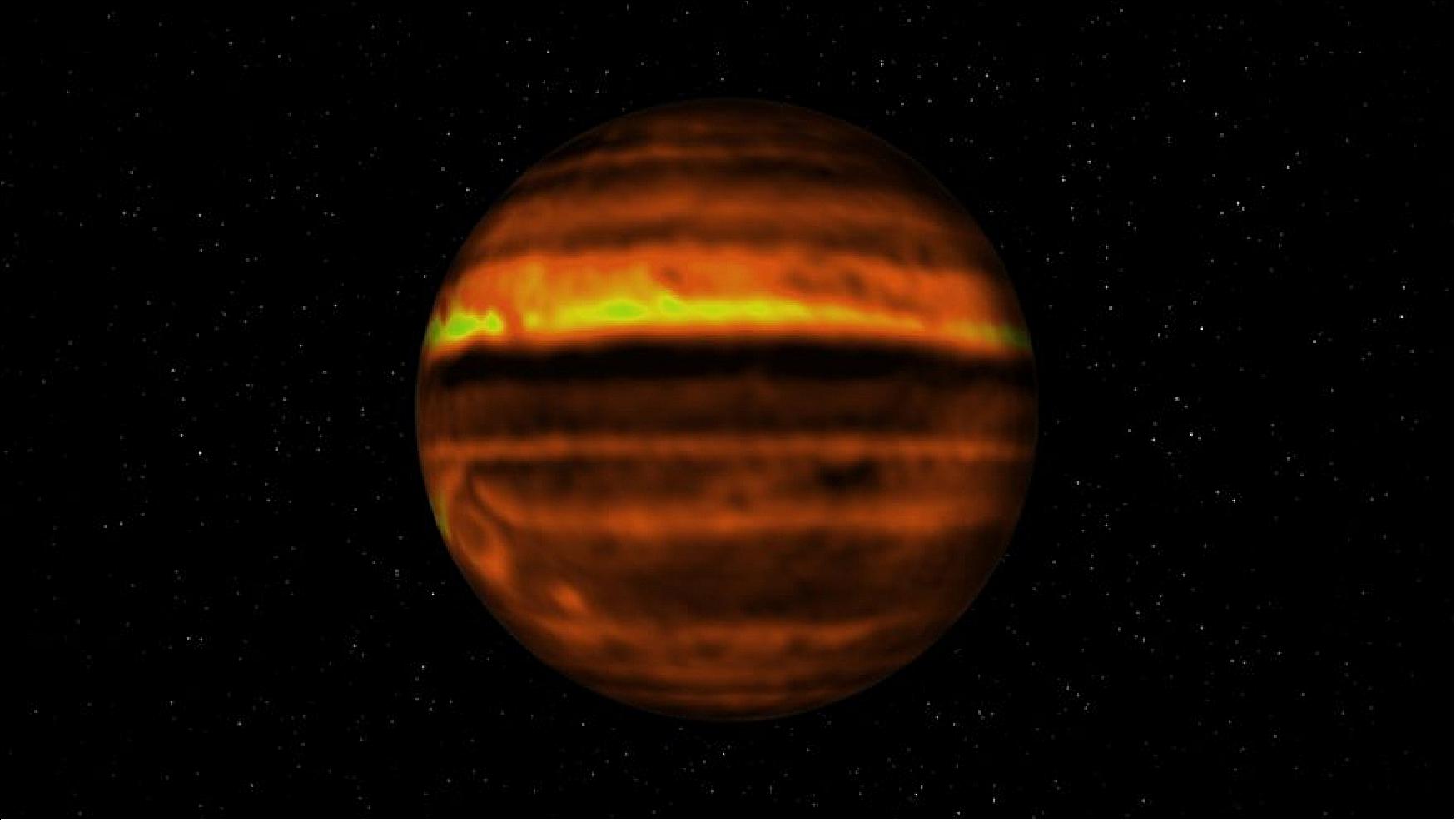
• June 17, 2019: Researchers using the Atacama Large Millimeter/submillimeter Array (ALMA) observed the earliest combined signals of oxygen, carbon, and dust from a galaxy in the Universe, 13 billion years ago. By comparing the different signals, the team determined that the galaxy is, in fact, two merging galaxies, making it the earliest example of merging galaxies yet discovered. 121)
- Takuya Hashimoto at Waseda University, Japan, and his team used ALMA to observe B14-65666, an object located 13 billion light-years away in the constellation Sextans. Because of the finite speed of light, the signals we receive from B14-65666 today had to travel for 13 billion years to reach us. In other words, they show us the image of what the galaxy looked like 13 billion years ago, less than 1 billion years after the Big Bang. 122)
- ALMA achieved the earliest observation of radio emissions from oxygen, carbon, and dust in B14-65666. The detection of multiple signals allows astronomers to retrieve complementary information.
- Data analysis showed that the emissions are divided into two blobs. Previous observations with the Hubble Space Telescope (HST) had revealed two-star clusters in B14-65666. Now, with the three emission signals detected by ALMA, the team was able to show that the two blobs do in-fact form a single system, but with different speeds; which indicates that the blobs are two merging galaxies. The earliest known example of merging galaxies. The research team estimated that the total stellar mass of B14-65666 is less than 10% that of the Milky Way, meaning that it’s in its earliest phases of evolution. Despite its youth, B14-65666 is producing stars 100 times more actively than the Milky Way. Such active star-formation rate is another signature of galactic mergers because the gas compression in colliding galaxies naturally leads to bursty star-formation.
- “With rich data from ALMA and HST, combined with advanced data analysis, we could put the pieces together to show that B14-65666 is a pair of merging galaxies in the earliest era of the Universe,” explains Hashimoto. “Detection of radio waves from three components in such a distant object demonstrates ALMA’s high capability to investigate the distant Universe.”
- Present galaxies like our Milky Way have experienced countless, often violent, mergers. Sometimes a more massive galaxy swallowed a smaller one. In rare cases, galaxies with similar sizes merged to form a new, larger galaxy. Mergers are essential for galaxy evolution, attracting many astronomers eager to trace back them.
- “Our next step is to search for nitrogen, another major chemical element, and even the carbon monoxide molecule,” said Akio Inoue, a professor at Waseda University. “Ultimately, we hope to observationally understand the circulation and accumulation of elements and material in the context of galaxy formation and evolution.”
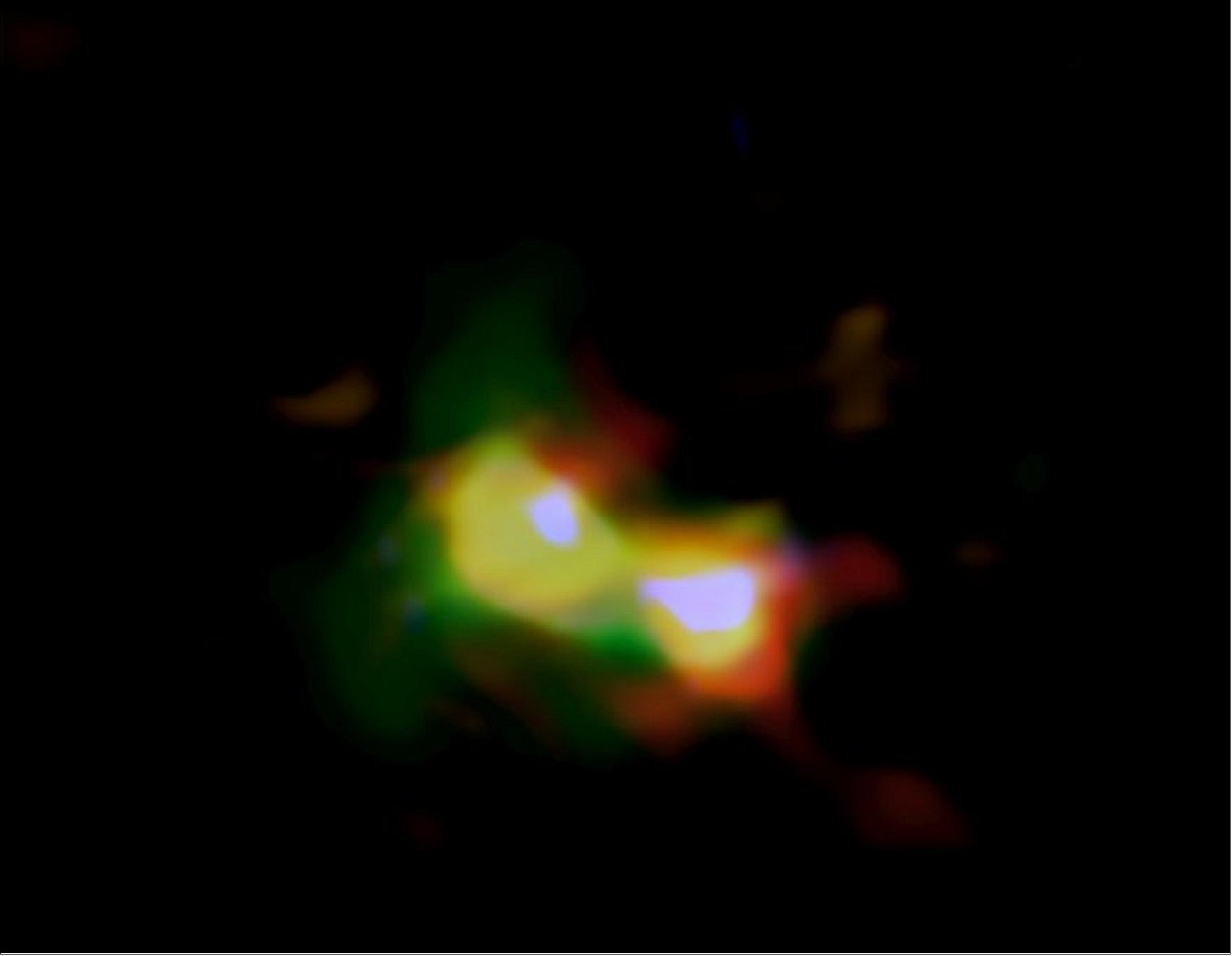
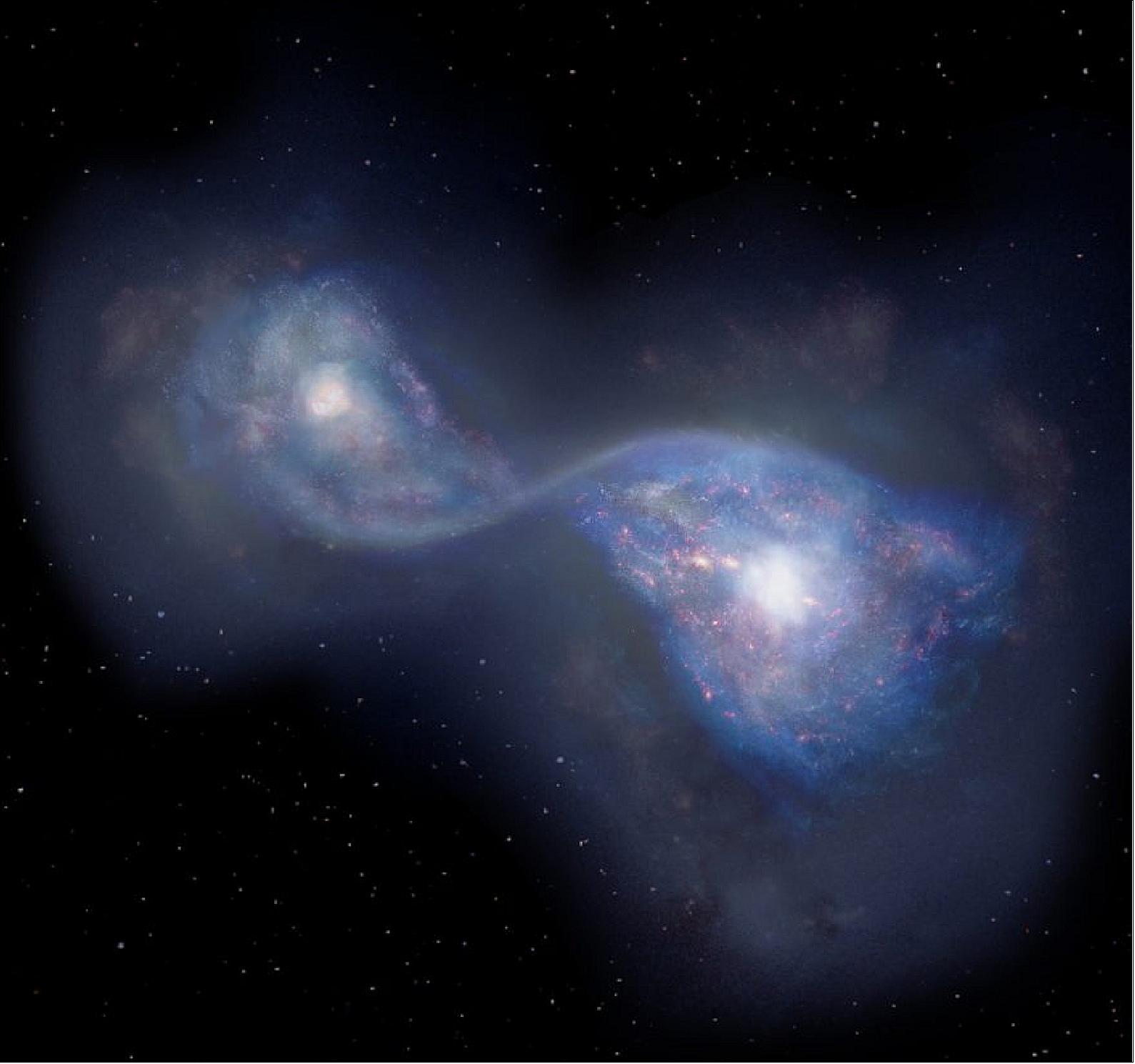
• May 10, 2019: Astronomers map the substance aluminum monoxide (AlO) in a cloud around a distant young star—Origin Source I. The finding clarifies some important details about how our solar system, and ultimately we, came to be. The cloud's limited distribution suggests AlO gas rapidly condenses to solid grains, which hints at what an early stage of our solar evolution looked like. 123) 124) 125)
- Professor Shogo Tachibana of the University of Tokyo Organization for Planetary and Space Science has a passion for space. From small things like meteorites to enormous things like stars and nebulae—huge clouds of gas and dust in space—he is driven to explore our solar system's origins.
- "I have always wondered about the evolution of our solar system, of what must have taken place all those billions of years ago," he said. "This question leads me to investigate the physics and chemistry of asteroids and meteorites."
- Space rocks of all kinds greatly interest astronomers as these rocks can remain largely unchanged since the time our sun and planets formed from a swirling cloud of gas and dust. They contain records of the conditions at that time—generally considered to be 4.56 billion years ago—and their properties such as composition can tell us about these early conditions.
- "On my desk is a small piece of the Allende meteorite, which fell to Earth in 1969. It's mostly dark but there are some scattered white inclusions (foreign bodies enclosed in the rock), and these are important," continued Tachibana. "These speckles are calcium and aluminum-rich inclusions (CAIs), which were the first solid objects formed in our solar system."
- Minerals present in CAIs indicate that our young solar system must have been extremely hot. Physical techniques for dating these minerals reveal a fairly specific age for the solar system. However, Tachibana and colleagues wished to expand on the details of this stage of evolution.

- "There are no time machines to explore our own past, so we wanted to see a young star that could share traits with our own," said Tachibana. "With the ALMA (Atacama Large Millimeter/submillimeter Array), we found the emission lines—a chemical fingerprint—for AlO in outflows from the circumstellar disk (gas and dust surrounding a star) of the massive young star candidate Orion Source I. It's not exactly like our sun, but it's a good start."
- ALMA was the ideal tool as it offers extremely high resolution and sensitivity to reveal the distribution of AlO around the star. No other instrument can presently make such observations.
- The team now plans to explore gas and solid molecules around other stars to gather data useful to further refine solar system models.
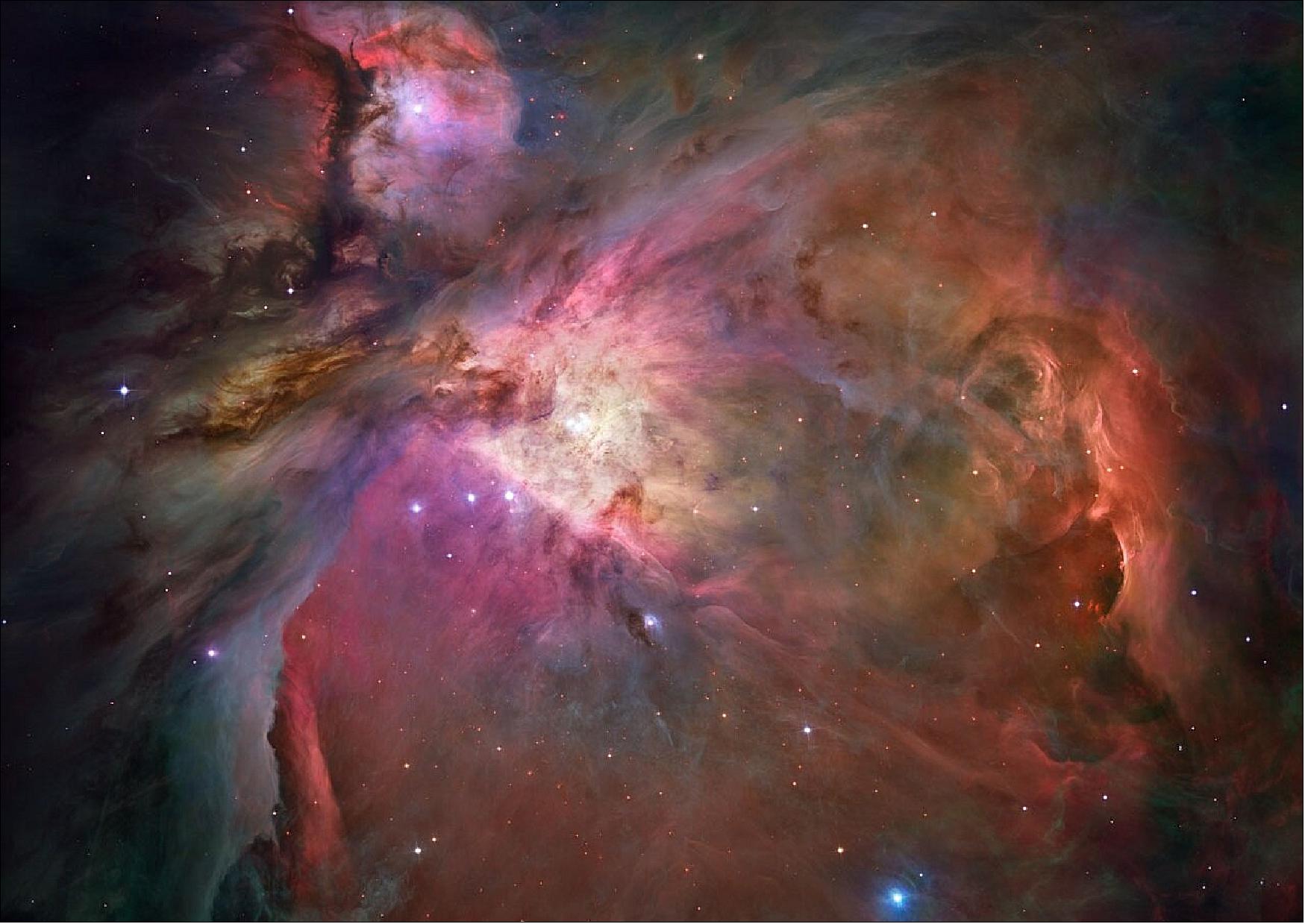
• March 19, 2019: Researchers have detected a radio signal from abundant interstellar dust in MACS0416_Y1, a galaxy 13.2 billion light-years away in the constellation Eridanus. Standard models can’t explain this much dust in a galaxy this young, forcing us to rethink the history of star formation. Researchers now think MACS0416_Y1 experienced staggered star formation with two intense starburst periods 300 million and 600 million years after the Big Bang with a quiet phase in between. 126) 127)
- Stars are the main players in the Universe, but they are supported by the unseen backstage stagehands: stardust and gas. Cosmic clouds of dust and gas are the sites of star formation and masterful storytellers of the cosmic history.
- “Dust and relatively heavy elements such as oxygen are disseminated by the deaths of stars,” said Yoichi Tamura, an associate professor at Nagoya University and the lead author of the research paper, “Therefore, a detection of dust at some point in time indicates that a number of stars have already formed and died well before that point.”
- Using ALMA (Atacama Large Millimeter/submillimeter Array), Tamura and his team observed the distant galaxy MACS0416_Y1. Because of the finite speed of light, the radio waves we observe from this galaxy today had to travel for 13.2 billion years to reach us. In other words, they provide an image of what the galaxy looked like 13.2 billion years ago, which is only 600 million years after the Big Bang.
- The astronomers detected a weak but telltale signal of radio emissions from dust particles in MACS0416_Y1. The HST (Hubble Space Telescope), the Spitzer Space Telescope, and the European Southern Observatory’s VLT (Very Large Telescope) have observed the light from stars in the galaxy; and from its color they estimate the stellar age to be 4 million years.
- “It ain’t easy,” said Tamura half-lost in a moonage daydream. “The dust is too abundant to have been formed in 4 million years. It is surprising, but we need to hang onto ourselves. Older stars might be hiding in the galaxy, or they may have died out and disappeared already.”
- “There have been several ideas proposed to overcome this dust budget crisis,” said Ken Mawatari, a researcher at the University of Tokyo. “However, no one is conclusive. We made a new model which doesn’t need any extreme assumptions diverging far from our knowledge of the life of stars in today’s Universe. The model well explains both the color of the galaxy and the amount of dust.” In this model, the first burst of star formation started at 300 million years and lasted 100 million years. After that, the star formation activity went quiet for a and then restarted at 600 million years. The researchers think ALMA observed this galaxy at the beginning of its second generation of star formation.
- “Dust is a crucial material for planets like Earth,” explains Tamura. “Our result is an important step forward for understanding the early history of the Universe and the origin of dust.”
![Figure 94: ALMA and Hubble Space Telescope (HST) image of the distant galaxy MACS0416_Y1. Distribution of dust and oxygen gas traced by ALMA are shown in red and green, respectively, while the distribution of stars captured by HST is shown in blue [image credit: ALMA (ESO/NAOJ/NRAO), NASA/ESA Hubble Space Telescope, Tamura, et al.]](https://www.eoportal.org/ftp/satellite-missions/a/Alma_300622/Alma_AutoF.jpeg)
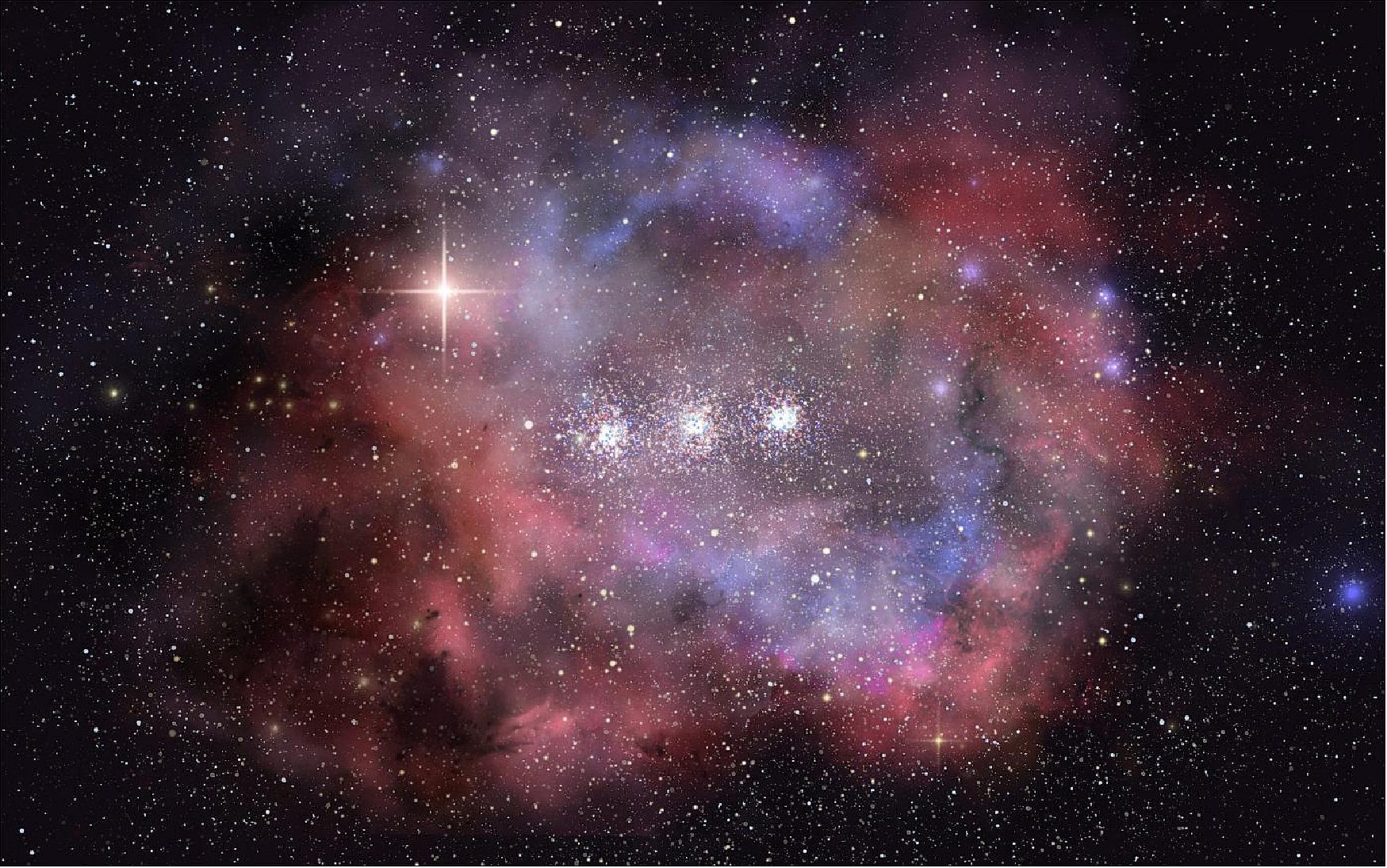
• March 18, 2019: Scientists from the RIKEN Cluster for Pioneering Research in Japan,the Chalmers University of Technology in Sweden,and the University of Virginia in the USA and collaborators used ALMA (Atacama Large Millimeter/submillimeter Array) to observe a molecular cloud that is collapsing to form two massive protostars that will eventually become a binary star system. 128)
- While it is known that most massive stars possess orbiting stellar companions it has been unclear how this comes about – for example, are the stars born together from a common spiraling gas disk at the center of a collapsing cloud, or do they pair up later by chance encounters in a crowded star cluster.
- Understanding the dynamics of forming binaries has been difficult because the protostars in these systems are still enveloped in a thick cloud of gas and dust that prevents most light from escaping. Fortunately, it is possible to see them using radio waves, as long as they can be imaged with sufficiently high spatial resolution.
- In the current research, published in Nature Astronomy, the researchers led by Yichen Zhang of the RIKEN Cluster for Pioneering Research and Jonathan C. Tan at the Chalmers University,and the University of Virginia, used ALMA to observe, at high spatial resolution, a star-forming region known as IRAS07299-1651, which is located 1.68 kpc (kiloparsec), or about 5,500 light years, away.
- The observations showed that already at this early stage, the cloud contains two objects, a massive “primary” central star and another “secondary” forming star, also of high mass. For the first time, the research team was able to use these observations to deduce the dynamics of the system. The observations showed that the two forming stars are separated by a distance of about 180 astronomical units—a unit approximately the distance from the earth to the sun. Hence, they are quite far apart. They are currently orbiting each other with a period of at most 600 years and have a total mass at least 18 times that of our Sun. 129)
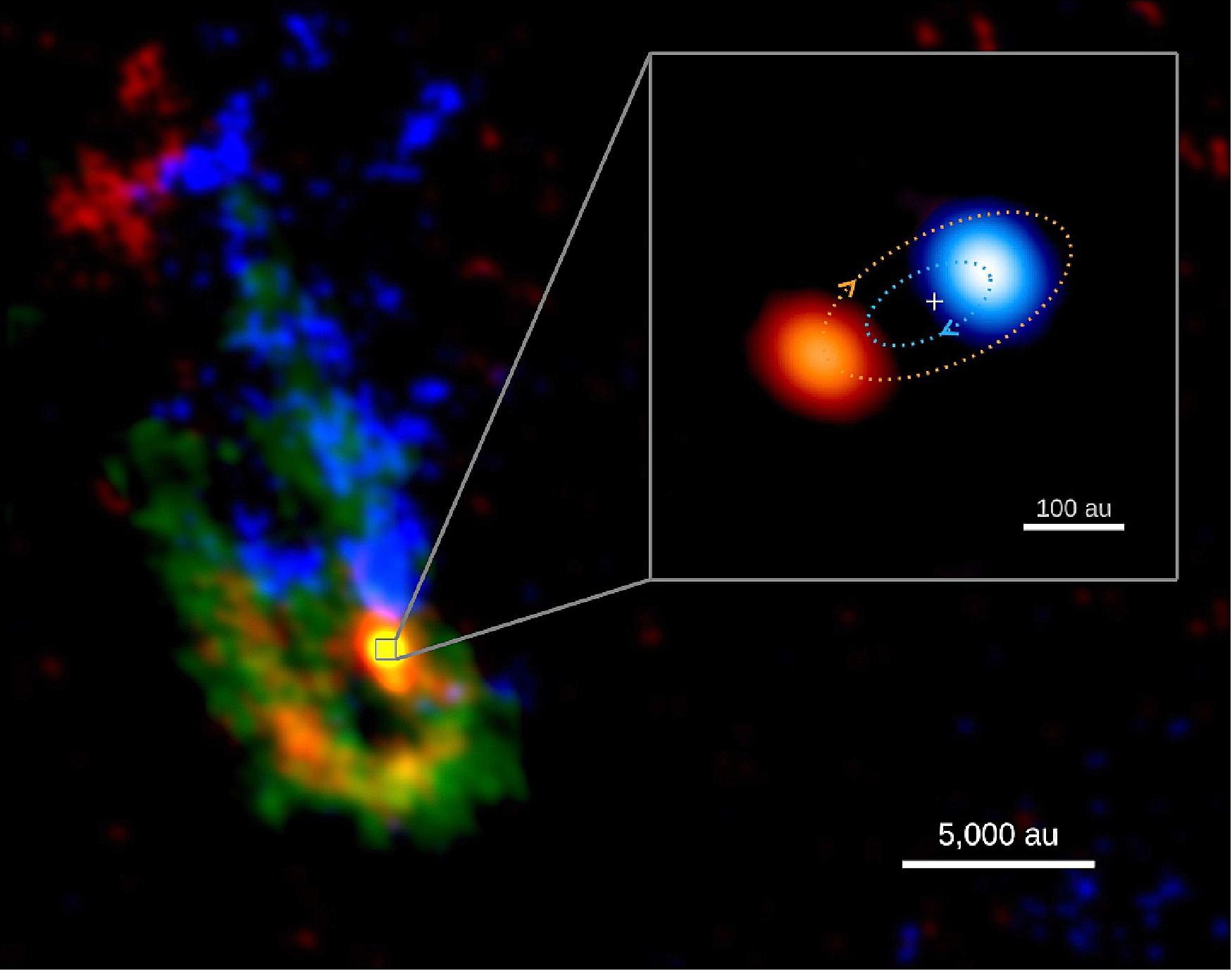
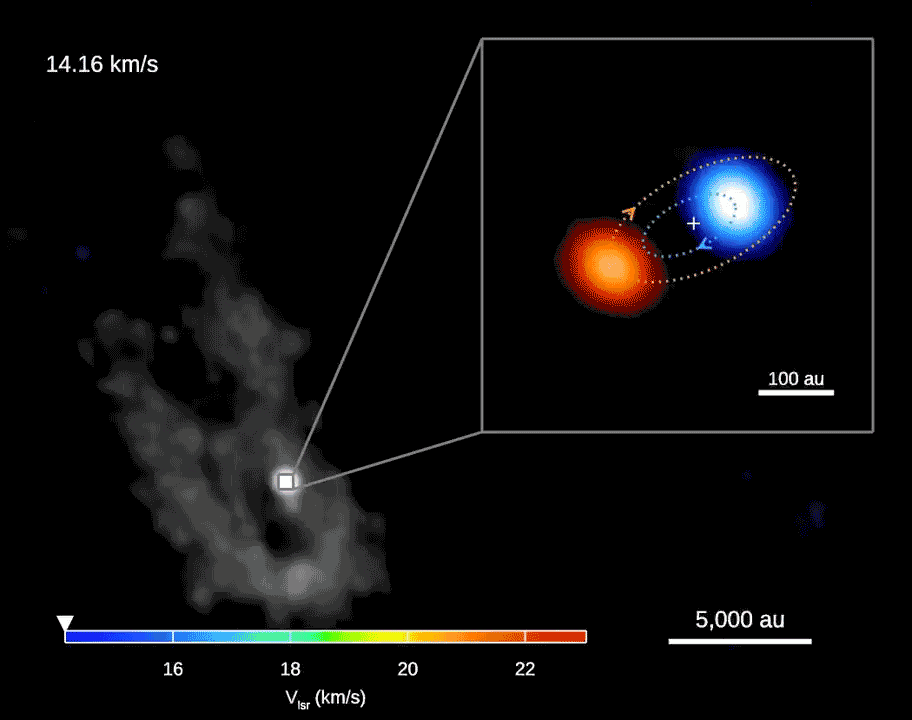
• March 13, 2019: Researchers have spotted the formation sites of planets around a young star resembling our Sun. Two rings of dust around the star, at distances comparable to the asteroid belt and the orbit of Neptune in our Solar System, suggest that we are witnessing the formation of a planetary system similar to our own. 130) 131)
- The Solar System is thought to have formed from a cloud of cosmic gas and dust 4.6 billion years ago. By studying young planetary systems forming around other stars, astronomers hope to learn more about our own origins.
- Tomoyuki Kudo, an astronomer at the National Astronomical Observatory of Japan (NAOJ), and his team observed the young star DM Tau using the Atacama Large Millimeter/submillimeter Array (ALMA). Located 470 light-years away in the constellation Taurus, DM Tau is about half the mass of the Sun and estimated to be three to five million years old.
- "Previous observations inferred two different models for the disk around DM Tau," said Kudo. "Some studies suggested the radius of the ring is about where the Solar System's asteroid belt would be. Other observations put the size out where Neptune would be. Our ALMA observations provided a clear answer: both are right. DM Tau has two rings, one at each location."
- The researchers found a bright patch in the outer ring. This indicates a local concentration of dust, which would be a possible formation site for a planet like Uranus or Neptune.
- "We are also interested in seeing the details in the inner region of the disk, because the Earth formed in such an area around the young Sun," commented Jun Hashimoto, a researcher at the Astrobiology Center, Japan. "The distribution of dust in the inner ring around DM Tau will provide crucial information to understand the origin of planets like Earth."
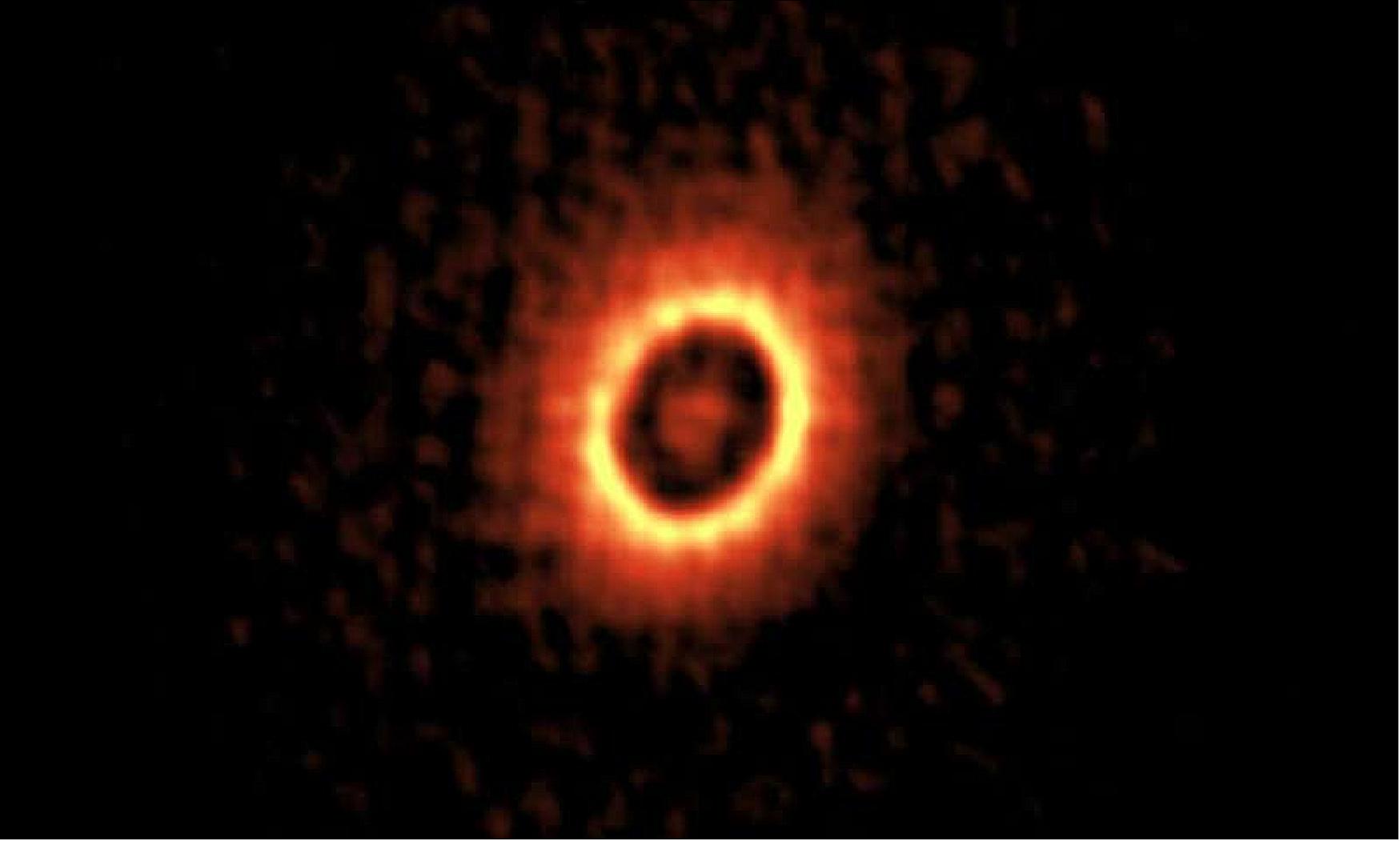
• February 28, 2019: Astronomers have detected a stealthy black hole from its effects on an interstellar gas cloud. This intermediate mass black hole is one of over 100 million quiet black holes expected to be lurking in our galaxy. These results provide a new method to search for other hidden black holes and help us understand the growth and evolution of black holes. 132) 133)
- Black holes are objects with such strong gravity that everything, including light, is sucked in and cannot escape. Because black holes do not emit light, astronomers must infer their existence from the effects their gravity produce in other objects. Black holes range in mass from about 5 times the mass of the Sun to supermassive black holes millions of times the mass of the Sun. Astronomers think that small black holes merge and gradually grow into large ones, but no one had ever found an intermediate mass, hundreds or thousands of times the mass of the Sun.
- A research team led by Shunya Takekawa at the National Astronomical Observatory of Japan noticed HCN–0.009–0.044, a gas cloud moving strangely near the center of the Galaxy 25,000 light-years away from Earth in the constellation Sagittarius. They used ALMA (Atacama Large Millimeter/submillimeter Array) to perform high resolution observations of the cloud and found that it is swirling around an invisible massive object.
- Takekawa explains, “Detailed kinematic analyses revealed that an enormous mass, 30,000 times that of the Sun, was concentrated in a region much smaller than our Solar System. This and the lack of any observed object at that location strongly suggests an intermediate-mass black hole. By analyzing other anomalous clouds, we hope to expose other quiet black holes.”
- Tomoharu Oka, a professor at Keio University and coleader of the team, adds, “It is significant that this intermediate mass black hole was found only 20 light-years from the supermassive black hole at the Galactic center. In the future, it will fall into the supermassive black hole; much like gas is currently falling into it. This supports the merger model of black hole growth.”
![Figure 99: Artist’s impression of a gas cloud swirling around a black hole [image credit: NAOJ (National Astronomical Observatory of Japan)]](https://www.eoportal.org/ftp/satellite-missions/a/Alma_300622/Alma_AutoB.jpeg)
• February 26, 2019: Astronomers have unveiled the enigmatic origins of two different gas streams from a baby star. Using ALMA, they found that the slow outflow and the high speed jet from a protostar have misaligned axes and that the former started to be ejected earlier than the latter. The origins of these two flows have been a mystery, but these observations provide telltale signs that these two streams were launched from different parts of the disk around the protostar. 134)
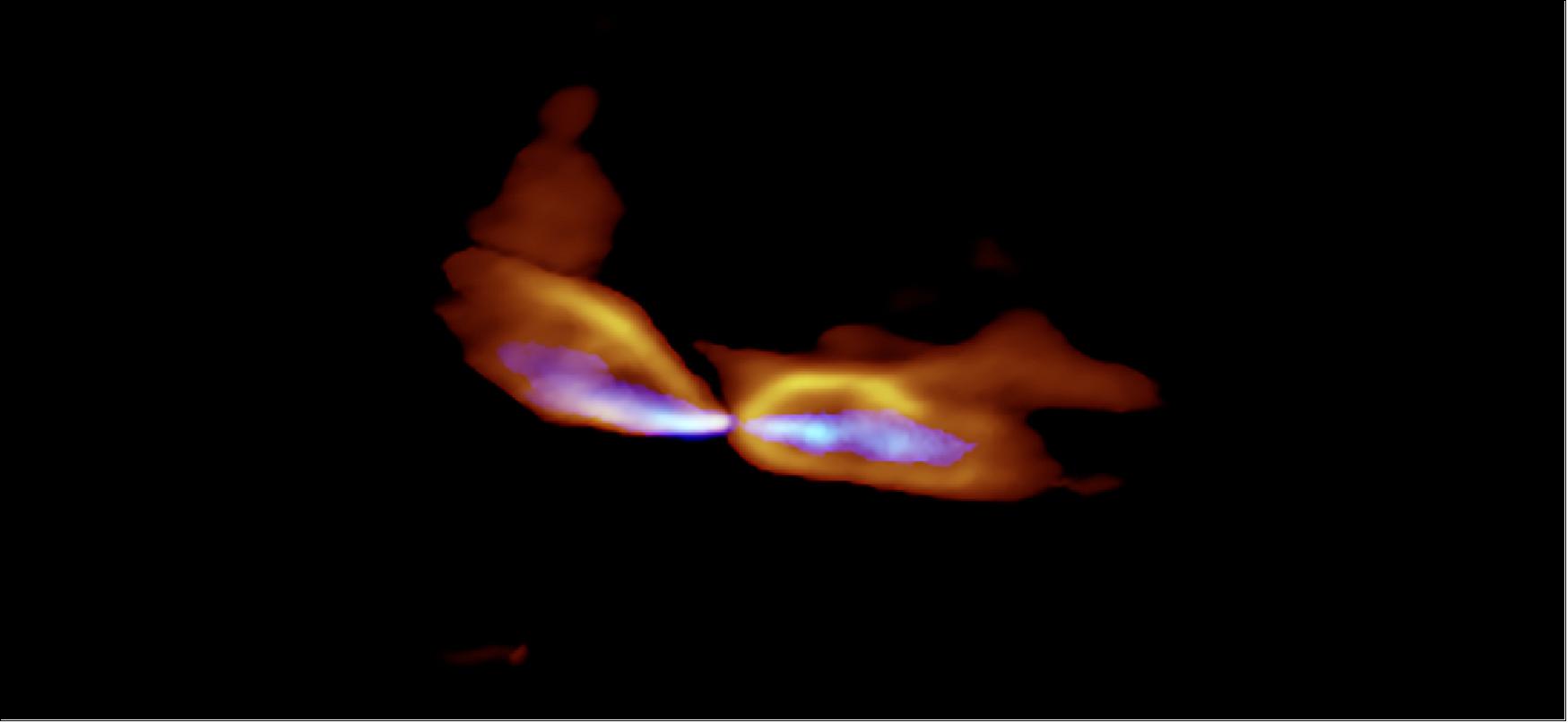
- Stars in the Universe have a wide range of masses, ranging from hundreds of times the mass of the Sun to less than a tenth of that of the Sun. To understand the origin of this variety, astronomers study the formation process of the stars, that is the aggregation of cosmic gas and dust.
- Baby stars collect the gas with their gravitational pull, however, some of the material is ejected by the protostars. This ejected material forms a stellar birth cry which provides clues to understand the process of mass accumulation.
- Yuko Matsushita, a graduate student at Kyushu University and her team used ALMA to observe the detailed structure of the birth cry from the baby star MMS5/OMC-3 and found two different gaseous flows: a slow outflow and a fast jet. There have been a handful of examples with two flows seen in radio waves, but MMS5/OMC-3 is exceptional.
- “Measuring the Doppler shift of the radio waves, we can estimate the speed and lifetime of the gas flows,” said Matsushita, the lead author of the research paper that appeared in the Astrophysical Journal. “We found that the jet and outflow were launched 500 years and 1300 years ago, respectively. These gas streams are quite young.”
- More interestingly, the team found that the axes of the two flows are misaligned by 17 degrees. The axis of the flows can be changed over long time periods due to the precession of the central star. But in this case, considering the extreme youth of the gas streams, researchers concluded that the misalignment is not due to precession but is related to the launching process.
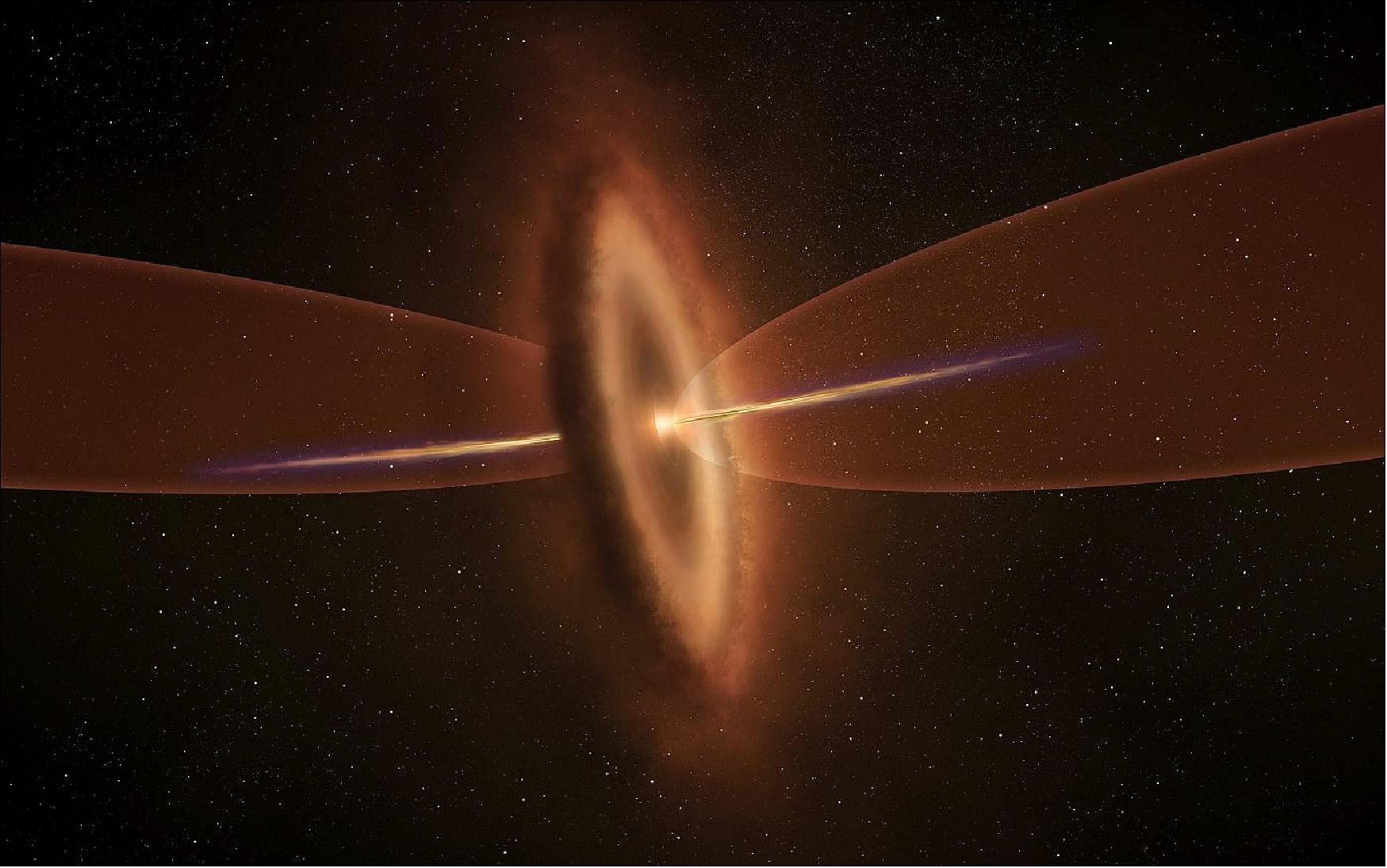
- There are two competing models for the formation mechanism of the protostellar outflows and jets. Some researchers assume that the two streams are formed independently in different parts of the gas disk around the central baby star, while others propose that the collocated jet is formed first, then it entrains the surrounding material to form the slower outflows. Despite extensive research, astronomers had not yet reached a conclusive answer.
- A misalignment in the two flows could occur in the ‘independent model,’ but is difficult in the ‘entrainment model.’ Moreover, the team found that the outflow was ejected considerably earlier than the jet. This clearly backs the ‘independent model.’
- “The observation well matches the result of my simulation,” said Masahiro Machida, a professor at Kyushu University. A decade ago, he performed pioneering simulation studies using a supercomputer operated by the National Astronomical Observatory of Japan. In the simulation, the wide-angle outflow is ejected from the outer area of the gaseous disk around a protostar, while the collimated jet is launched independently from the inner area of the disk. Machida continues, “An observed misalignment between the two gas streams may indicate that the disk around the protostar is warped.”
- “ALMA’s high sensitivity and high angular resolution will enable us to find more and more young, energetic outflow-and-jet-systems like MMS 5/OMC-3,” said Satoko Takahashi, an astronomer at the National Astronomical Observatory of Japan and the Joint ALMA Observatory and co-author of the paper. “They will provide clues to understand the driving mechanisms of outflows and jets. Moreover studying such objects will also tell us how the mass accretion and ejection processes work at the earliest stage of star formation.” 135)
• February 25, 2019: Red giants are old stars that eject gaseous material and solid particles through a stellar wind. Some red giants appeared to lose an exceptionally large amount of mass this way. However, new observations reveal that this is not quite the case. The stellar wind is not more intense than normal, but is affected by a partner that was overlooked until now—a second star that circles the red giant. These are the results of an international study led by Belgian university KU (Katholieke Universiteit) Leuven. 136)
- Humans don't live long enough to realize it, but stars are also born, they age, and they die. It's a process that takes billions of years. As a star gets older, it becomes bigger, colder, and redder - hence the name 'red giants'. Our sun will also become such a red giant in four and a half billion years.
- In the final stage of their life, red giants eject their mass - gas and other matter - in the form of a stellar wind. Earlier observations confirmed that red giants lose a lot of mass this way.
- Twelve mass-loss rate record holders, in particular, have been baffling scientists for decades. These red giants supposedly eject the equivalent of 100 earths per year for 100 to 2,000 years on end. Even astronomically speaking, that's a lot of matter in a short amount of time.
- This was difficult to explain, says Professor Leen Decin from the KU Leuven Institute of Astronomy: "If you look at the mass of such a star in the next phase of its life, the intense stellar wind doesn't last long enough to account for the mass loss that we've seen. It was also statistically improbable that we had discovered twelve of these red giants, knowing that what we were seeing was a phase that lasted only hundreds or thousands of years compared with their billion-year-long life. It's like finding a needle in a haystack twelve times."
- New observations from the ALMA telescope in Chile shed light on what was happening with two of these red giants. "For these stars, the stellar wind forms a spiral. It's an indirect indication that the red giant is not alone, but part of a binary star system. The red giant is the main star with a second star circling it. Both stars affect each other and their environment gravitationally in two ways: on the one hand, the stellar wind is pulled in the direction of the second star and, on the other hand, the red giant itself also wiggles slightly. These movements give the stellar wind a spiral shape."
- The discovery of a partner star made everything fall into place, says Decin: "We believed that these red giants were record holders for mass-loss rate, but that's not the case. It only seemed as though they were losing a lot of mass because there's an area between the two stars where the stellar wind is much more concentrated due to the gravity of the second star. These red giants don't lose the equivalent of 100 earths per year, but rather 10 of them - just like the regular red giants. As such, they also die a bit more slowly than we first assumed. To rephrase in a positive way: these old stars live longer than we thought."
- The astronomers are now investigating whether a system with a binary star could also be the explanation for other special red giants. "We believed that many stars lived alone, but we will probably have to adjust this idea. A star with a partner is likely to be more common than we thought," Decin concludes.
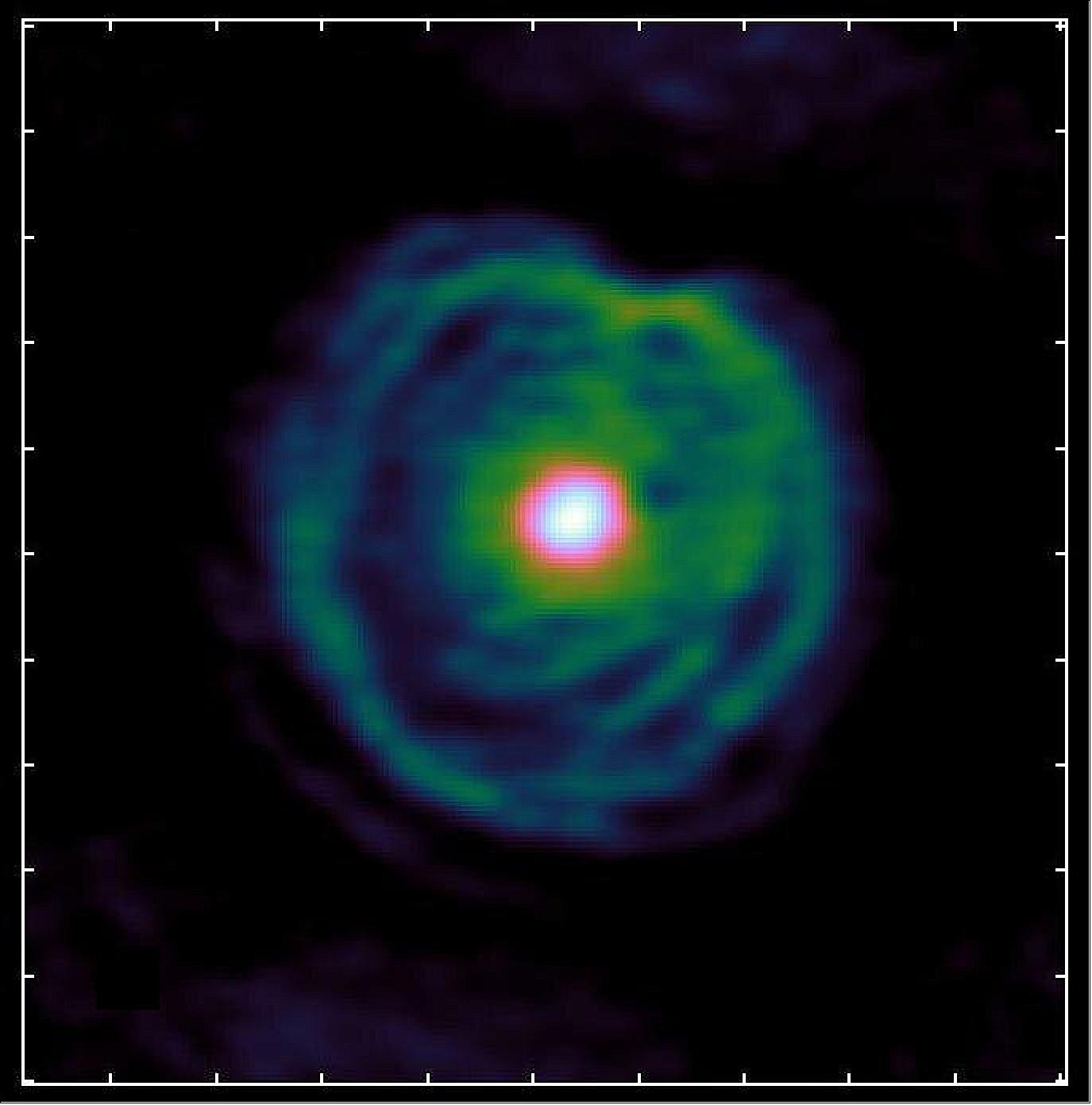
• February 7, 2019: A team of astronomers and chemists using ALMA has detected the chemical fingerprints of sodium chloride (NaCl) and other similar salty compounds emanating from the dusty disk surrounding Orion Source I, a massive, young star in a dusty cloud behind the Orion Nebula. 138)
- “It’s amazing we’re seeing these molecules at all,” said Adam Ginsburg, a Jansky Fellow of the National Radio Astronomy Observatory (NRAO) in Socorro, New Mexico, and lead author of a paper accepted for publication in the Astrophysical Journal. “Since we’ve only ever seen these compounds in the sloughed-off outer layers of dying stars, we don’t fully know what our new discovery means. The nature of the detection, however, shows that the environment around this star is very unusual.”
- To detect molecules in space, astronomers use radio telescopes to search for their chemical signatures – telltale spikes in the spread-out spectra of radio and millimeter-wavelength light. Atoms and molecules emit these signals in several ways, depending on the temperature of their environments.
- The new ALMA observations contain a bristling array of spectral signatures – or transitions, as astronomers refer to them – of the same molecules. To create such strong and varied molecular fingerprints, the temperature differences where the molecules reside must be extreme, ranging anywhere from 100 kelvin to 4,000 kelvin (about -175 Celsius to 3700 Celsius). An in-depth study of these spectral spikes could provide insights about how the star is heating the disk, which would also be a useful measure of the luminosity of the star.
- “When we look at the information ALMA has provided, we see about 60 different transitions – or unique fingerprints – of molecules like sodium chloride and potassium chloride coming from the disk. That is both shocking and exciting,” said Brett McGuire, a chemist at the NRAO in Charlottesville, Virginia, and co-author on the paper.
- The researchers speculate that these salts come from dust grains that collided and spilled their contents into the surrounding disk. Their observations confirm that the salty regions trace the location of the circumstellar disk.
- “Usually when we study protostars in this manner, the signals from the disk and the outflow from the star get muddled, making it difficult to distinguish one from the other,” said Ginsburg. “Since we can now isolate just the disk, we can learn how it is moving and how much mass it contains. It also may tell us new things about the star.”
- The detection of salts around a young star is also of interest to astronomers and astrochemists because some of constituent atoms of salts are metals – sodium and potassium. This suggests there may be other metal-containing molecules in this environment. If so, it may be possible to use similar observations to measure the amount of metals in star-forming regions. “This type of study is not available to us at all presently. Free-floating metallic compounds are generally invisible to radio astronomy,” noted McGuire.
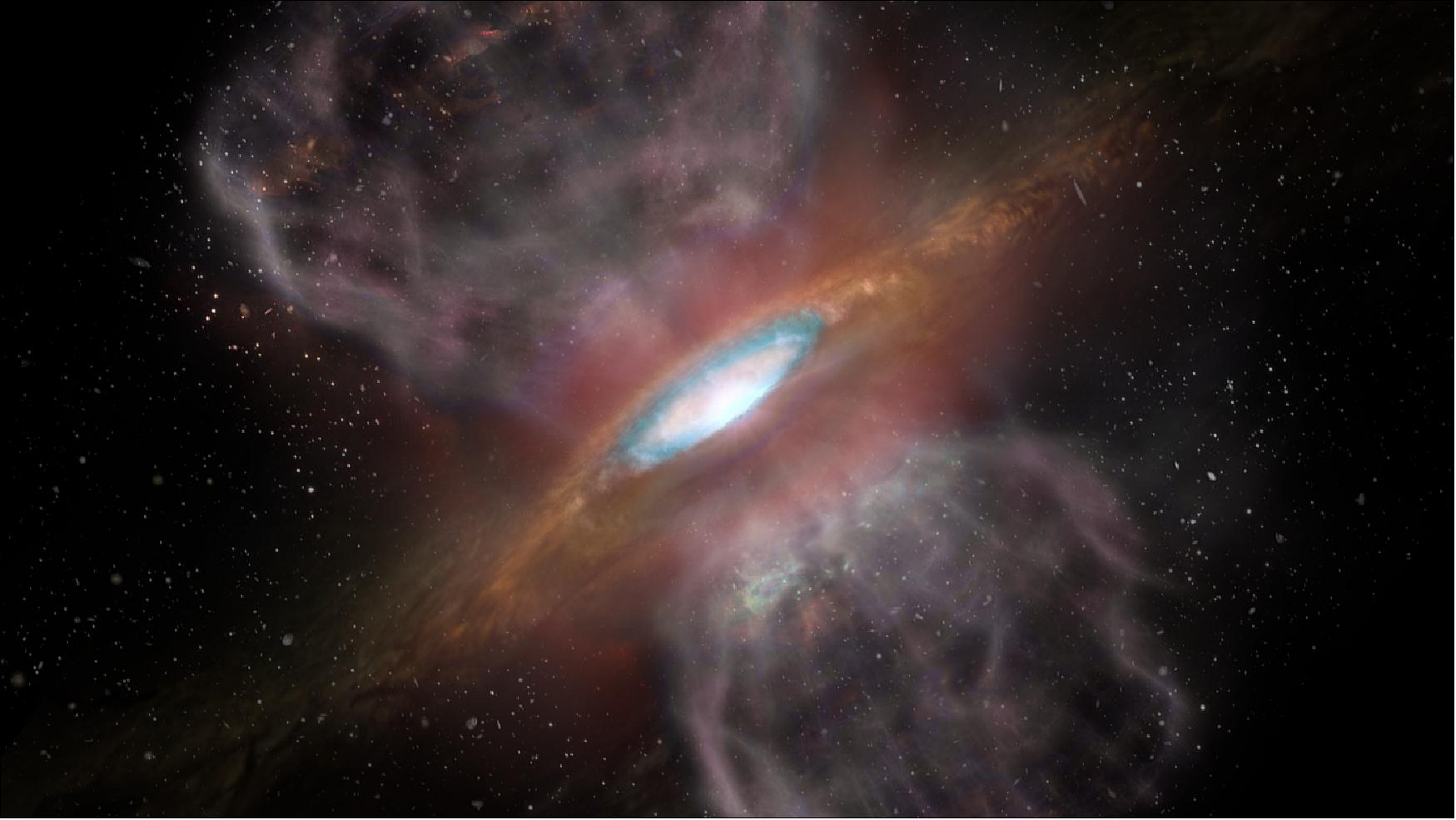
- The salty signatures were found about 30 to 60 astronomical units (AU, or the average distance between the Earth and the Sun) from the host stars. Based on their observations, the astronomers infer that there may be as much as one sextillion (a one with 21 zeros after it) kilograms of salt in this region, which is roughly equivalent to the entire mass of Earth’s oceans.
- “Our next step in this research is to look for salts and metallic molecules in other regions. This will help us understand if these chemical fingerprints are a powerful tool to study a wide range of protoplanetary disks, or if this detection is unique to this source,” said Ginsburg. “In looking to the future, the planned Next Generation VLA would have the right mix of sensitivity and wavelength coverage to study these molecules and perhaps use them as tracers for planet-forming disks.”
- Orion Source I formed in the Orion Molecular Cloud I, a region of explosive starbirth previously observed with ALMA. “This star was ejected from its parent cloud with a speed of about 10 km/s around 550 years ago,” said John Bally, an astronomer at the University of Colorado and co-author on the paper. “It is possible that solid grains of salt were vaporized by shock waves as the star and its disk were abruptly accelerated by a close encounter or collision with another star. It remains to be seen if salt vapor is present in all disks surrounding massive protostars, or if such vapor traces violent events like the one we observed with ALMA.” 139)
• February 4, 2019: Astronomers using ALMA have detected various complex organic molecules around the young star V883 Ori. A sudden outburst from this star is releasing molecules from the icy compounds in the planet forming disk. The chemical composition of the disk is similar to that of comets in the modern Solar System. Sensitive ALMA observations enable astronomers to reconstruct the evolution of organic molecules from the birth of the Solar System to the objects we see today. 140)
- The research team led by Jeong-Eun Lee (Kyung Hee University, Korea) used the Atacama Large Millimeter/submillimeter Array (ALMA) to detect complex organic molecules including methanol (CH3OH), acetone (CH3COCH3), acetaldehyde (CH3CHO), methyl formate (CH3OCHO), and acetonitrile (CH3CN). This is the first time that acetone was unambiguously detected in a planet forming region or protoplanetary disk.
- Various molecules are frozen in ice around micrometer-sized dust particles in protoplanetary disks. V883 Ori's sudden flare-up is heating the disk and sublimating the ice, which releases the molecules into gas. The region in a disk where the temperature reaches the sublimation temperature of the molecules is called the "snow line." The radii of snow lines are about a few astronomical units (au) around normal young stars, however, they are enlarged almost 10 times around bursting stars.
- "It is difficult to image a disk on the scale of a few au with current telescopes," said Lee. "However, around an outburst star, ice melts in a wider area of the disk and it is easier to see the distribution of molecules. We are interested in the distribution of complex organic molecules as the building blocks of life."
- Ice, including frozen organic molecules, could be closely related to the origin of life on planets. In our Solar System, comets are the focus of attention because of their rich icy compounds. For example, the European Space Agency's legendary comet explorer Rosetta found rich organic chemistry around the comet Churyumov-Gerasimenko. Comets are thought to have been formed in the outer colder region of the proto-Solar System, where the molecules were contained in ice. Probing the chemical composition of ice in protoplanetary disks is directly related to probing the origin of organic molecules in comets, and the origin of the building blocks of life.
- Thanks to ALMA's sharp vision and the enlarged snow line due to the flare-up of the star, the astronomers obtained the spatial distribution of methanol and acetaldehyde. The distribution of these molecules has a ring-like structure with a radius of 60 au, which is twice the size of Neptune's orbit. The researchers assume that inside of this ring the molecules are invisible because they are obscured by thick dusty material, and are invisible outside of this radius because they are frozen in ice.
- "Since rocky and icy planets are made from solid material, the chemical composition of solids in disks is of special importance. An outburst is a unique chance to investigate fresh sublimates, and thus the composition of solids." says Yuri Aikawa at the University of Tokyo, a member of the research team.
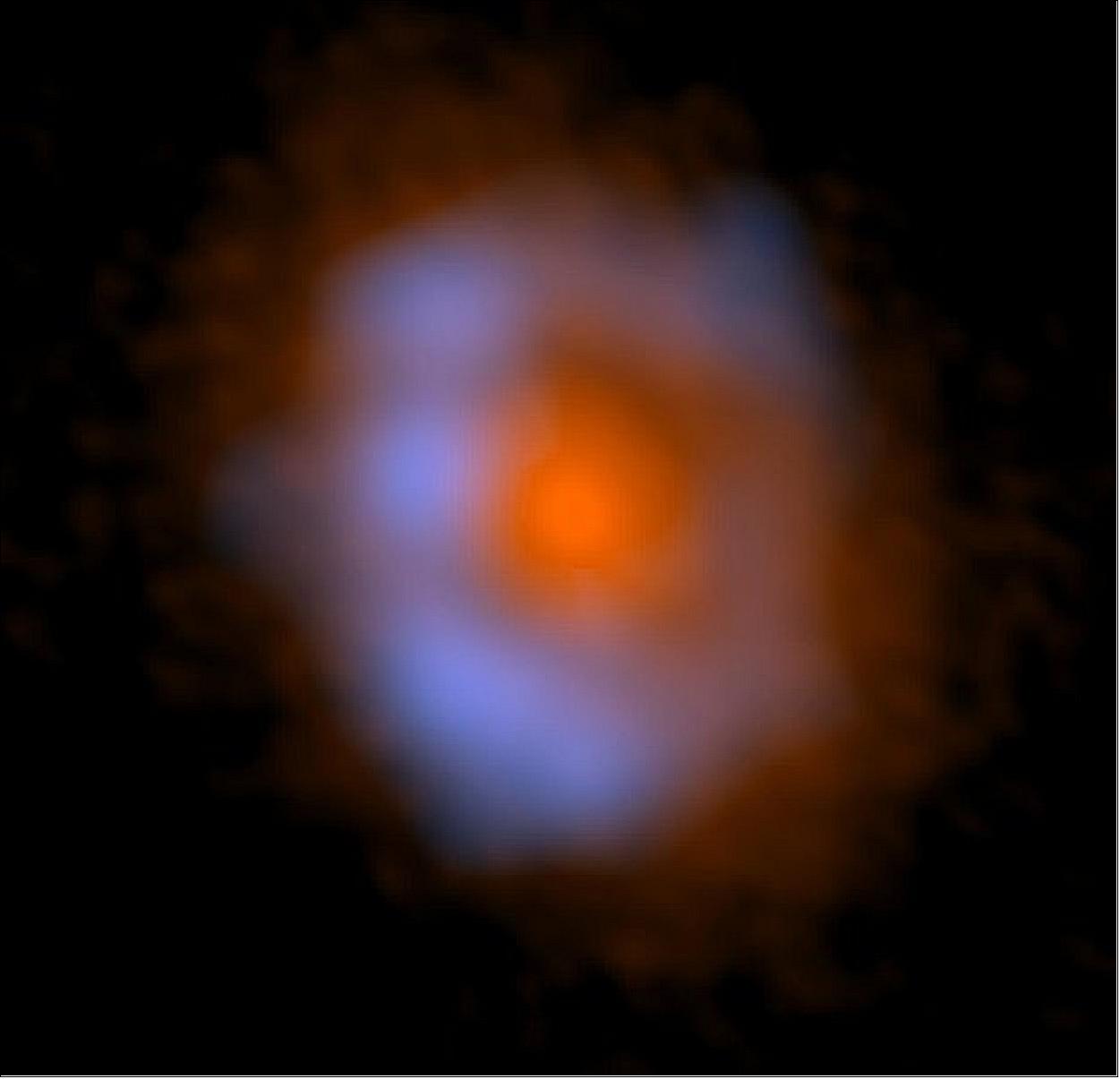
- V883 Ori is a young star located at 1300 light-years away from the Earth. This star is experiencing a so-called FU Orionis type outburst, a sudden increase of luminosity due to a bursting torrent of material flowing from the disk to the star. These outbursts last only on the order of 100 years, therefore the chance to observe a burst is rather rare. However, since young stars with a wide range of ages experience FU Ori bursts, astronomers expect to be able to trace the chemical composition of ice throughout the evolution of young stars. 141)
• January 21, 2019: Including the powerful ALMA into an array of telescopes for the first time, astronomers have found that the emission from the supermassive black hole Sagittarius A* (Sgr A*) at the center of our Galaxy comes from a smaller region than previously thought. This may indicate that a radio jet from Sgr A* is pointed almost directly towards the Earth. 142) 143) 144)
- So far, a foggy cloud of hot gas has prevented astronomers from making sharp images of the supermassive black hole Sgr A* and causing doubt on its true nature. They have now included for the first time the powerful ALMA telescope in northern Chile into a global network of radio telescopes to peer through this fog, but the source keeps surprising them: its emission region is so small that the source may actually have to point directly at the direction of the Earth.
- Observing at a frequency of 86 GHz with the technique of VLBI (Very Long Baseline Interferometry), which combines many telescopes to form a virtual telescope the size of the Earth, the team succeeded in mapping out the exact properties of the light scattering blocking our view of Sgr A*. To remove the scattering and obtain the image, the team used a technique developed by Michael Johnson of the Harvard-Smithsonian Center for Astrophysics (CfA). "Even though scattering blurs and distorts the image of Sgr A*, the incredible resolution of these observations allowed us to pin down the exact properties of the scattering,” says Johnson. “We could then remove most of the effects from scattering and begin to see what things look like near the black hole”.
- The high quality of the unscattered image (Figure 106) has allowed the team to constrain theoretical models for the gas around Sgr A*. The bulk of the radio emission is coming from a region of a small size: a mere 300 millionth of an arc degree. “This may indicate that the radio emission is produced in a disk of infalling gas rather than by a radio jet,” explains Issaoun, who has tested several computer models against the data. “However, that would make Sgr A* an exception compared to other radio emitting black holes. The alternative could be that the radio jet is pointing almost at us”.
- The German astronomer Heino Falcke, Professor of Radio Astronomy at Radboud University and PhD supervisor of Issaoun, calls this statement very unusual, but he also no longer rules it out. Last year, Falcke would have considered this a contrived model, but recently the GRAVITY team came to a similar conclusion using ESO’s Very Large Telescope Interferometer of optical telescopes and an independent technique. “Maybe this is true after all”, concludes Falcke, “and we are looking at this beast from a very special vantage point.”
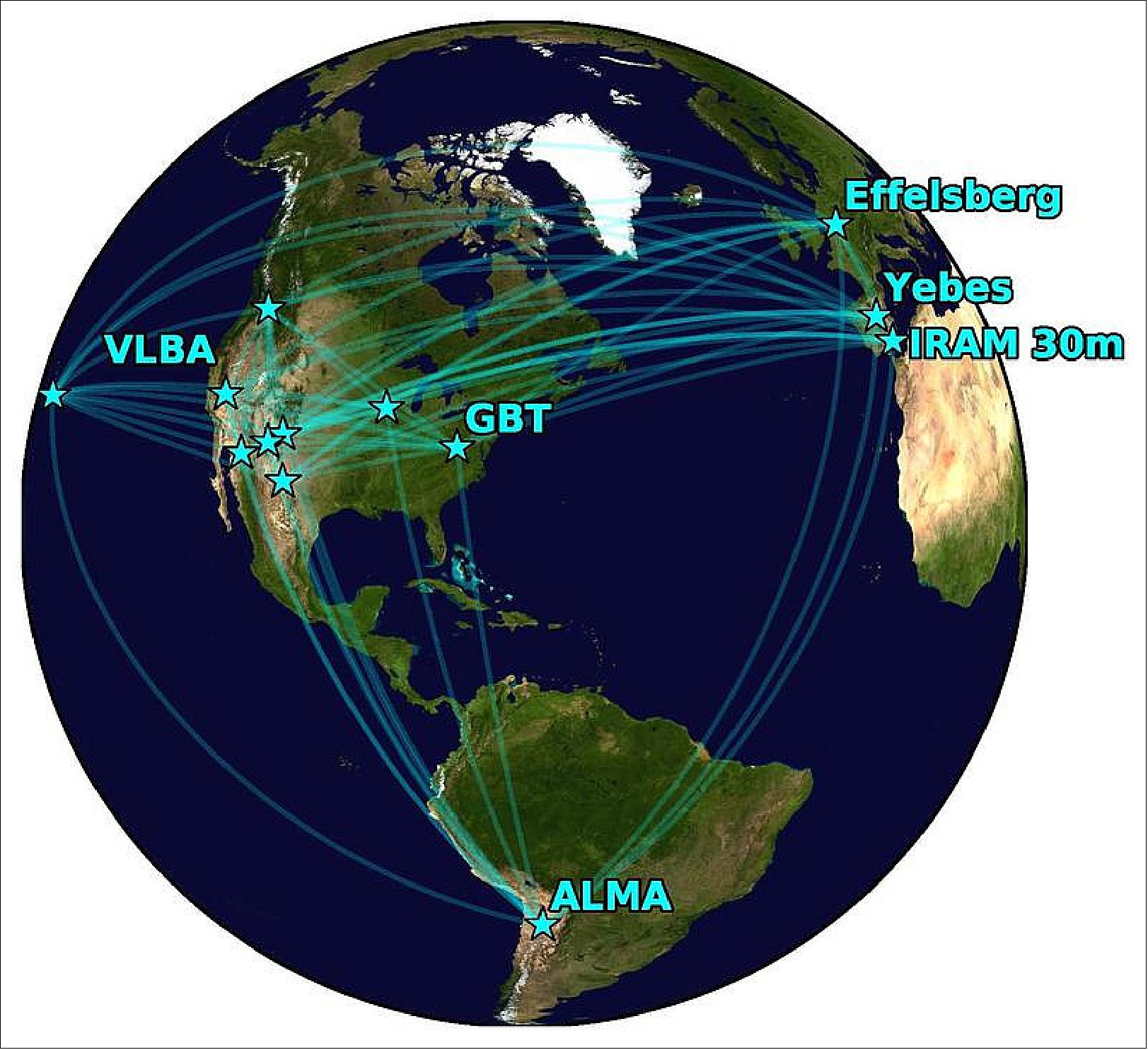
Legend to Figure 105: The data were correlated at the Max Planck Institute for Radio Astronomy (MPIfR), which also operates the Global Millimeter-VLBI Array (GMVA). Data analysis software was developed at the MIT Haystack Observatory and the Smithsonian Astrophysical Observatory. Several members of the team worked in this project as part of the European Research Council funded BlackHoleCam (BHC) team. The research team is also part of the Event Horizon Telescope (EHT) consortium, an international partnership of thirteen institutes from ten countries: Germany, the Netherlands, France & Spain (via IRAM), USA, Mexico, Japan, Taiwan, Canada and China (via EAO). The participation of ALMA (Atacama Large Millimeter/submillimeter Array) through the ALMA Phasing Project has been decisive for the success of this project. The GMVA is partially supported by the European Union’s Horizon 2020 research and innovation program under grant agreement No. 730562.
- Supermassive black holes are common in the centers of galaxies and may generate the most energetic phenomena in the known universe. It is believed that, around these black holes, matter falls in a rotating disk and part of this matter is expelled in opposite directions along two narrow beams, called jets, at speeds close to the speed of light, which typically produces a lot of radio light. “Whether the radio emission seen from SgrA* originates from a symmetrical underlying structure, or is intrinsically asymmetric is a matter of intense discussion”, explains Thomas Krichbaum, member of the team.
- Sgr A* is the nearest supermassive black hole and 'weighs' about 4 million solar masses. Its apparent size on the sky is less than a 100 millionth of an arc degree, which corresponds to the size of a tennis ball on the moon as seen from the Earth. “The black hole is so small that only VLBI can provide the angular resolution needed to resolve its structure”, says Pablo Torne, astronomer in support on the observations from the IRAM 30-meter telescope. “The first observations of Sgr A* at 86 GHz date from 26 years ago, with only a handful of telescopes. Over the years, the quality of the data has improved steadily as more telescopes join,” adds J. Anton Zensus, director of the Max Planck Institute for Radio Astronomy and head of its Radio Astronomy/VLBI division.
- The findings of Issaoun and her international team including scientists from two research departments (Kramer & Zensus) at MPIfR describe the first observations at 86 GHz in which ALMA also participated, by far the most sensitive telescope at this frequency. ALMA became part of the Global Millimeter VLBI Array (GMVA), which is operated by the Max Planck Institute for Radio Astronomy, in April 2017. The participation of ALMA, made possible by the ALMA Phasing Project effort, has been decisive for the success of this project.
- The participation of ALMA in mm-VLBI is important because of its sensitivity and its location in the southern hemisphere. In addition to ALMA, twelve radio telescopes in North America and Europe also participated in the network. The resolution achieved was twice as large as in previous observations at this frequency and produced the first image of Sgr A* that is considerably reduced in interstellar scattering (an effect caused by density irregularities in the ionized material along the line of sight between Sgr A* and the Earth).
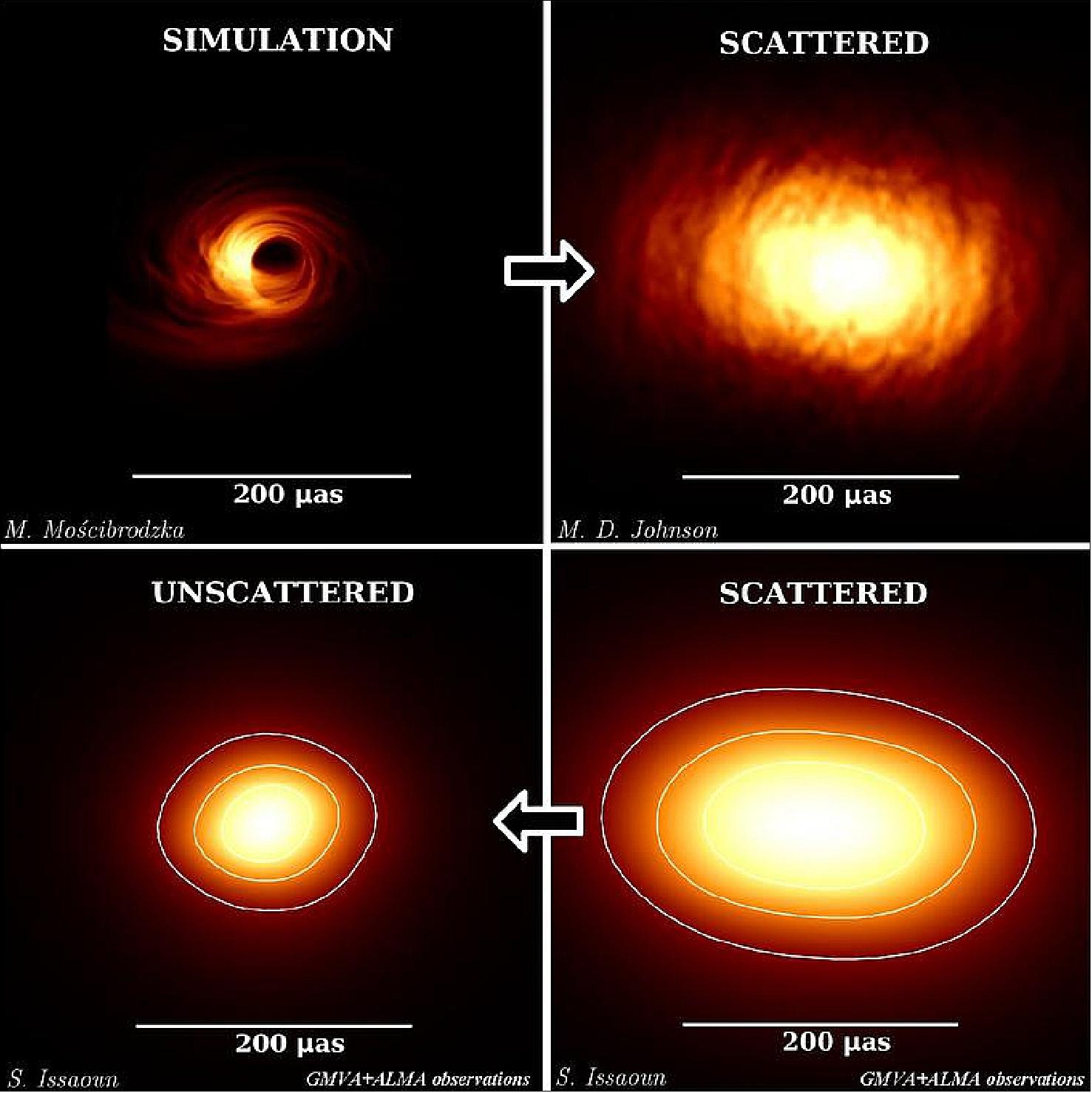
• January 24, 2019: Using the ALMA observatory in Chile, a group of astronomers led by MPIA’s (Max Planck Institute for Astronomy, Heidelberg), Henrik Beuther has made the most detailed observation yet of the way that a giant gas cloud fragments into dense cores, which then act as the birthplaces of stars. The astronomers found that the mechanisms for fragmentation are fairly straightforward, resulting from the combination of the cloud’s pressure and gravity. More complex features, such as magnetic lines or turbulence, play a smaller role than previously thought. 145) 146)
- Stars are born when giant clouds of gas and dust collapse. Whenever one of the collapsing regions becomes hot and dense enough for nuclear fusion to set in, a star is born. For massive stars, i.e. those stars that exhibit more than eight times the mass of the Sun, that is only part of the picture, though. The biggest stars in the Universe are not born singly. They are born from massive clouds of molecular gas, which then form a cascade of fragments, with many of the fragments giving birth to a star.
- Astronomers have long wondered whether this fragmentation-mode of forming stars requires different physical mechanisms than for lower-mass stars. Proposals include turbulent gas motion, which could destabilize a region and lead to quicker collapse, or magnetic fields that could stabilize and thus delay collapse.
- The different mechanisms should leave tell-tale traces in regions where multiple stars are forming. The collapse that leads to the formation of high-mass stars takes place on a hierarchy of different levels. On the largest scales, star formation involves giant molecular clouds, which consist mostly of hydrogen gas and can reach sizes between a few dozen and more than a hundred light-years across. Within those clouds are slightly denser clumps, typically a few light-years across. Each clump contains one or more dense cores, less than a fifth of a light-year in diameter. Within each core, collapse leads to the formation of either a single star or multiple stars. Together, the stars produced in the cores of a single clump will form a star cluster.
Tell-tale scales of fragmentation
- The scales of this fragmentation at multiple levels depend on the mechanisms involved. The simplest model can be written down using no more than high school physics: An ideal gas has a pressure that depends on its temperature and density. In a simplified gas cloud, assumed to have constant density, that pressure must be strong enough everywhere to balance the force of gravity (given by Newton’s law of gravity) – even in the center of the cloud, where the inward gravitation-induced push of all the surrounding matter is strongest. Write this condition down, and you will find that any such constant-density cloud can only have a maximum size. If a cloud is larger than this maximum, which is called the Jeans length, the cloud will fragment and collapse.
- Is the fragmentation of young massive clusters really dominated by these comparatively straightforward processes? It doesn’t need to be, and some astronomers have constructed much more complex scenarios, which include the influence of turbulent gas motion and magnetic field lines. These additional mechanisms change the conditions for cloud stability, and typically increase the scales of the different types of fragment.
- Different predictions for cloud sizes offer a way of testing the simple physics scenario against its more complex competitors. That is what Henrik Beuther and his colleagues set out to do when they observed the star formation region G351.77-0.54 in the Southern constellation Scorpius (The Scorpion). Previous observations had indicated that in this region, fragmentation could be caught in the act. But none of these observations had been powerful enough to show the smallest scale of interest for answering the question of fragmentation scales: the protostellar cores, let alone their sub-structure.
ALMA takes the most detailed look yet
- Beuther and his colleagues were able to do more. They used the ALMA Observatory in the Atacama Desert in Chile. ALMA combines the simultaneous observations of up to 66 radio telescopes to achieve a resolution of down to 20 milli-arcseconds, which allows astronomers to discern details more than ten times smaller than with any previous radio telescope, and at unrivalled sensitivity – a combination that has already led to a number of breakthrough observations also in other fields.
- Beuther and his colleagues used ALMA to study the high-mass star-forming region G351.77-0.54 down to sub-core scales smaller than 50 astronomical units (in other words, less than 50 times the average distance between the Earth and the Sun). As Beuther says: “This is a prime example of how technology drives astronomical progress. We could not have obtained our results without the unprecedented spatial resolution and sensitivity of ALMA.”
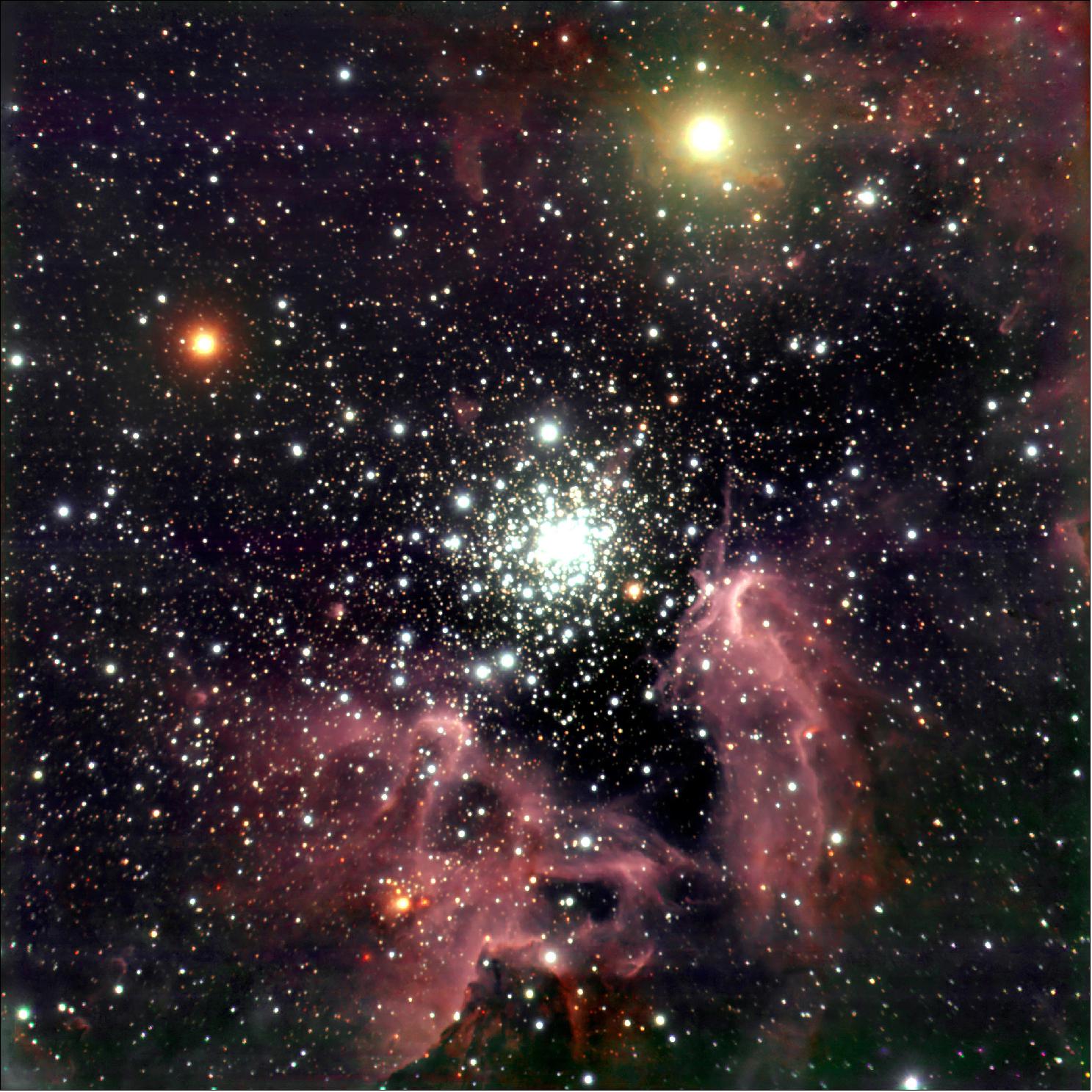
- Their results, together with earlier studies of the same cloud at larger scales, indicate that thermal gas physics is winning the day, even when it comes to very massive stars: Both the sizes of clumps within the cloud and, as the new observations show, of cores within the clumps and even of some core substructures are as predicted by Jeans length calculations, with no need for additional ingredients. Beuther comments: “In our case, the same physics provides a uniform description. Fragmentation from the largest to the smallest scales seems to be governed by the same physical processes.”
Small accretion disks: a new challenge
- Simplicity is always a boon for scientific descriptions. However, the same observations also provided a discovery that will keep astronomers on their collective toes. In addition to studying fragmentation, Beuther et al. had been looking to unravel the structure of nascent stars (“protostars”) within the cloud. Astronomers expect such a protostar to be surrounded by a swirling disk of gas, called the accretion disk. From the inner disk of the rim, gas falls onto the growing star, increasing its mass. In addition, magnetic fields produced by the motion of ionized gas and the gas itself interact to produce tightly focused streams called jets, which shoot out some of the matter into space perpendicular to that disk. Submillimeter light from those regions carries tell-tale signs (“Doppler-broadening of spectral lines”) of the motion of dust, which in turn traces the motion of gas. But where Beuther and his collaborators had hoped for a clear signature from an accretion disk, instead, he found mainly the signature of jets, cutting a comparatively smooth path through the surrounding gas. Evidently, the accretion disks are even smaller than astronomers had expected – a challenge for future observations at even greater spatial resolution.
• January 15, 2019: New research led by an astronomer at the University of Warwick has found the first confirmed example of a double star system that has flipped its surrounding disc to a position that leaps over the orbital plane of those stars. The international team of astronomers used ALMA (Atacama Large Millimeter/sub-millimeter Array) to obtain high-resolution images of the Asteroid belt-sized disc. 147)
- The overall system presents the unusual sight of a thick hoop of gas and dust circling at right angles to the binary star orbit. Until now this setup only existed in theorists’ minds, but the ALMA observation proves that polar discs of this type exist, and may even be relatively common.
- The new research is published 14 January by Royal Society University Research Fellow Dr Grant M. Kennedy of the University of Warwick's Department of Physics and Center for Exoplanets and Habitability in Nature Astronomy in a paper entitled "A circumbinary protoplanetary disc in a polar configuration". 148)
- Dr Grant M. Kennedy of the University of Warwick said: "Discs rich in gas and dust are seen around nearly all young stars, and we know that at least a third of the ones orbiting single stars form planets. Some of these planets end up being misaligned with the spin of the star, so we've been wondering whether a similar thing might be possible for circumbinary planets. A quirk of the dynamics means that a so-called polar misalignment should be possible, but until now we had no evidence of misaligned discs in which these planets might form."
- Dr Kennedy and his fellow researchers used ALMA to pin down the orientation of the ring of gas and dust in the binary star system HD 98800 . The orbit of the binary was previously known, from observations that quantified how the stars move in relation to each other. By combining these two pieces of information they were able to establish that the dust ring was consistent with a perfectly polar orbit. This means that while the stellar orbits orbit each other in one plane, like two horses going around on a carousel, the disc surrounds these stars at right angles to their orbits, like a giant ferris wheel with the carousel at the center
- Kennedy added: "Perhaps the most exciting thing about this discovery is that the disc shows some of the same signatures that we attribute to dust growth in discs around single stars. We take this to mean planet formation can at least get started in these polar circumbinary discs. If the rest of the planet formation process can happen, there might be a whole population of misaligned circumbinary planets that we have yet to discover, and things like weird seasonal variations to consider."
- If there were a planet or planetoid present at the inner edge of the dust ring, the ring itself would appear from the surface as a broad band rising almost perpendicularly from the horizon. The polar configuration means that the stars would appear to move in and out of the disc plane, giving objects two shadows at times. Seasons on planets in such systems would also be different. On Earth they vary throughout the year as we orbit the Sun. A polar circumbinary planet would have seasons that also vary as different latitudes receive more or less illumination throughout the binary orbit.
- Future studies at different wavelengths will provide complementary information and further observational constraints for this source, which holds the key to a better understanding of black holes, the most exotic objects in the known universe.
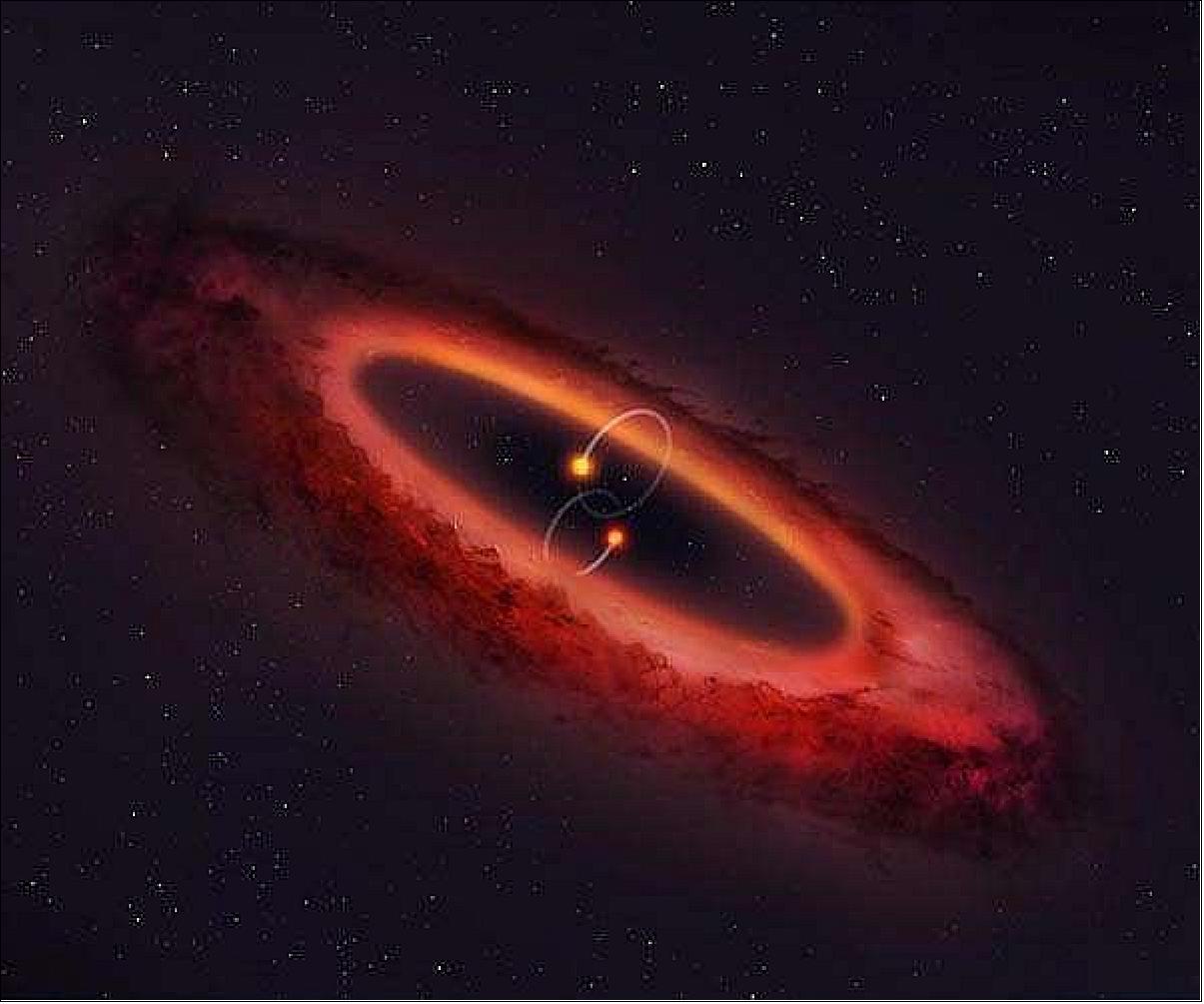
- Co-author Dr Daniel Price of Monash University’s Center for Astrophysics (MoCA) and School of Physics and Astronomy added:“We used to think other solar systems would form just like ours, with the planets all orbiting in the same direction around a single sun. But with the new images we see a swirling disc of gas and dust orbiting around two stars. It was quite surprising to also find that that disc orbits at right angles to the orbit of the two stars. Incredibly, two more stars were seen orbiting that disc. So if planets were born here there would be four suns in the sky! ALMA is just a fantastic telescope, it is teaching us so much about how planets in other solar systems are born.”
• January 10, 2019: Galaxies come in a wide variety of shapes and sizes. Some of the most significant differences among galaxies, however, relate to where and how they form new stars. Compelling research to explain these differences has been elusive, but that is about to change. 149)
- A vast, new research project with the ALMA (Atacama Large Millimeter/submillimeter Array), known as PHANGS-ALMA (Physics at High Angular Resolution in Nearby GalaxieS), delves into this question with far greater power and precision than ever before by measuring the demographics and characteristics of a staggering 100,000 individual stellar nurseries spread throughout 74 galaxies.
- PHANGS-ALMA, an unprecedented and ongoing research campaign, has already amassed a total of 750 hours of observations and given astronomers a much clearer understanding of how the cycle of star formation changes, depending on the size, age, and internal dynamics of each individual galaxy. This campaign is 10 to 100 times more powerful (depending on your parameters) than any prior survey of its kind.
- "Some galaxies are furiously bursting with new stars while others have long ago used up most of their fuel for star formation. The origin of this diversity may very likely lie in the properties of the stellar nurseries themselves," said Erik Rosolowsky, an astronomer at the University of Alberta in Canada and a co-principal investigator of the PHANGS-ALMA research team.
- He presented initial findings of this research at the 233rd meeting of the American Astronomical Society being held this week in Seattle, Washington. Several papers based on this campaign have also been published in the Astrophysical Journal and the Astrophysical Journal Letters. 150) 151) 152)
- "Previous observations with earlier generations of radio telescopes provide some crucial insights about the nature of cold, dense stellar nurseries," Rosolowsky said. - "These observations, however, lacked the sensitivity, fine-scale resolution, and power to study the entire breadth of stellar nurseries across the full population of local galaxies. This severely limited our ability to connect the behavior or properties of individual stellar nurseries to the properties of the galaxies that they live in."
- For decades, astronomers have speculated that there are fundamental differences in the way disk galaxies of various sizes convert hydrogen into new stars. Some astronomers theorize that larger, and generally older galaxies, are not as efficient at stellar production as their smaller cousins.
- The most logical explanation would be that these big galaxies have less efficient stellar nurseries. But testing this idea with observations has been difficult.
![Figure 109: The ALMA telescope is conducting an unprecedented survey of nearby disk galaxies to study their stellar nurseries. With it, astronomers are beginning to unravel the complex and as-yet poorly understood relationship between star-forming clouds and their host galaxies [image credit: ALMA (ESO/NAOJ/NRAO); NRAO/AUI/NSF, B. Saxton]](https://www.eoportal.org/ftp/satellite-missions/a/Alma_300622/Alma_Auto1.jpeg)
• January 1, 2019: Using observations from the ALMA radio observatory in Chile, researchers have observed, for the first time, a warped disk around an infant protostar that formed just several tens of thousands of years ago. This implies that the misalignment of planetary orbits in many planetary systems —including our own— may be caused by distortions in the planet-forming disk early in their existence. 153)
- The planets in our Solar System orbit the Sun in planes that are at most about seven degrees offset from the equator of the Sun itself. It has been known for some time that many extrasolar systems have planets that are not lined up in a single plane or with the equator of the star. One explanation for this is that some of the planets might have been affected by collisions with other objects in the system or by stars passing by the system, ejecting them from their initial orbital plane.
- However, the possibility remained that the formation of planets out of the normal plane was actually caused by a warping of the star-forming cloud out of which the planets were born. Recently, images of protoplanetary disks—rotating disks where planets form around a star—have in fact showed such warping. But it was still unclear how early this happened.
- In the latest findings, published in Nature, the group from the RIKEN Cluster for Pioneering Research (CPR) and Chiba University in Japan have discovered that L1527; an infant protostar still embedded within a cloud, has a disk that has two parts —an inner one rotating in one plane, and an outer one in a different plane. The disk is very young and still growing. L1527, which is about 450 light-years away in the Taurus Molecular Cloud, is a good object for study as it has a disk that is nearly edge-on to our view. 154)
- According to Nami Sakai, who led the research group, “This observation shows that it is conceivable that the misalignment of planetary orbits can be caused by a warp structure formed in the earliest stages of planetary formation. We will have to investigate more systems to find out if this is a common phenomenon or not.”
- The remaining question is what caused the warping of the disk. Sakai suggests two reasonable explanations. “One possibility,” she says, “is that irregularities in the flow of gas and dust in the protostellar cloud are still preserved and manifest themselves as the warped disk. A second possibility is that the magnetic field of the protostar is in a different plane from the rotational plane of the disk, and that the inner disk is being pulled into a different plane from the rest of the disk by the magnetic field.” She says they plan further work to determine which is responsible for the warping of the disk.
- The ALMA observatory in Chile is managed by an international consortium including the National Astronomical Observatory of Japan (NAOJ).
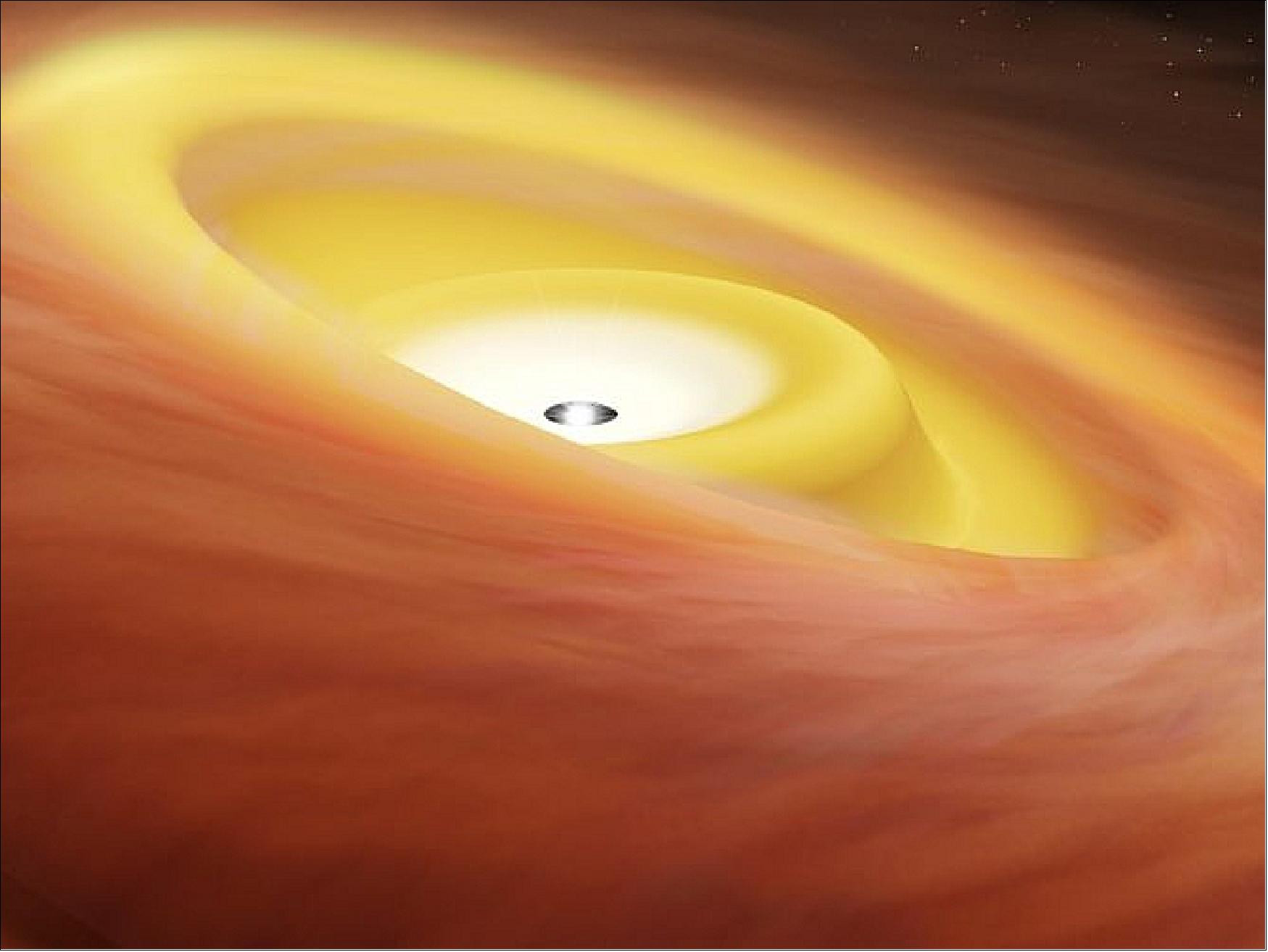
References
1) ”Atacama Large Millimeter/submillimeter Array,” ALMA, URL: http://www.almaobservatory.org/en/about-alma/global-collaboration
2) http://www.almaobservatory.org/en/home
3) ”ALMA - Exploring the Universe at Millimeter Wavelength,” ALMA brochure, 2007, URL: http://www.almaobservatory.org/images/pdfs/alma_brochure_explore_2007.pdf
4) ”ALMA through the years,” ALMA, URL: http://www.almaobservatory.org/en/about-alma/origins-of-the-alma-project/timeline
5) http://www.almaobservatory.org/
6) “ALMA Opens Its Eyes,” Space Daily, Oct. 4, 2011, URL: http://www.spacedaily.com/reports/ALMA_Opens_Its_Eyes_999.html
7) “ALMA Inauguration Heralds New Era of Discovery,” ESO, Release eso1312, March 13, 2013, URL: http://www.eso.org/public/news/eso1312/
8) “Final ALMA Antenna Arrives on Chajnantor Plateau,”Space Daily, June 19, 2014, URL: http://www.spacedaily.com/reports/Final_ALMA_Antenna_Arrives_on_Chajnantor_Plateau_999.html
9) ”Final ALMA Antenna Arrives on the Chajnantor Plateau,” ALMA, June 16, 2014, URL: http://www.almaobservatory.org/en/press-room/announcements-events/709-final-alma-antenna-arrives-on-the-chajnantor-plateau
10) ”ALMA Gains New Capability in its First VLBI Observation,” ALMA, March 5, 2015, URL: http://www.almaobservatory.org/en/press-room/announcements-events/813-alma-gains-new-capability-in-its-first-successful-long-baseline-observation-
11) “ALMA Greatly Improves Capacity to Search for Water in Universe,” ESO, July 17, 2015, URL: http://www.eso.org/public/announcements/ann15059/
12) ”In search of our cosmic origins -The Construction of the Atacama Large Millimeter / submillimeter Ar ray,” ALMA photobook, 2013, URL: http://www.almaobservatory.org/docs/alma-photobook.pdf
13) ”First Observations from SEPIA -New APEX instrument for finding water in the Universe,” ESO 1543 Organization Release, Nov. 4, 2015: URL: https://www.eso.org/public/news/eso1543/
14) ”ALMA Sets Development Objectives for the Next Decade,” ALMA, 12 July 2018, URL: http://www.almaobservatory.org/en/announcement/alma-sets-development-objectives-for-the-next-decade/
15) http://www.almaobservatory.org/en/about-alma/how-does-alma-work/technology/antennas
16) ”Final ACA Antenna Delivered: The 'Morita Array',” ALMA Press Release, May 7, 2013, URL: http://www.almaobservatory.org/en/press-room/press-releases/566-final-aca-antenna-delivered-the-morita-array
17) ”The final ALMA antenna arrives at Chajnantor,” ALMA partnership, June 16, 2014, URL: http://www.eso.org/public/images/ann14048a/
18) https://almascience.nrao.edu/about-alma/alma-site
19) Front End,” ALMA, URL: http://www.almaobservatory.org/en/about-alma/how-does-alma-work/technology/front-end
20) Gie Han Tan, ”The ALMA Front Ends; an Overview,” 19th International Symposium on Space Terahertz Technology, Groningen, 28-30 April 2008, URL: http://www.nrao.edu/meetings/isstt/papers/2008/2008237243.pdf
21) ”Back End and Correlator,” ALMA, URL: http://www.almaobservatory.org/en/about-alma/how-does-alma-work/technology/back-end-and-correlator
22) Alain Baudry, Fabio Biancat Marchet, Hervé Kurlandcyk, Silvio Rossi, ”The ALMA Back-End,” 2008, URL: https://www.eso.org/sci/publications/messenger/archive/no.125-sep06/messenger-no125-37-40.pdf
23) ALMA Newsletter No. 5, April 2010, URL: http://www.almaobservatory.org/science_articles/05_how_will_alma_make_images.pdf
24) ”ALMA Band 2 Contracts Signed,” ESO, 15 May 2020, URL: https://www.eso.org/sci/facilities/alma/news/announcements/alma-ann1808.html
25) ”ALMA Links with Other Observatories to Create Earth-size Telescope,” ALMA, Nov. 10, 2015, URL: http://www.almaobservatory.org/en/press-room/announcements-events/900-alma-links-with-other-observatories-to-create-earth-size-telescope
26) Luke Maud1Eric Villard, Satoko Takahashi, Yoshiharu Asaki, Tim Bastian, Paulo Cortes, Geoff Crew, Ed Fomalont, Antonio Hales, Shun Ishii, Lynn Matthews, Hugo Messias, Hiroshi Nagai, Tsuyoshi Sawada, Gerald Schieven, Masumi Shimojo, Baltasar Vila-Vilaro, Andy Biggs, Dirk Petry,Neil Phillips, Rosita Paladino, ”Enhancing ALMA’s Future Observing Capabilities,” The Messenger 183, June 2021, URL: http://www.eso.org/sci/publications/messenger/archive/no.183-jun21/messenger-no183.pdf
27) https://www.eso.org/public/news/archive/year/2018/
28) http://www.almaobservatory.org/en/press-room/press-releases
29) ”Close Encounter More Than 10,000 Years Ago Stirred Up Spirals in an Accretion Disk,” ALMA Press Release, 18 June 2022, URL: https://www.almaobservatory.org/en/press-releases/close-encounter-more-than-10000-years-ago-stirred-up-spirals-in-an-accretion-disk/
30) Xing Lu, Guang-Xing Li, Qizhou Zhang, and Yuxin Lin, ”A massive Keplerian protostellar disk with flyby-induced spirals in the Central Molecular Zone,” Nature Astronomy, Published: 30 May 2022, https://doi.org/10.1038/s41550-022-01681-4
31) ”The Tarantula's cosmic web: astronomers map violent star formation in nebula outside our galaxy,” eso2209 — Photo Release, 15 June 2022, URL: https://www.eso.org/public/news/eso2209/?lang
32) Tony Wong, Luuk Oudshoorn, Eliyahu Sofovich, Alex Green, Charmi Shah, Rémy Indebetouw, Margaret Meixner, Alvaro Hacar, Omnarayani Nayak, Kazuki Tokuda, Alberto D. Bolatto, Mélanie Chevance, Guido De Marchi, Yasuo Fukui, Alec S. Hirschauer, K. E. Jameson, Venu Kalari, Vianney Lebouteiller, Leslie W. Looney, Suzanne C. Madden, Toshikazu Onishi, Julia Roman-Duva, Mónica Rubio, and A. G. G. M. Tielens, ”The 30 Doradus Molecular Cloud at 0.4 pc Resolution with the Atacama Large Millimeter/submillimeter Array: Physical Properties and the Boundedness of CO-emitting Structures,” The Astrophysical Journal, Volume 932, Number 1, Published: 15 June 2022, https://doi.org/10.3847/1538-4357/ac723a, URL: https://iopscience.iop.org/article/10.3847/1538-4357/ac723a/pdf
33) ”A curled viper,” ESO Picture of the week, 6 June 2022, URL: https://www.eso.org/public/images/potw2223a/
34) ”Astronomers reveal first image of the black hole at the heart of our galaxy,” eso2208-eht-mw — Science Release, 12 May 2022, URL: https://www.eso.org/public/news/eso2208-eht-mw/
35) Geoffrey C. Bower (Project Scientist) for the Event Horizon Telescope Collaboration, ”Focus on First Sgr A* Results from the Event Horizon Telescope,” The Astrophysical Journal Letters, May 2022, https://iopscience.iop.org/journal/2041-8205/page/Focus_on_First_Sgr_A_Results
36) ”Comparison of the sizes of two black holes: M87* and Sagittarius A*,” eso2208-eht-mwe, 12 May 2022, URL: https://www.eso.org/public/images/eso2208-eht-mwe/
37) ”NASA Supports Event Horizon Telescope in Studying Milky Way’s Black Hole,” NASA/JPL News, 12 May 2022, URL: https://www.jpl.nasa.gov/news/nasa-supports-event-horizon-telescope-in-studying-milky-ways-black-hole?utm_source=iContact&utm_medium=email&utm_campaign=nasajpl&utm_content=universe20220512
38) ”Planet-forming disks evolve in surprisingly similar ways,” MPG, 6 May 2022, URL: https://www.mpg.de/18491330/planet-forming-disks-evolve-in-surprisingly-similar-ways
39) S. E. van Terwisga, A. Hacar, E. F. van Dishoeck, R. Oonk, S. Portegies Zwart, ”Survey of Orion Disks with ALMA (SODA) I: Cloud-level demographics of 873 protoplanetary disks,” https://arxiv.org/abs/2202.11057
40) ”Hey DUDE: Mysterious Death of Carbon Star Plays Out Like Six-Ring Circus,” ALMA Press Release, 28 March 2022, URL: https://www.almaobservatory.org/en/press-releases/hey-dude-mysterious-death-of-carbon-star-plays-out-like-six-ring-circus/
41) The original press release was published by the National Radio Astronomy Observatory (NRAO), an ALMA partner on behalf of North America.
42) R. Sahai, P-S. Huang, S. Scibelli, M. R. Morris, K. Hinkle, C-F. Lee, ”The Rapidly Evolving AGB Star, V Hya: ALMA finds a Multi-Ring Circus with High-Velocity Outflows, The Astrophysical Journal, ” Draft version February 21, 2022, https://doi.org/10.48550/arXiv.2202.09335, URL: https://arxiv.org/pdf/2202.09335.pdf
43) ”Astronomers discover largest molecule yet in a planet-forming disc,” eso2205 — Science Release, 8 March 2022, URL: https://www.eso.org/public/news/eso2205/
44) Nashanty G. C. Brunken, Alice S. Booth, Margot Leemker, Pooneh Nazari, Nienke van der Marel and Ewine F. van Dishoeck, ”A major asymmetric ice trap in a planet-forming disk,” Astronomy & Astrophysics, Volume 659, Published online: 8 March 2022, Article Number A29, https://doi.org/10.1051/0004-6361/202142981
45) ”ALMA catches “intruder” redhanded in rarely detected stellar flyby event,” ALMA Press Release, 13 January 2022, URL: https://www.almaobservatory.org/en/press-releases/alma-catches-intruder-redhanded-in-rarely-detected-stellar-flyby-event/
46) Ruobing Dong, Hauyu Baobab Liu, Nicolás Cuello, Christophe Pinte, Péter Ábrahám, Eduard Vorobyov, Jun Hashimoto, Ágnes Kóspál, Eugene Chiang, Michihiro Takami, Lei Chen, Michael Dunham, Misato Fukagawa, Joel Green, Yasuhiro Hasegawa, Thomas Henning, Yaroslav Pavlyuchenkov, Tae-Soo Pyo & Motohide Tamura, ”A likely flyby of binary protostar Z CMa caught in action,” Nature Astronomy, Published: 13 January 2022, https://doi.org/10.1038/s41550-021-01558-y
47) ”Astronomers make most distant detection yet of fluorine in star-forming galaxy,” eso2115 — Science Release, 4 November 2021, URL: https://www.eso.org/public/news/eso2115/?lang
48) M. Franco, K. E. K. Coppin, J. E. Geach, C. Kobayashi, S. C. Chapman, C. Yang, E. González-Alfonso, J. S. Spilker, A. Cooray & M. J. Michałowski, ”The ramp-up of interstellar medium enrichment at z > 4,” Nature Astronomy, Published: 04 November 2021, https://doi.org/10.1038/s41550-021-01515-9
49) ”ALMA Goes to New (Wave)lengths,” ann21012 — Announcement, 8 September 2021, URL: https://www.eso.org/public/announcements/ann21012/?lang
50) ”Scientists Observe Gas Re-accretion in Dying Galaxies for the First Time,” ALMA Press Release, 29 July 2021, URL: https://www.almaobservatory.org/en/press-releases/scientists-observe-gas-re-accretion-in-dying-galaxies-for-the-first-time/
51) William J. Cramer, Jeffrey D. P. Kenney, Stephanie Tonnesen, Rory Smith, Tony Wong, Pavel Jáchym, Juan R. Cortés, Paulo C. Cortés, Yu-Ting Wu, ”Molecular gas filaments and fallback in the ram pressure stripped Coma spiral NGC 4921,” Astrophysics of Galaxies, Paper submitted: 25 July 2021, https://arxiv.org/abs/2107.11731
52) ”Astronomers make first clear detection of a moon-forming disc around an exoplanet,” eso2111 — Science Release, 22 July 2021, URL: https://www.eso.org/public/news/eso2111/?lang
53) Myriam Benisty, Jaehan Bae, Stefano Facchini, Miriam Keppler, Richard Teague,Andrea Isella,Nicolas T. Kurtovic,Laura M. P érez, Anibal Sierra, Sean M. Andrews, John Carpenter, Ian Czekala, Carsten Dominik, Thomas Henning,Francois Menard, Paola Pinilla, and Alice Zurlo, ”A Circumplanetary Disk Around PDS70 c,” Draft version July 21, 2021, The Astrophysical Research Letters, URL: https://www.eso.org/public/archives/releases/sciencepapers/eso2111/eso2111a.pdf
54) ”Mind the Gap: Scientists Use Stellar Mass to Link Exoplanets to Planet-Forming Disks,” ALMA Press Release, 23 June 2021, URL: https://www.almaobservatory.org/en/press-releases/mind-the-gap-scientists-use-stellar-mass-to-link-exoplanets-to-planet-forming-disks/
55) ”Mind the Gap: Scientists Use Stellar Mass to Link Exoplanets to Planet-Forming Disks,” NRAO News, 23 June 2021, URL: https://public.nrao.edu/news/scientists-use-stellar-mass-to-link-exoplanets-to-protoplanetary-disks/
56) Nienke van der Marel, Gijs Mulders, ”A stellar mass dependence of structured disks: a possible link with exoplanet demographics,” Astrophysical Journal, Published: 23 June 2021, https://doi.org/10.3847/1538-3881/ac0255
57) Cosmic cartographers map nearby Universe revealing the diversity of star-forming galaxies,” NRAO News Release, 8 June 2021, URL: https://public.nrao.edu/news/alma-phangs-stellar-nursery-census/
58) Adam K. Leroy, Eva Schinnerer, Annie Hughes, Erik Rosolowsky, Jérôme Pety, Andreas Schruba, Antonio Usero, Guillermo A. Blanc, Mélanie Chevance, Eric Emsellem, Christopher M. Faesi, Cinthya N. Herrera, Daizhong Liu, Sharon E. Meidt, Miguel Querejeta, Toshiki Saito, Karin M. Sandstrom, Jiayi Sun, Thomas G. Williams, Gagandeep S. Anand, Ashley T. Barnes, Erica A. Behrens, Francesco Belfiore, Samantha M. Benincasa, Ivana Bešlić, Frank Bigiel, Alberto D. Bolatto, Jakob S. den Brok, Yixian Cao, Rupali Chandar, Jérémy Chastenet, I-Da Chiang, Enrico Congiu, Daniel A. Dale, Sinan Deger, Cosima Eibensteiner, Oleg V. Egorov, Axel García-Rodríguez, Simon C. O. Glover, Kathryn Grasha, Jonathan D. Henshaw, I-Ting Ho, Amanda A. Kepley, Jaeyeon Kim, Ralf S. Klessen, Kathryn Kreckel, Eric W. Koch, J. M. Diederik Kruijssen, Kirsten L. Larson, Janice C. Lee, Laura A. Lopez, Josh Machado, Ness Mayker, Rebecca McElroy, Eric J. Murphy, Eve C. Ostriker, Hsi-An Pan, Ismael Pessa, Johannes Puschnig, Alessandro Razza, Patricia Sánchez-Blázquez, Francesco Santoro, Amy Sardone, Fabian Scheuermann, Kazimierz Sliwa, Mattia C. Sormani, Sophia K. Stuber, David A. Thilker, Jordan A. Turner, Dyas Utomo, Elizabeth J. Watkins, Bradley Whitmore, ”PHANGS-ALMA: Arcsecond CO(2-1) Imaging of Nearby Star-Forming Galaxies,” Draft version April 30, 2021Typeset using LATEXtwocolumnstyle in AASTeX63, https://arxiv.org/abs/2104.07739, URL: https://arxiv.org/pdf/2104.07739.pdf
59) ”ALMA Discovers Rotating Infant Galaxy with Help of Natural Cosmic Telescope,” ALMA Press Release, 22 April 2021, URL: https://www.almaobservatory.org/en/press-releases/alma-discovers-rotating-infant-galaxy-with-help-of-natural-cosmic-telescope/
60) Seiji Fujimoto, Masamune Oguri, Gabriel Brammer, Yuki Yoshimura, Nicolas Laporte, Jorge González-López, Gabriel B. Caminha, Kotaro Kohno, Adi Zitrin, Johan Richard, Masami Ouchi, Franz E. Bauer, Ian Smail, Bunyo Hatsukade, Yoshiaki Ono, Vasily Kokorev, Hideki Umehata, Daniel Schaerer, Kirsten Knudsen, Fengwu Sun, Georgios Magdis, Francesco Valentino, Yiping Ao, Sune Toft, Miroslava Dessauges-Zavadsky, Kazuhiro Shimasaku, Karina Caputi, Haruka Kusakabe, Kana Morokuma-Matsui, Kikuchihara Shotaro, Eiichi Egami, Minju M. Lee, Timothy Rawle, Daniel Espada, ”ALMA Lensing Cluster Survey: Bright [CII] 158 µm Lines from a Multiply Imaged Sub-L* Galaxy at z=6.0719,” Astrophysical Journal, Draft Version January 7, 2021, URL: https://arxiv.org/pdf/2101.01937.pdf
61) ”Astronomers image magnetic fields at the edge of M87’s black hole,” eso2105 — Science Release, 24 March 2021, URL: https://www.eso.org/public/news/eso2105/?lang
62) The Event Horizon Telescope Collaboration, Kazunori Akiyama, Juan Carlos Algaba, Antxon Alberdi, Walter Alef, Richard Anantua, Keiichi Asada, Rebecca Azulay, Anne-Kathrin Baczko, David Ball, et al., ”First M87 Event Horizon Telescope Results. VII. Polarization of the Ring,” The Astrophysical Journal Letters, Volume 910, Number 1, Published: 24 March 2021, https://doi.org/10.3847/2041-8213/abe71d
63) ”Powerful stratospheric winds measured on Jupiter for the first time,” eso2104 — Science Release, 18 March 2021, URL: https://www.eso.org/public/news/eso2104/?lang
64) T. Cavalié, B. Benmahi, V. Hue, R. Moreno, E. Lellouch, T. Fouchet, P. Hartogh, L. Rezac, T. K. Greathouse, G. R. Gladstone, J. A. Sinclair, M. Dobrijevic, F. Billebaud1 and C. Jarchow, ”First direct measurement of auroral and equatorial jets in the stratosphere of Jupiter,” Astronomy & Astrophysics, Volume 647, Article Nimber L8, Published online: 18 March 2021, https://doi.org/10.1051/0004-6361/202140330, URL: https://www.aanda.org/articles/aa/pdf/2021/03/aa40330-21.pdf
65) ”Quasar Discovery Sets New Distance Record,” ALMA Press Release, 12 January 2021, URL: https://www.almaobservatory.org/en/press-releases/quasar-discovery-sets-new-distance-record/
66) Feige Wang, Jinyi Yang, Xiaohui Fan, Joseph F. Hennawi, Aaron J. Barth, Eduardo Banados, Fuyan Bian, Konstantina Boutsia, Thomas Connor, Frederick B. Davies, Roberto Decarli, Anna-Christina Eilers, Emanuele Paolo Farina, Richard Green, Linhua Jiang, Jiang-Tao Li, Chiara Mazzucchelli, Riccardo Nanni, Jan-Torge Schindler, Bram Venemans, Fabian Walter, Xue-Bing Wu, Minghao Yue, ”A Luminous Quasar at Redshift 7.642,” The Astrophysical Journal Letters, Volume 907, Number 1, Published: 14 January 2021, https://doi.org/10.3847/2041-8213/abd8c6
67) ”ALMA captures distant colliding galaxy dying out as it loses the ability to form stars,” ESO Press Release, eso2101 — Science Release, 11 January 2021, URL: https://www.eso.org/public/news/eso2101/?lang
68) Annagrazia Puglisi, Emanuele Daddi, Marcella Brusa, Frederic Bournaud, Jeremy Fensch, Daizhong Liu, Ivan Delvecchio, Antonello Calabrò, Chiara Circosta, Francesco Valentino, Michele Perna, Shuowen Jin, Andrea Enia, Chiara Mancini & Giulia Rodighiero, ”A titanic interstellar medium ejection from a massive starburst galaxy at redshift 1.4,” Nature Astronomy, Published: 11 January 2021, https://doi.org/10.1038/s41550-020-01268-x
69) ”ESO Director General awarded Order of Bernardo O’Higgins,” ESO ann20036 — Announcement, 16 December 2020, URL: https://www.eso.org/public/announcements/ann20036/?lang
70) ”Linda Tacconi Elected as Next ESO Council President,” ESO ann20035 — Announcement, 8 December 2020, URL: https://www.eso.org/public/announcements/ann20035/?lang
71) ”Fast-moving gas flowing away from young star's asteroid belt may be caused by icy comet vaporisation,” Cambridge University, 30 November 2020, URL: https://www.ast.cam.ac.uk/content/fast-moving.gas.flowing.away.young.stars.asteroid.belt.may.be.caused.icy.comet.vaporisation
72) J. B. Lovell, M. C. Wyatt, M. Ansdell, M. Kama, G. M. Kennedy, C. F. Manara, S. Marino, L. Matrà, G. Rosotti, M. Tazzari, L. Testi, J. P. Williams, ”ALMA Survey of Lupus Class III Stars: Early Planetesimal Belt Formation and Rapid Disk Dispersal,” MNRAS, staa3335, Published: 28 October 2020, https://doi.org/10.1093/mnras/staa3335
73) ”A planet-forming disk still fed by the mother cloud,” MPE, 23 November 2020, URL: https://www.mpe.mpg.de/7529173/news20201123
74) Felipe O. Alves, L. Ilsedore Cleeves, Josep M. Girart, Zhaohuan Zhu, Gabriel A. P. Franco, Alice Zurlo, and Paola Caselli, ”A Case of Simultaneous Star and Planet Formation,” The Astrophysical Journal Letters, Volume 904, Number 1, Published: 19 November 2020, https://doi.org/10.3847/2041-8213/abc550
75) ”ALMA shows volcanic impact on Io's atmosphere,” ALMA Press Release, 21 October 2020, URL: https://www.almaobservatory.org/en/press-releases/alma-shows-volcanic-impact-on-ios-atmosphere/
76) ”Stars and Planets Grow Up Together as Siblings, ALMA shows rings around the still-growing proto-star IRS 63,” MPG, 7 October 2020, URL: https://www.mpg.de/15481384/stars-and-planets-grow-up-together-as-siblings
77) Dominique M. Segura-Cox, Anika Schmiedeke, Jaime E. Pineda, Ian W. Stephens, Manuel Fernández-López, Leslie W. Looney, Paola Caselli, Zhi-Yun Li, Lee G. Mundy, Woojin Kwon, Robert J. Harris, ”Four annular structures in a protostellar disk less than 500,000 years old,” Nature, Volume 586, pp:228-231, Published: 7 October 2020, https://doi.org/10.1038/s41586-020-2779-6
78) ”Astronomers Capture Stellar Winds in Unprecedented Detail,” ALMA, 18 September 2020, URL: https://www.almaobservatory.org/en/audiences/astronomers-capture-stellar-winds-in-unprecedented-detail/
79) L. Decin, M. Montargès, A. M. S. Richards, C. A. Gottlieb, W. Homan, I. McDonald, I. El Mellah, T. Danilovich, S. H. J. Wallström, A. Zijlstra, A. Baudry, J. Bolte, E. Cannon, E. De Beck, F. De Ceuster, A. de Koter, J. De Ridder, S. Etoka, D. Gobrecht, M. Gray, F. Herpin, M. Jeste, E. Lagadec, P. Kervella, T. Khouri, K. Menten, T. J. Millar, H. S. P. Müller, J. M. C. Plane, R. Sahai, H. Sana, M. Van de Sande, L. B. F. M. Waters, K. T. Wong, J. Yates, ”(Sub)stellar companions shape the winds of evolved stars,” Science Report, Vol. 369, Issue 6510, pp. 1497-1500, Published: 18 September 2020, https://doi.org/10.1126/science.abb1229
80) ”Astronomers capture stellar winds in unprecedented detail,” KU Leuven News, 17 September, 2020, URL: https://nieuws.kuleuven.be/en/content/2020/astronomers-capture-stellar-winds-in-unprecedented-detail
81) ”ALMA sees most distant Milky Way look-alike,” eso2013 — Science Release, 12 August 2020, URL: https://www.eso.org/public/news/eso2013/?lang
82) F. Rizzo, S. Vegetti, D. Powell, F. Fraternali, J. P. McKean, H. R. Stacey & S. D. M. White, ”A dynamically cold disk galaxy in the early Universe,” Nature, Vol. 584, pp: 201-204, Published: 12 August 2020, https://doi.org/10.1038/s41586-020-2572-6
83) ”2020 July Status of ALMA,” ESO, 9 July 2020, URL: https://www.eso.org/sci/facilities/alma/news/announcements/alma-ann1814.html
84) ”Stellar fireworks celebrate birth of giant cluster,” ALMA, 2 July 2020, URL: https://www.almaobservatory.org/en/audiences/stellar-fireworks-celebrate-birth-of-giant-cluster/
85) Yu Cheng, Jonathan C. Tan, Mengyao Liu, Wanggi Lim, and Morten Andersen, ”Gas Kinematics of the Massive Protocluster G286.21+0.17 Revealed by ALMA,” The Astrophysical Journal, Volume 894, Number 2, Published: 8 May 2020, https://doi.org/10.3847/1538-4357/ab879f
86) Yu Cheng, Morten Andersen, and Jonathan Tan, ”Stellar variability in a forming massive star cluster,” accepted in The Astrophysical Journal. Preprint: https://arxiv.org/abs/2005.08198
87) ”The cosmic commute towards star and planet formation,” MPIA News, 06 July 2020, URL: https://www.mpia.de/news/science/2020-08-cosmic-commute
88) Jonathan D. Henshaw, J. M. Diederik Kruijssen, Steven N. Longmore, Manuel Riener, Adam K. Leroy, Erik Rosolowsky, Adam Ginsburg , Cara Battersby, Mélanie Chevance, Sharon E. Meidt, Simon C. O. Glover, Annie Hughes, Jouni Kainulainen, Ralf S. Klessen, Eva Schinnerer, Andreas Schruba, Henrik Beuther, Frank Bigiel, Guillermo A. Blanc, Eric Emsellem, Thomas Henning, Cynthia N. Herrera, Eric W. Koch, Jérôme Pety, Sarah E. Ragan and Jiayi Sun, ”Ubiquitous velocity fluctuations throughout the molecular interstellar medium,” Nature Astronomy Letters, Volume 157, Published: 06 July 2020, https://doi.org/10.1038/s41550-020-1126-z, URL: https://www.mpg.de/15117430/41550_2020_1126_onlinepdf.PDF
89) ”Supergiant Atmosphere of Antares Revealed by Radio Telescopes,” ALMA Press Release, 16 June 2020, URL: https://www.almaobservatory.org/en/press-releases/supergiant-atmosphere-of-antares-revealed-by-radio-telescopes/
90) E. O’Gorman, G. M. Harper, K. Ohnaka, A. Feeney-Johansson, K. Wilkeneit-Braun, A. Brown, E. F. Guinan, J. Lim, A. M. S. Richards, N. Ryde and W. H. T. Vlemmings, ”ALMA and VLA reveal the lukewarm chromospheres of the nearby red supergiants Antares and Betelgeuse,” Astronomy & Astrophysics, Volume 638, June 2020, Article No A65, Published: 16 June 2020, https://doi.org/10.1051/0004-6361/202037756
91) ”Close-up view reveals binary proto-stars in the process of assemblage,” MPE News, 9 June 2020, URL: http://www.mpe.mpg.de/7456250/news20200609
92) Maria Jose Maureira, Jaime E. Pineda, Dominique M. Segura-Cox, Paola Caselli, Leonardo Testi, Giuseppe Lodato, Laurent Loinard, Antonio Hernandez-Gomez, ”Orbital and mass constraints of the young binary system IRAS 16293-2422,” Journal of Astrophysics, Draft version May 26, 2020, URL: https://arxiv.org/pdf/2005.11954.pdf
93) ”ALMA Spots Twinkling Heart of Milky Way,” NAOJ, 22 May 2020, URL: https://www.nao.ac.jp/en/news/science/2020/20200522-alma.html
94) Yuhei Iwata, Tomoharu Oka, Masato Tsuboi, Makoto Miyoshi, and Shunya Takekawa, ”Time Variations in the Flux Density of Sgr A*at 230GHz Detected with ALMA,” The Astrophysical Journal Letters, Volume 892:L30, No 2, 2 April 2020, URL: https://iopscience.iop.org/article/10.3847/2041-8213/ab800d/pdf
95) ”ALMA Discovers Massive Rotating Disk in Early Universe,” NSF/NRAO, 20 May 2020, URL: https://public.nrao.edu/news/alma-discovers-massive-rotating-disk-in-early-universe/
96) Marcel Neeleman, J. Xavier Prochaska, Nissim Kanekar & Marc Rafelski, ”A cold, massive, rotating disk galaxy 1.5 billion years after the Big Bang,” Nature, Volume 581, pp: 269-272, Published: 20 May 2020, https://doi.org/10.1038/s41586-020-2276-y
97) ”The Strange Orbits of ‘Tatooine’ Planetary Disks,” ALMA Press Release, 19 March 2020, URL: https://www.almaobservatory.org/en/press-release/the-strange-orbits-of-tatooine-planetary-disks/
98) Ian Czekala, Eugene Chiang, Sean M. Andrews, Eric L. N. Jensen, Guillermo Torres, David J. Wilner, Keivan G. Stassun, and Bruce Macintosh, ”The Degree of Alignment between Circumbinary Disks and Their Binary Hosts,” The Astrophysical Journal, Volume 883, Number 1, Published: 17 September 2019, https://doi.org/10.3847/1538-4357/ab287b
99) ”ALMA Spots Metamorphosing Aged Star,” ALMA Press Release, 5 March 2020, URL: https://www.almaobservatory.org/en/press-release/alma-spots-metamorphosing-aged-star/
100) Daniel Tafoya, Hiroshi Imai, José F. Gómez, Jun-ichi Nakashima, Gabor Orosz and Bosco H. K. Yung, ”Shaping the Envelope of the Asymptotic Giant Branch Star W43A with a Collimated Fast Jet,” The Astrophysical Journal Letters, Volume 890, Number 1, Published: 13 February 2020, https://doi.org/10.3847/2041-8213/ab70b8
101) ”How Newborn Stars Prepare for the Birth of Planets,” ALMA Press Release, 20 February 2020, URL: https://www.almaobservatory.org/en/press-release/how-newborn-stars-prepare-for-the-birth-of-planets/
102) ”ALMA catches beautiful outcome of stellar fight,” ALMA News, 5 February 2020, URL: https://www.eso.org/public/news/eso2002/
103) H. Olofsson, T. Khouri, M. Maercker, P. Bergman, L. Doan, D. Tafoya, W. H. T. Vlemmings,E. M. L. Humphreys, M. Lindqvist, L. Nyman, and S. Ramstedt, ”HD 101584: circumstellar characteristics and evolutionary status,” Astronomy & Astrophysics, Volume 623, Article No A153, https://doi.org/10.1051/0004-6361/201834897 , Published online:25 March 2019, URL: https://www.eso.org/public/archives/releases/sciencepapers/eso2002/eso2002a.pdf
104) ”Astronomers Reveal Interstellar Thread of One of Life’s Building Blocks,” ALMA Observatory Press Release, 21 January, 2020, URL: https://www.almaobservatory.org/en/press-release/astronomers-reveal-interstellar-thread-of-one-of-lifes-building-blocks/
105) V. M. Rivilla, M. N. Drozdovskaya, K. Altwegg, P. Caselli, M. T. Beltrán,F. Fontani, F. F. S. van der Tak, R. Cesaroni, A. Vasyunin, M. Rubin, F. Lique,S. Marinakis, L. Testi, and the ROSINA team, ”ALMA and ROSINA detections of phosphorus-bearing molecules:the interstellar thread between star-forming regions and comets,” MNRAS 000, 1-20 (2019), URL:https://www.eso.org/public/archives/releases/sciencepapers/eso2001/eso2001a.pdf
106) ”ALMA Spots Most Distant Dusty Galaxy Hidden in Plain Sight,” NRAO, 11 December 2019, URL: https://public.nrao.edu/news/alma-spots-most-distant-dusty-galaxy-hidden-in-plain-sight/
107) Caitlin M. Casey, Jorge A. Zavala, Manuel Aravena, Matthieu Béthermin, Karina I. Caputi, Jaclyn B. Champagne, David L. Clements, Elisabete da Cunha, Patrick Drew, Steven L. Finkelstein, Christopher C. Hayward, Jeyhan S. Kartaltepe, Kirsten Knudsen, Anton M. Koekemoer, Georgios E. Magdis, Allison Man, Sinclaire M. Manning, Nick Z. Scoville, Kartik Sheth, Justin Spilker, Johannes Staguhn, Margherita Talia, Yoshiaki Taniguchi, Sune Toft, Ezequiel Treister, and Min Yun, ”Physical Characterization of an Unlensed, Dusty Star-forming Galaxy at z = 5.85,” The Astrophysical Journal, Volume 887, Number 1, https://doi.org/10.3847/1538-4357/ab52ff, Published: 11 December 2019
108) ”Two Cosmic Peacocks Show Violent History of the Magellanic Clouds,” ALMA Press Release, 14 November 2019, URL: https://www.almaobservatory.org/en/press-release/two-cosmic-peacocks-show-violent-history-of-the-magellanic-clouds/
109) Yasuo Fukui, Kazuki Tokuda, Kazuya Saigo, Ryohei Harada, Kengo Tachihara, Kisetsu Tsuge, Tsuyoshi Inoue, Kazufumi Torii, Atsushi Nishimura, Sarolta Zahorecz, Omnarayani Nayak, Margaret Meixner, Tetsuhiro Minamidani, Akiko Kawamura, Norikazu Mizuno, Remy Indebetouw, Marta Sewiło, Suzanne Madden, Maud Galametz, Vianney Lebouteiller, C.-H. Rosie Chen, Toshikazu Onishi, ”An ALMA view of molecular filaments in the Large Magellanic Cloud I: The formation of high-mass stars and pillars in the N159E-Papillon Nebula triggered by a cloud-cloud collision,” Astrophysics of Galaxies, 13 November 2019, https://arxiv.org/abs/1811.00812v5
110) ”ALMA Observes Counter-intuitive Flows Around Black Hole,” ALMA Press Release, 15 October 2019, URL: https://www.almaobservatory.org/en/press-release/alma-observes-counter-intuitive-flows-around-black-hole/
111) C. M. Violette Impellizzeri, Jack F. Gallimore, Stefi A. Baum, Moshe Elitzur, Richard Davies, Dieter Lutz, Roberto Maiolino, Alessandro Marconi, Robert Nikutta, Christopher P. O'Dea, and Eleonora Sani, ”Counter-rotation and High-velocity Outflow in the Parsec-scale Molecular Torus of NGC 1068,” The Astrophysical Journal Letters, Volume 884, Number 2, Published: 14 October 2019, https://doi.org/10.3847/2041-8213/ab3c64
112) ”A Cosmic Pretzel - Twin baby stars grow amongst a twisting network of gas and dust,” eso1916 — Photo Release, 4 October 2019, URL: https://www.eso.org/public/news/eso1916/?lang
113) F. O. Alves, P. Caselli, J. M. Girart, D. Segura-Cox, G. A. P. Franco, A. Schmiedeke, B. Zhao, ”Gas flow and accretion via spiral streamers and circumstellar disks in a young binary protostar,” Science 04 Oct 2019, Vol. 366, Issue 6461, pp. 90-93, DOI: 10.1126/science.aaw3491, URL: https://www.eso.org/public/archives/releases/sciencepapers/eso1916/eso1916a.pdf
114) ”ALMA explores a Cosmic Jellyfish,” ALMA, 30 September 2019, URL: https://www.eso.org/public/images/potw1939a/
115) ”The stellar nurseries of distant galaxies,” Phys.org, 16 September 2019, URL: https://phys.org/news/2019-09-stellar-nurseries-distant-galaxies.html
116) Miroslava Dessauges-Zavadsky, Johan Richard, Françoise Combes, Daniel Schaerer, Wiphu Rujopakarn, Lucio Mayer, Antonio Cava, Frédéric Boone, Eiichi Egami, Jean-Paul Kneib, Pablo G. Pérez-González, Daniel Pfenniger, Tim D. Rawle, Romain Teyssier & Paul P. van der Werf, ”Molecular clouds in the Cosmic Snake normal star-forming galaxy 8 billion years ago,” Nature Astronomy Letter, Published: 16 September 2019, https://www.nature.com/articles/s41550-019-0874-0
117) ”The rare molecule weighing in on the birth of planets,” Phys.org, 12 September 2019, URL: https://phys.org/news/2019-09-rare-molecule-birth-planets.html
118) Alice S. Booth, Catherine Walsh, John D. Ilee, Shota Notsu, Chunhua Qi, Hideko Nomura, and Eiji Akiyama, ”The First Detection of 13C17O in a Protoplanetary Disk: A Robust Tracer of Disk Gas Mass,” The Astrophysical Journal Letters, Volume 882, Number 2, Published 12 September 2019, https://iopscience.iop.org/article/10.3847/2041-8213/ab3645
119) ”ALMA Shows What’s Inside Jupiter’s Storms,” ALMA Observatory, 22 August 2019, URL: https://www.almaobservatory.org/en/audiences/alma-shows-whats-inside-jupiters-storms/
120) Imke de Pater, R. J. Sault, Chris Moeckel, Arielle Moullet, Michael H. Wong, Charles Goullaud, David DeBoer, Bryan Butler, Gordon Bjoraker, Mate Adamkovics, Richard Cosentino, Padraig T. Donnelly, Leigh N. Fletcher, Yasumasa Kasaba, Glenn Orton, John Rogers, James Sinclair, Eric Villard, ”First ALMA Millimeter Wavelength Maps of Jupiter, with a Multi-Wavelength Study of Convection,” Earth and Planetary Astrophysics, URL: https://arxiv.org/pdf/1907.11820.pdf
121) ”ALMA Finds Earliest Example of Merging Galaxies,” ALMA, 17 June 2019, URL: https://www.almaobservatory.org/en/press-release/alma-finds-earliest-example-of-merging-galaxies/
122) Takuya Hashimoto, Akio K. Inoue, Ken Mawatari, Yoichi Tamura, Hiroshi Matsuo, Hisanori Furusawa, Yuichi Harikane, Takatoshi Shibuya, Kirsten K. Knudsen, Kotaro Kohno, Yoshiaki Ono, Erik Zackrisson, Takashi Okamoto, Nobunari Kashikawa, Pascal A. Oesch, Masami Ouchi, Kazuaki Ota, Ikkoh Shimizu, Yoshiaki Taniguchi, Hideki Umehata, Darach Watson,”"Big Three Dragons": a z = 7.15 Lyman BreakGalaxy Detected in [OIII] 88 µm, [CII] 158 µm, and Dust Continuum with ALMA,” Publications of the Astronomical Society of Japan, 18 June 2019
123) ”Matter around a young star helps astronomers explore stellar history,” Phys.org, 10 May 2019, URL: https://phys.org/news/2019-05-young-star-astronomers-explore-stellar.html
124) Shogo Tachibana, Takafumi Kamizuka, Tomoya Hirota, Nami Sakai, Yoko Oya, Aki Takigawa, and Satoshi Yamamoto, ”Spatial Distribution of AlO in a High-mass Protostar Candidate Orion Source I,” The Astrophysical Journal Letters, Volume 875, Number 2, Published, 24 April 2019, https://doi.org/10.3847/2041-8213/ab1653, URL: https://iopscience.iop.org/article/10.3847/2041-8213/ab1653/pdf
125) ”ALMA Discovers Aluminum around a Young Star,” ALMA, 16 May 2019, URL: https://www.almaobservatory.org/en/press-release/alma-discovers-aluminum-around-a-young-star/
126) ”The Rise and Fall of Ziggy Star Formation and the Rich Dust from Ancient Stars,” ALMA, 19 March 2019, URL: https://www.almaobservatory.org/en/press-release/the-rise-and-fall-of-ziggy-star-formation-and-the-rich-dust-from-ancient-stars/
127) Yoichi Tamura, Ken Mawatari, Takuya Hashimoto, Akio K. Inoue, Erik Zackrisson, Lise Christensen, Christian Binggeli, Yuichi Matsuda, Hiroshi Matsuo, Tsutomu T. Takeuchi, Ryosuke S. Asano, Kaho Sunaga, Ikkoh Shimizu, Takashi Okamoto, Naoki Yoshida, Minju M. Lee, Takatoshi Shibuya, Yoshiaki Taniguchi, Hideki Umehata, Bunyo Hatsukade, Kotaro Kohno and Kazuaki Ota, ”Detection of the Far-infrared [O iii] and Dust Emission in a Galaxy at Redshift 8.312: Early Metal Enrichment in the Heart of the Reionization Era,” The Astronomical Journal, Volume 874, No 1, Published 19 March 2019, https://doi.org/10.3847/1538-4357/ab0374
128) ”Spiraling giants: witnessing the birth of a massive binary star system,” ALMA, 18 March 2019, URL: https://www.almaobservatory.org/en/press-release/spiraling-giants-witnessing-the-birth-of-a-massive-binary-star-system/
129) Yichen Zhang, Jonathan C. Tan, Kei E. I. Tanaka, James M. De Buizer, Mengyao Liu, Maria T. Beltran, Kaitlin Kratter, Diego Mardones, Guido Garay, ”Dynamics of a massive binary at birth,” Nature Astronomy Letter, Published: 18 March 2019, https://doi.org/10.1038/s41550-019-0718-y
130) ”ALMA observes the formation sites of solar-system-like planets,” Science Daily, 13 March 2019, URL: https://www.sciencedaily.com/releases/2019/03/190313114726.htm
131) Tomoyuki Kudo, Jun Hashimoto, Takayuki Muto, Hauyu Baobab Liu, Ruobing Dong, Yasuhiro Hasegawa, Takashi Tsukagoshi, and Mihoko Konishi, ”A Spatially Resolved au-scale Inner Disk around DM Tau,” The Astrophysical Journal Letters, Volume 868, Number 1, Published 14 November 2018, https://doi.org/10.3847/2041-8213/aaeb1c, URL: https://iopscience.iop.org/article/10.3847/2041-8213/aaeb1c/pdf
132) ”Hiding Black Hole found,” ALMA, 28 February 2019, URL: https://www.almaobservatory.org/en/news/
133) Shunya Takekawa, Tomoharu Oka, Yuhei Iwata, Shiho Tsujimoto and Mariko Nomura, ”Indication of Another Intermediate-mass Black Hole in the Galactic Center,” The Astrophysical Journal Letters, Volume 871, Number 1, Published on 17 January 2019, https://casaguides.nrao.edu/index.php/ALMAguides, URL: https://iopscience.iop.org/article/10.3847/2041-8213/aafb07/pdf
134) ”ALMA Differentiates Two Birth Cries from a Single Star,” ALMA, 26 February 2019, URL: https://www.almaobservatory.org/en/press-release/alma-differentiates-two-birth-cries-from-a-single-star/
135) Yuko Matsushita, Satoko Takahashi, Masahiro N. Machida, Kohji Tomisaka, ”A Very Compact Extremely High Velocity Flow toward MMS 5 / OMC-3 Revealed with ALMA,” Draft version November 21, 2018, https://arxiv.org/abs/1811.08060, URL: https://arxiv.org/pdf/1811.08060.pdf
136) ”Stellar wind of old stars reveals existence of a partner,” Space Daily, 26 February 2019, URL: http://www.spacedaily.com/reports/Stellar_wind_of_old_stars_reveals_existence_of_a_partner_999.html
137) L. Decin, W. Homan, T. Danilovich, A. de Koter, D. Engels, L. B. F. M. Waters, S. Muller, C. Gielen, D. A. García-Hernández, R. J. Stancliffe, M. Van de Sande, G. Molenberghs, F. Kerschbaum, A. A. Zijlstra & I. El Mellah, ”Reduction of the maximum mass-loss rate of OH/IR stars due to unnoticed binary interaction,” Nature Astronomy Letters, Published: 25 February 2019, https://doi.org/10.1038/s41550-019-0703-5, URL: https://tinyurl.com/y5ljs9c3
138) ”Liberal Sprinkling of Salt Discovered around a Young Star,” ALMA, 7 February 2019, URL: https://www.almaobservatory.org/en/press-release/liberal-sprinkling-of-salt-discovered-around-a-young-star/
139) Adam Ginsburg, Brett McGuire, Richard Plambeck, John Bally, Ciriaco Goddi, Melvyn Wright, ”Orion Source I's disk is salty,” The Astrophysical Journal, Volume 872, No 1, Published: 11 February 2019, https://doi.org/10.3847/1538-4357/aafb7 , URL of draft version: https://arxiv.org/pdf/1901.04489.pdf
140) National Institutes of Natural Sciences, Japan, ”Retreating snow line reveals organic molecules around young star,” Science Daily, 4 February 2019, URL: https://www.sciencedaily.com/releases/2019/02/190204114535.htm
141) Jeong-Eun Lee, Seokho Lee, Giseon Baek, Yuri Aikawa, Lucas Cieza, Sung-Yong Yoon, Gregory Herczeg, Doug Johnstone, Simon Casassus, ” The ice composition in the disk around V883 Ori revealed by its stellar outburst,” Nature Astronomy, Published: 04 February 2019, https://doi.org/10.1038/s41550-018-0680-0
142) ”Lifting the veil on the black hole at the heart of our Galaxy,” MPIfR (Max-Planck-Institut für Radioastronomie), Bonn, 21 January 2019, URL: https://idw-online.de/de/news709179
143) S. Issaoun, M. D. Johnson, L. Blackburn, C. D. Brinkerink, M. Mościbrodzka, A. Chael, C. Goddi, I. Martí-Vidal, J. Wagner, S. S. Doeleman, H. Falcke, T. P. Krichbaum, K. Akiyama, U. Bach, K. L. Bouman, G. C. Bower, A. Broderick, I. Cho, G. Crew, J. Dexter, V. Fish, R. Gold, J. L. Gómez, K. Hada, A. Hernández-Gómez, M. Janßen, M. Kino, M. Kramer, L. Loinard, R.-S. Lu, S. Markoff, D. P. Marrone, L. D. Matthews, J. M. Moran, C. Müller, F. Roelofs, E. Ros, H. Rottmann, S. Sanchez, R. P. J. Tilanus, P. de Vicente, M. Wielgus, J. A. Zensus, and G.-Y. Zhao, ”The Size, Shape, and Scattering of Sagittarius A* at 86 GHz: First VLBI with ALMA,” The Astrophysical Journal, Volume 871, Number 1, Published 21 January 2019, DOI: https://doi.org/10.3847/1538-4357/aaf732, URL: https://arxiv.org/pdf/1901.06226.pdf
144) ”Lifting the veil on the black hole at the heart of our Galaxy,” IRAM (Institut de Radioastronomie Millimétrique), Grenoble, 21 January 2019, URL: http://www.iram-institute.org/EN/news/2019/166.html
145) ”As clouds fall apart, a new star is born - New observations reveal the physics behind the formation of a massive star cluster,” MPG, 24 January 2019, URL: https://www.mpg.de/12658382/how-gas-clouds-fragment-and-form-the-biggest-stars
146) H. Beuther, A. Ahmadi, J. C. Mottram, H. Linz, L. T. Maud, Th. Henning, R. Kuiper, A. J. Walsh, K. G. Johnston and S. N. Longmore, ”High-mass star formation at sub-50 au scales,” Astronomy & Astrophysics, Volume 621,16 January 2019, https://doi.org/10.1051/0004-6361/201834064
147) ”Double star system flips planet-forming disk into pole position,” Warwick University, 15 January 2019, URL: https://warwick.ac.uk/newsandevents/pressreleases/double_star_system/
148) Grant M. Kennedy, Luca Matrà, Stefano Facchini, Julien Milli, Olja Panić, Daniel Price, David J. Wilner, Mark C. Wyatt, Ben M. Yelverton, ”A circumbinary protoplanetary disc in a polar configuration,” Nature Astronomy, 14 January 2019, DOI: 10.1038/s41550-018-0667-x, URL: https://arxiv.org/pdf/1901.05018.pdf
149) ”NRAO identifies 100,000 star factories in 74 galaxies across the universe,” Space Daily, 10 January 2019, URL: http://www.spacedaily.com/reports/NRAO_identifies_100000_star_factories_in_74_galaxies_across_the_universe_999.html
150) Jiayi Sun, Adam K. Leroy, Andreas Schruba, Erik Rosolowsky, Annie Hughes, J. M. Diederik Kruijssen, Sharon Meidt, Eva Schinnerer, Guillermo A. Blanc, Frank Bigiel, Alberto D. Bolatto, Mélanie Chevance, Brent Groves, Cinthya N. Herrera, Alexander P. S. Hygate, Jérôme Pety, Miguel Querejeta, Antonio Usero, and Dyas Utomo, ”Cloud-scale Molecular Gas Properties in 15 Nearby Galaxies,” The Astrophysical Journal, Volume 860, Number 2, Published: 25 June 2018, https://doi.org/10.3847/1538-4357/aac326, URL of draft version: https://arxiv.org/pdf/1805.00937.pdf
151) Dyas Utomo, Jiayi Sun, Adam K. Leroy, J.M. Diederik Kruijssen, Eva Schinnerer, Andreas Schruba, Frank Bigiel, Guillermo A. Blanc, Melanie Chevance, Eric Emsellem, Cinthya Herrera, Alexander P.S. Hygate, Kathryn Kreckel, Eve C. Ostriker, Jerome Pety, Miguel Querejeta, Erik Rosolowsky, Karin M. Sandstrom, Antonio Usero, ” Astrophysical Journal Letters, Volume 861 (2018) Number 2, Published: 11 July 2018, https://doi.org/10.3847/2041-8213/aacf8f, URL: https://arxiv.org/pdf/1806.11121.pdf
152) K. Kreckel, C. Faesi, J. M. D. Kruijssen, A. Schruba, B. Groves, A. K. Leroy, F. Bigiel, G. A. Blanc, M. Chevance, C. Herrera, A. Hughes, R. McElroy, J. Pety, M. Querejeta, E. Rosolowsky, E. Schinnerer, J. Sun, A. Usero, D. Utomo, ”A 50 pc scale view of star formation efficiency across NGC 628,” Astrophysical Journal Letters,Vol. 863, No 2, 14 August 2018, https://doi.org/10.3847/2041-8213/aad77d, URL: https://arxiv.org/pdf/1807.11506.pdf
153) ”Early Protostar Already has a Warped Disk,” ALMA, 1 January 2019, URL: https://alma-telescope.jp/en/news/press/iras04368-201901
154) Nami Sakai, Tomoyuki Hanawa, Yichen Zhang, Aya E. Higuchi, Satoshi Ohashi, Yoko Oya & Satoshi Yamamoto, ”A warped disk around an infant protostar,” Nature Letter, Published: 31 December 2018, doi: 10.1038/s41586-018-0819-2, URL of abstract: https://www.nature.com/articles/s41586-018-0819-2?utm_source=feedburner&utm_medium=feed&utm_campaign=Feed%3A+nature%2Frss%2Fcurrent+%28Nature+-+Issue%29
The information compiled and edited in this article was provided by Herbert J. Kramer from his documentation of: ”Observation of the Earth and Its Environment: Survey of Missions and Sensors” (Springer Verlag) as well as many other sources after the publication of the 4th edition in 2002. - Comments and corrections to this article are always welcome for further updates (eoportal@symbios.space).
Facilities Links to Other Observatories Selected Imagery References Back to Top